My most current blog entry:
Entries by Dr. Jeff Harper (351)
Luang Prabang, Laos - A Wonderful Little Town
 Sunday, October 27, 2019 at 3:19PM
Sunday, October 27, 2019 at 3:19PM  The old French colonial town of Luang Prabang (pop. est. 56,000) in west central Laos is a noted UNESCO World Heritage Centre, and with good reason.
The old French colonial town of Luang Prabang (pop. est. 56,000) in west central Laos is a noted UNESCO World Heritage Centre, and with good reason. Although I was in Luang Prabang a month before the start of the busy tourist season, it was still a very active little town, especially in and around the city centre market.
Although I was in Luang Prabang a month before the start of the busy tourist season, it was still a very active little town, especially in and around the city centre market. I have a photographic infatuation with the draymen . . . those who push carts by hand. They are still widely used in and around crowded marketplaces in Asia (and Africa) as the best way to get goods in and out of the crowded lanes and alleyways.
I have a photographic infatuation with the draymen . . . those who push carts by hand. They are still widely used in and around crowded marketplaces in Asia (and Africa) as the best way to get goods in and out of the crowded lanes and alleyways. If you didn't already know that this town was on a large river, the goods in the town market would tell you.
If you didn't already know that this town was on a large river, the goods in the town market would tell you. You would also learn from the market that there was still a lot of manual labour being done nearby.
You would also learn from the market that there was still a lot of manual labour being done nearby. The ubiquitous Asian 'tuk-tuk' takes on a slightly different flavor in each country in the region . . . these are the Laotian version.
The ubiquitous Asian 'tuk-tuk' takes on a slightly different flavor in each country in the region . . . these are the Laotian version. Since we were going to be in town for four days, we decided to employ our own tuk-tuk for the duration. We were very lucky to hire this 18-year old who spoke very good English . . . and doubled as a tour guide.
Since we were going to be in town for four days, we decided to employ our own tuk-tuk for the duration. We were very lucky to hire this 18-year old who spoke very good English . . . and doubled as a tour guide. This is a very good way to get to know a small town. If you see something interesting/photogenic, just ask to stop.
This is a very good way to get to know a small town. If you see something interesting/photogenic, just ask to stop. Luang Prabang was a very, very clean city. They take pride in their World Heritage Center designation.
Luang Prabang was a very, very clean city. They take pride in their World Heritage Center designation. We asked our tuk-tuk jockey what might be interesting to see . . . he recommended the Craft Center. He was correct, it was fascinating.
We asked our tuk-tuk jockey what might be interesting to see . . . he recommended the Craft Center. He was correct, it was fascinating. The Craft Center was a collection of old wooden buildings in a tropical garden setting.
The Craft Center was a collection of old wooden buildings in a tropical garden setting. The craft that was being practiced here was silk-making, natural dying, and weaving . . . here recently dyed silk being dried in the sun.
The craft that was being practiced here was silk-making, natural dying, and weaving . . . here recently dyed silk being dried in the sun. Such marvelous colors . . . and all from natural plant-based dyes.
Such marvelous colors . . . and all from natural plant-based dyes. Silk worms. We took a brief tour of the silk-making facility by a very eager young man with very good English wearing a badge that said "Trainee." The tourists are coming!
Silk worms. We took a brief tour of the silk-making facility by a very eager young man with very good English wearing a badge that said "Trainee." The tourists are coming! The silk worms spin these silk pods for their larvae. These must be unwrapped. There are many grades of silk, some fine and some rough and coarse.
The silk worms spin these silk pods for their larvae. These must be unwrapped. There are many grades of silk, some fine and some rough and coarse. The rough raw silk.
The rough raw silk. Ancient knowledge: what plant juices produce what colors.
Ancient knowledge: what plant juices produce what colors. The Craft Center was also a woman's fair trade cooperative for silk weavers.
The Craft Center was also a woman's fair trade cooperative for silk weavers. Such fine and beautiful work (available at the gift shop).
Such fine and beautiful work (available at the gift shop). Artistic hand-weaving is hard and intricate work.
Artistic hand-weaving is hard and intricate work. From coarse raw silk to beautiful textiles.
From coarse raw silk to beautiful textiles. A display of old silk patterns in the museum.
A display of old silk patterns in the museum. The Craft Center had a marvelous tree house with views to everywhere . . . but I was chicken, I mean, in a hurry to get some water.
The Craft Center had a marvelous tree house with views to everywhere . . . but I was chicken, I mean, in a hurry to get some water. As it turned out, we weren't the only ones who were finding the Craft Center interesting that morning . . . a crew, and talent, were filming a piece for Lao TV.
As it turned out, we weren't the only ones who were finding the Craft Center interesting that morning . . . a crew, and talent, were filming a piece for Lao TV. After the Craft Center we rode around for a while in the tuk-tuk looking for a recommended French Café and lunch . . . and taking photos out the back of the tuk-tuk along the way.
After the Craft Center we rode around for a while in the tuk-tuk looking for a recommended French Café and lunch . . . and taking photos out the back of the tuk-tuk along the way. We found our French Bakery & Café where we had a delicious meal out on the sidewalk.
We found our French Bakery & Café where we had a delicious meal out on the sidewalk. These street hawkers walked by on their way into the town center. They seemed to be practicing, or taking their first foray along the sidewalk . . . getting ready for tourist season to begin.
These street hawkers walked by on their way into the town center. They seemed to be practicing, or taking their first foray along the sidewalk . . . getting ready for tourist season to begin. After lunch we went back into town and walked around among the shops.
After lunch we went back into town and walked around among the shops. The shops were bulging with goods in anticipation of the 15,000 mostly French tourists a day who would begin to arrive within weeks. The fashions and styles were really wonderful. My wife bought several fabulous outfits here.
The shops were bulging with goods in anticipation of the 15,000 mostly French tourists a day who would begin to arrive within weeks. The fashions and styles were really wonderful. My wife bought several fabulous outfits here. I'm sure the sight of this old Citroën will bring a big smile to the French tourists.
I'm sure the sight of this old Citroën will bring a big smile to the French tourists. I love the feel of this old town.
I love the feel of this old town. Well dressed patrons of a high end fashion shop.
Well dressed patrons of a high end fashion shop. This little guy sat quietly out in front of his parent's shop.
This little guy sat quietly out in front of his parent's shop. The Luang Prabang School . . . right on the main street.
The Luang Prabang School . . . right on the main street. Coffee shops, textile stores, and curious shops dominate the old downtown now. When I first visited Luang Prabang 22 years ago there was very little in the way of catering to tourists . . . the World Heritage Center designation seems to have changed all of that.
Coffee shops, textile stores, and curious shops dominate the old downtown now. When I first visited Luang Prabang 22 years ago there was very little in the way of catering to tourists . . . the World Heritage Center designation seems to have changed all of that. Another of the many fine boutiques.
Another of the many fine boutiques. Of course Luang Prabang is not entirely a tourist town. There are the daily needs of the Lao who live here to be met. A lovely hardware store.
Of course Luang Prabang is not entirely a tourist town. There are the daily needs of the Lao who live here to be met. A lovely hardware store. We knew of a favorite place the locals went to for breakfast of hot congee and fried bread, in this parade of shops next to the river.
We knew of a favorite place the locals went to for breakfast of hot congee and fried bread, in this parade of shops next to the river. The proprietress readying the side dishes and the strong thick milk coffee.
The proprietress readying the side dishes and the strong thick milk coffee. This is what we had come for: Lao congee, fried bread, and strong milk Lao coffee. Based on chicken stock, it was full of goodness!
This is what we had come for: Lao congee, fried bread, and strong milk Lao coffee. Based on chicken stock, it was full of goodness! There were several variations on the menu for the delicious congee - like a raw egg that cooks in your congee!!!
There were several variations on the menu for the delicious congee - like a raw egg that cooks in your congee!!! Just across the road from our congee shop was the mighty Mekong River.
Just across the road from our congee shop was the mighty Mekong River.

 Luang Prabang is a photographer's dream . . . new brooms for the Wat.
Luang Prabang is a photographer's dream . . . new brooms for the Wat. Even the garbage cans are interesting . . . .
Even the garbage cans are interesting . . . . . . . this pile of ceremonial votive items were stacked up around some garbage cans . . .
. . . this pile of ceremonial votive items were stacked up around some garbage cans . . .  One of the most interesting and important activities one does when visiting Luang Prabang is to wake up at 5:00am and go out to the street and participate in the almsgiving. Your hotel or guesthouse may organize this for you.
One of the most interesting and important activities one does when visiting Luang Prabang is to wake up at 5:00am and go out to the street and participate in the almsgiving. Your hotel or guesthouse may organize this for you. A small covered basket is filled with rice for distribution to the monks who will file past.
A small covered basket is filled with rice for distribution to the monks who will file past. And . . . as the sun is beginning to light the sky, the line of monks begin to walk up our small lane.
And . . . as the sun is beginning to light the sky, the line of monks begin to walk up our small lane. Monks on their morning walk for alms.
Monks on their morning walk for alms. A small amount of rice is placed in each monk's bowl. Town folk take more substantial food directly to the Wats.
A small amount of rice is placed in each monk's bowl. Town folk take more substantial food directly to the Wats.  Some of the monks were surprisingly young.
Some of the monks were surprisingly young. Many monks, over 200, passed our spot across from our hotel. It was a very moving and spiritual experience.
Many monks, over 200, passed our spot across from our hotel. It was a very moving and spiritual experience. The last monk . . . he may have overslept . . . I am not sure . . .
The last monk . . . he may have overslept . . . I am not sure . . .Luang Prabang, Laos - Wat Xieng Thong
 Sunday, October 27, 2019 at 8:55AM
Sunday, October 27, 2019 at 8:55AM 
Luang Prabang is a UNESCO Word Heritage Site locate in west-central Laos. I was last here 22 years ago and always wanted to go back. I finally did . . . and I was very happy I did.

Wat Xieng Thong (c.1559) is the most revered Buddhist temple (wat) in all of Luang Prabang.

Wat Xieng Thong had many buildings within the grounds. Many had fine, primitive mosaic depictions of life in long gone times.
 The state of preservation, restoration, love, and care of all of the wats in Luang Prabang was exemplary.
The state of preservation, restoration, love, and care of all of the wats in Luang Prabang was exemplary.
 Ancient stenciled patterns on many walls.
Ancient stenciled patterns on many walls.
 Lovely work.
Lovely work.
 A special building was built to house this gold leaf funerary carriage.
A special building was built to house this gold leaf funerary carriage.
 The inside of the funerary carriage temple was astounding! Such a surprise . . . and many nooks and crannies to look into.
The inside of the funerary carriage temple was astounding! Such a surprise . . . and many nooks and crannies to look into.
 A mosaic covered wall with a line of ancient Buddha statuary.
A mosaic covered wall with a line of ancient Buddha statuary.
 Spiritual simplicity depicted.
Spiritual simplicity depicted.
 There were many structures to explore at this wat. I came twice with my camera as it was very close to our hotel.
There were many structures to explore at this wat. I came twice with my camera as it was very close to our hotel.
 An inviting open temple.
An inviting open temple.
 A temple gong.
A temple gong.
 Shiny outdoor decoration.
Shiny outdoor decoration.
 This looks inviting . . .
This looks inviting . . .
 A view to the Buddha altar in the main hall. Magnificent architecture.
A view to the Buddha altar in the main hall. Magnificent architecture.
 The main altar of Wat Xieng Thong.
The main altar of Wat Xieng Thong.
 A favorite altar.
A favorite altar.
 Rich detail in the main hall decoration.
Rich detail in the main hall decoration.
 A view from inside the main hall to a glowing chedi on the temple grounds.
A view from inside the main hall to a glowing chedi on the temple grounds.
 A lovely standing Buddha in a small grotto.
A lovely standing Buddha in a small grotto.
 Such a pleasant and peaceful place.
Such a pleasant and peaceful place.
 It was my good luck to be at the temple when a soon-to-be-married couple showed up for their bridal photo shoot in traditional Lao costume.
It was my good luck to be at the temple when a soon-to-be-married couple showed up for their bridal photo shoot in traditional Lao costume.
 These chedis likely contain the remains of revered monks, abbots, and those who have made big donations to this wat.
These chedis likely contain the remains of revered monks, abbots, and those who have made big donations to this wat.
 I have been to many, many Buddhist temples in many countries, but this one is one of the most beautiful.
I have been to many, many Buddhist temples in many countries, but this one is one of the most beautiful.
 Many small structures for individual Buddha altars.
Many small structures for individual Buddha altars.
 I came back one evening after dinner when the light was changing to a golden hue.
I came back one evening after dinner when the light was changing to a golden hue.
 Magic light.
Magic light.
 I will be back to Luang Prabang, and when I do, I will revisit Wat Xieng Thong.
I will be back to Luang Prabang, and when I do, I will revisit Wat Xieng Thong.
USA Road Trip: Driving the Oregon Coast to the California Redwoods
 Thursday, July 25, 2019 at 7:11PM
Thursday, July 25, 2019 at 7:11PM 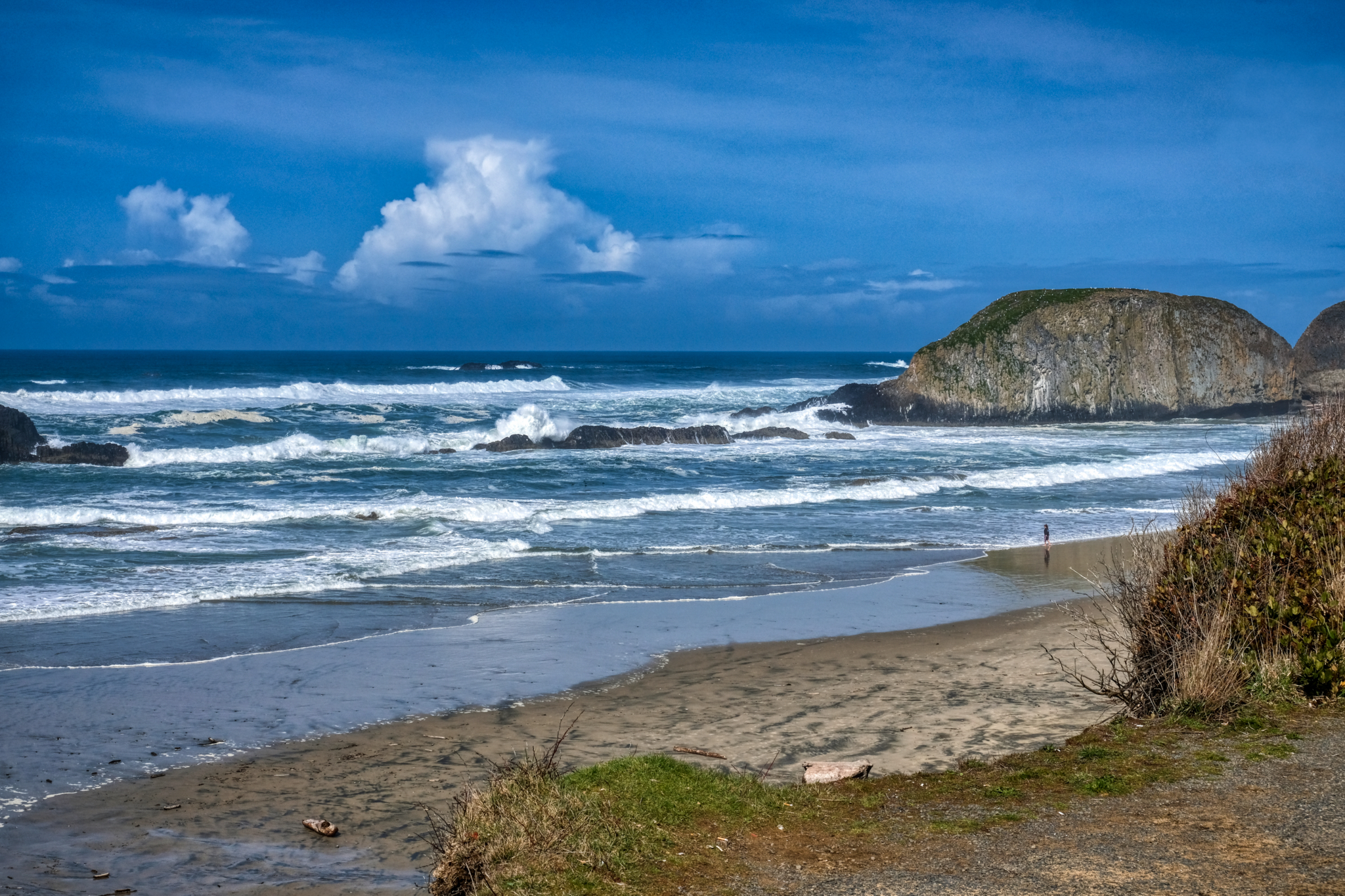 The beautiful southern Oregon coast in early April.
The beautiful southern Oregon coast in early April.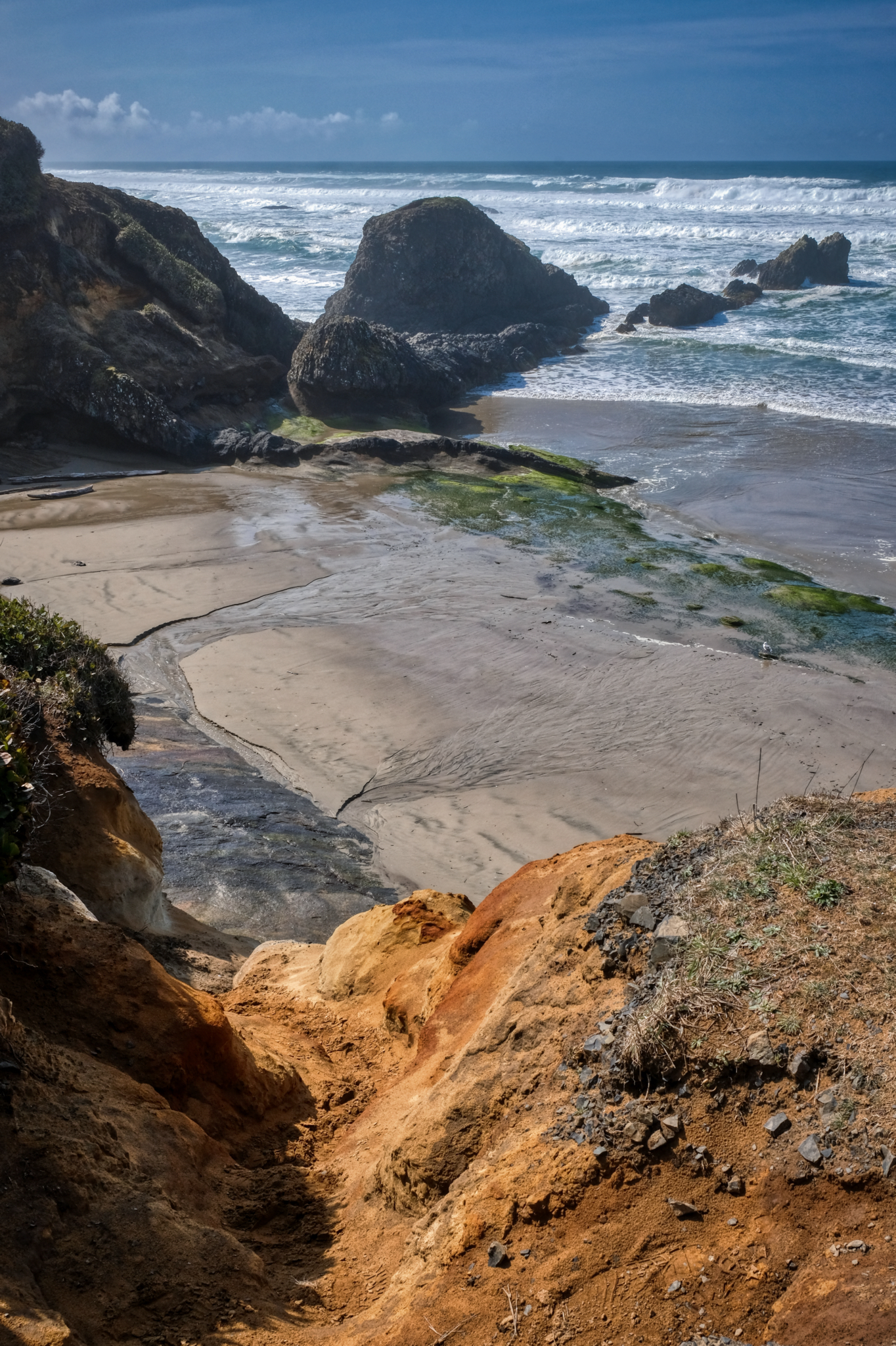 A rugged coast for several hundred miles.
A rugged coast for several hundred miles.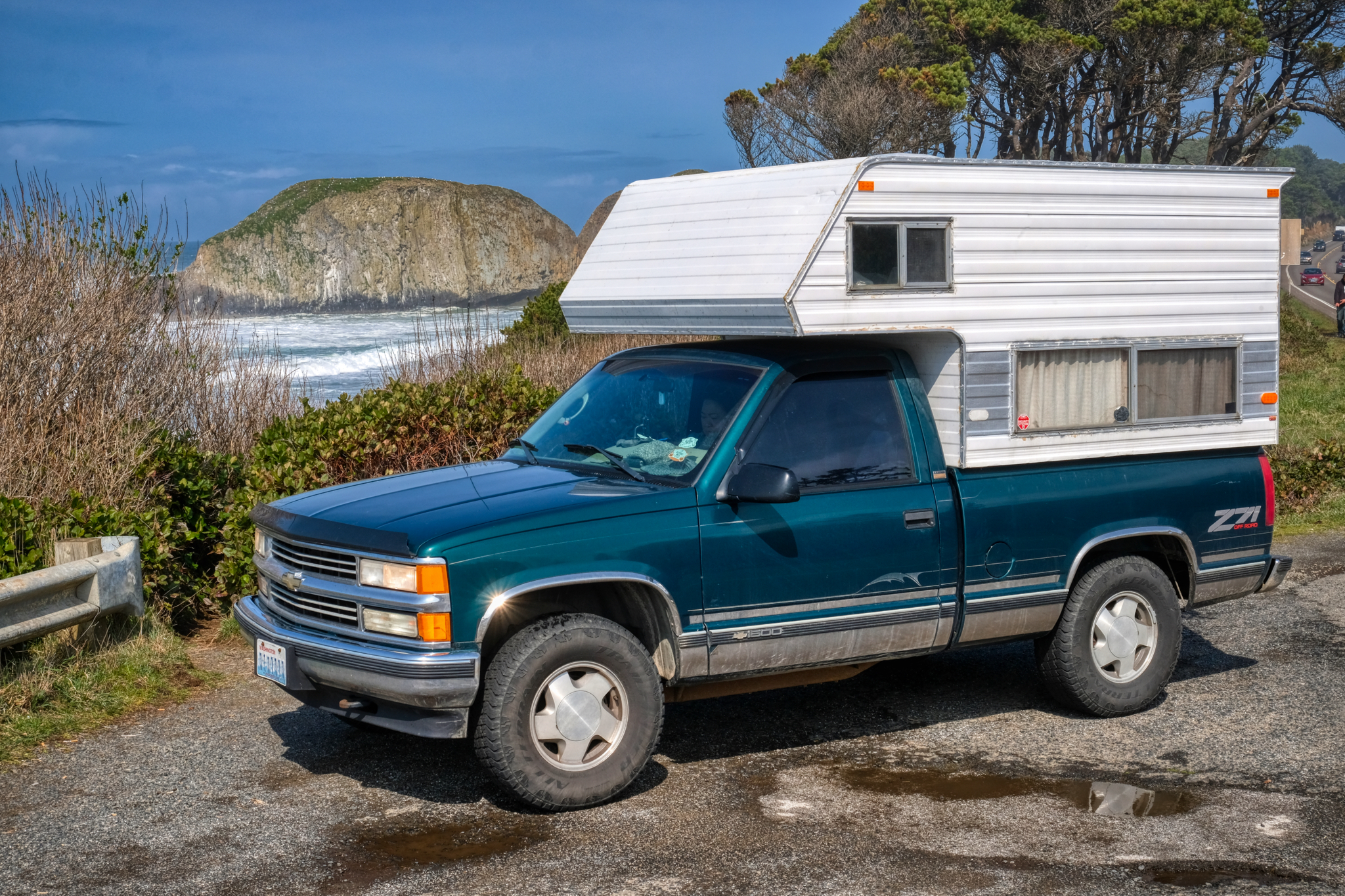 The old 1996 Chevy 4X4 camper truck working well.
The old 1996 Chevy 4X4 camper truck working well.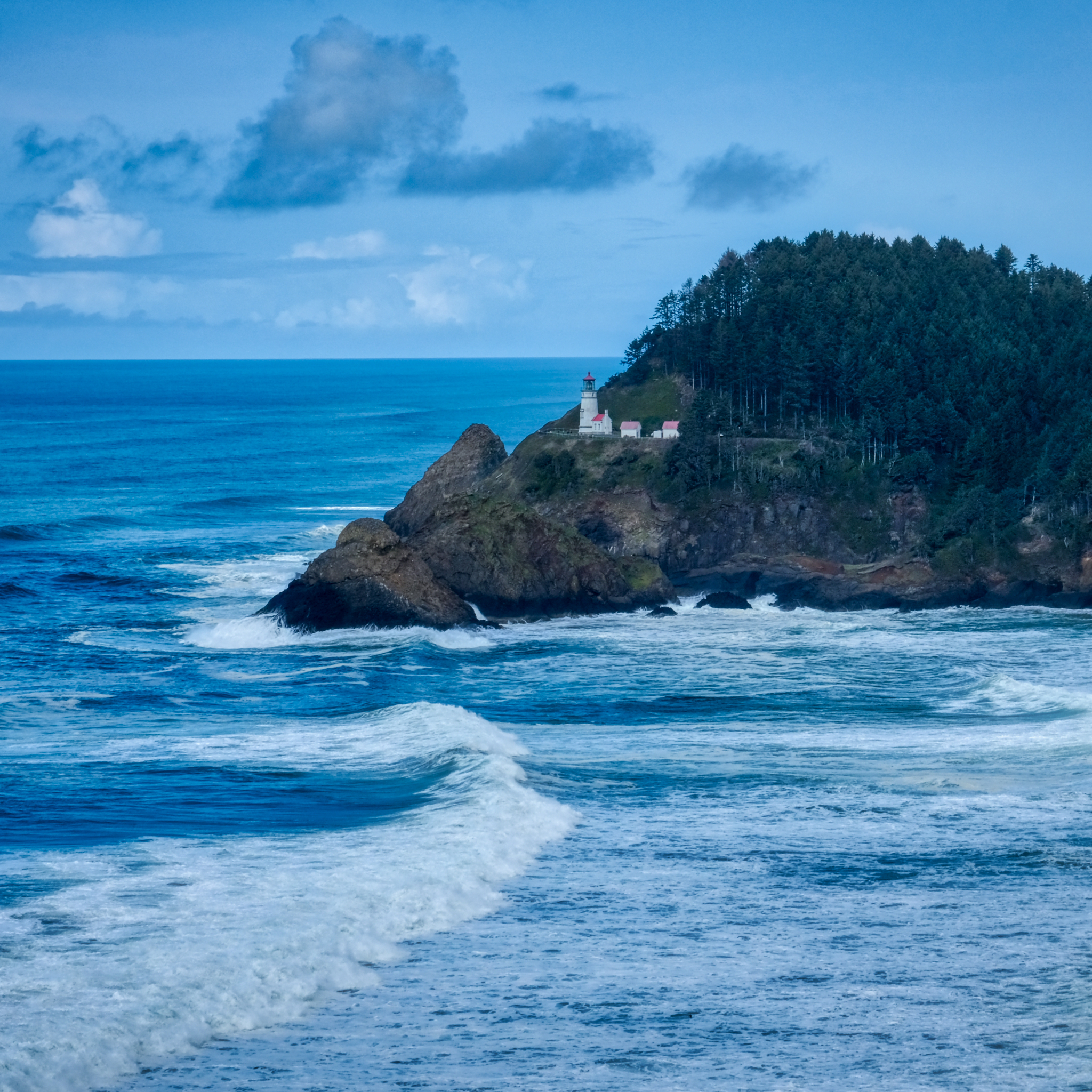 A classic lighthouse on a high bluff above the raging Pacific Ocean.
A classic lighthouse on a high bluff above the raging Pacific Ocean.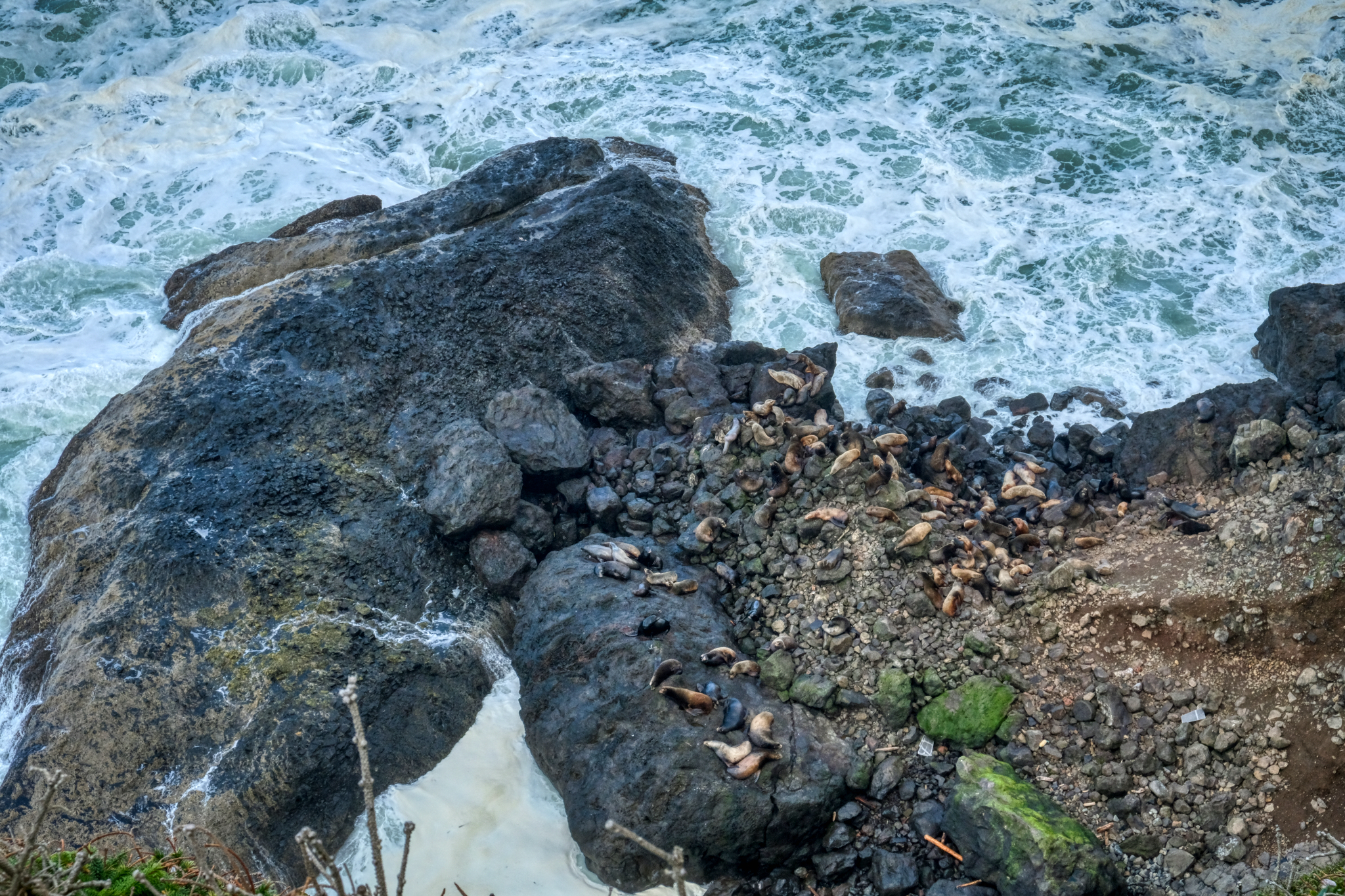 Sea Lions abound along the southern Oregon coast. We saw them at almost all our stops.
Sea Lions abound along the southern Oregon coast. We saw them at almost all our stops.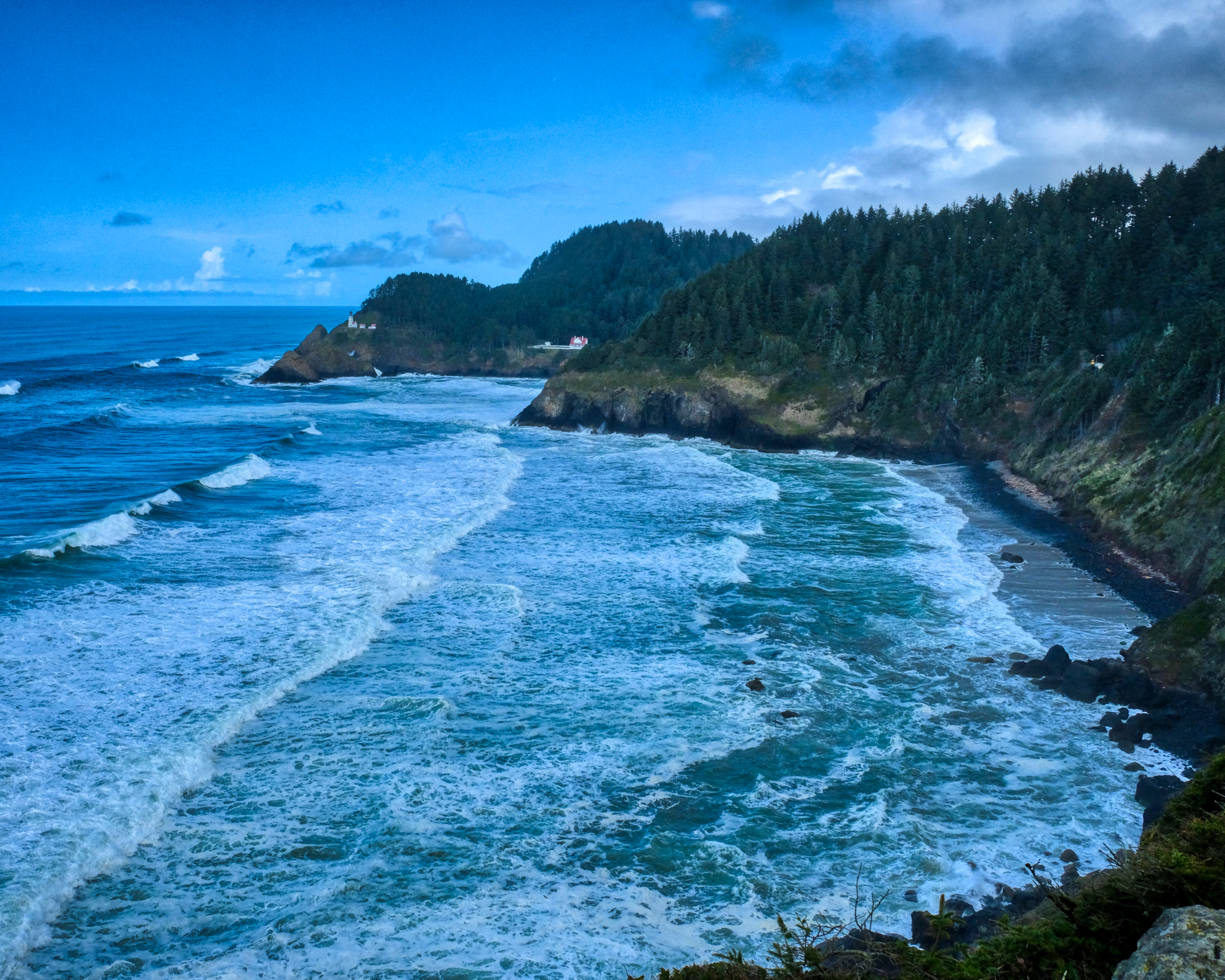 The famous beauty of the Oregon coast in all its magnificence.
The famous beauty of the Oregon coast in all its magnificence.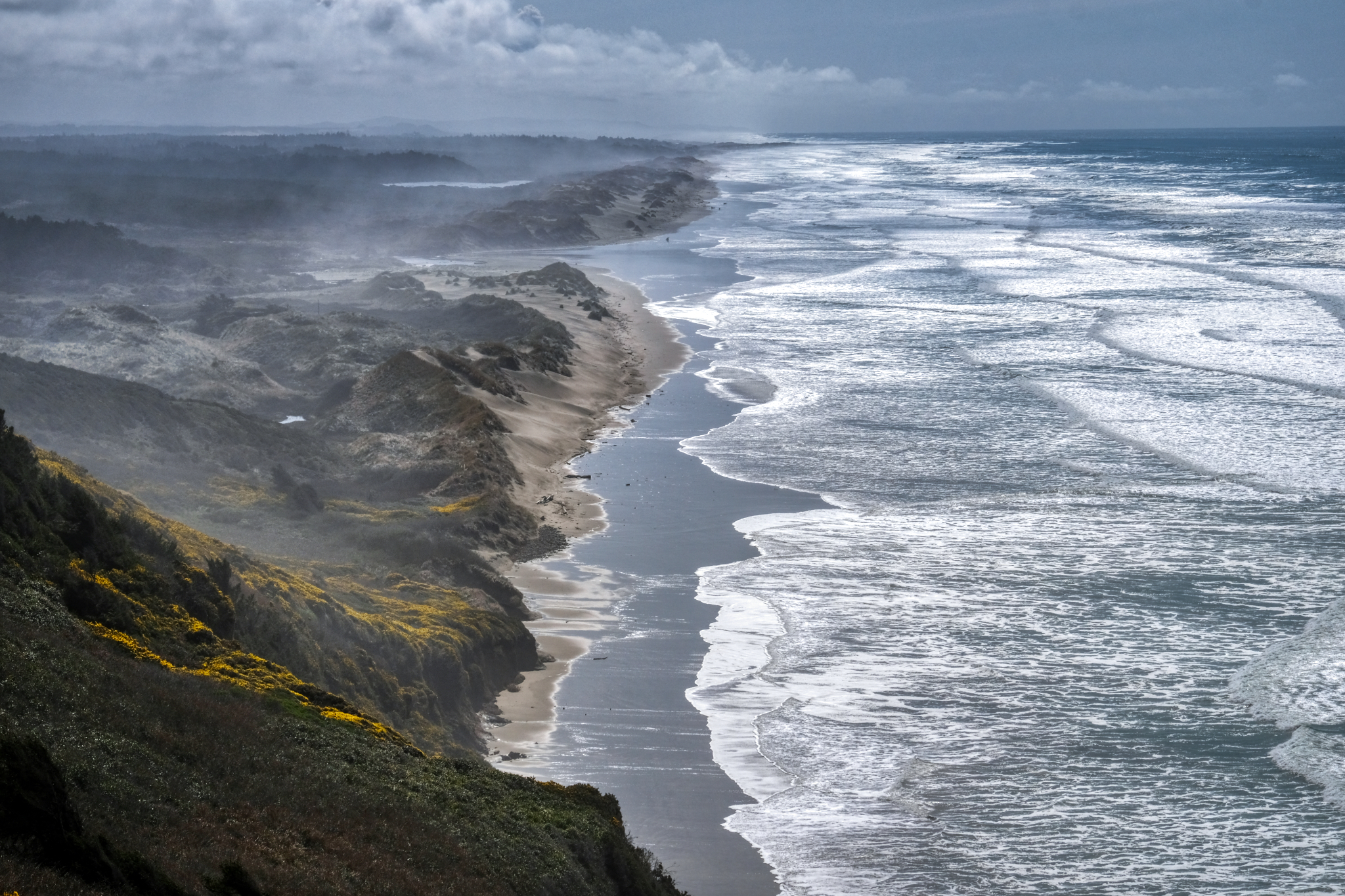 The drive south on the Oregon coast is wonderful because at every turn there is a new sweeping panorama . . .
The drive south on the Oregon coast is wonderful because at every turn there is a new sweeping panorama . . . A beautiful bay just south of Crescent City, California after sunrise.
A beautiful bay just south of Crescent City, California after sunrise.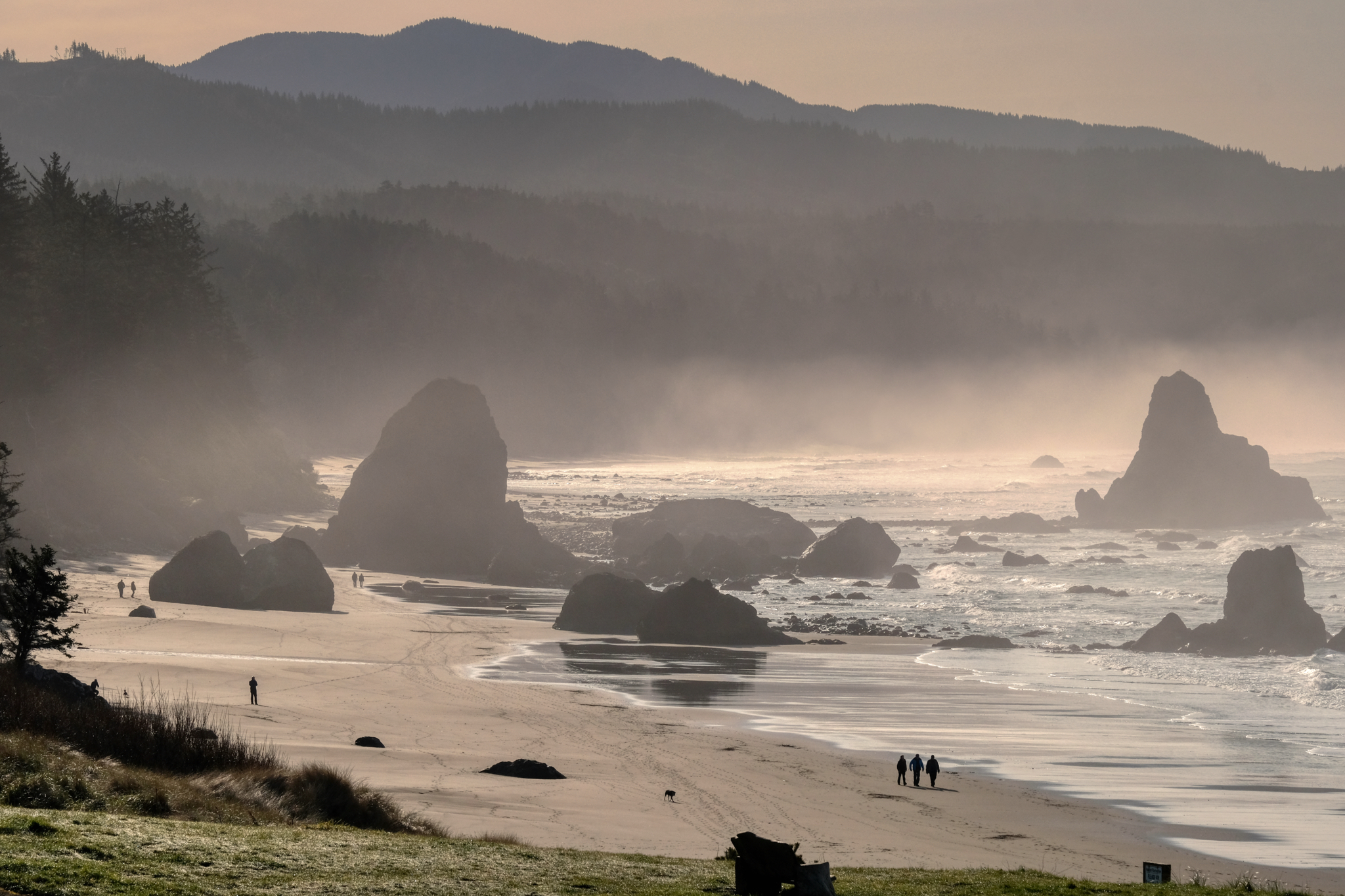 People out on their morning beach walk.
People out on their morning beach walk.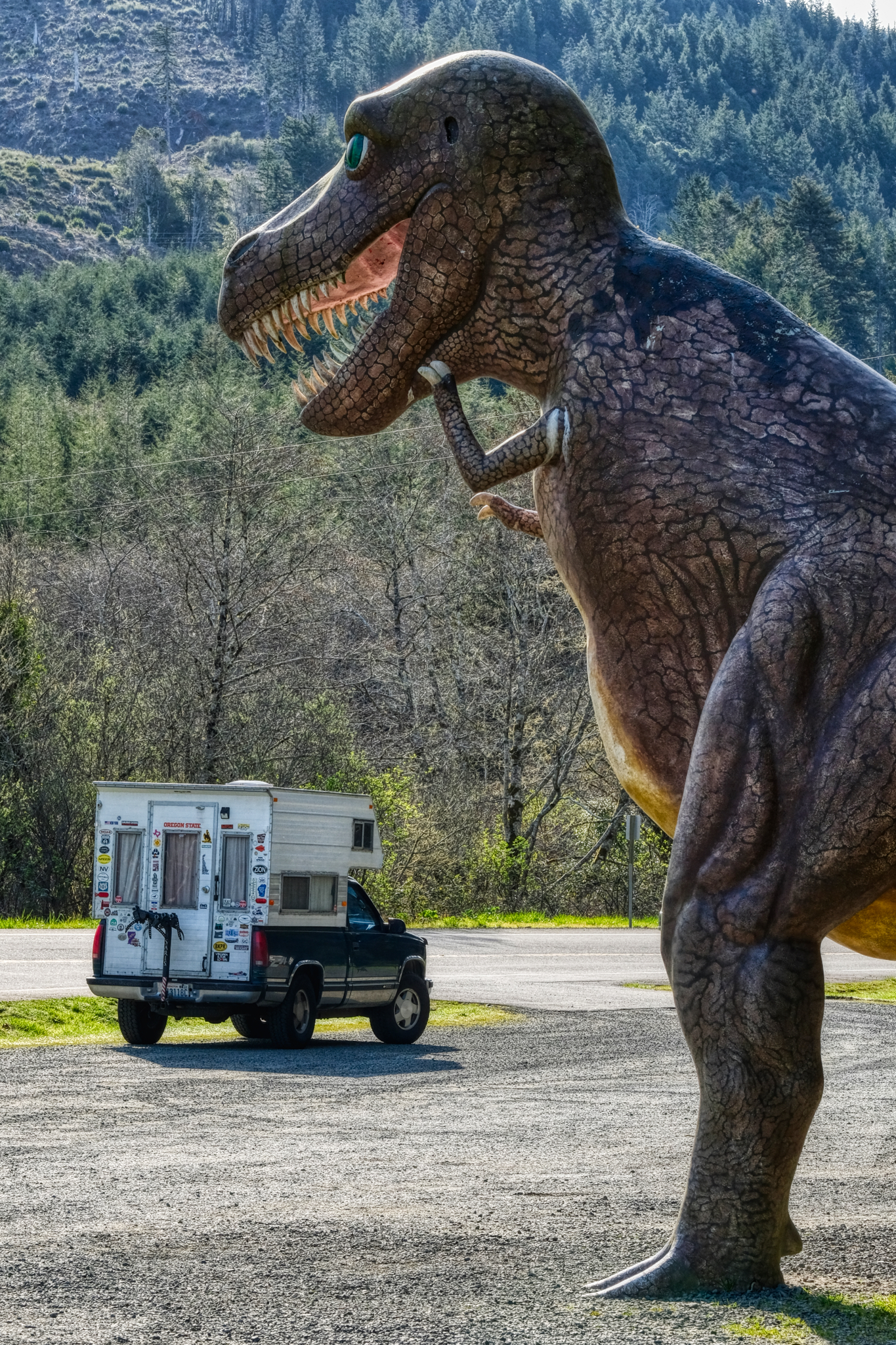 I'm glad I had the V8! Not exactly a tourist trap . . . but a pretty good dinosaur park roadside attraction.
I'm glad I had the V8! Not exactly a tourist trap . . . but a pretty good dinosaur park roadside attraction.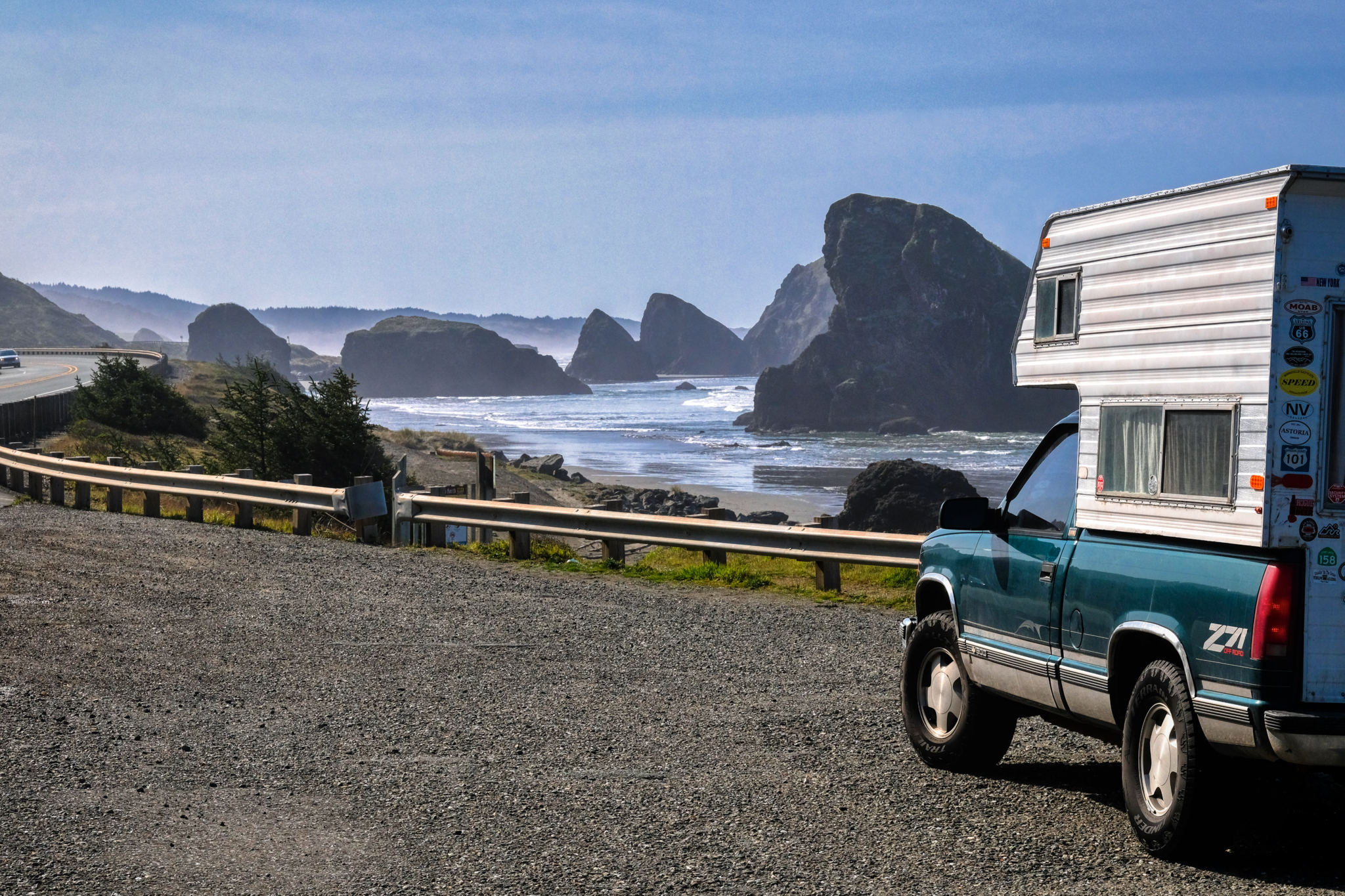 We made many stops along Highway 101 to ogle at the incredible scenery.
We made many stops along Highway 101 to ogle at the incredible scenery.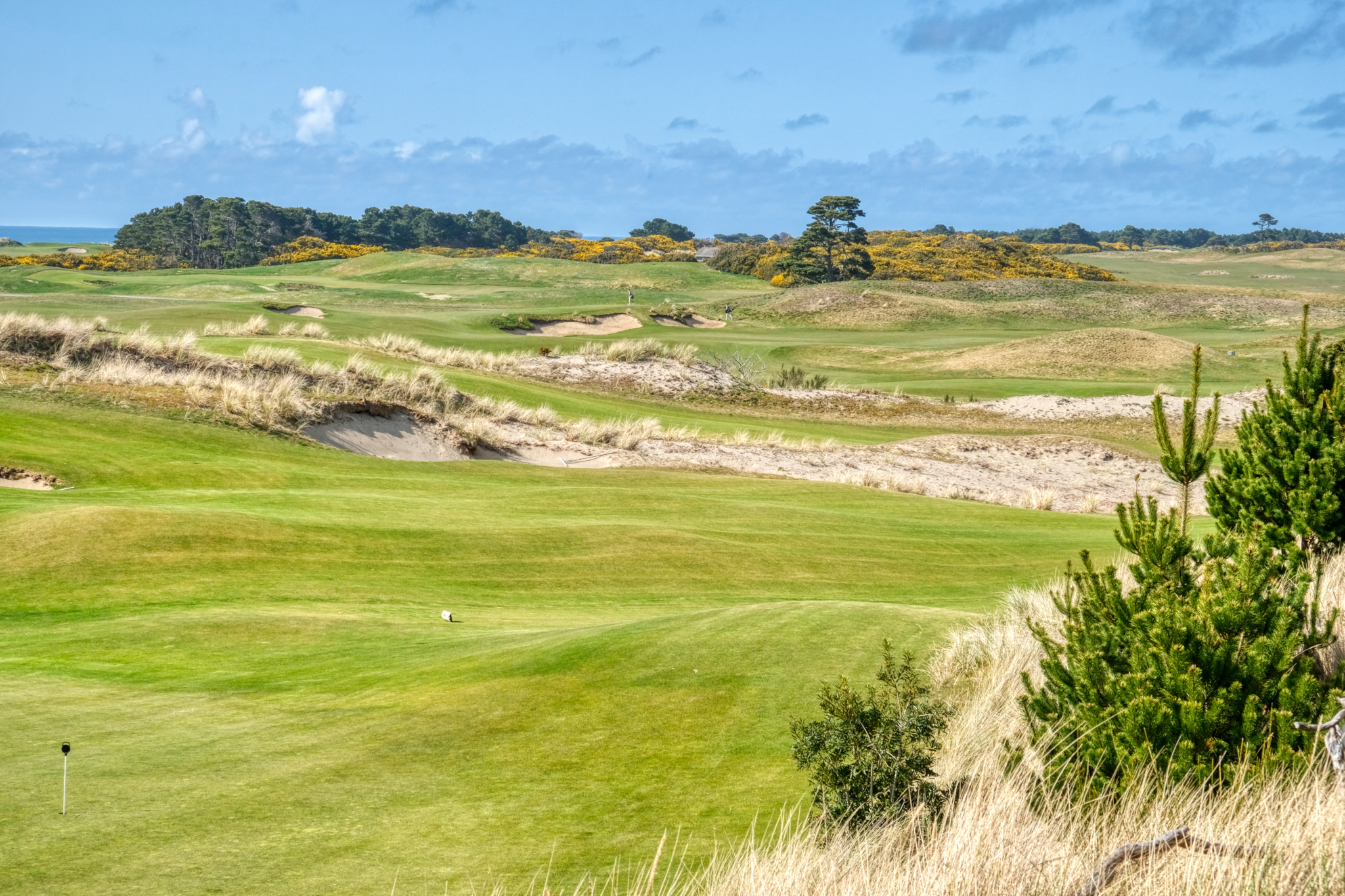 Of course, my wife wanted to stop and look at every golf curse along the way. This one, near Brookings, looked so Scottish! A real links curse, yellow gorse and all!
Of course, my wife wanted to stop and look at every golf curse along the way. This one, near Brookings, looked so Scottish! A real links curse, yellow gorse and all!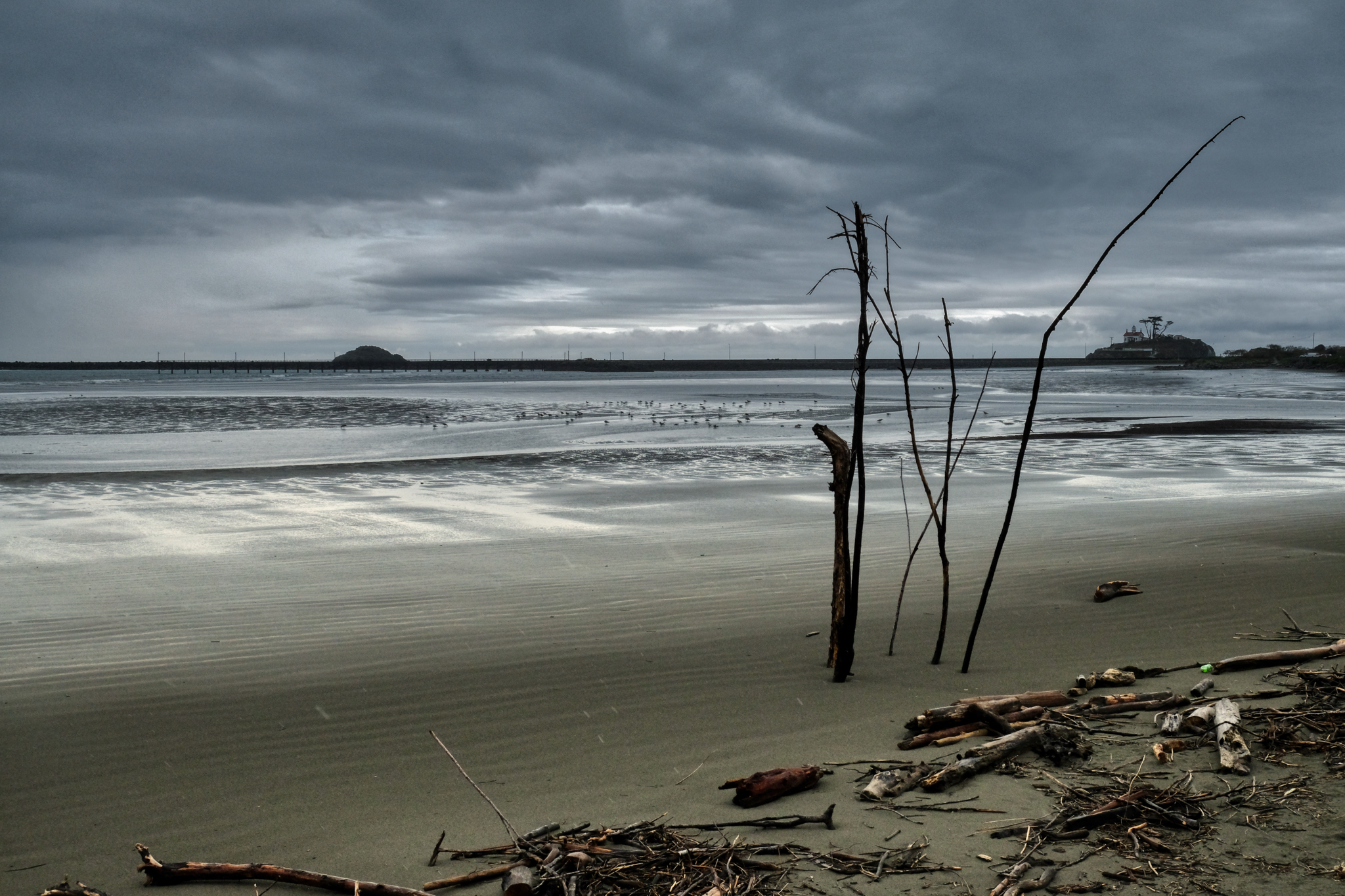 Arriving at the Crescent City bay.
Arriving at the Crescent City bay.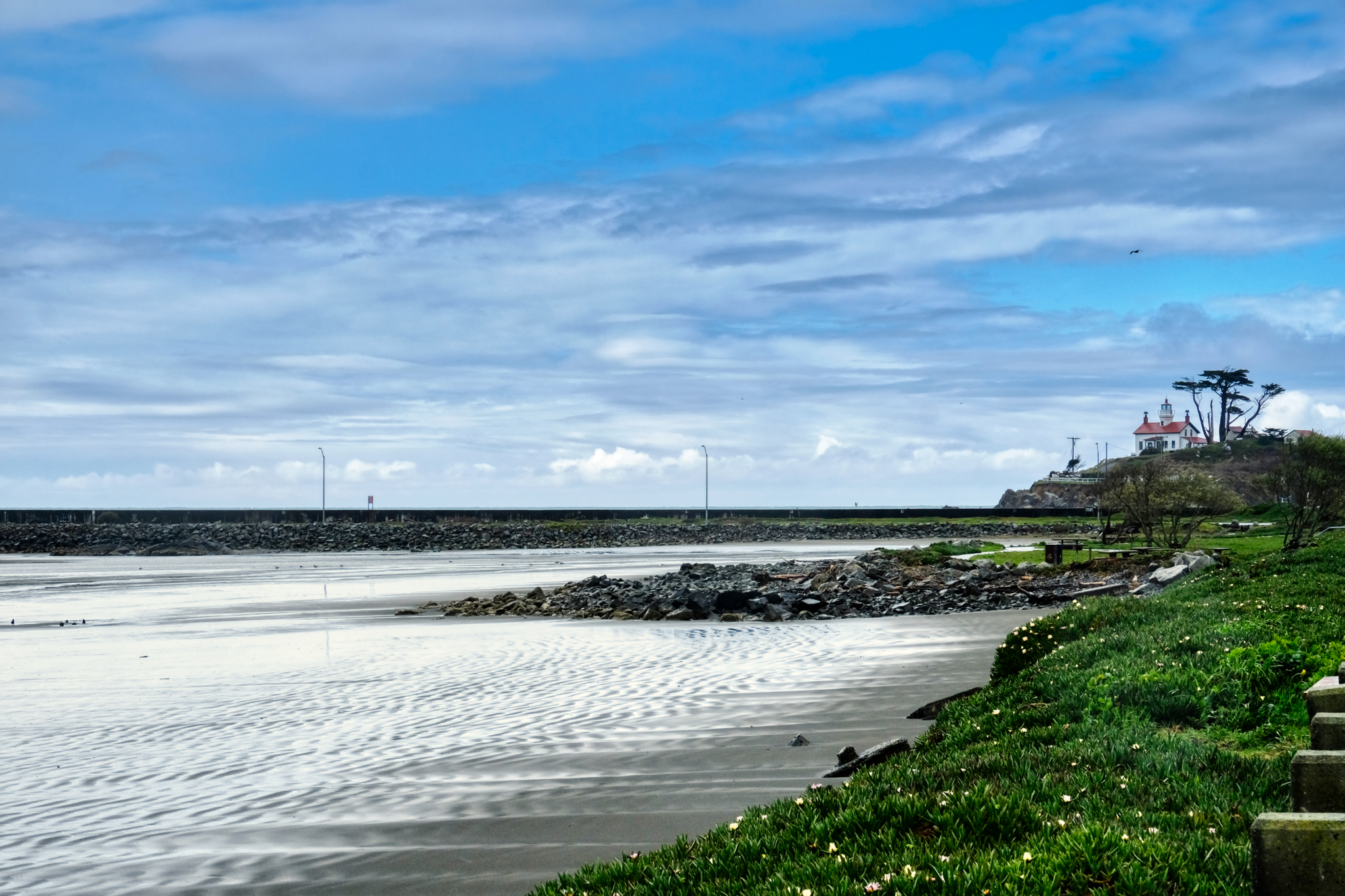 Crescent City bay and lighthouse.
Crescent City bay and lighthouse.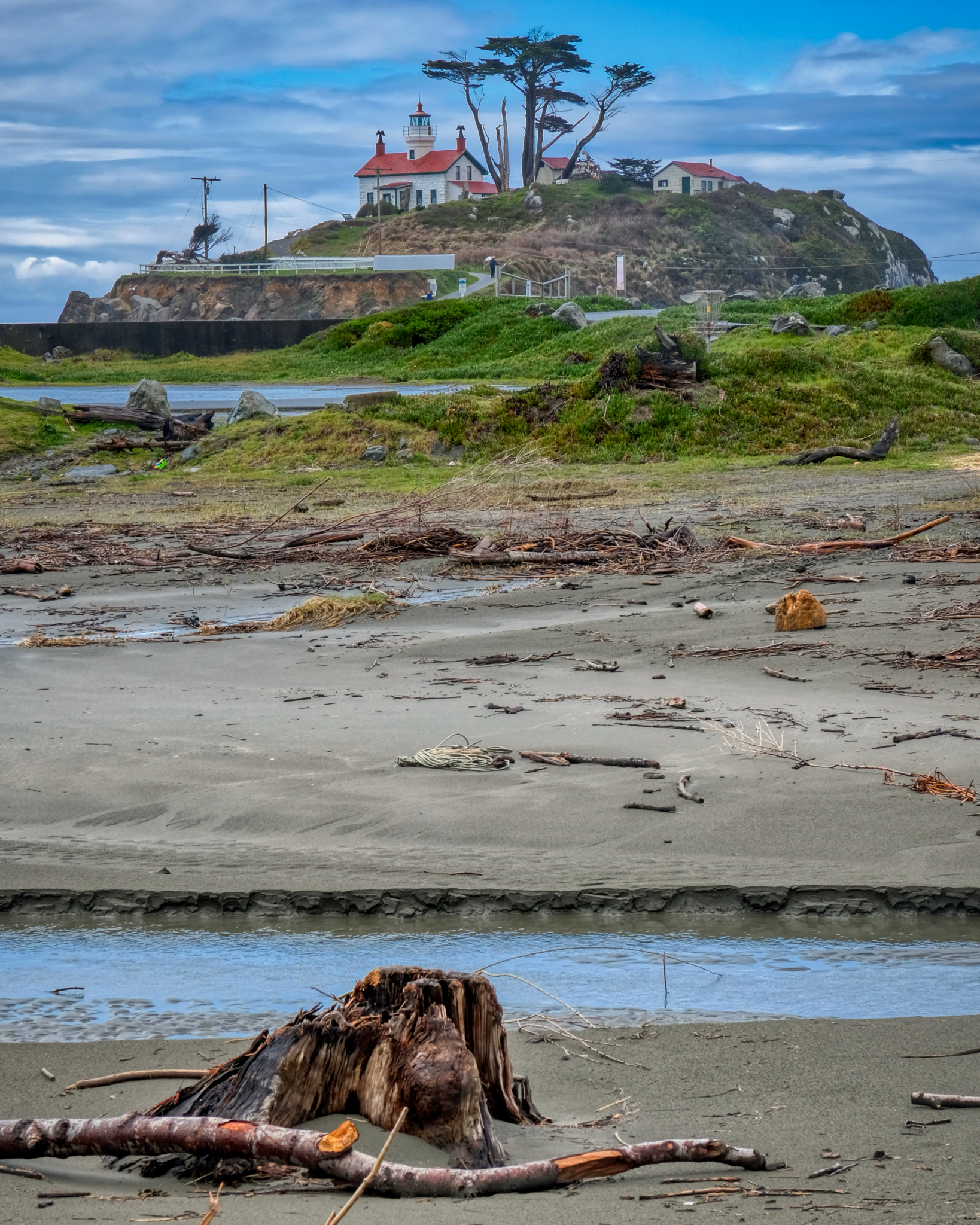 Crescent City lighthouse.
Crescent City lighthouse.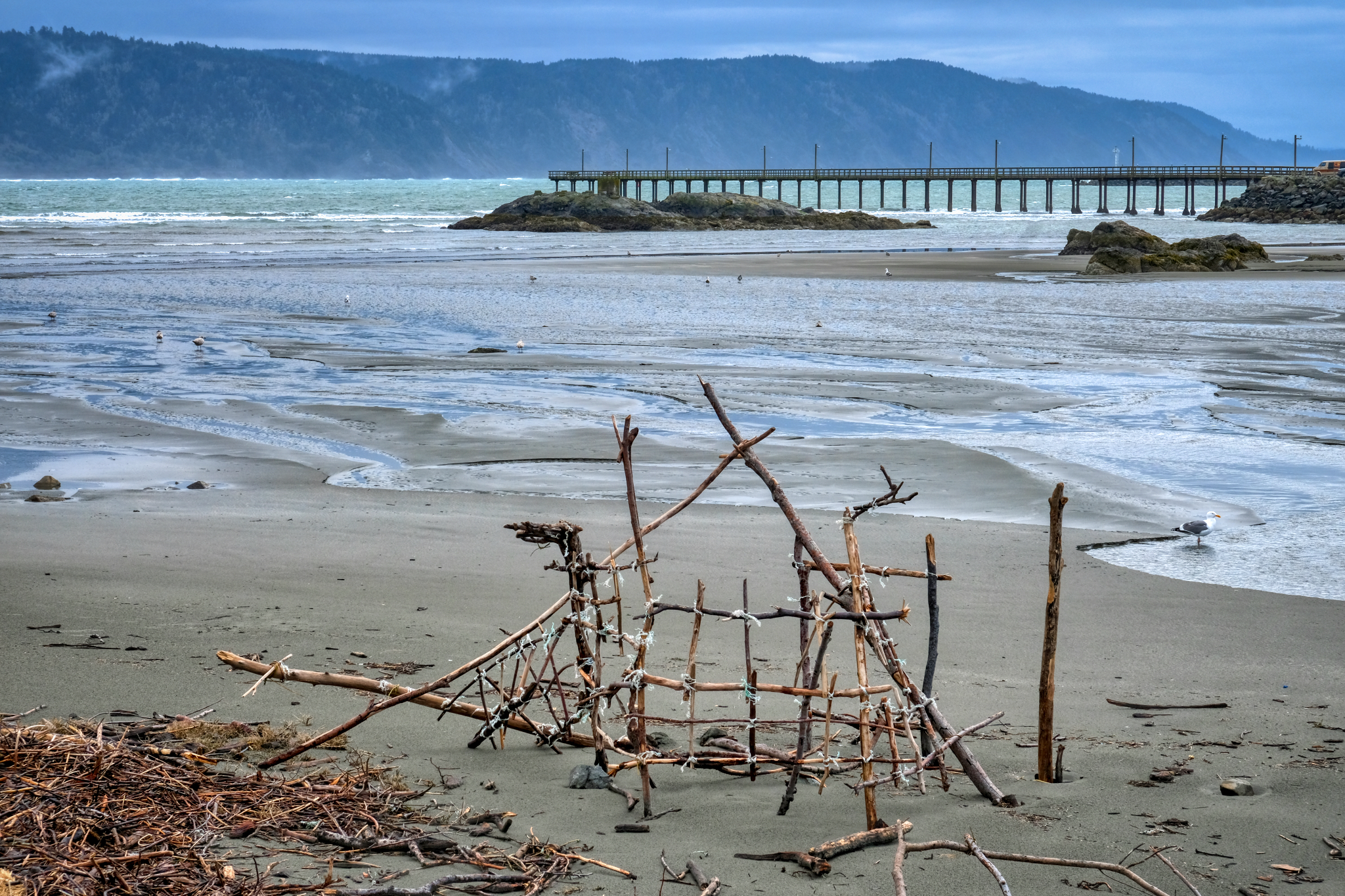 A beachcombers' stick sculpture.
A beachcombers' stick sculpture.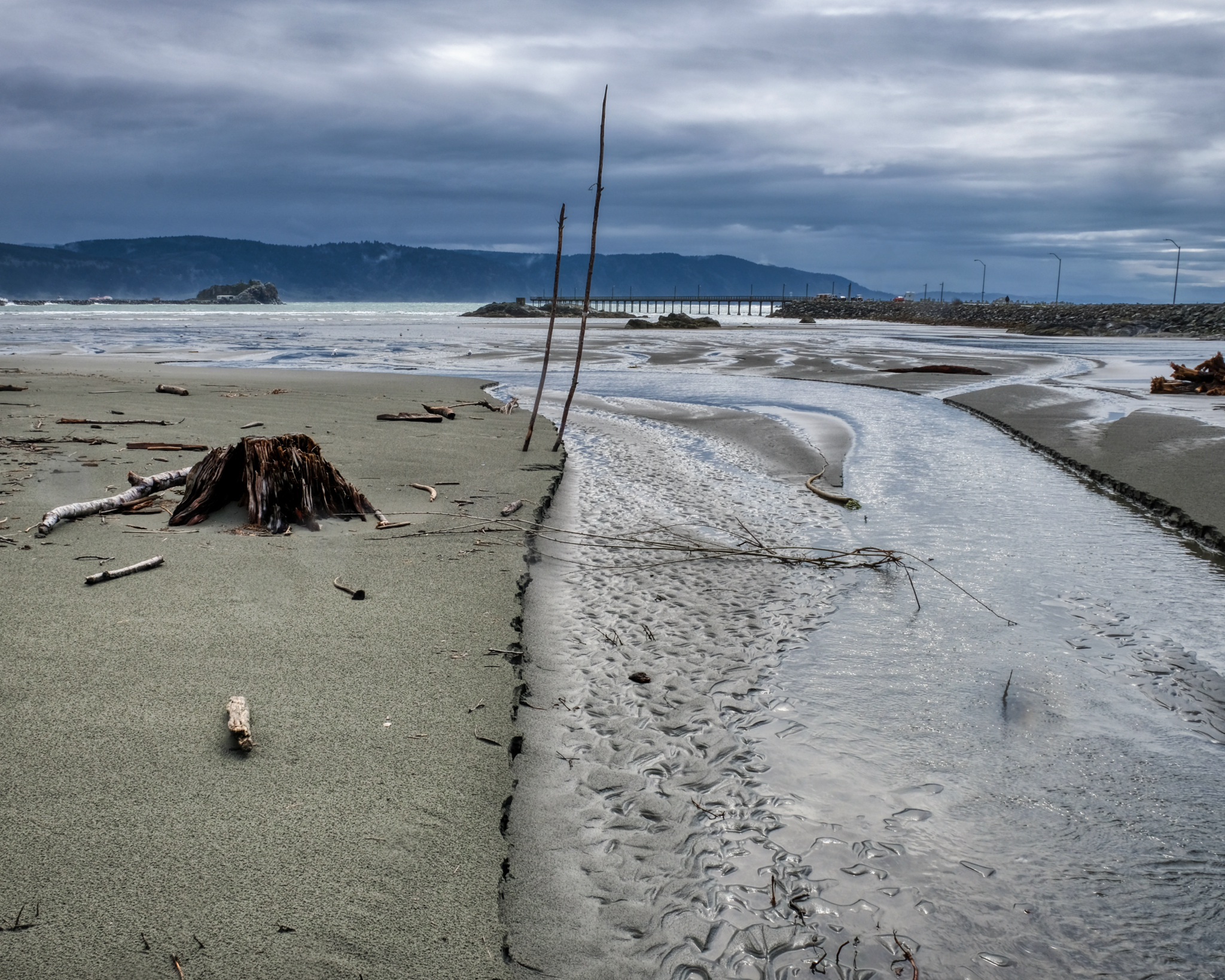 I love these Pacific Northwest coastal scenes.
I love these Pacific Northwest coastal scenes.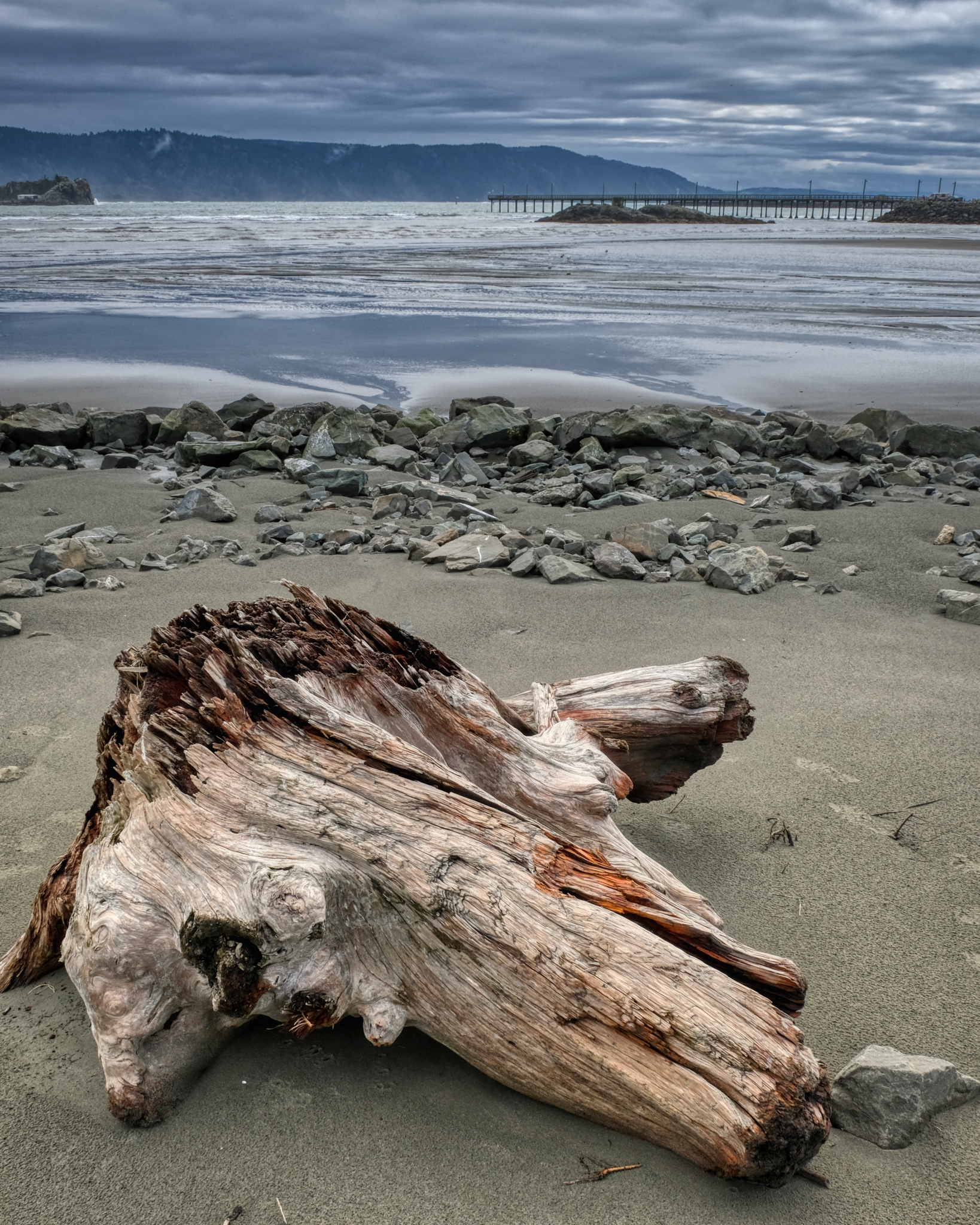 On of my favorite photographic subjects: driftwood.
On of my favorite photographic subjects: driftwood.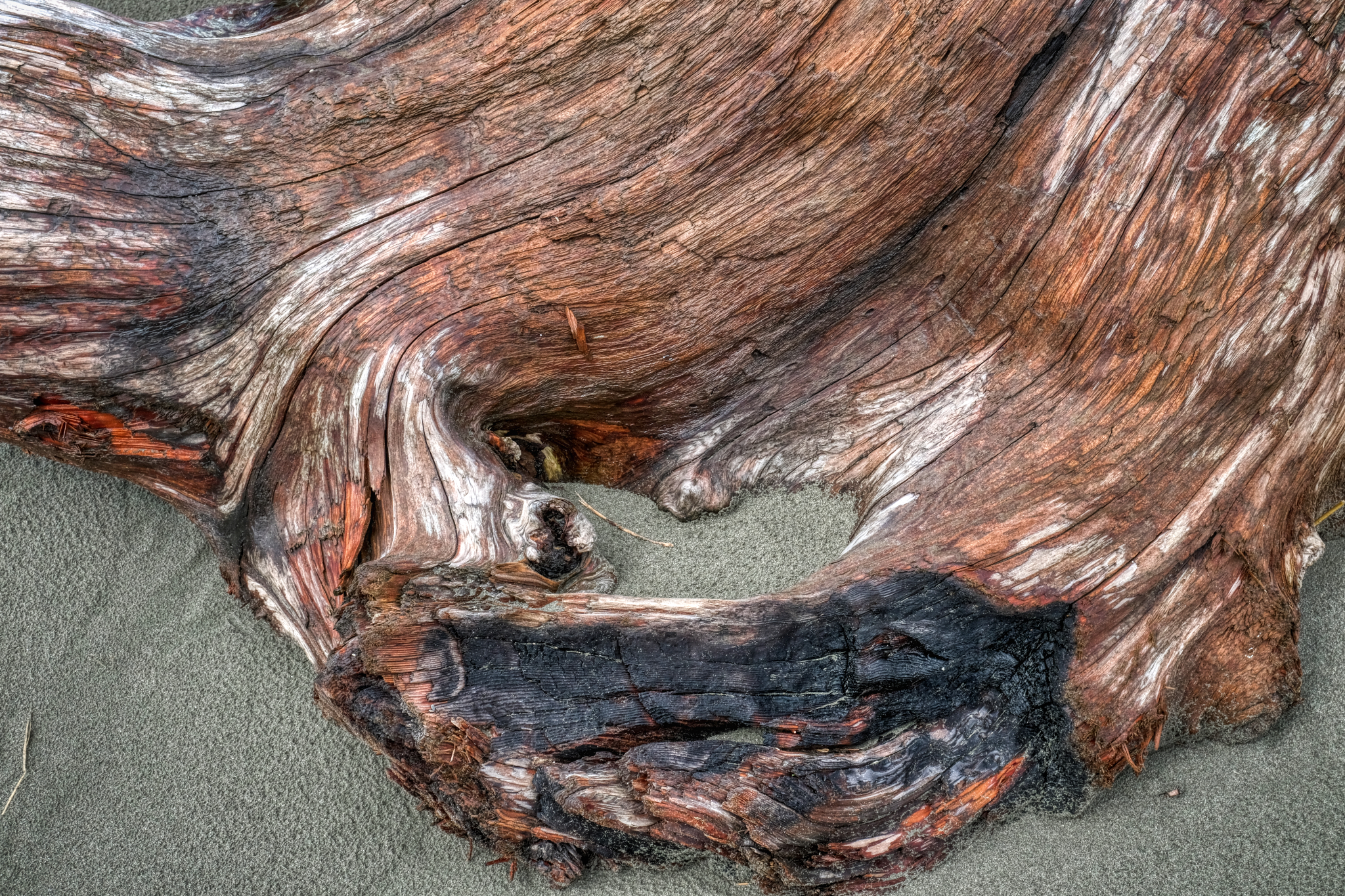 Worn by sea, sun, and sand into fabulous textures and patterns . . .
Worn by sea, sun, and sand into fabulous textures and patterns . . .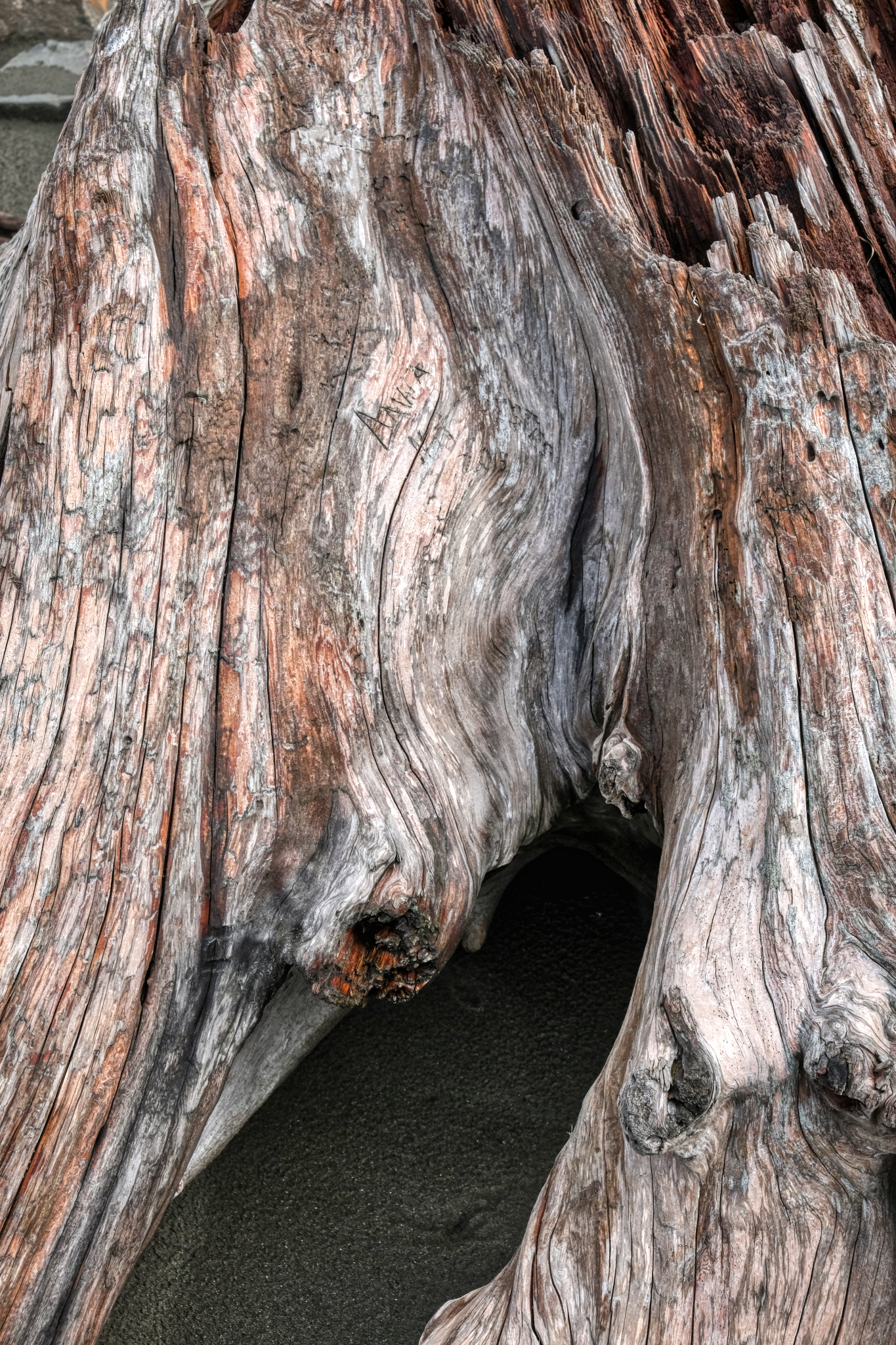 A visitor's cartouche . . .
A visitor's cartouche . . .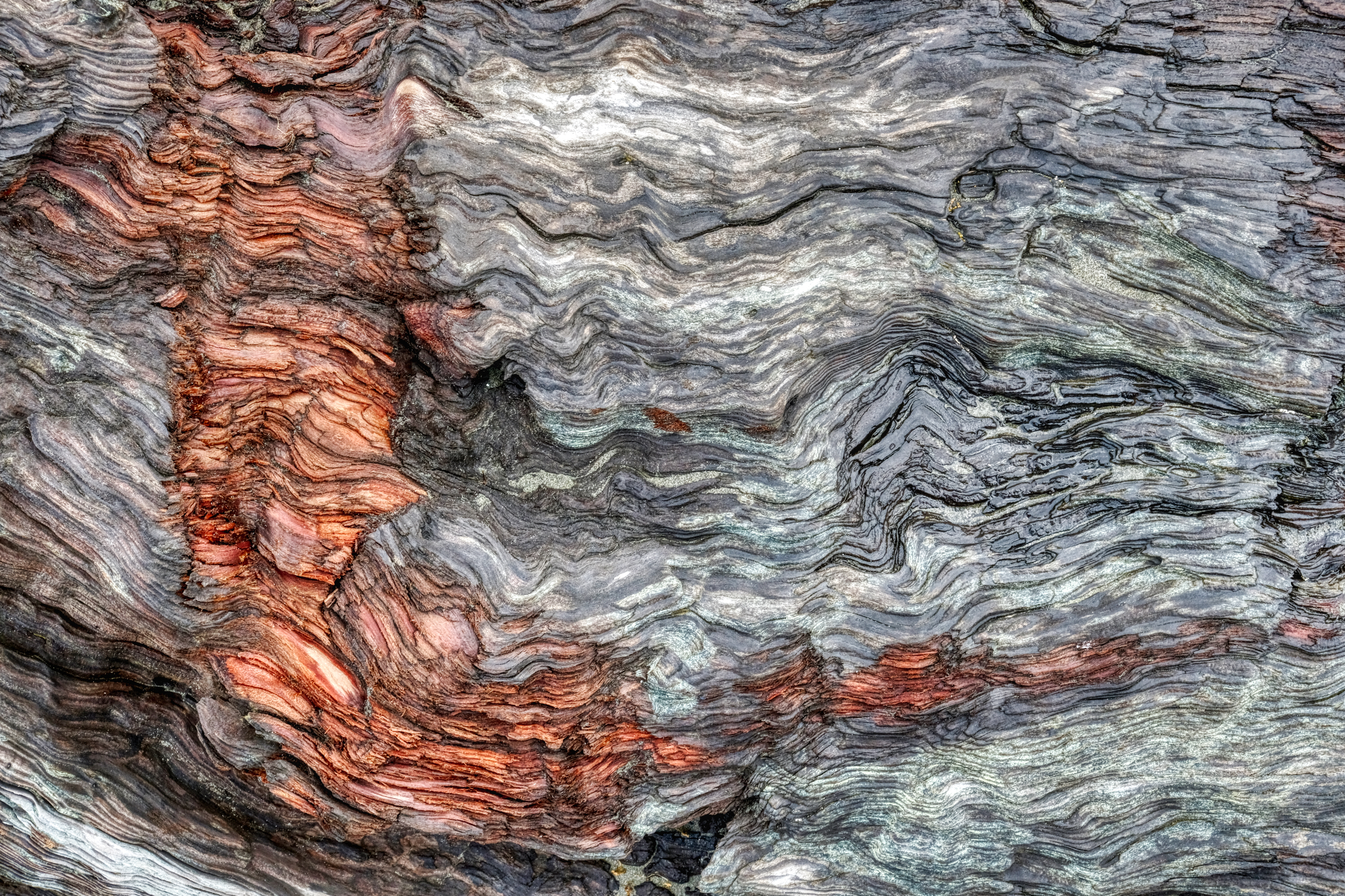 A damaged surface. The orange scrape revealing the natural color behind the grey aged driftwood.
A damaged surface. The orange scrape revealing the natural color behind the grey aged driftwood.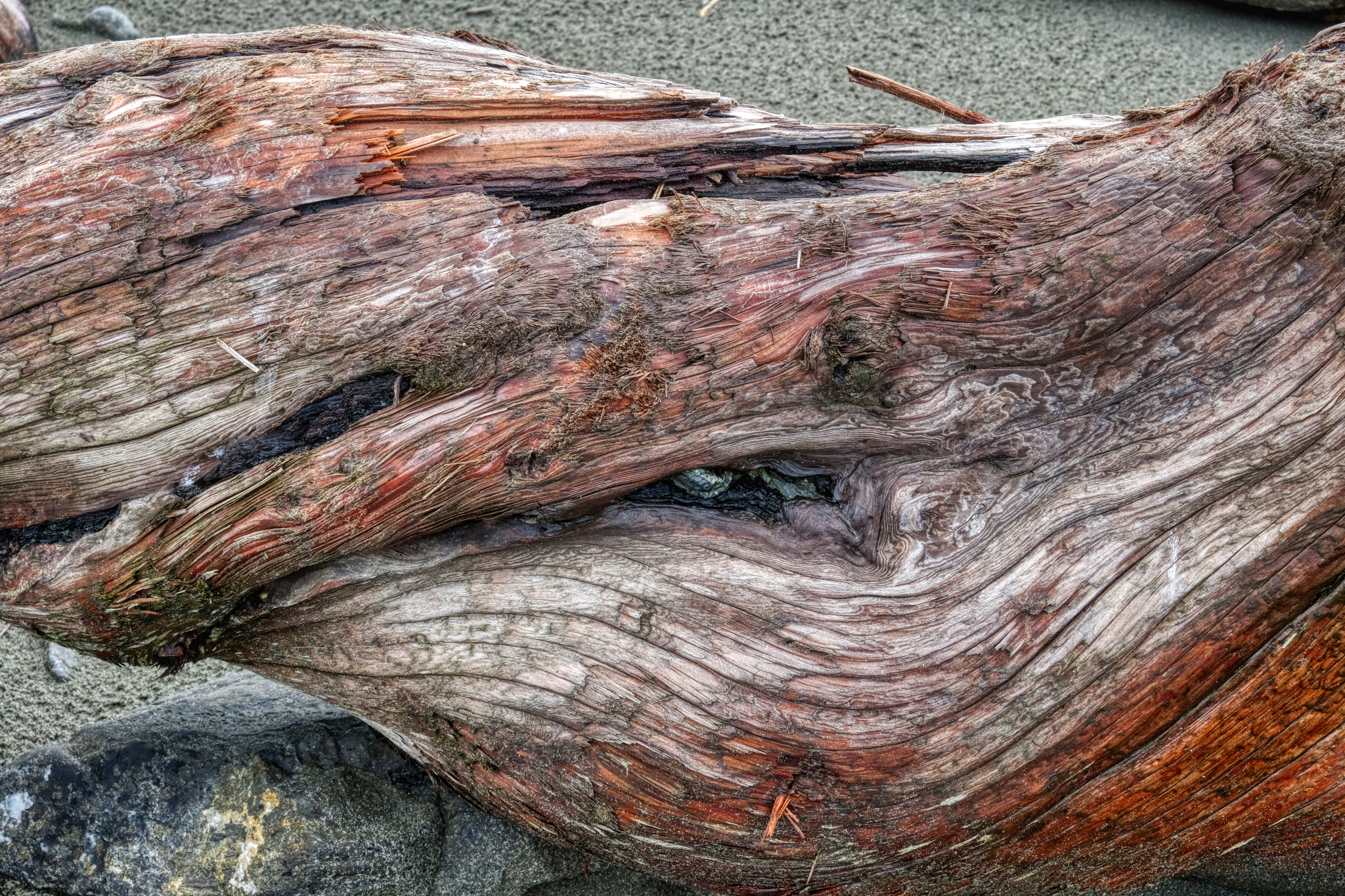 Twisted driftwood.
Twisted driftwood.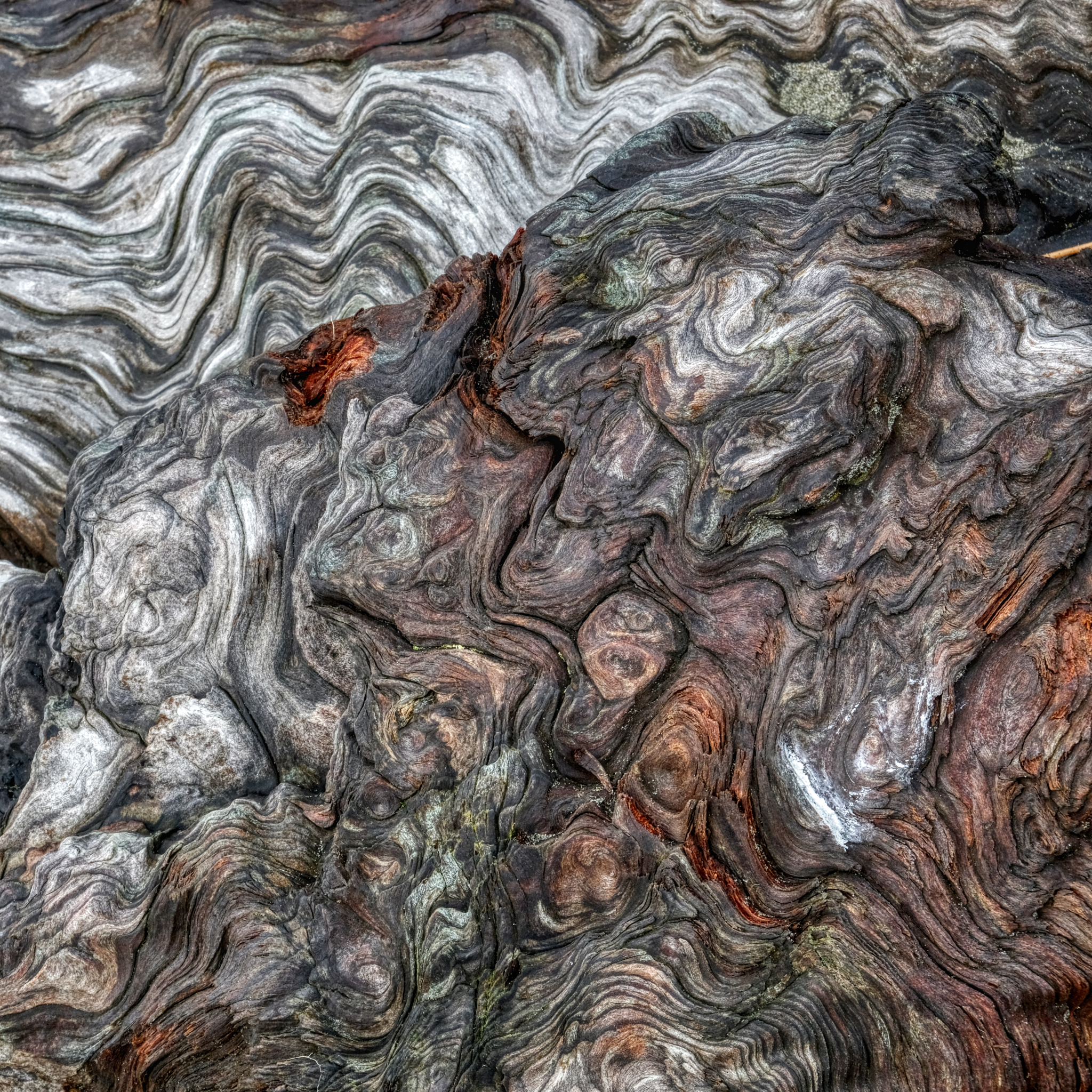 A revelation of the history of the forces and conditions this particular tree has experienced in the past represented in these patterns.
A revelation of the history of the forces and conditions this particular tree has experienced in the past represented in these patterns.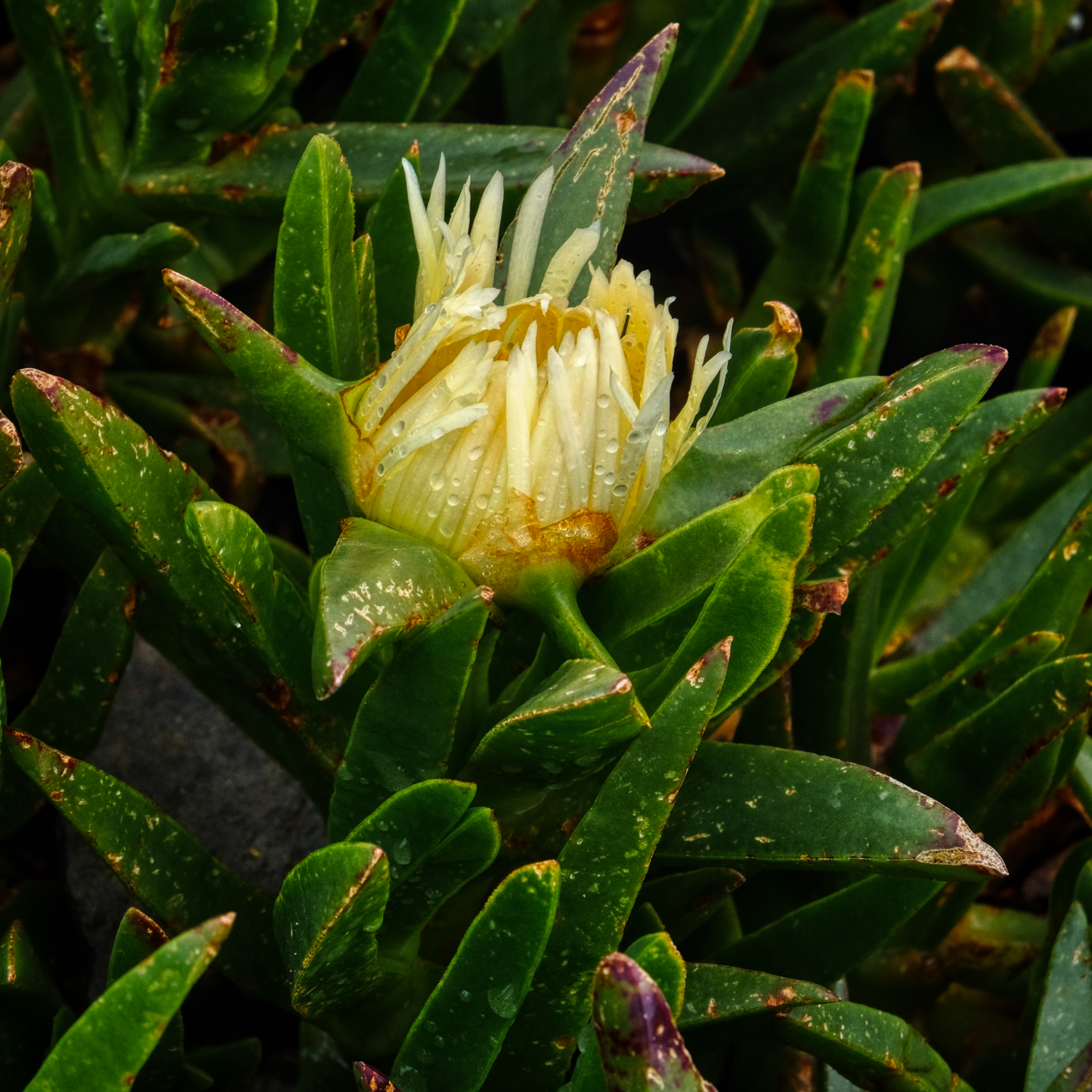 Ice plant! Stained all my clothes as a child. Here, at Crescent City, in flower on a rainy morning.
Ice plant! Stained all my clothes as a child. Here, at Crescent City, in flower on a rainy morning.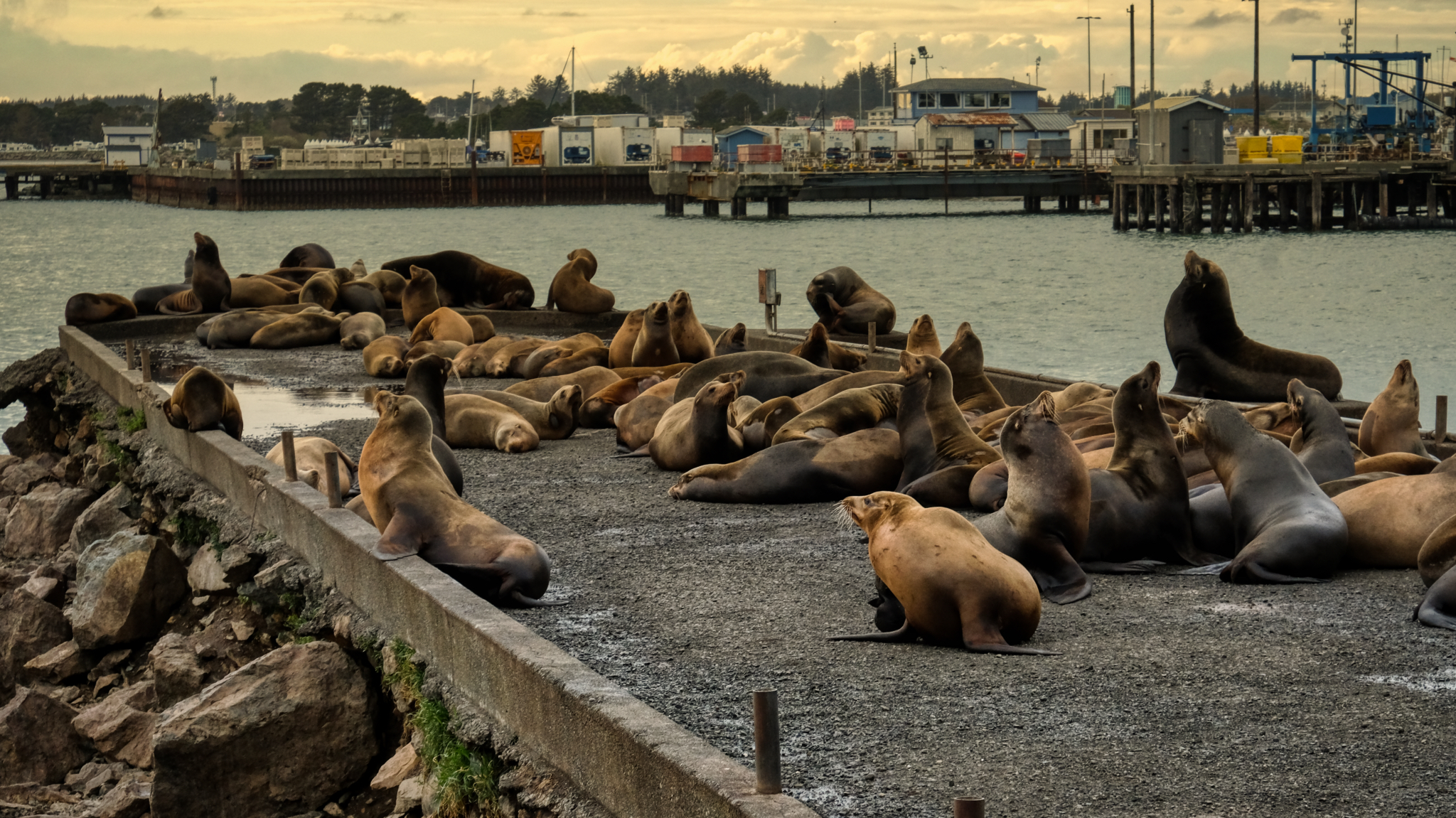 We stayed the night in a motel in Crescent City, California and went out for seafood on the pier . . . and discovered the sea lions at sunset.
We stayed the night in a motel in Crescent City, California and went out for seafood on the pier . . . and discovered the sea lions at sunset.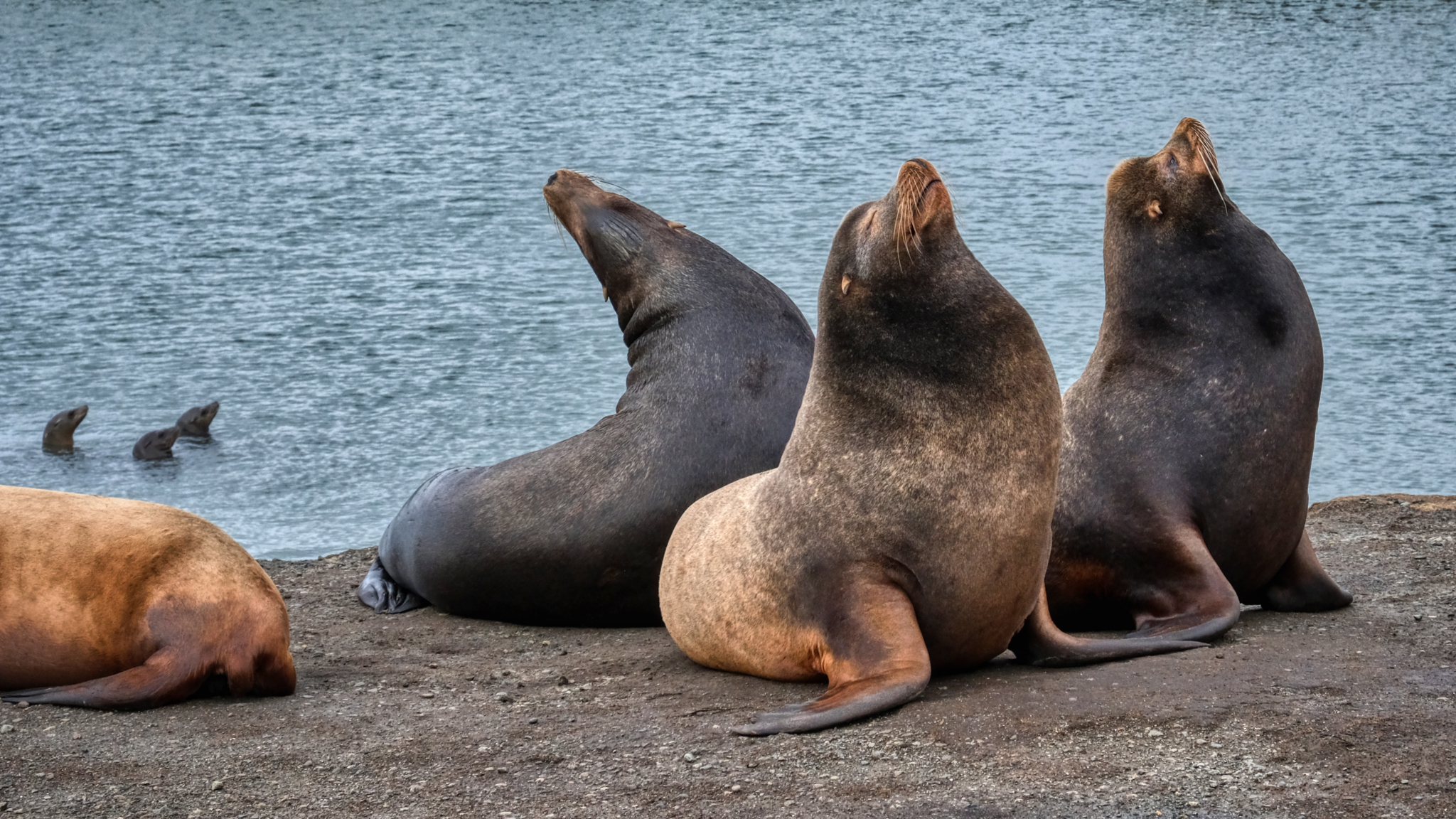 Sea lions are fascinating to watch. Very entertaining sea mammals!
Sea lions are fascinating to watch. Very entertaining sea mammals!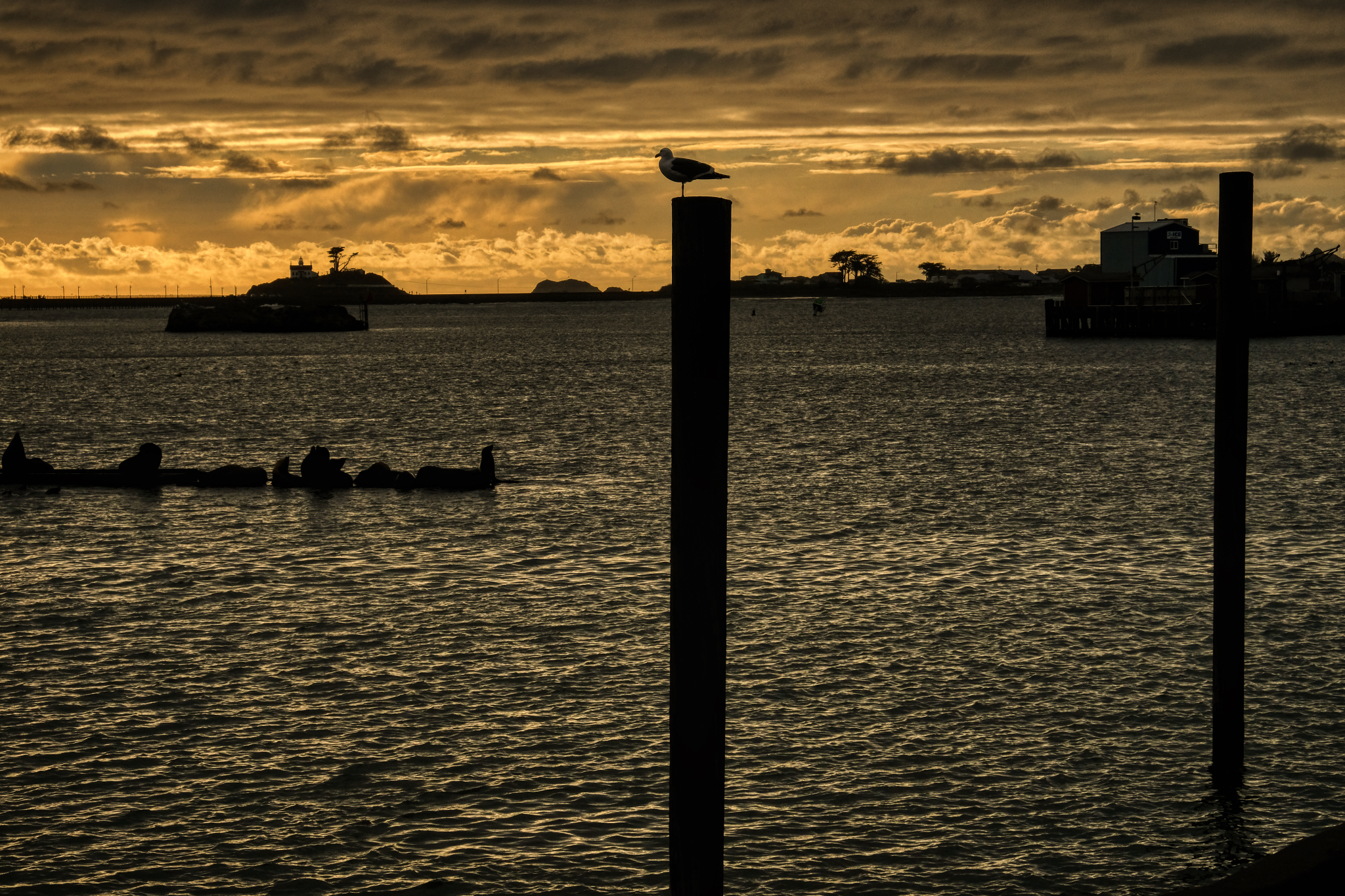 The Crescent City harbor . . . a gull supervises a log-full of sea lions.
The Crescent City harbor . . . a gull supervises a log-full of sea lions.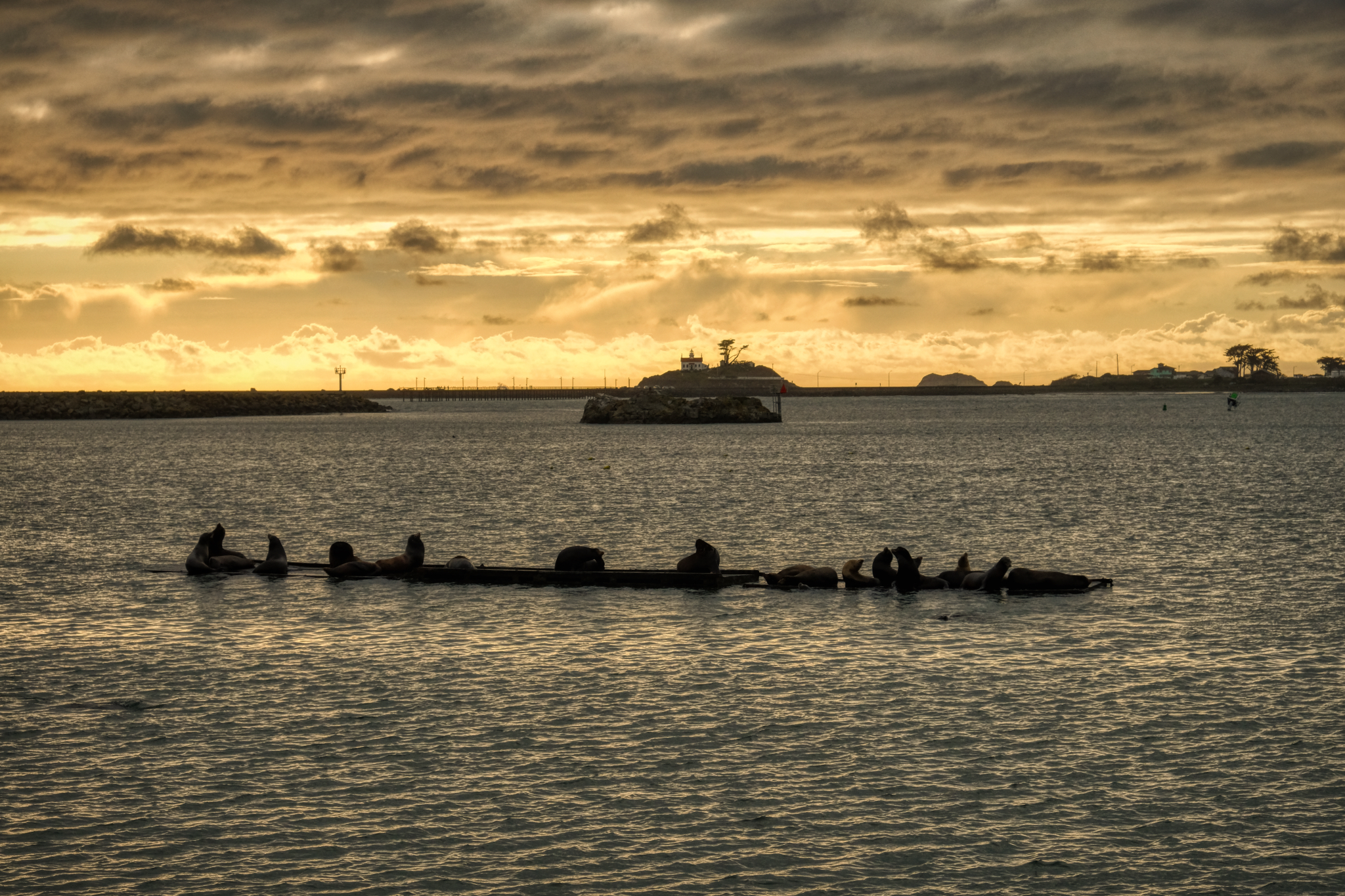 Sea lions on a log in the sunset.
Sea lions on a log in the sunset.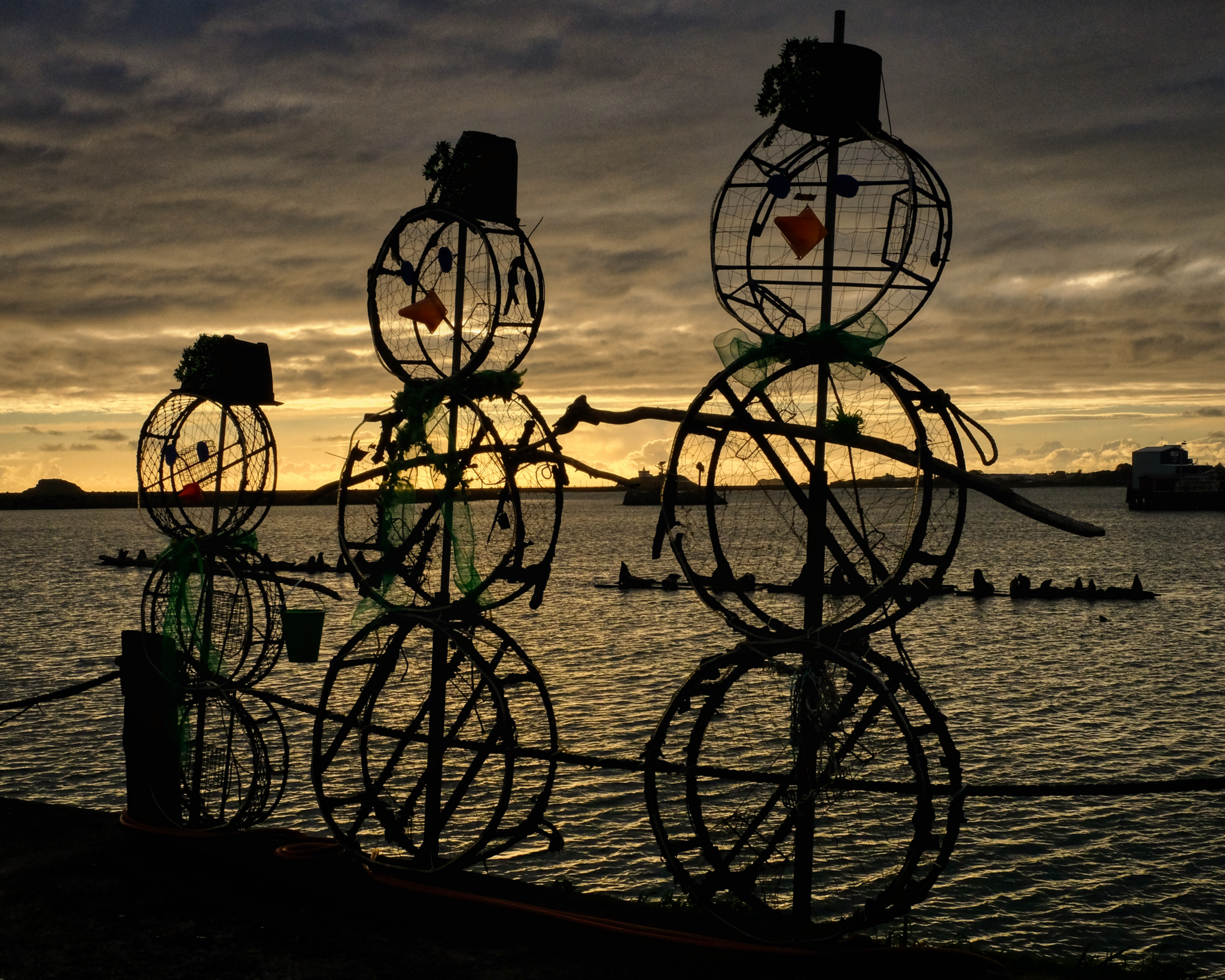 It was early April . . . time to take down the Christmas decorations . . . but cute.
It was early April . . . time to take down the Christmas decorations . . . but cute.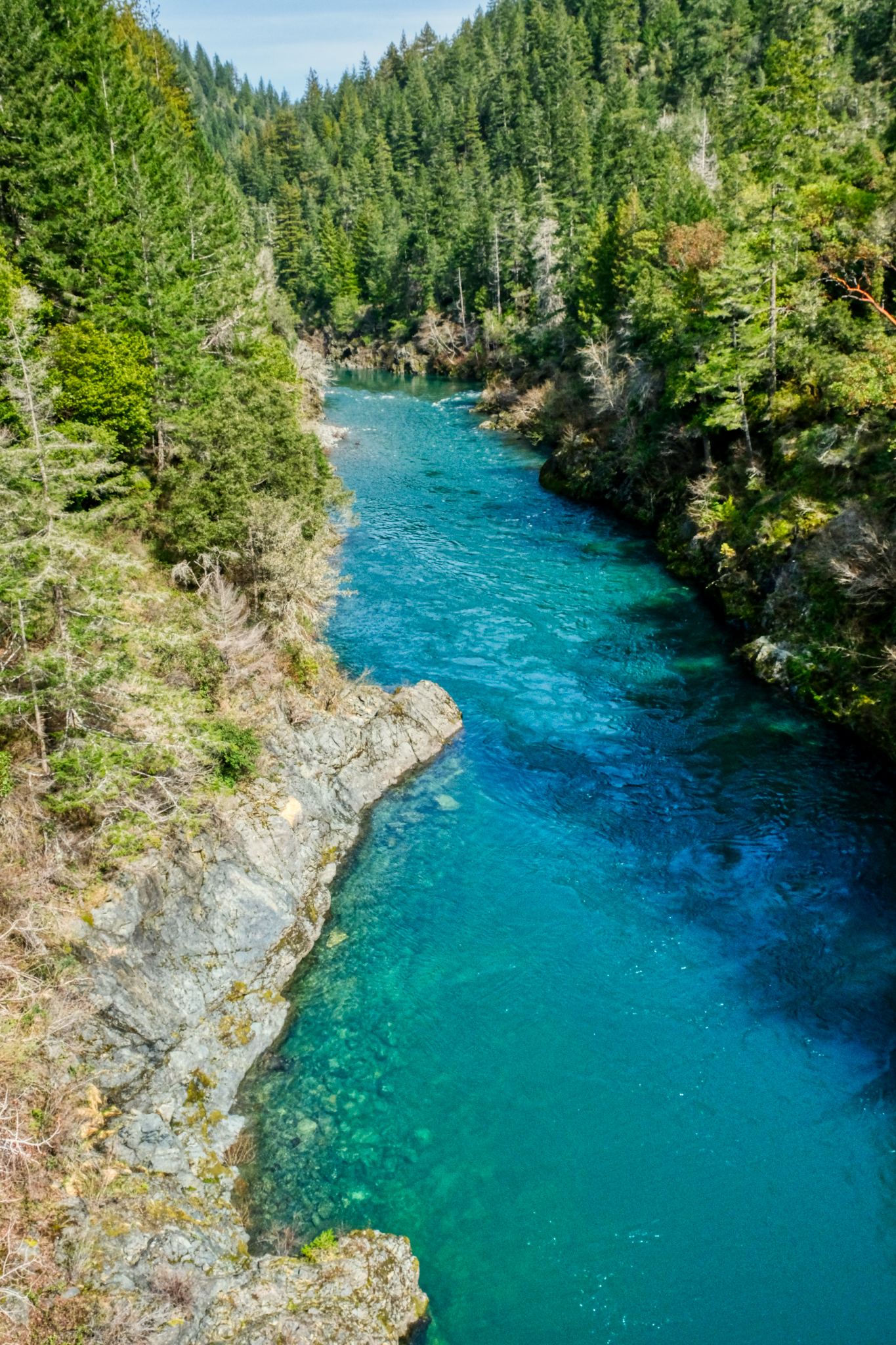 Crossing the Smith River on the way to a redwood stand.
Crossing the Smith River on the way to a redwood stand.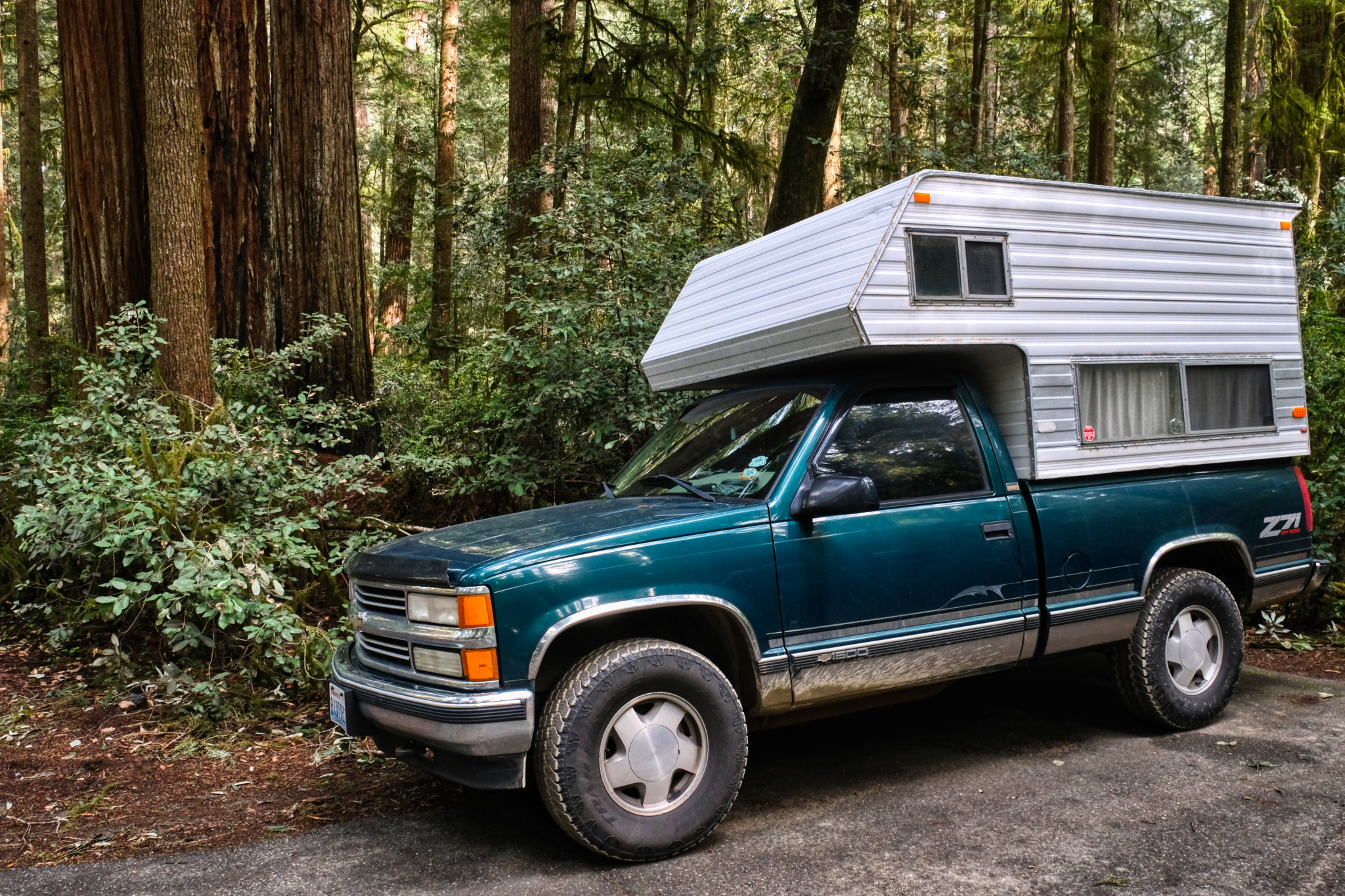 Arriving at Jedediah Smith Redwoods State Park.
Arriving at Jedediah Smith Redwoods State Park.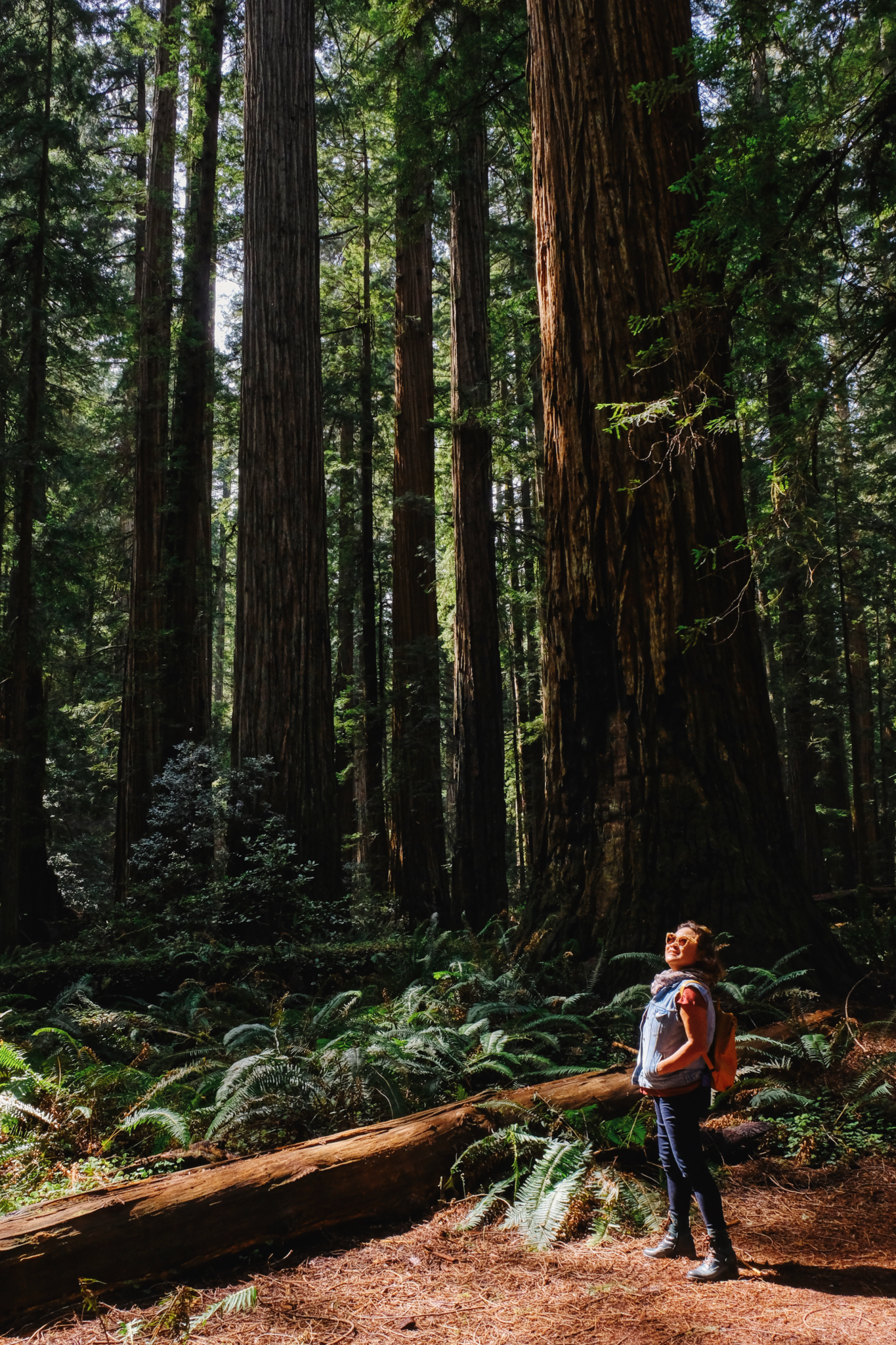 One of many foreign tourists that visit the giant redwoods of California every year.
One of many foreign tourists that visit the giant redwoods of California every year.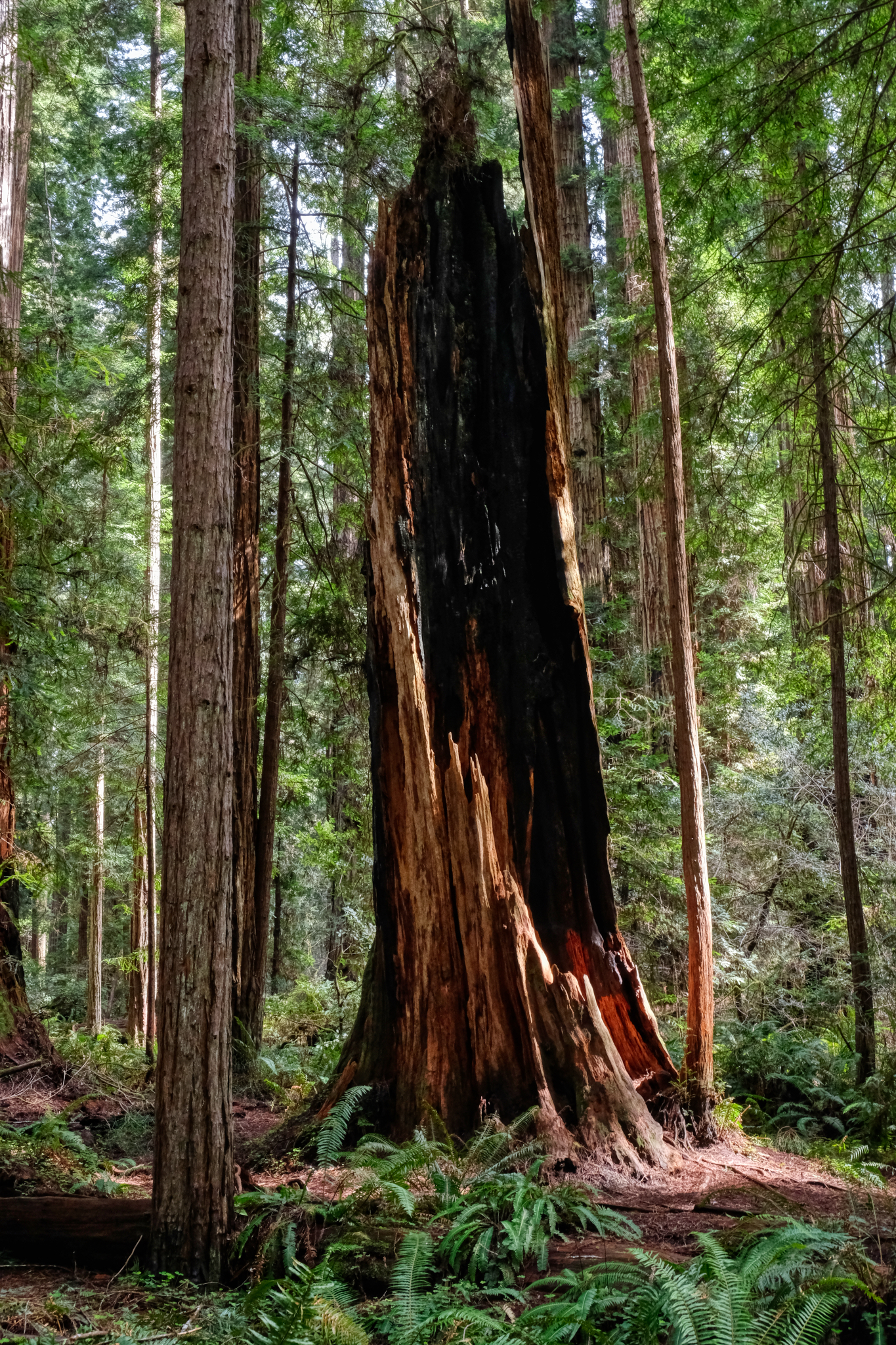 A fantastically dramatic redwood snag left from some past burn.
A fantastically dramatic redwood snag left from some past burn.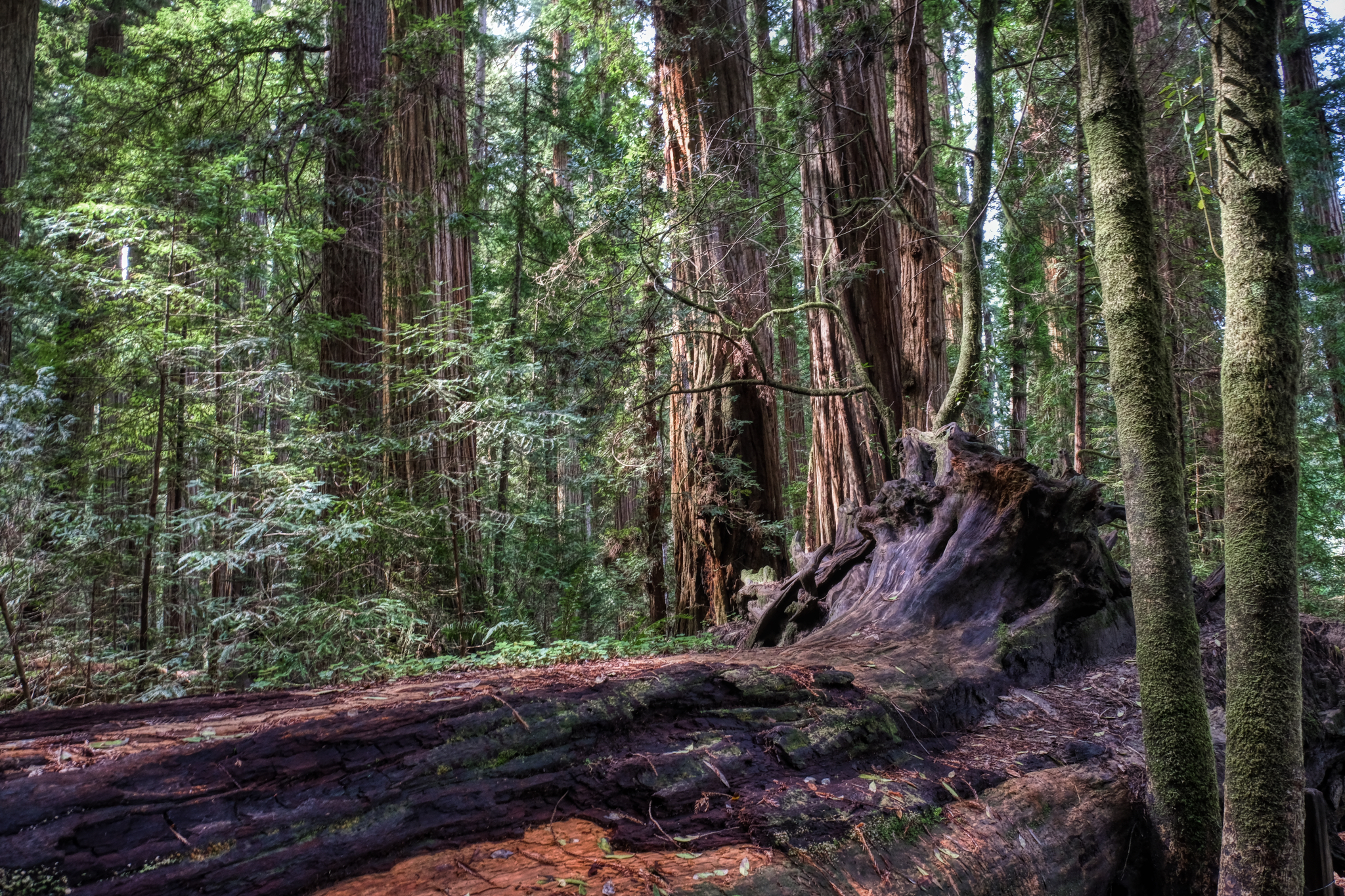 Ancient giant redwoods.
Ancient giant redwoods.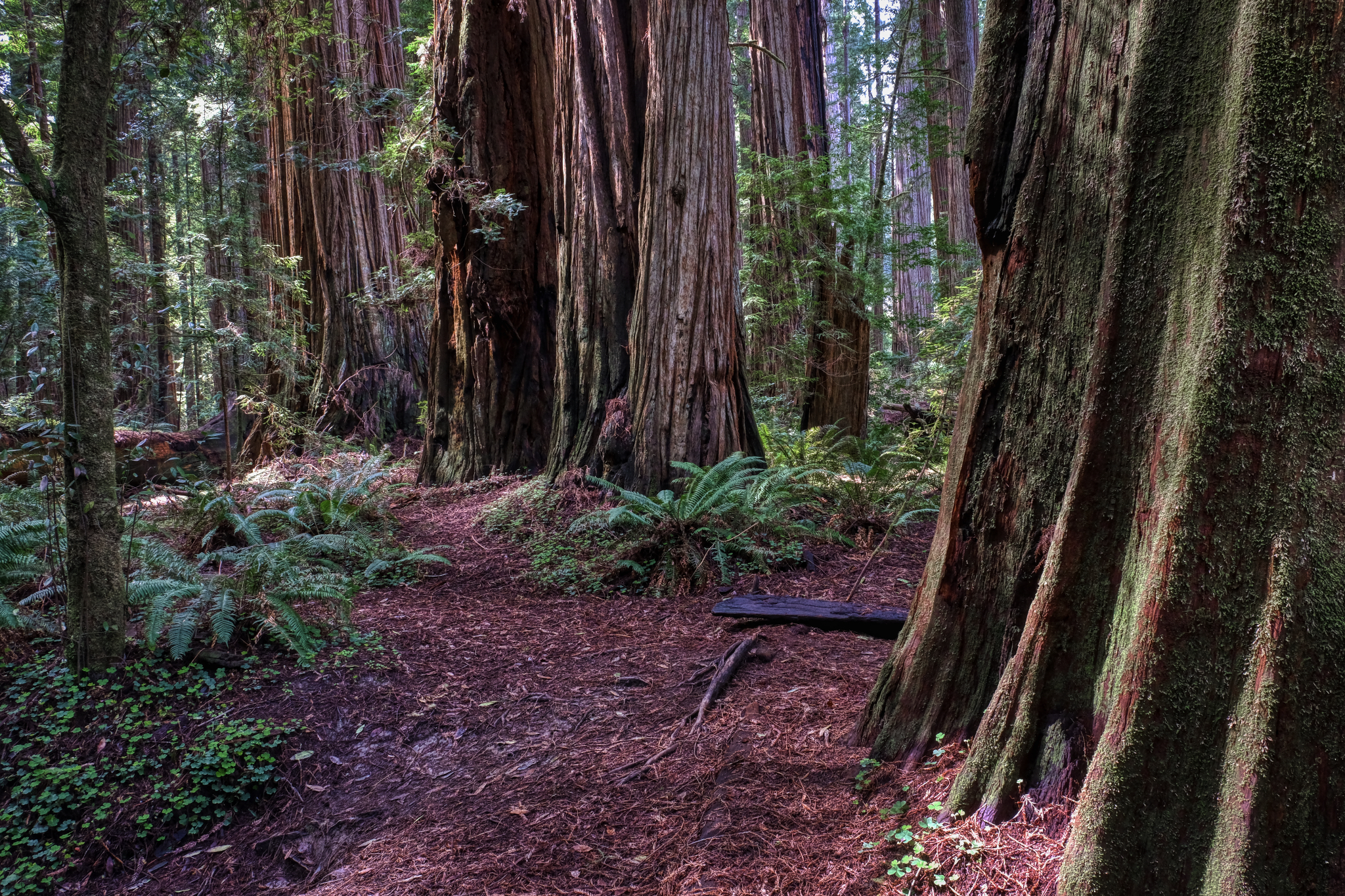 We walked for hours on the park paths among the towering redwoods.
We walked for hours on the park paths among the towering redwoods.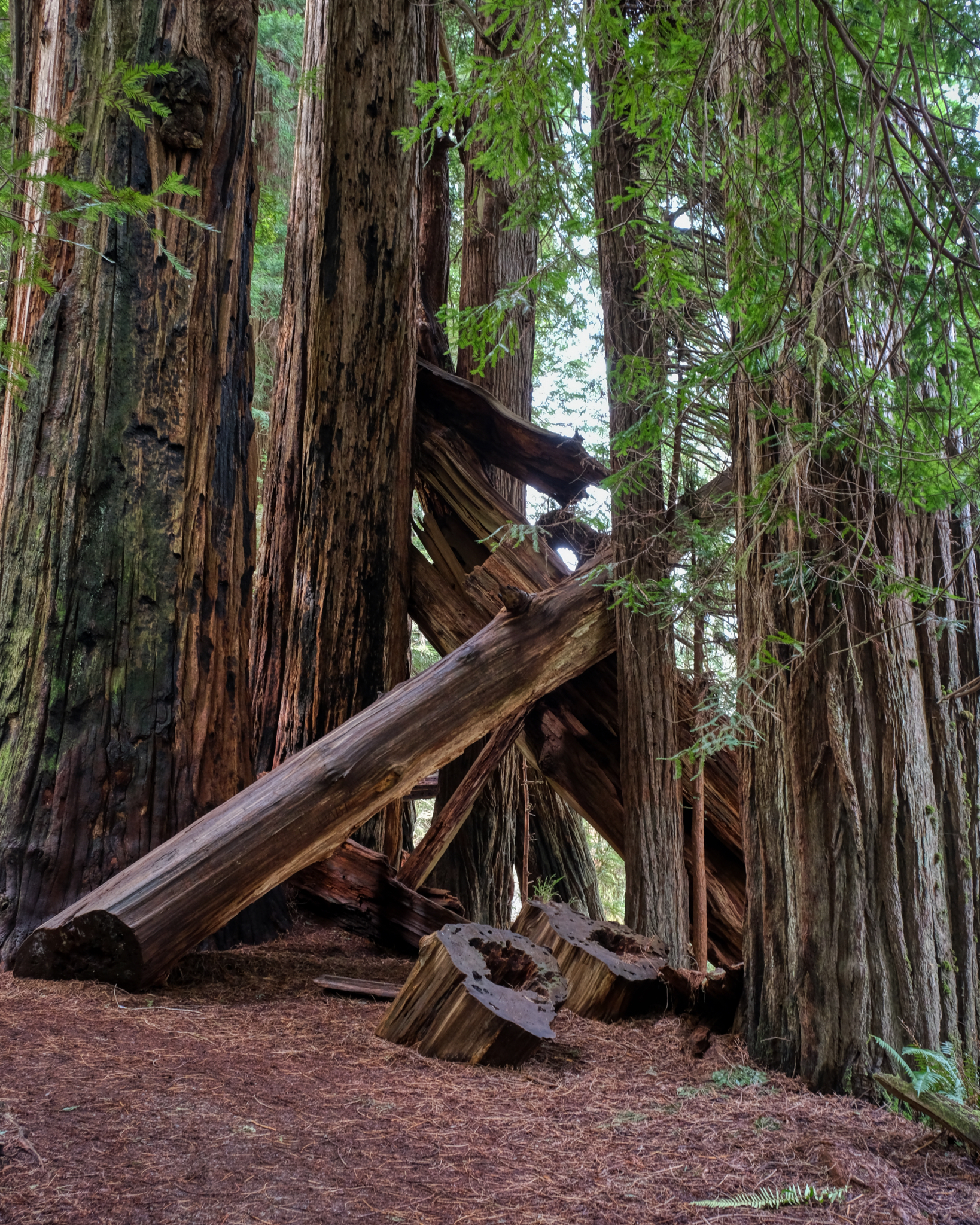 The park service did a good job of keeping the paths easily accessible by cutting back fallen redwoods.
The park service did a good job of keeping the paths easily accessible by cutting back fallen redwoods.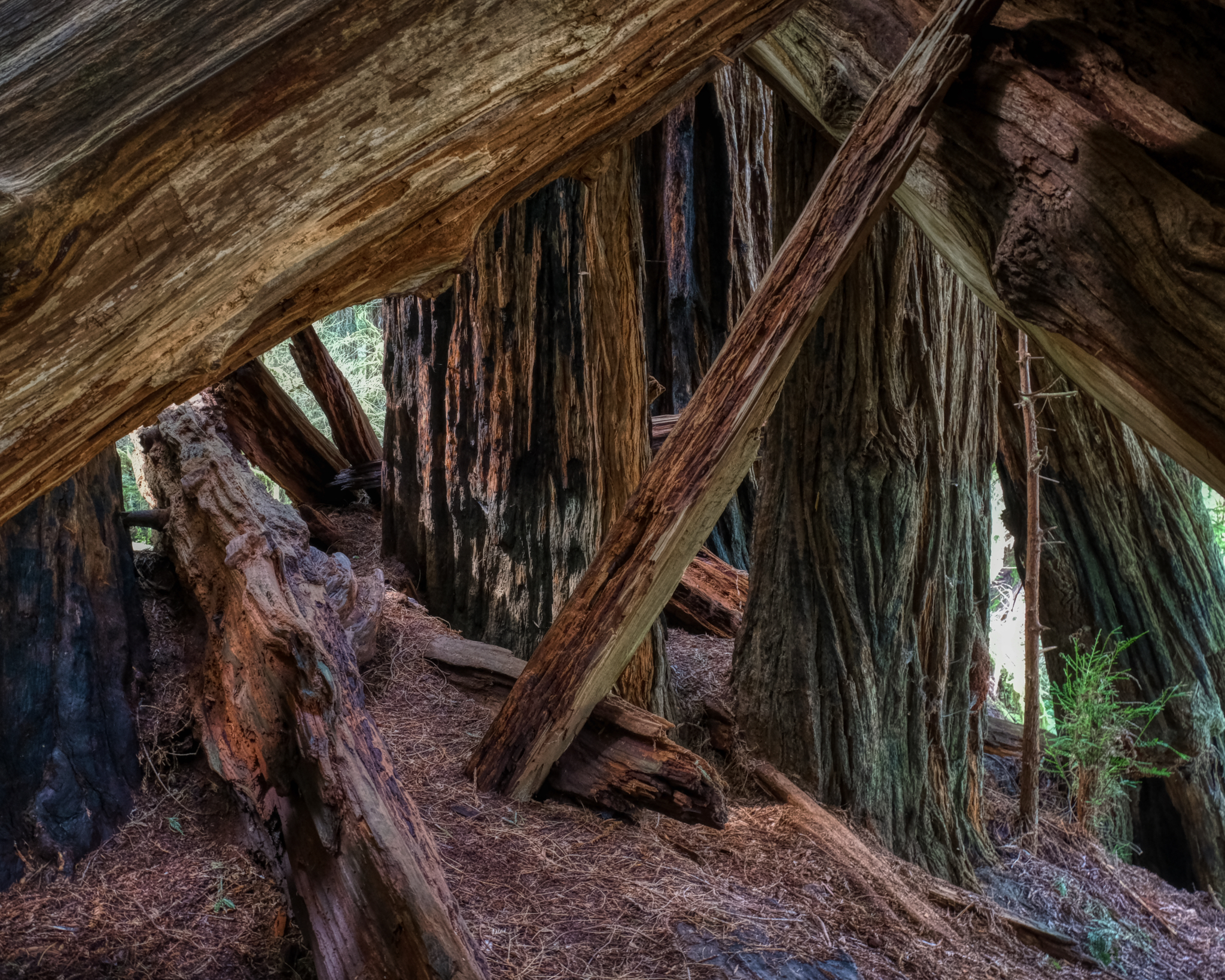 An incredible space, line, color.
An incredible space, line, color.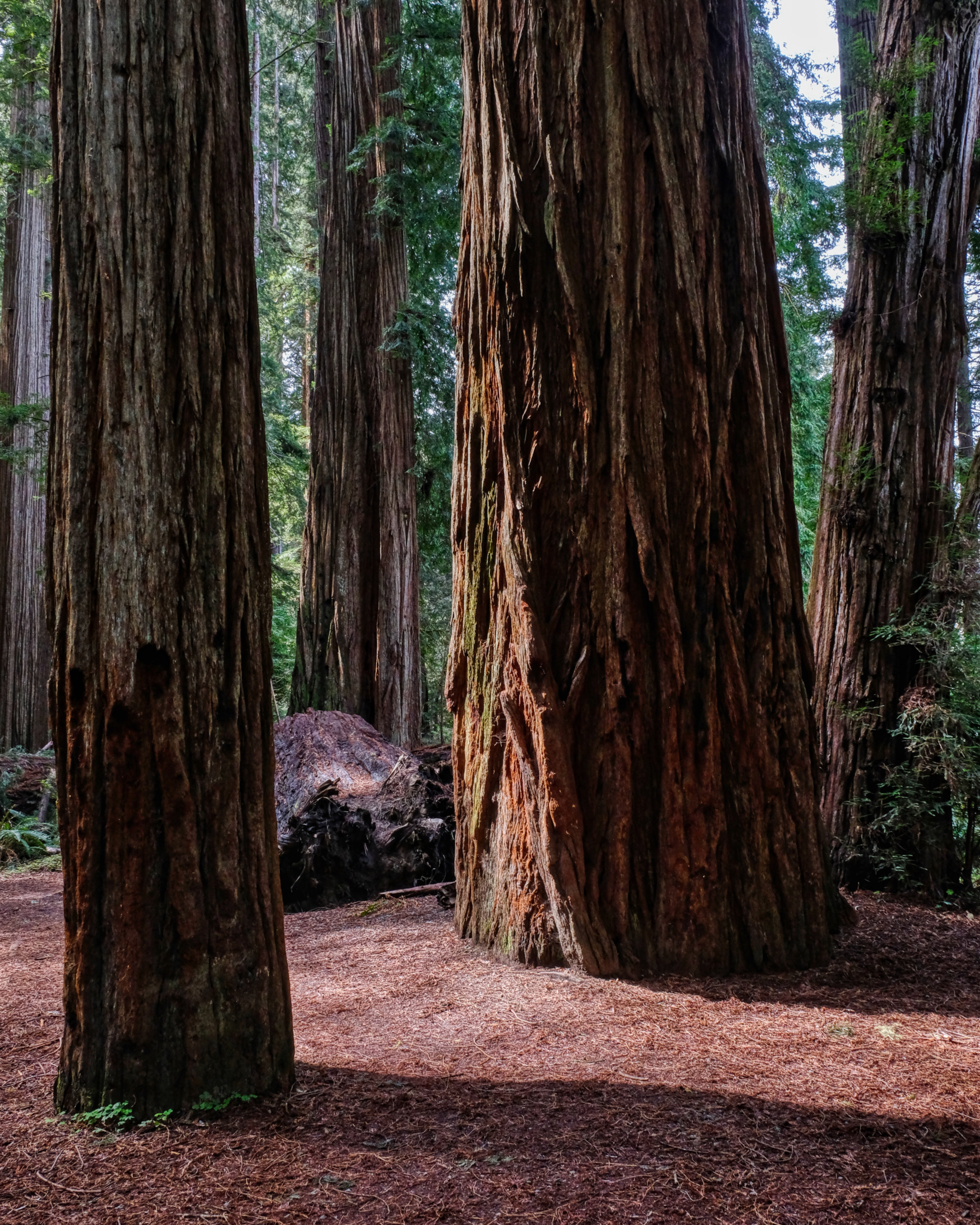 Ancient plant spirits . . .
Ancient plant spirits . . .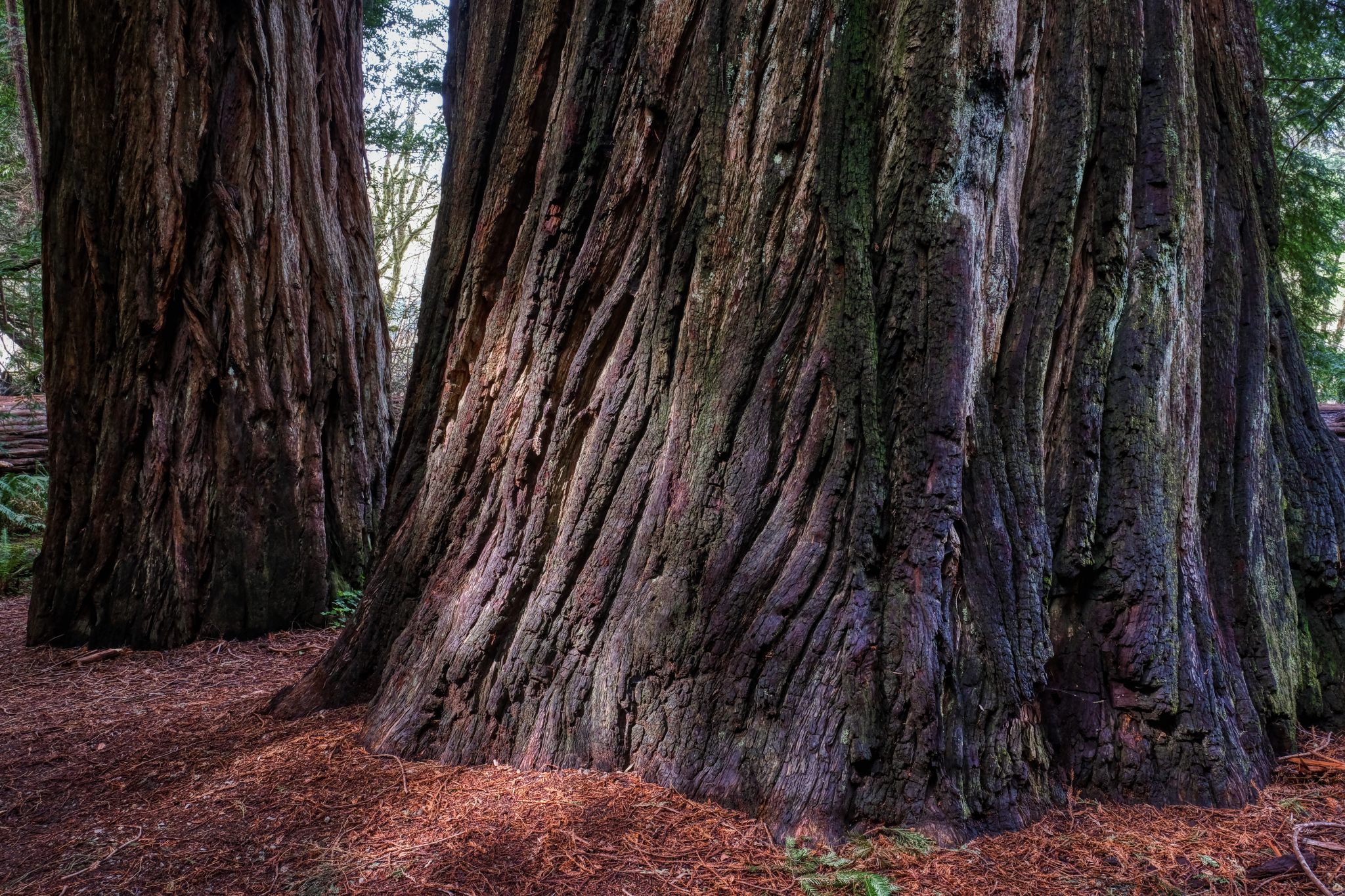 Sturdy, solid, immense, strong, tall . . .
Sturdy, solid, immense, strong, tall . . .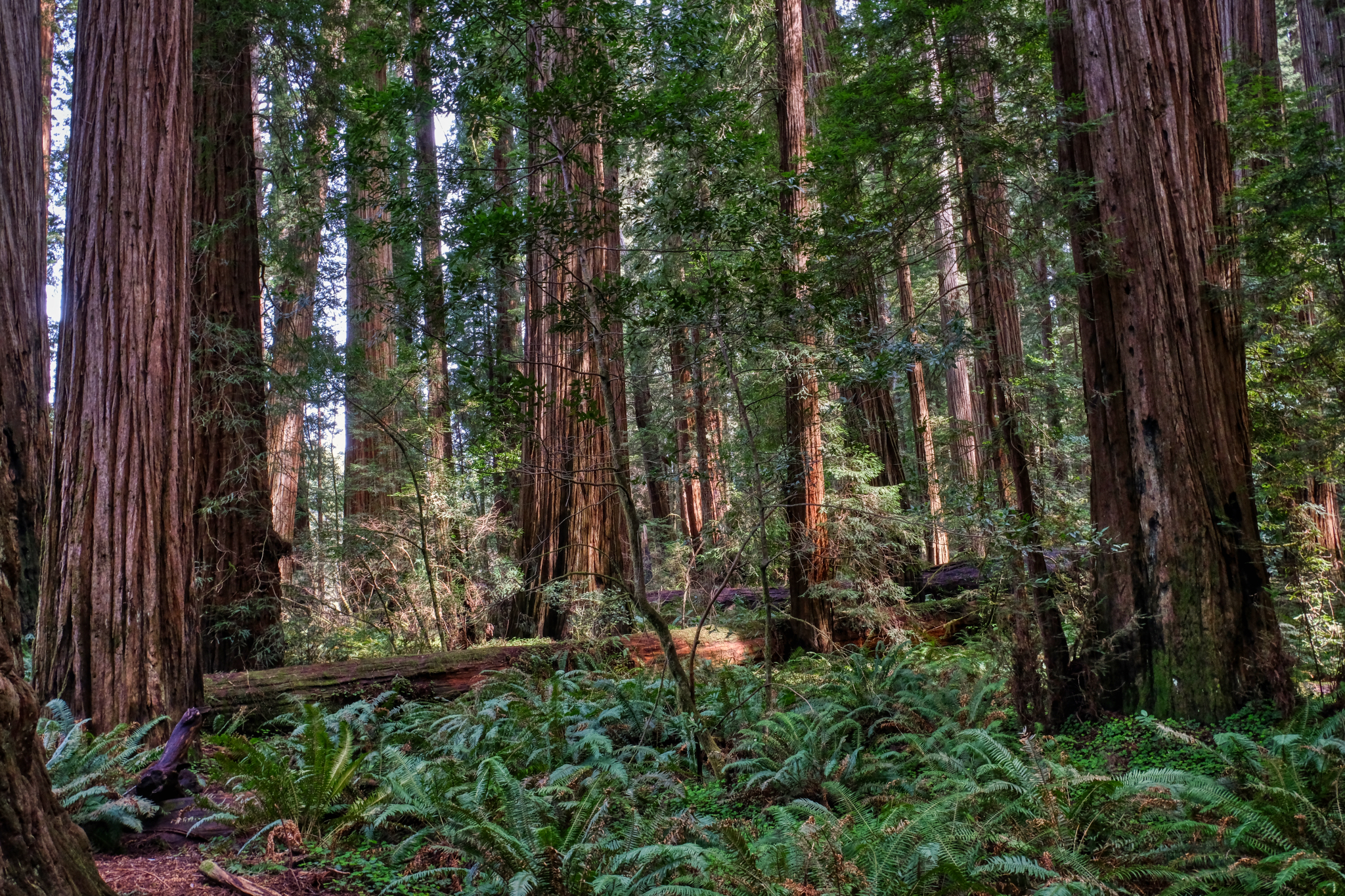 Walking in the giant redwood forest is a spiritual experience.
Walking in the giant redwood forest is a spiritual experience.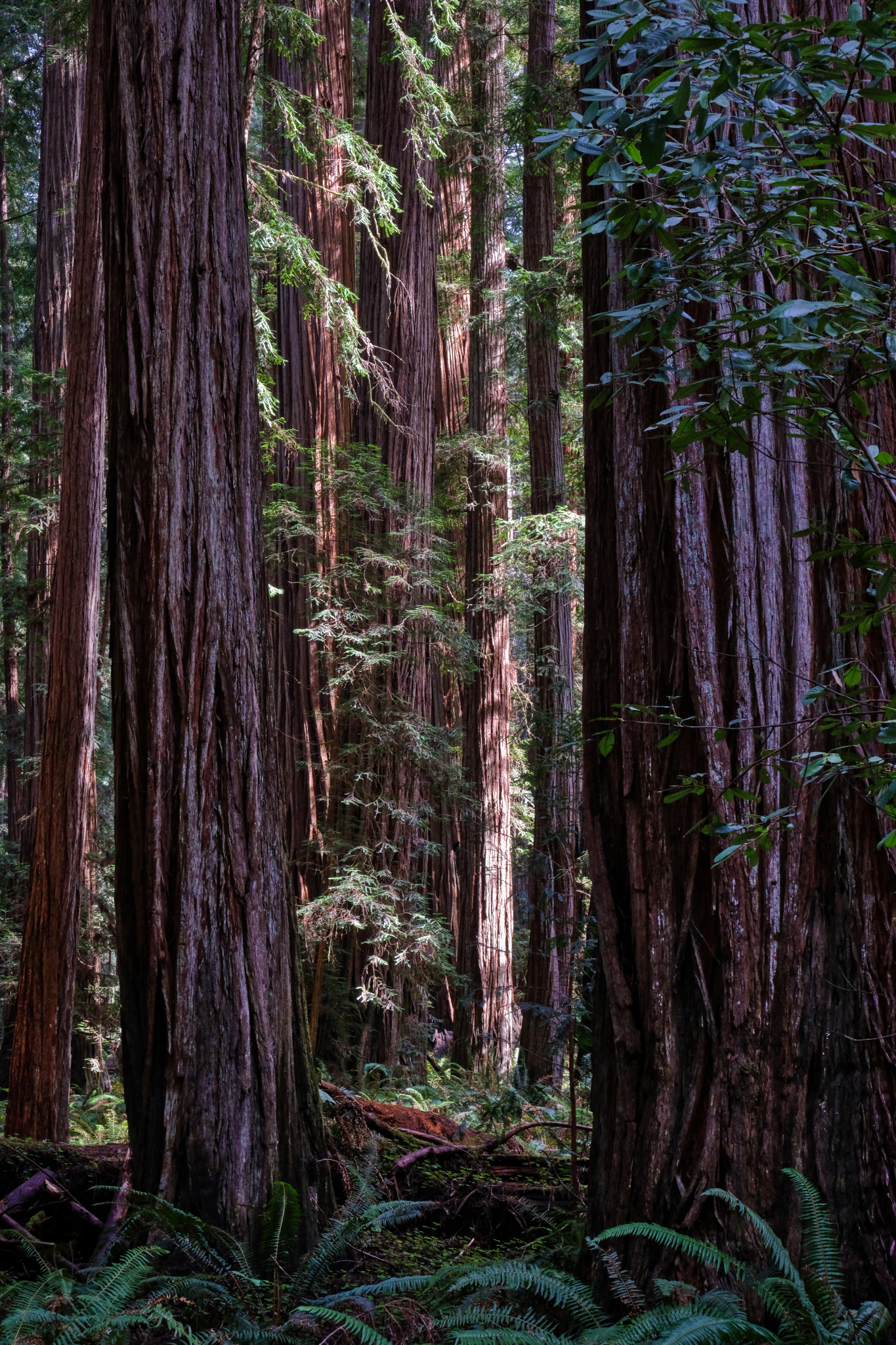 Wonderful shafts of clear, bright light illuminated the forest.
Wonderful shafts of clear, bright light illuminated the forest.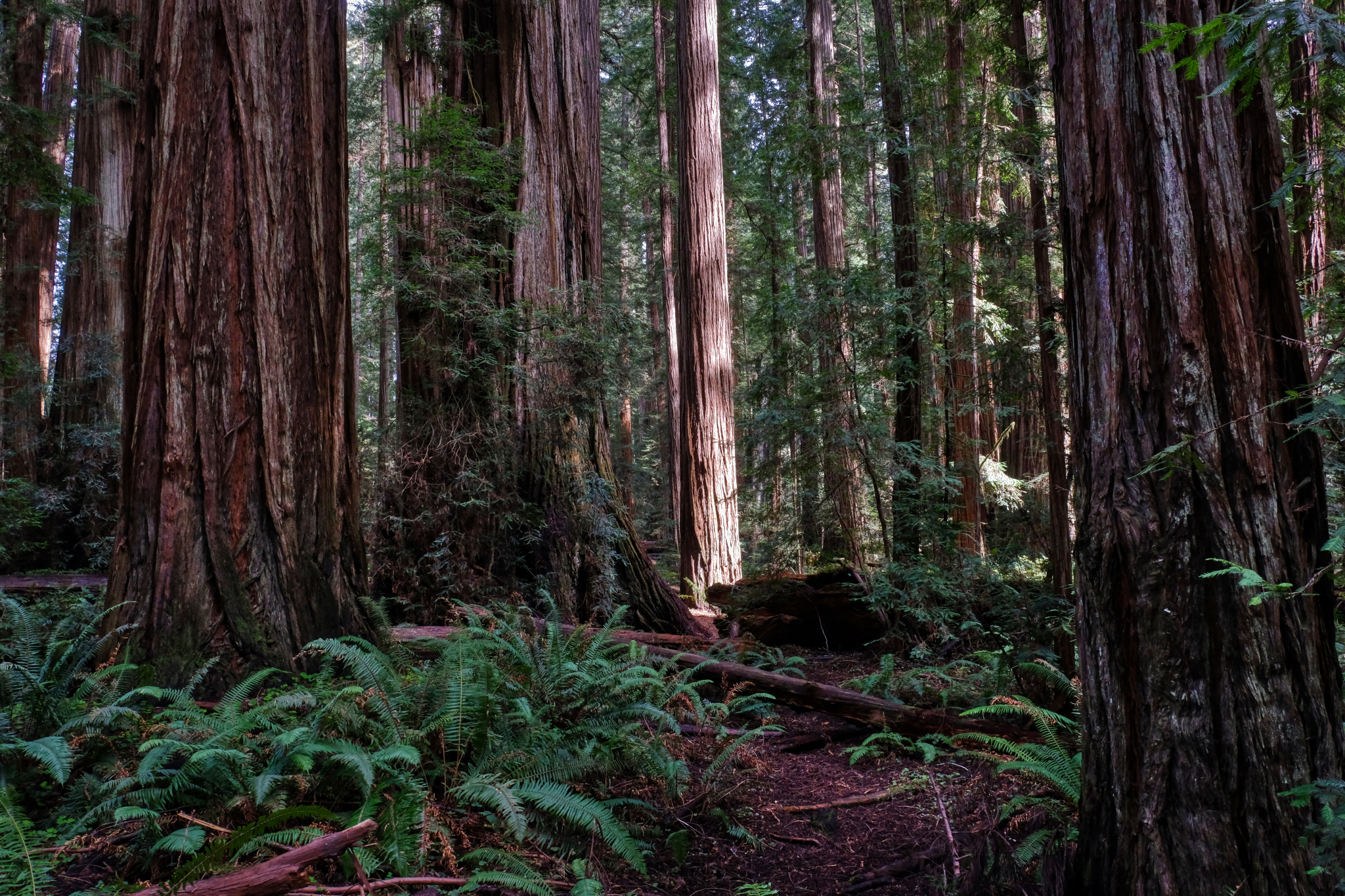 A single lit redwood in the dense forest.
A single lit redwood in the dense forest.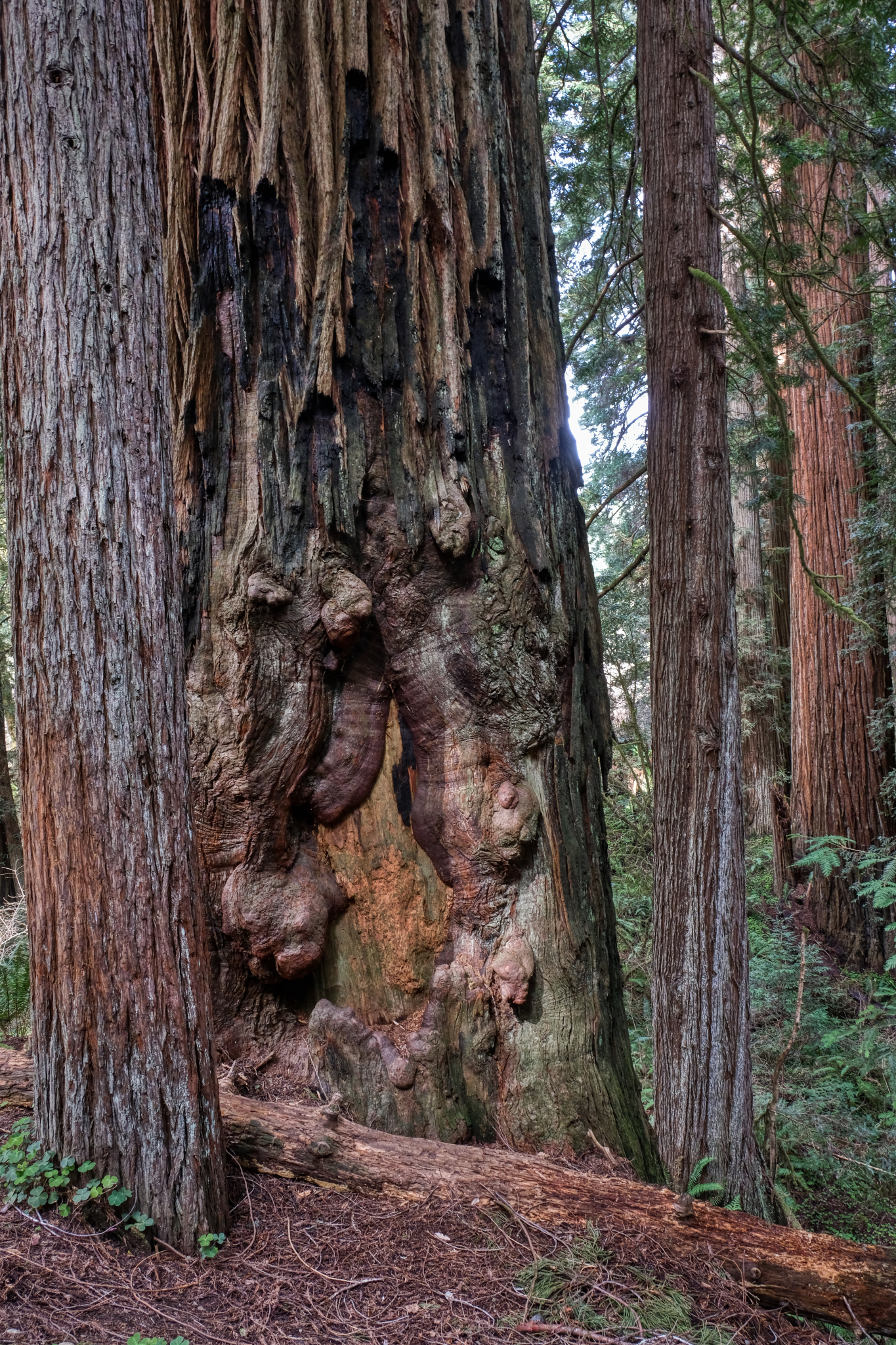 A giant redwood healing an old wound.
A giant redwood healing an old wound.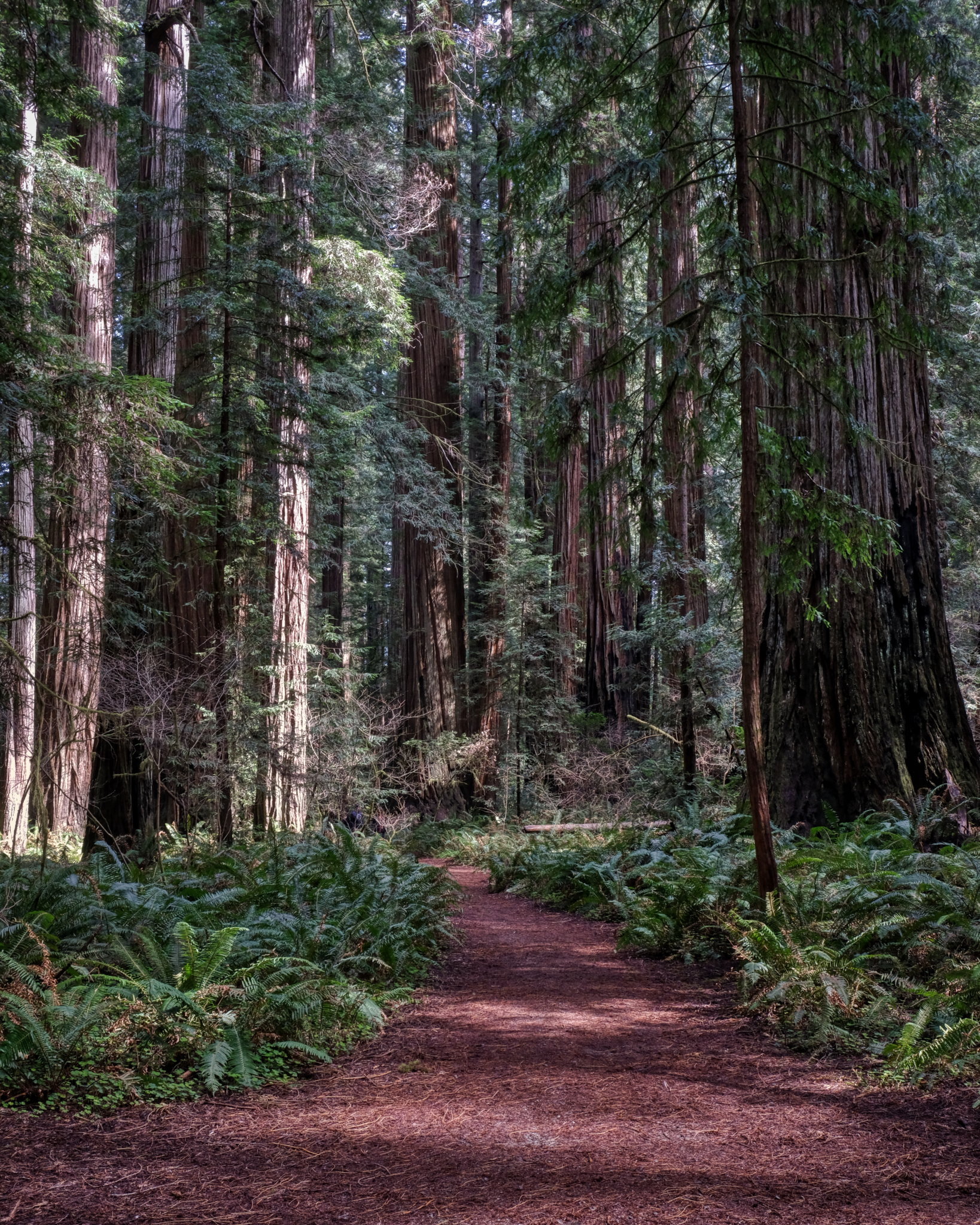 A beautiful path through a magical forest.
A beautiful path through a magical forest.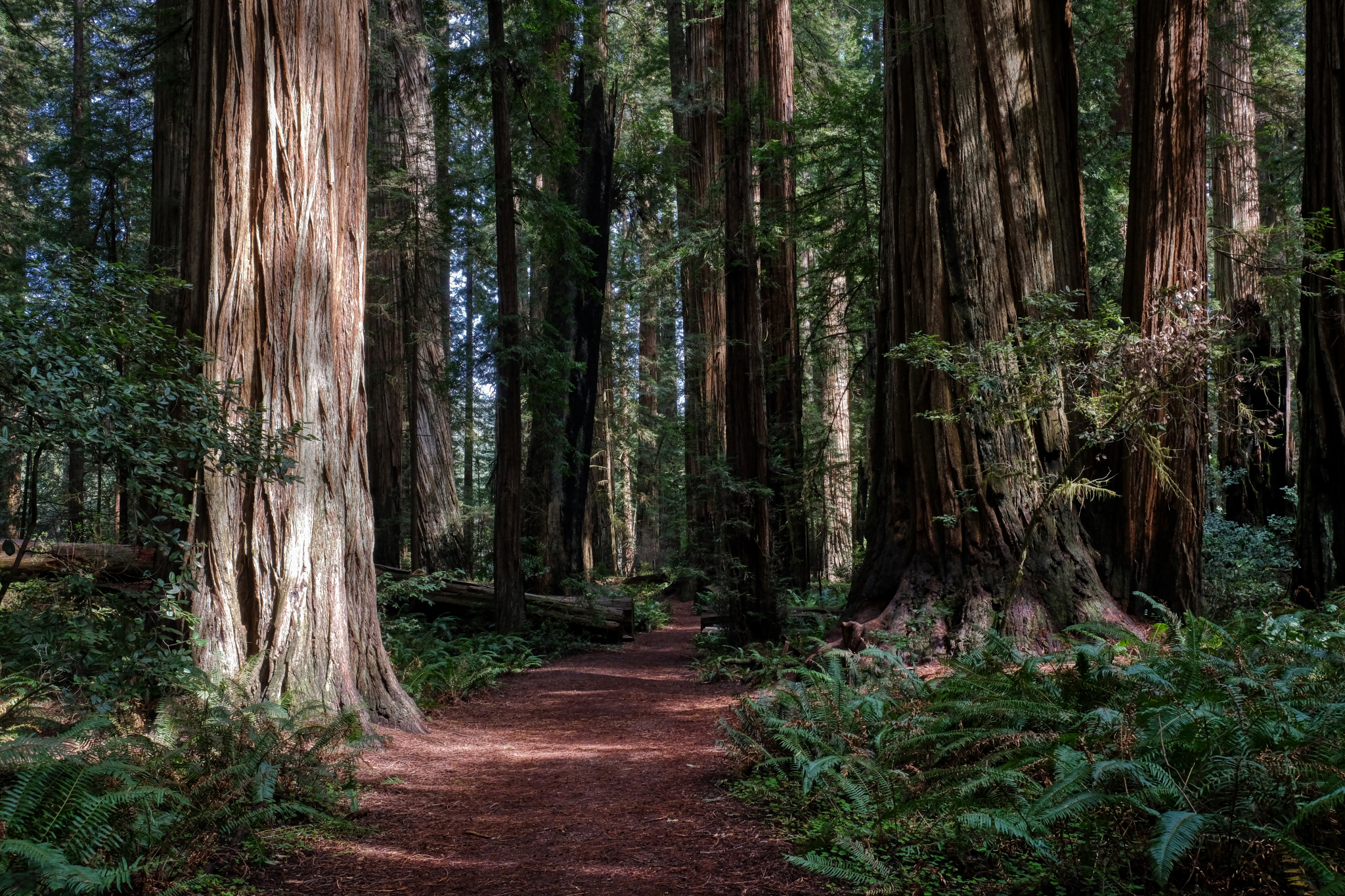 Deeper into the redwood forest.
Deeper into the redwood forest.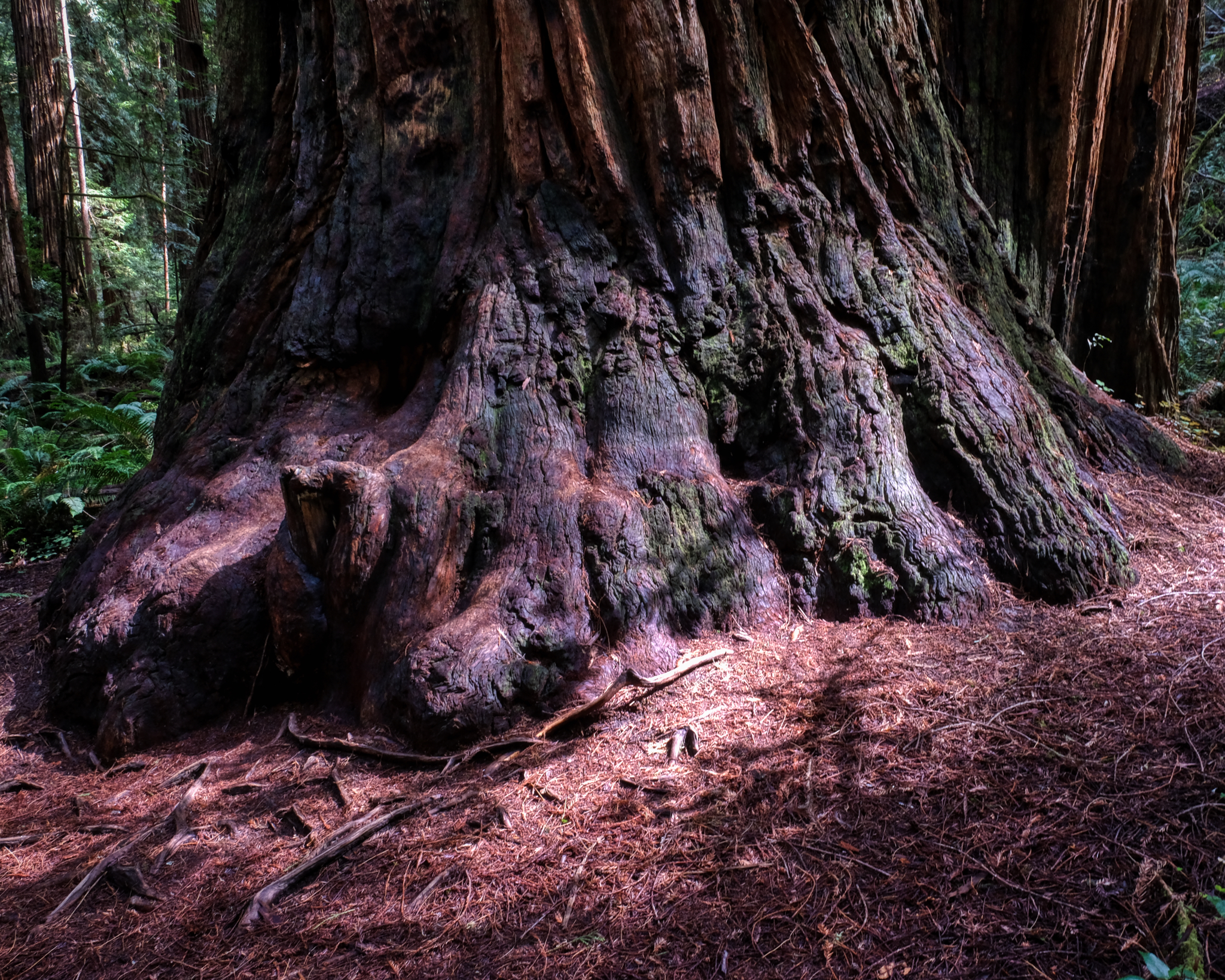 The sturdy foot of a giant redwood.
The sturdy foot of a giant redwood.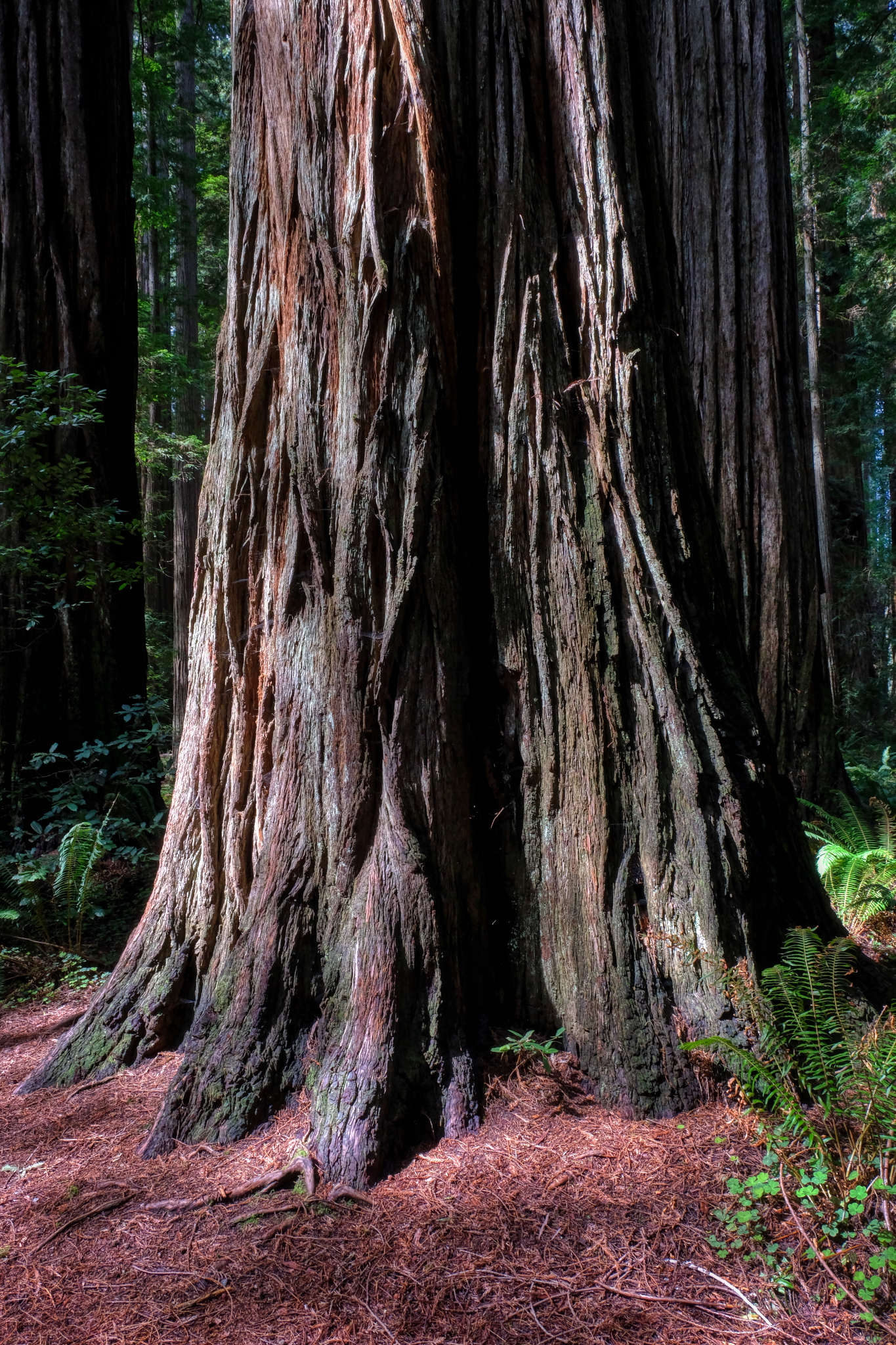 The existential redwood.
The existential redwood.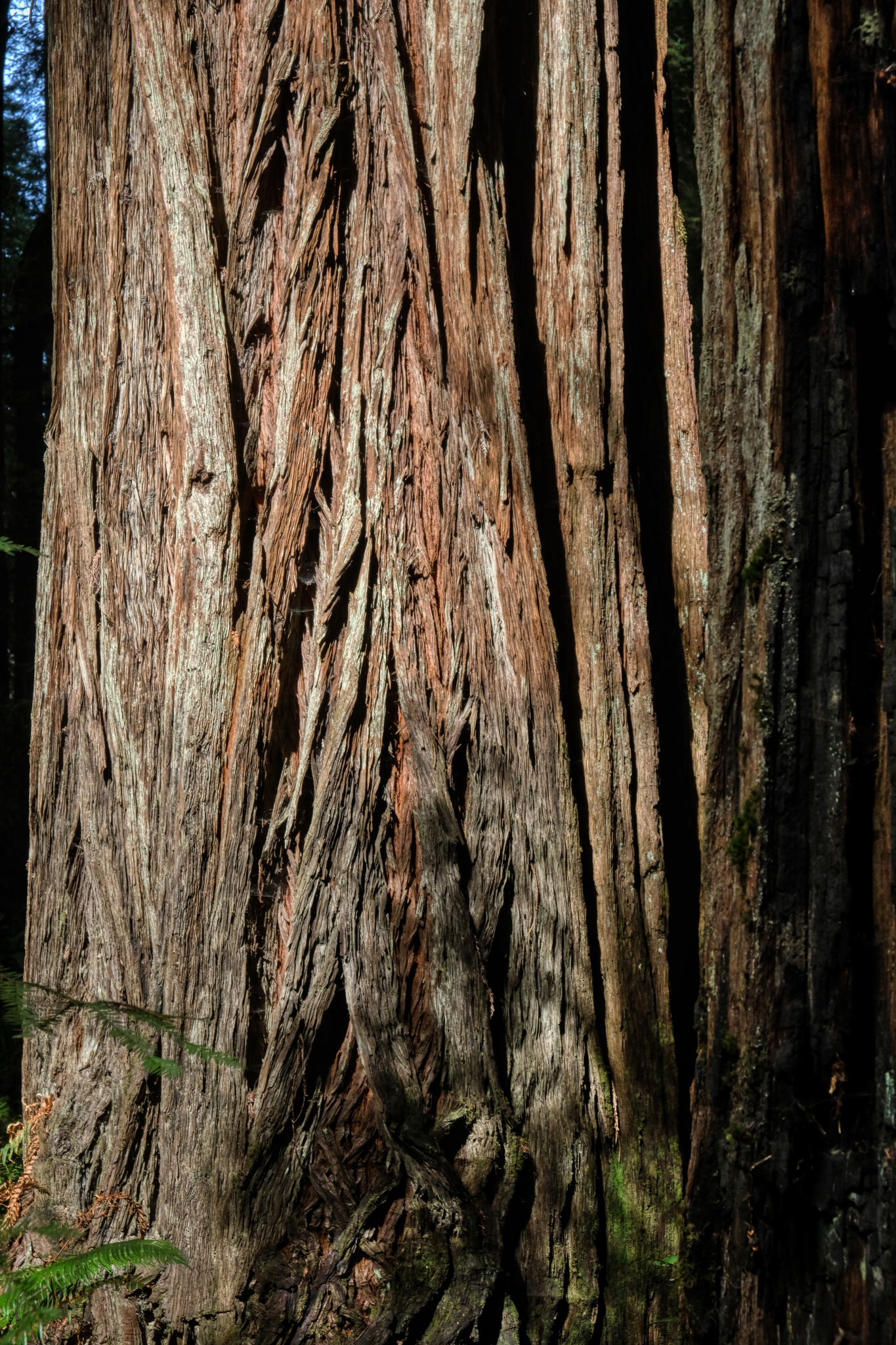 Redwood bark.
Redwood bark.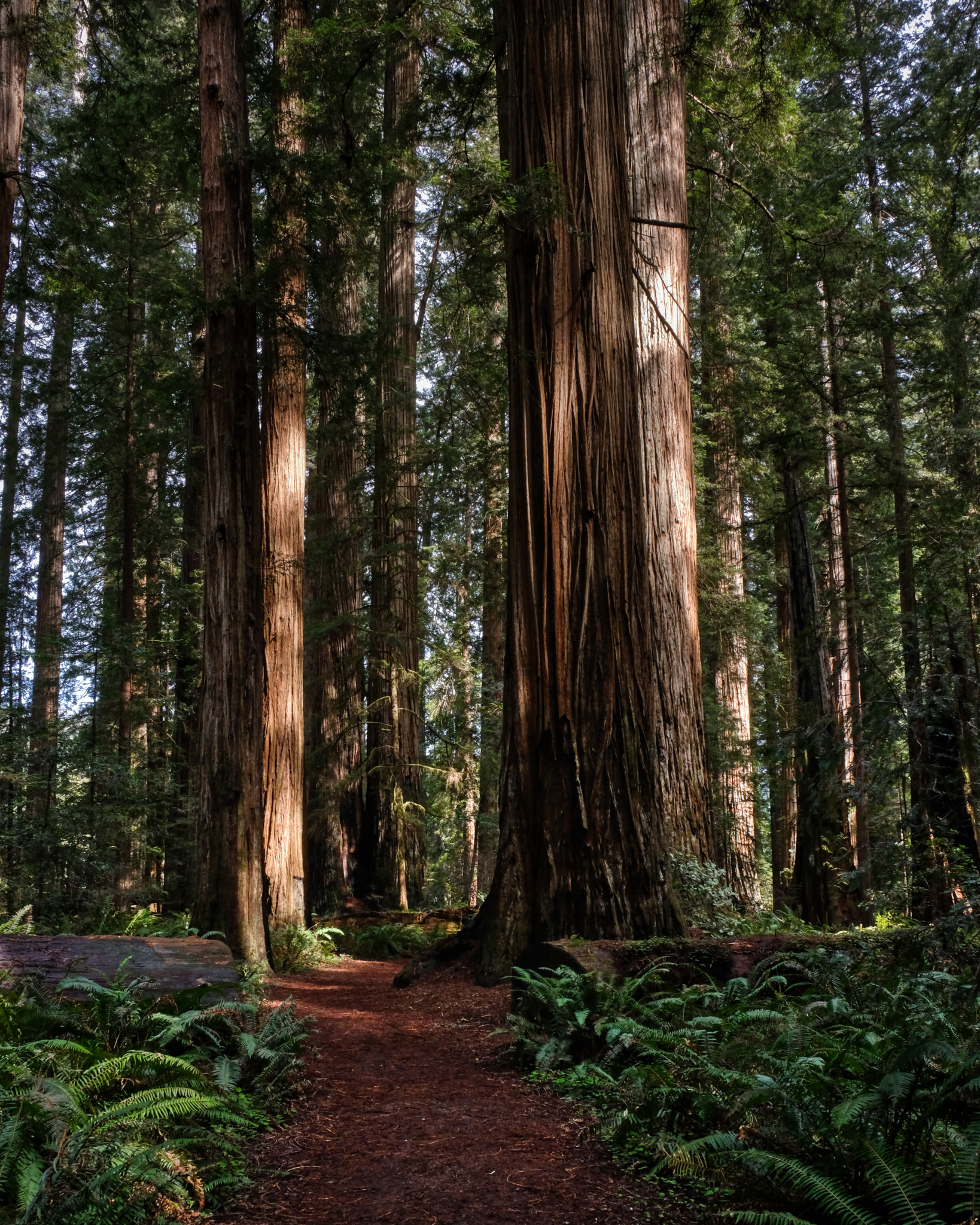 We could have stayed in these woods all day . . . but the call of a seafood dinner beckoned.
We could have stayed in these woods all day . . . but the call of a seafood dinner beckoned.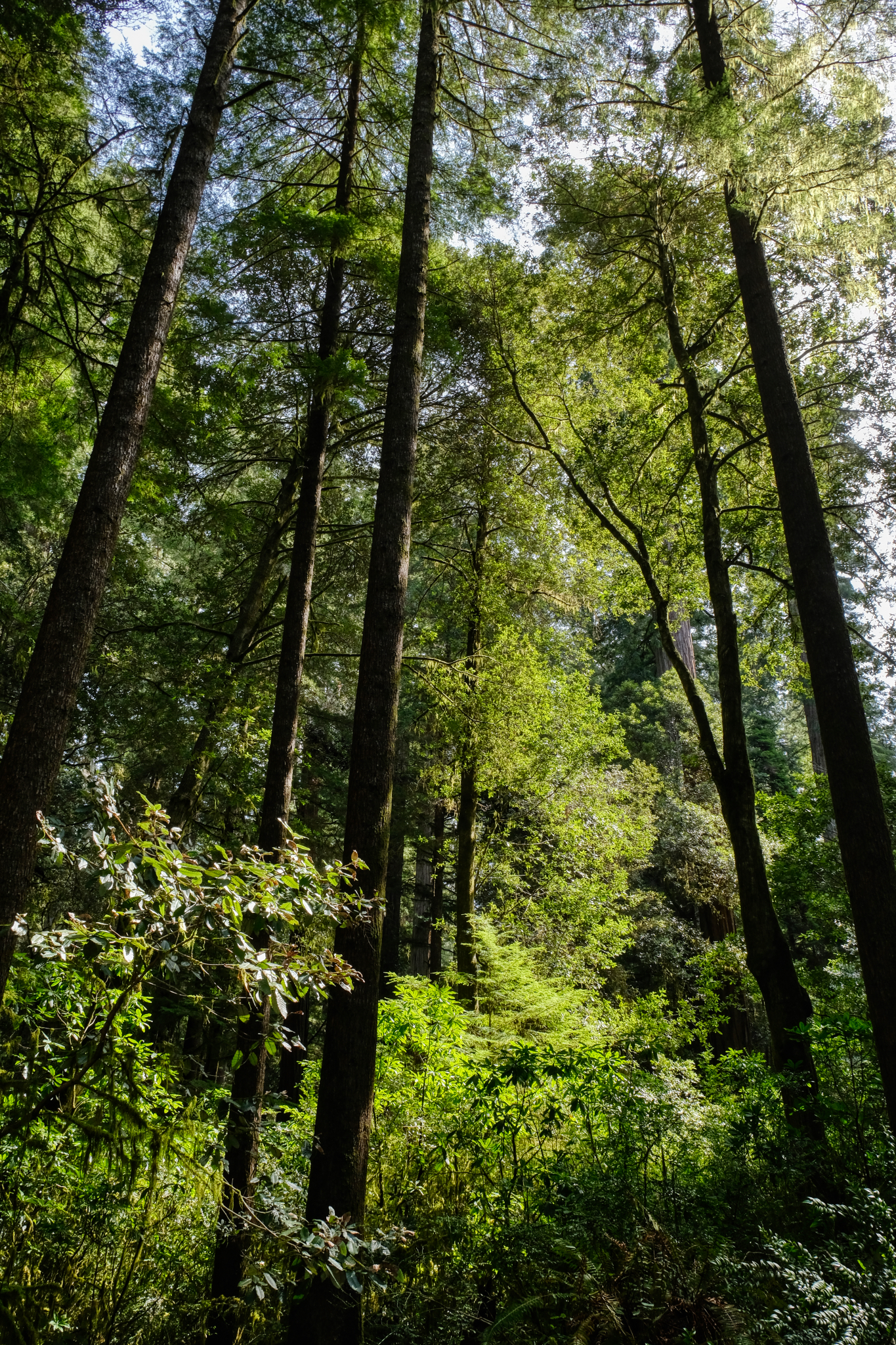 Out through the small trees to the camper . . and then, the next day, back to Keizer, Oregon on I-5.
Out through the small trees to the camper . . and then, the next day, back to Keizer, Oregon on I-5. Dr. Jeff Harper
Dr. Jeff Harper
Redwood Burls
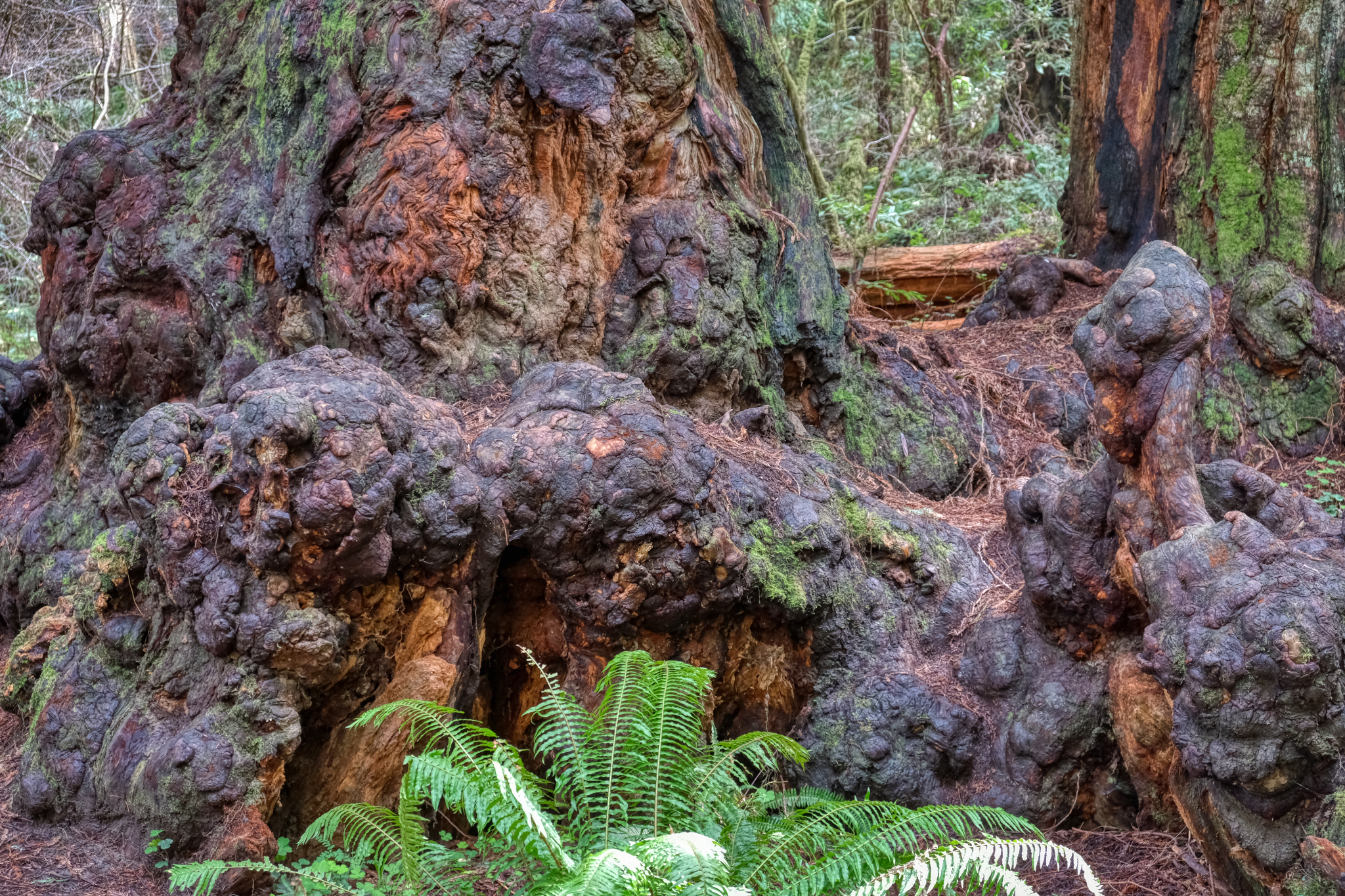 I became fascinated with the redwood burls in this forest.
I became fascinated with the redwood burls in this forest.
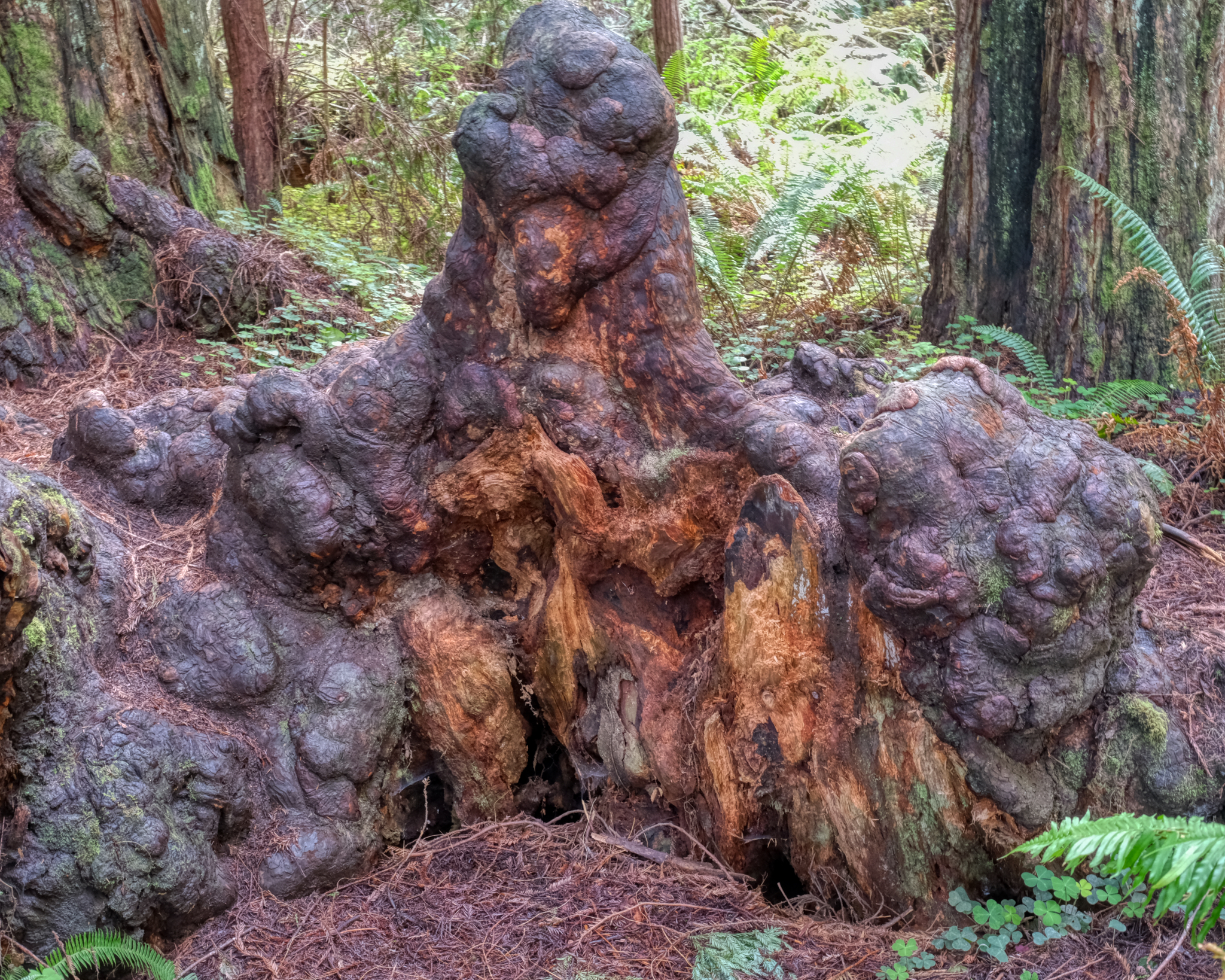 Burls are growth gone astray . . .
Burls are growth gone astray . . .
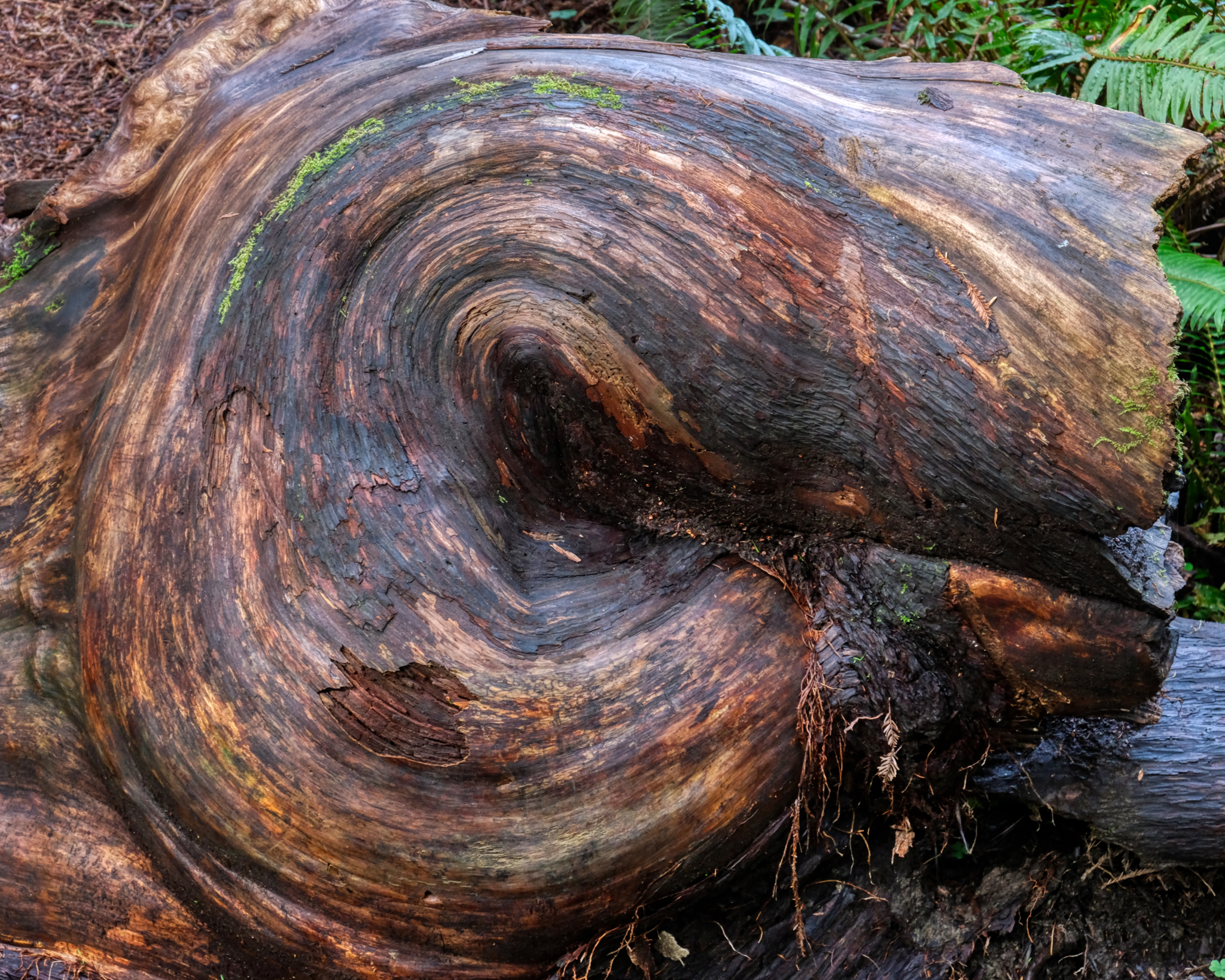 Every burl is different.
Every burl is different.
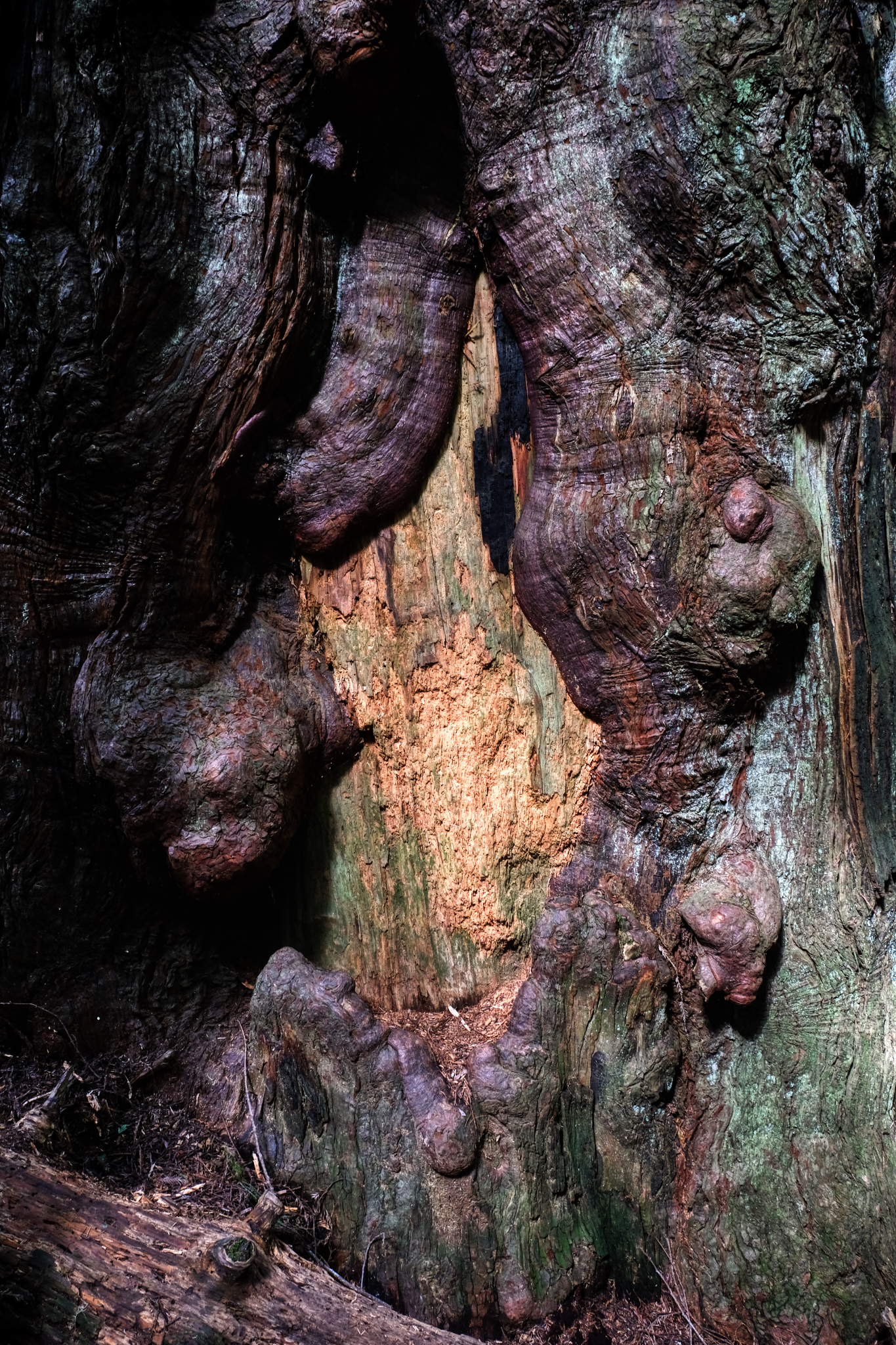 fascinating.
fascinating.
A Beach Week-End: Hua Hin, Thailand
 Wednesday, July 10, 2019 at 6:45PM
Wednesday, July 10, 2019 at 6:45PM  It wasn't a Thai holiday, so it was a good time to drive the 2 1/2 hours from Bangkok to the seaside town of Hua Hin.
It wasn't a Thai holiday, so it was a good time to drive the 2 1/2 hours from Bangkok to the seaside town of Hua Hin. Hua Hin is a sweet little seaside town with just enough tourism to have a variety of restaurants and shops of interest. We are here in the Not The Tourist Season. It is growing fast.
Hua Hin is a sweet little seaside town with just enough tourism to have a variety of restaurants and shops of interest. We are here in the Not The Tourist Season. It is growing fast. There are interesting seafood restaurents built on piers over the Gulf of Thailand.
There are interesting seafood restaurents built on piers over the Gulf of Thailand. There are a number of large hotels and beach front condominiums along this part of the coast.
There are a number of large hotels and beach front condominiums along this part of the coast. There was a surprising lack of tourists at the hotel beach areas. The weather was fine . . . there were occasional afternoon tropical showers to keep the temperature down.
There was a surprising lack of tourists at the hotel beach areas. The weather was fine . . . there were occasional afternoon tropical showers to keep the temperature down. This artist serves the tourist trade by making family portraits from photos from iPhones.
This artist serves the tourist trade by making family portraits from photos from iPhones. Hua Hin is a nice place to stroll around in to sample the wonderful Thai treats . . .
Hua Hin is a nice place to stroll around in to sample the wonderful Thai treats . . .  . . . like sticky rice and mangoes. The best dessert on earth (in my estimation).
. . . like sticky rice and mangoes. The best dessert on earth (in my estimation). You never know who you will run into. This young man lived in Los Angeles, California for many years before deciding he had a better life in Thailand as a street cart barista. "You don't know the difference until you lived somewhere else. I love my life in Thailand."
You never know who you will run into. This young man lived in Los Angeles, California for many years before deciding he had a better life in Thailand as a street cart barista. "You don't know the difference until you lived somewhere else. I love my life in Thailand." Making a living selling vegetables door to door in Hua Hin.
Making a living selling vegetables door to door in Hua Hin. People who work outside in the sunshine often completely cover themselves from head to toe.
People who work outside in the sunshine often completely cover themselves from head to toe. It looks like she has dome a little grocery shopping for herself as well . . .
It looks like she has dome a little grocery shopping for herself as well . . . Hua Hin sees many new European retirees every year. In this case, a Frenchman came to Hua Hin 25 years ago and opened up this beach side French restaurant. It serves delicious food. Real French food.
Hua Hin sees many new European retirees every year. In this case, a Frenchman came to Hua Hin 25 years ago and opened up this beach side French restaurant. It serves delicious food. Real French food. The view from the French restaurant is very relaxing.
The view from the French restaurant is very relaxing. After lunch we strolled over to a nearby Chinese Buddhist Tempe.
After lunch we strolled over to a nearby Chinese Buddhist Tempe. I love exploring these temples . . . and paying respect to The Buddha and what he hoped for all of us.
I love exploring these temples . . . and paying respect to The Buddha and what he hoped for all of us. I love the decoration and the array of colorful votive items at these Chinese temples.
I love the decoration and the array of colorful votive items at these Chinese temples. A small incense pot and altar. Touching.
A small incense pot and altar. Touching. The view from the Chinese temple back to Hua Hin town. As can be seen, Hua Hin sits on a narrow coastal shelf between low hills and the Gulf of Thailand.
The view from the Chinese temple back to Hua Hin town. As can be seen, Hua Hin sits on a narrow coastal shelf between low hills and the Gulf of Thailand. Back at our seaside lodgings . . . the view from above.
Back at our seaside lodgings . . . the view from above. A lone fishing (squid) boat waiting for the crew.
A lone fishing (squid) boat waiting for the crew. A Hua Hin blue hour sunset (looking east, away from the setting sun).
A Hua Hin blue hour sunset (looking east, away from the setting sun). A Hua Hin sunrise sea.
A Hua Hin sunrise sea.Samut Songkhran & Amphawa Village - A Good Day Out and About in Thailand
 Sunday, May 26, 2019 at 2:16PM
Sunday, May 26, 2019 at 2:16PM 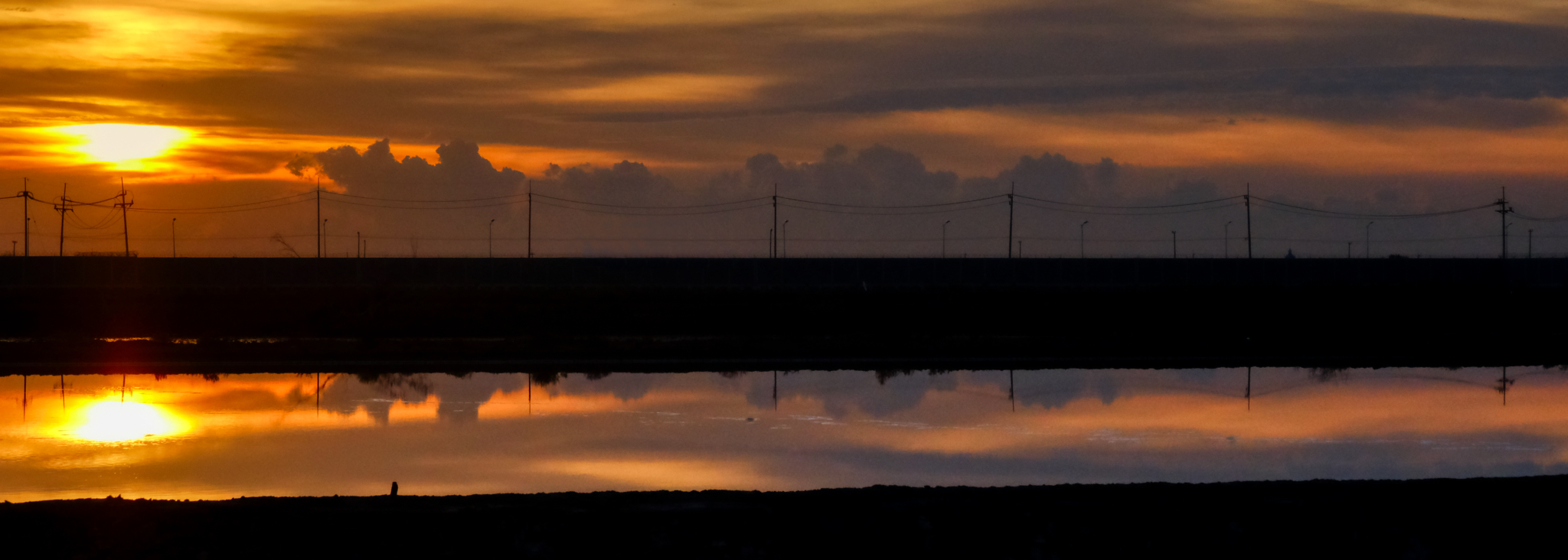 Up and out the door at 4:30am to catch the sun rise over the salt pans of Samut Songkhran with a couple of buddies . . . and for a day of photography.
Up and out the door at 4:30am to catch the sun rise over the salt pans of Samut Songkhran with a couple of buddies . . . and for a day of photography.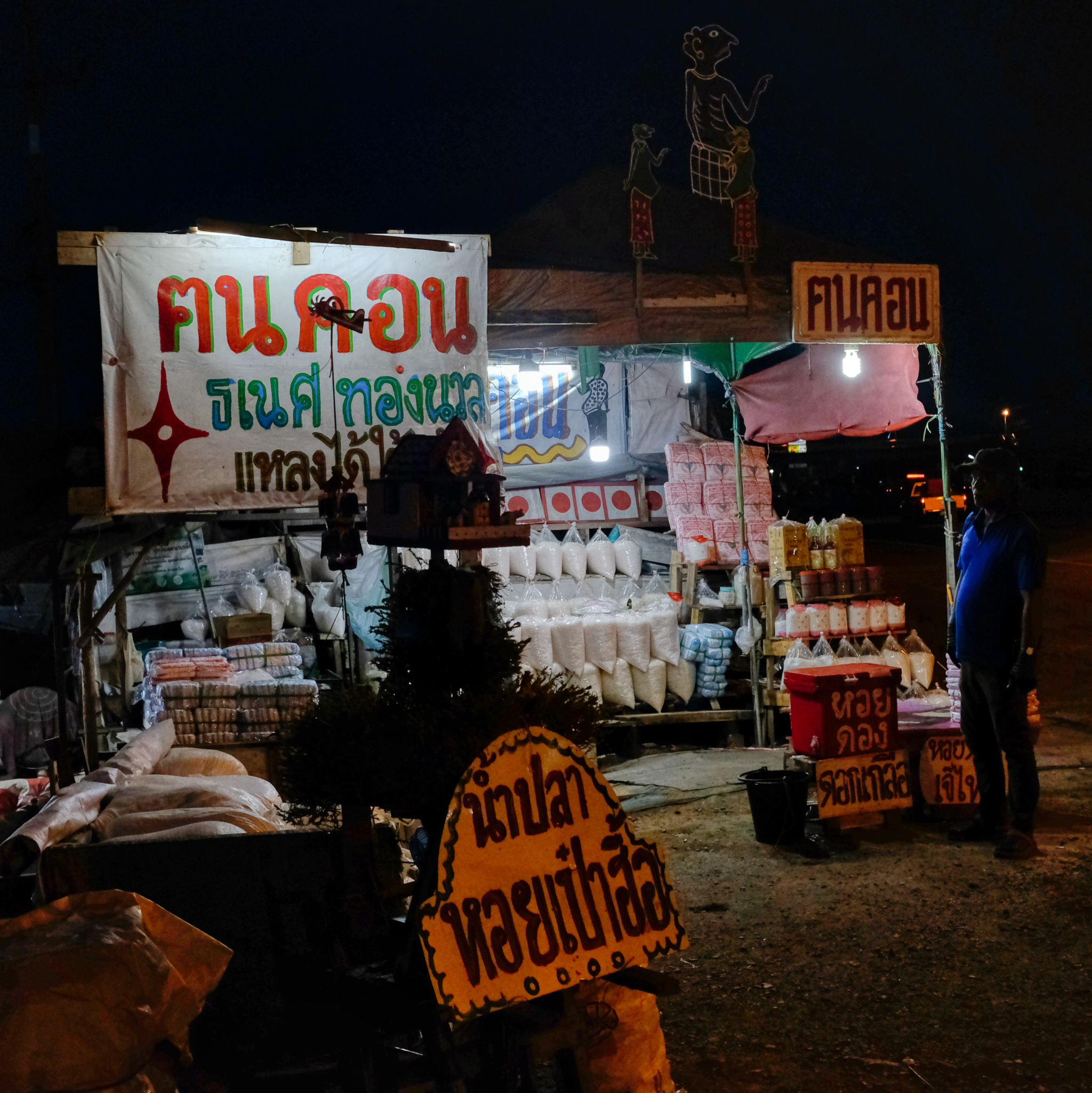 Roadside salt sales before sunset.
Roadside salt sales before sunset.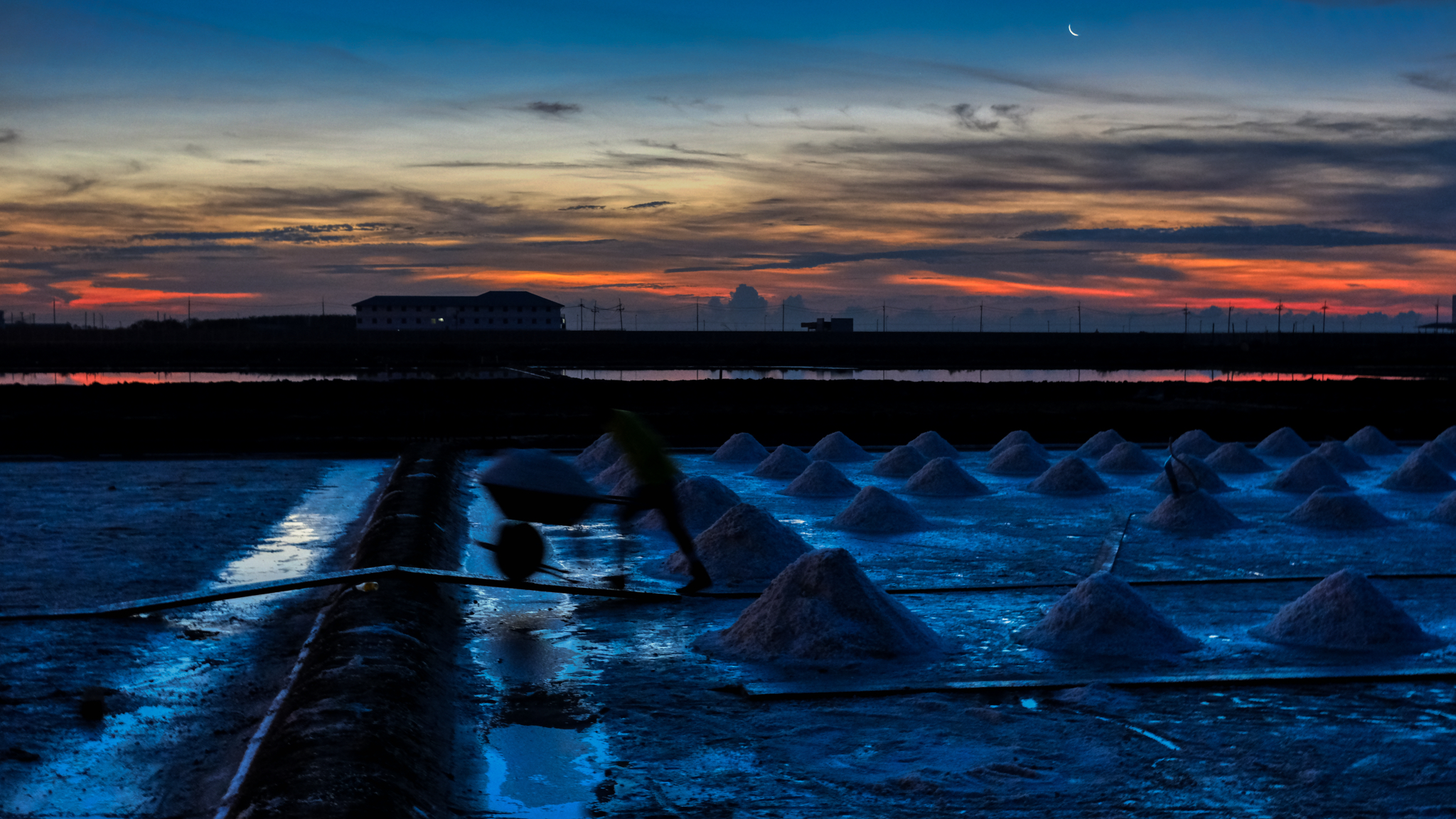 A workman is a blur in first light.
A workman is a blur in first light.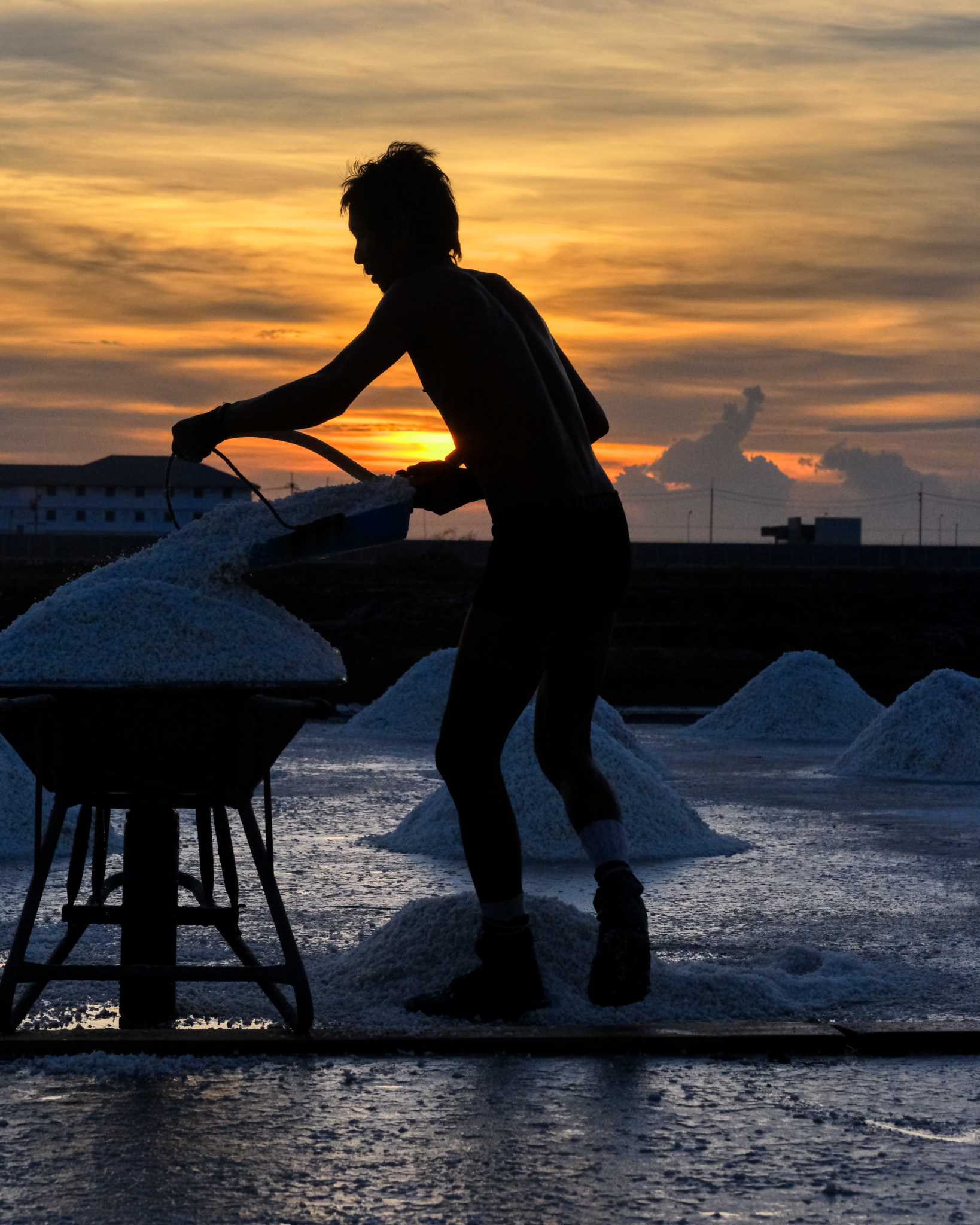 At 5:45am the ambient temperature was already 89f . . with a heat index of 105f!
At 5:45am the ambient temperature was already 89f . . with a heat index of 105f!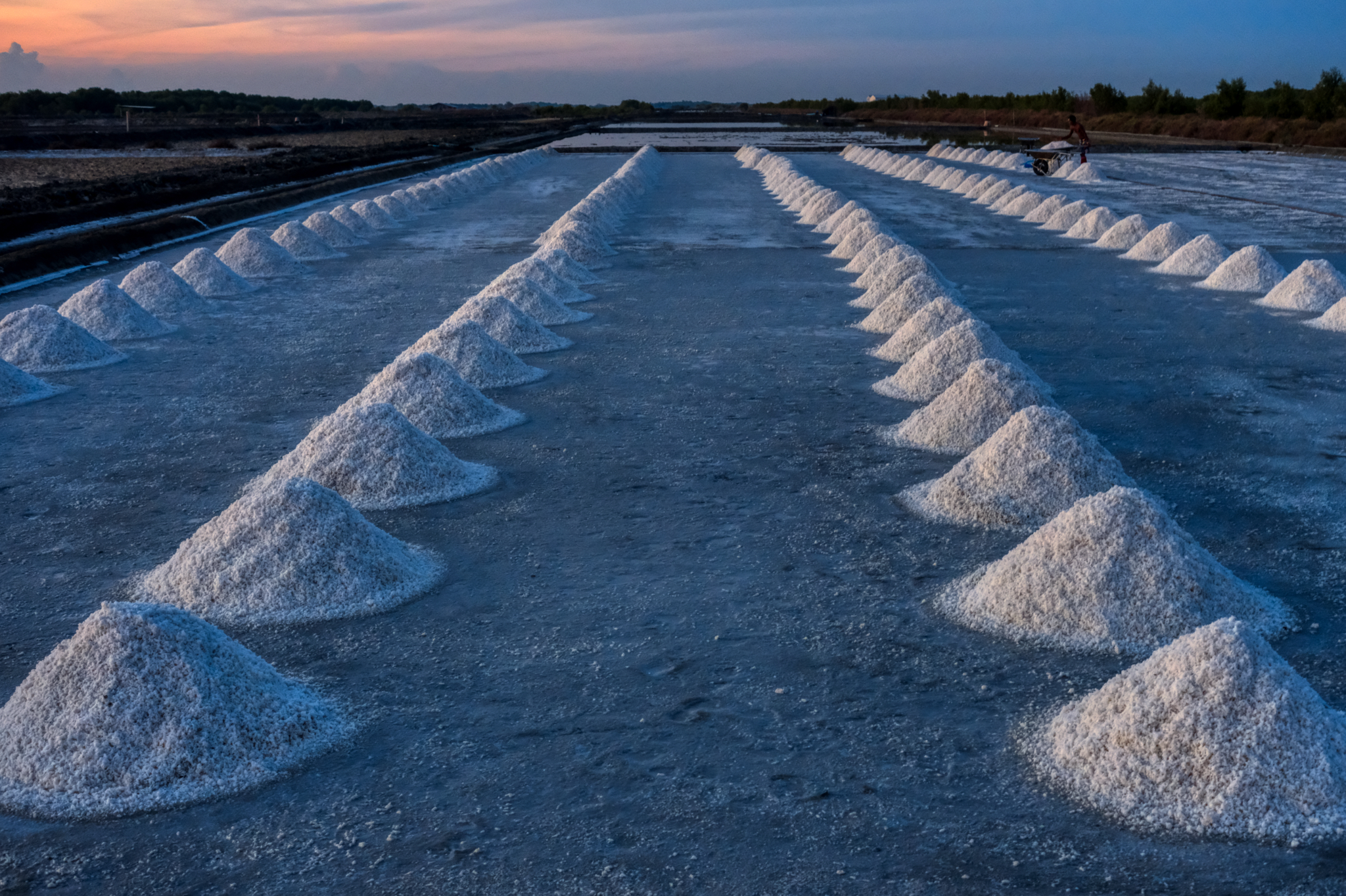 Early morning salt pan. The salt is raked up into cones by one crew, and picked up and hauled by wheelbarrow to a large pile near the highway for transportation.
Early morning salt pan. The salt is raked up into cones by one crew, and picked up and hauled by wheelbarrow to a large pile near the highway for transportation.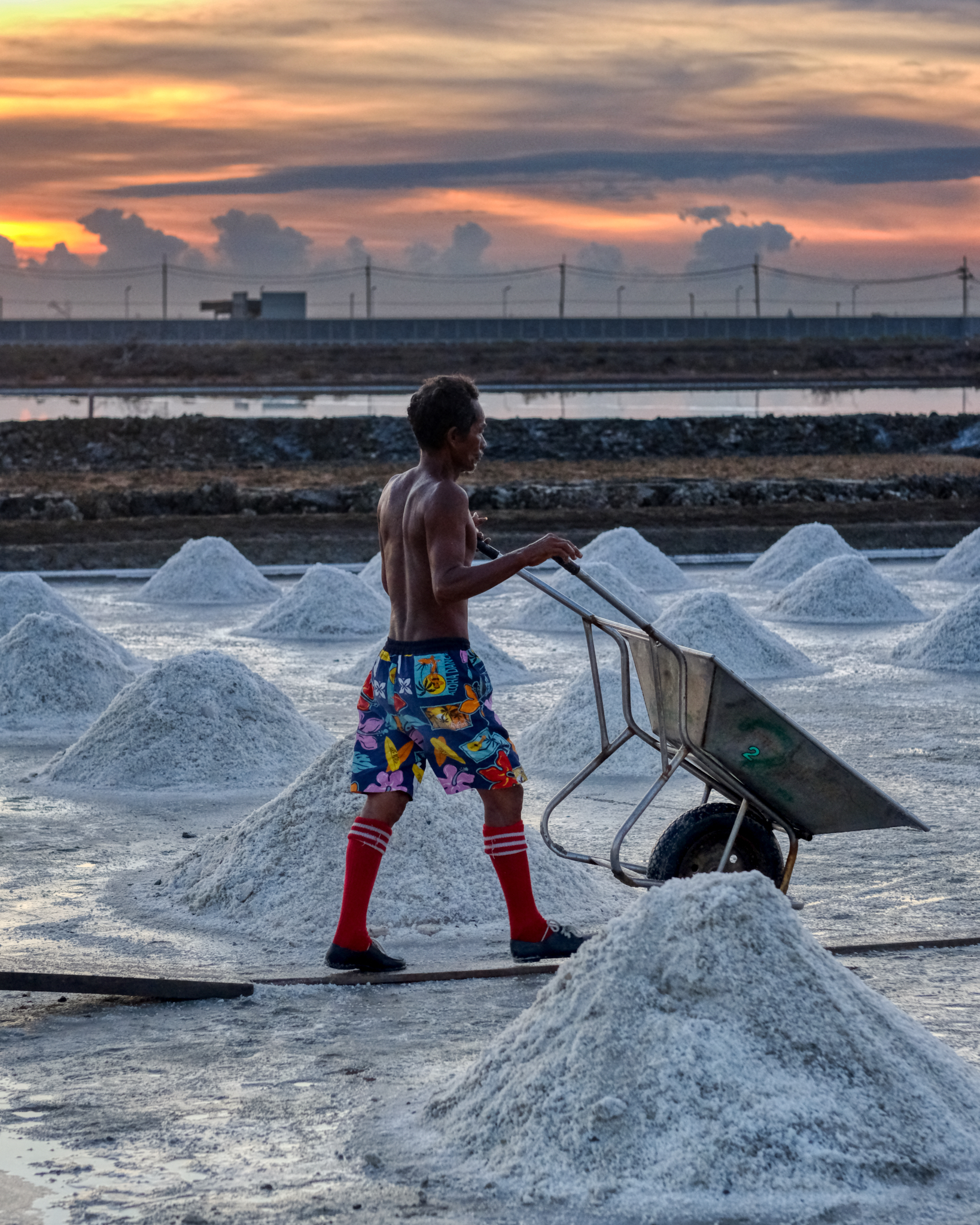 The salt workers were working hard at first light to get as much done before the blistering heat to come.
The salt workers were working hard at first light to get as much done before the blistering heat to come.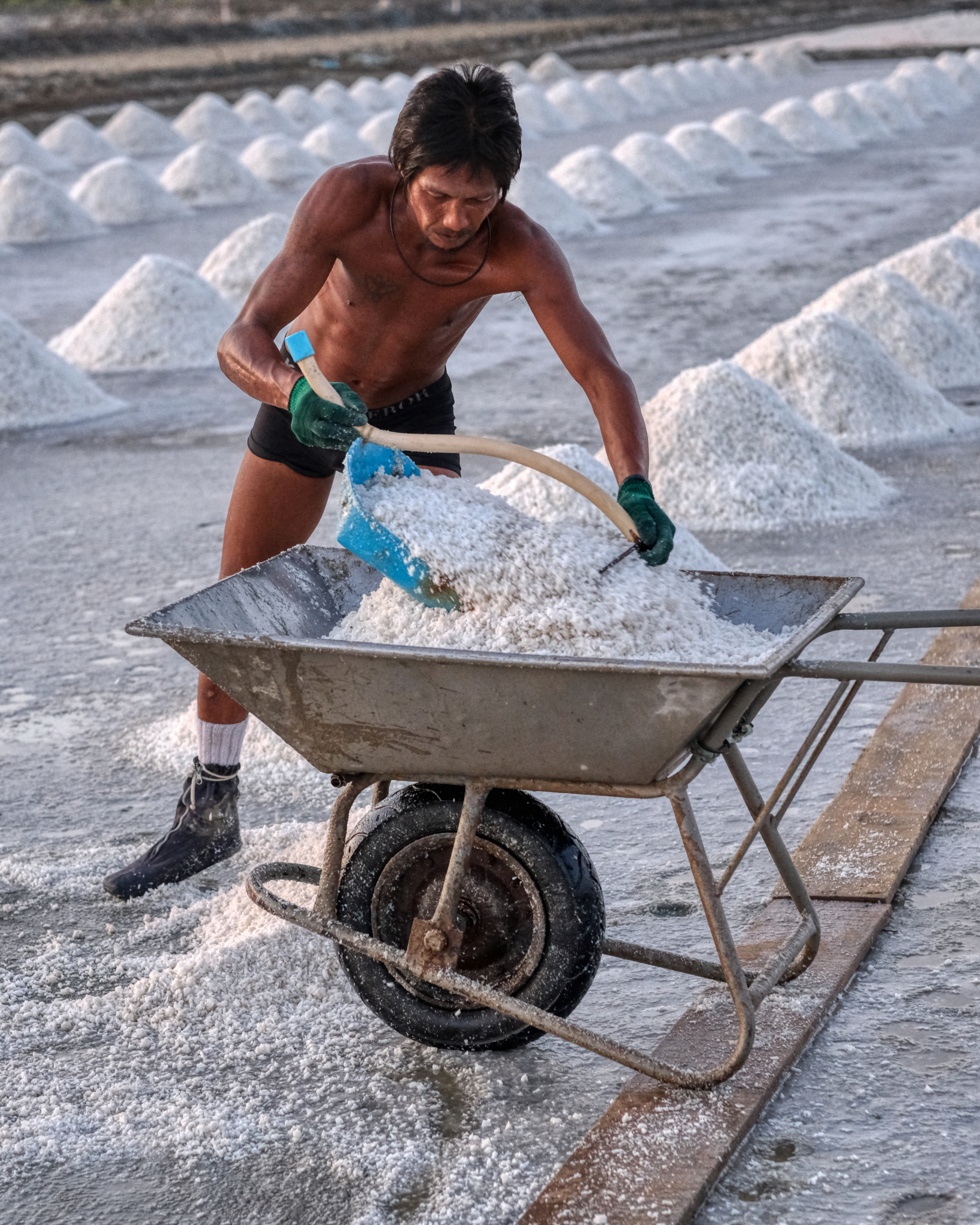 Scooping heavy, damp salt.
Scooping heavy, damp salt.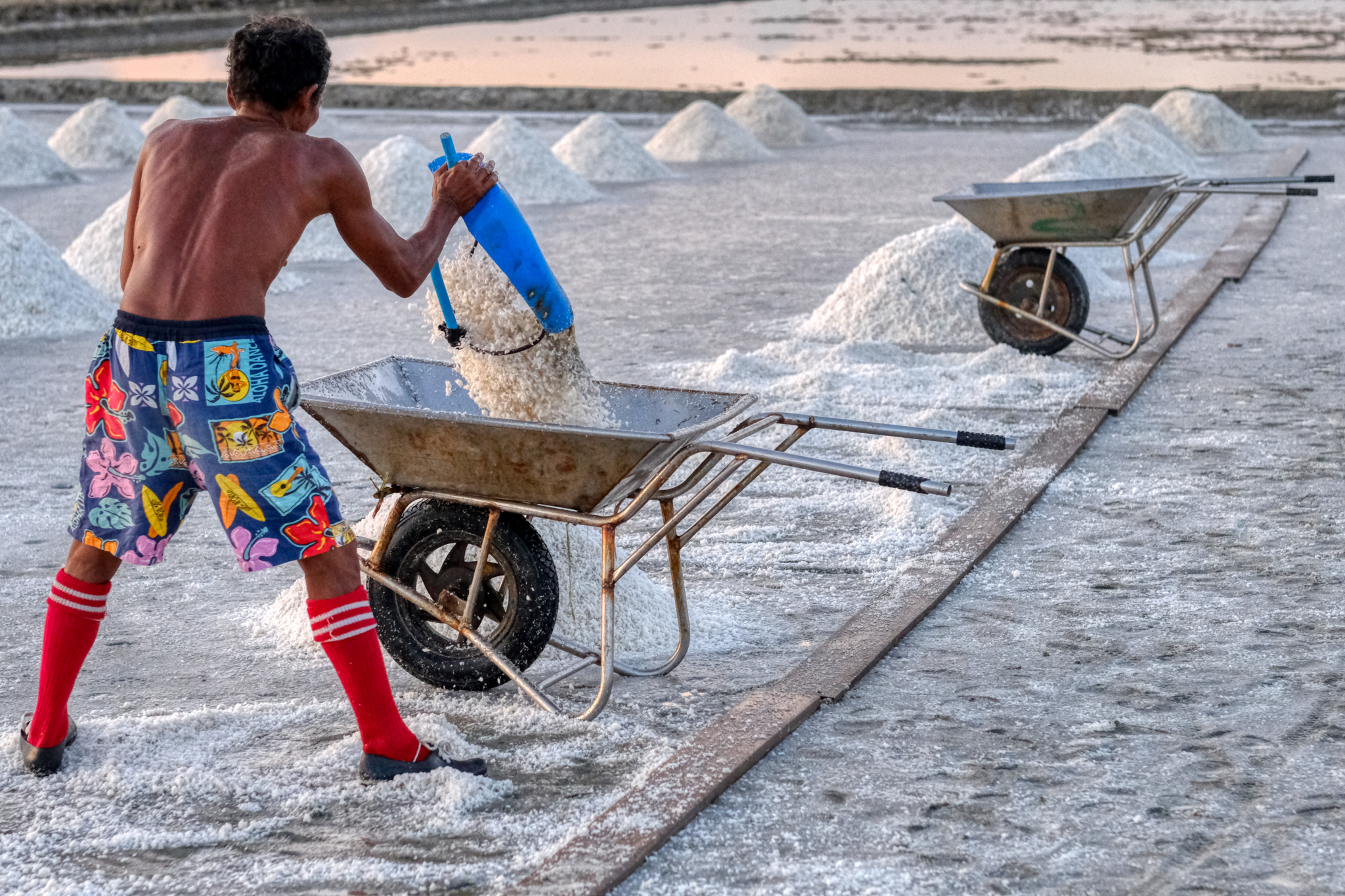 Loading the wheelbarrow for another trip to the highway.
Loading the wheelbarrow for another trip to the highway.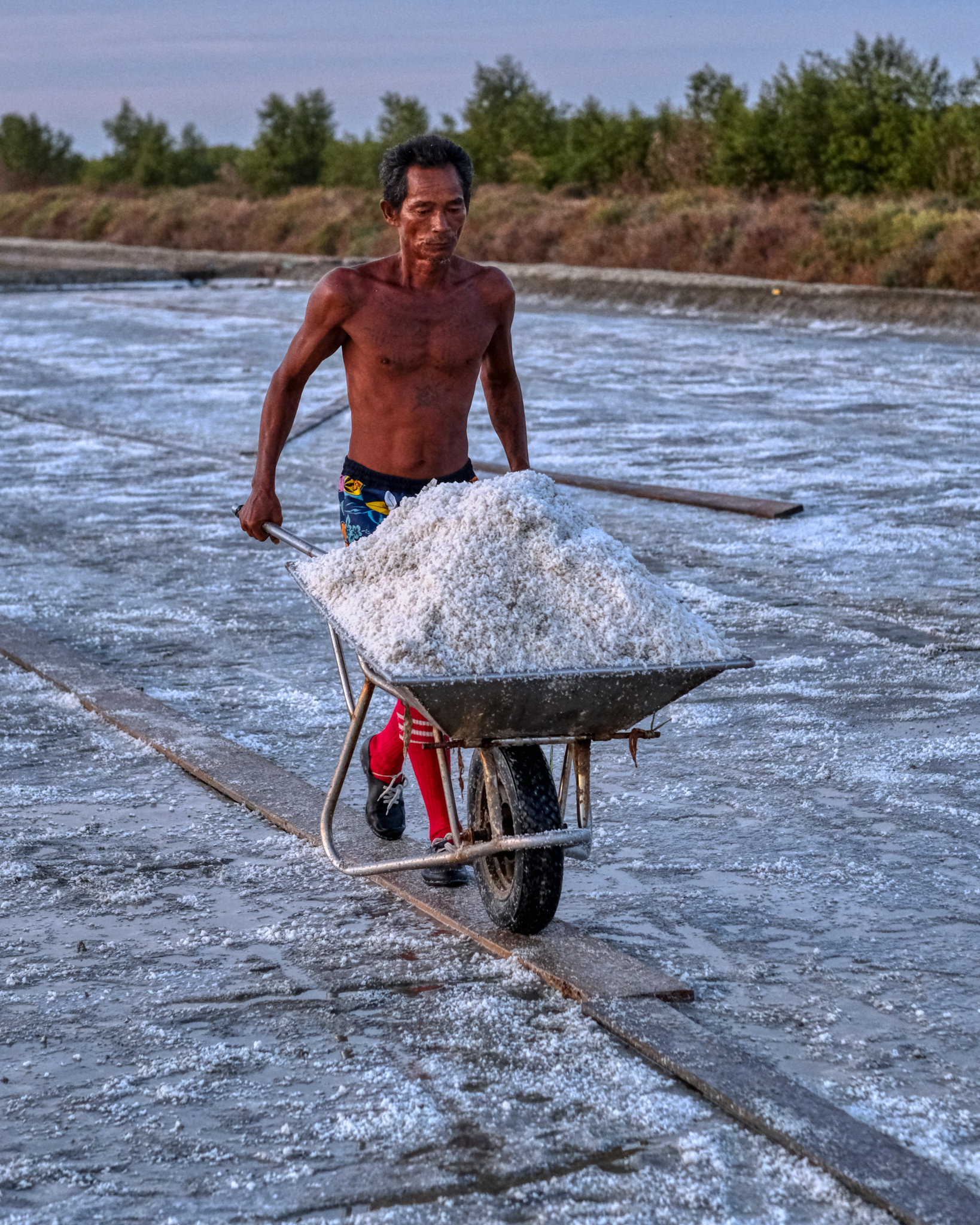 Another load full to wheel out . . .
Another load full to wheel out . . .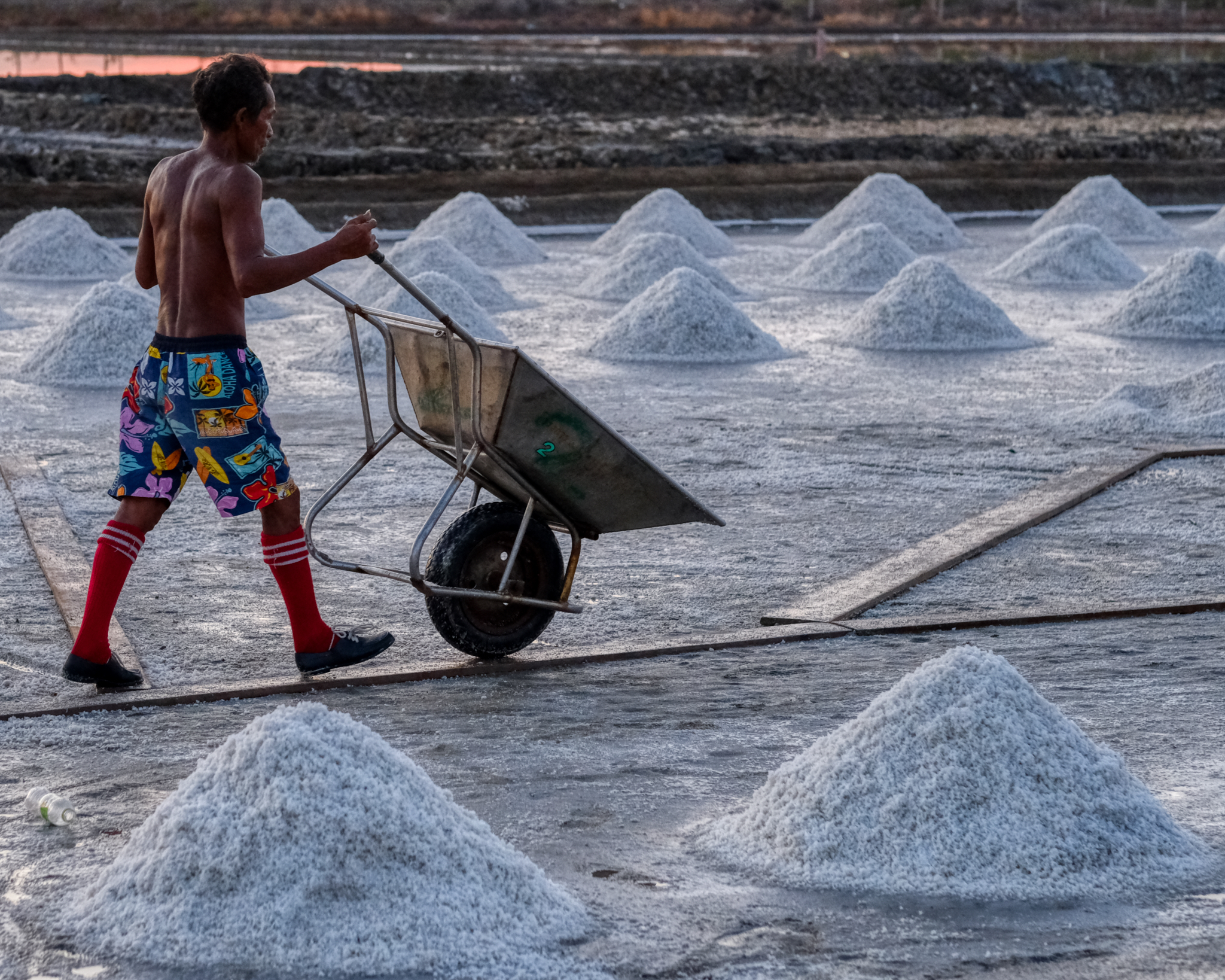 . . . and then back again in an endless loop of scoop, haul, return, scoop . . .
. . . and then back again in an endless loop of scoop, haul, return, scoop . . .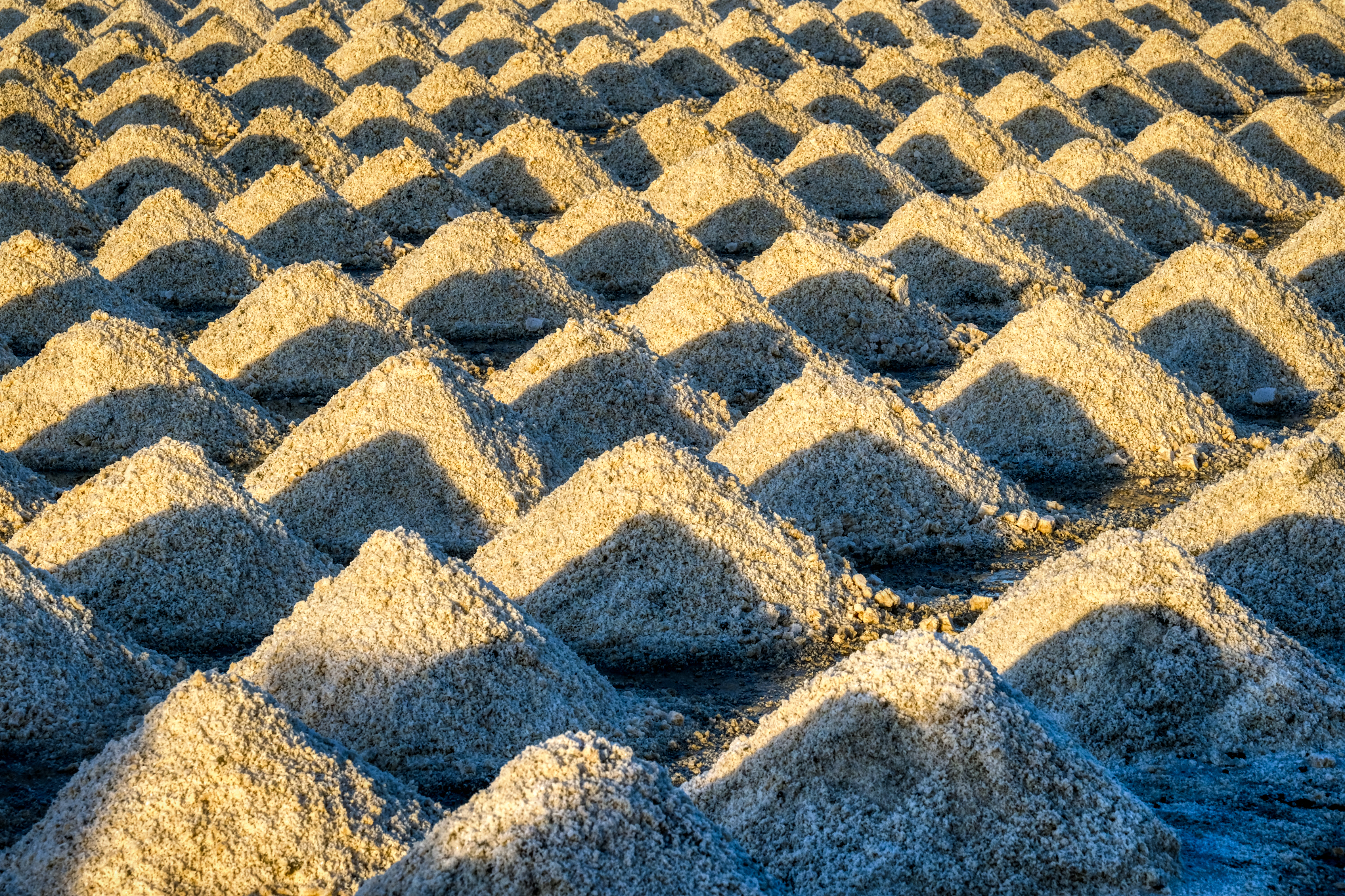 Marvelous patterns of salt cones in the morning magic hour light.
Marvelous patterns of salt cones in the morning magic hour light. A kindly looking salt worker on a hammock.
A kindly looking salt worker on a hammock.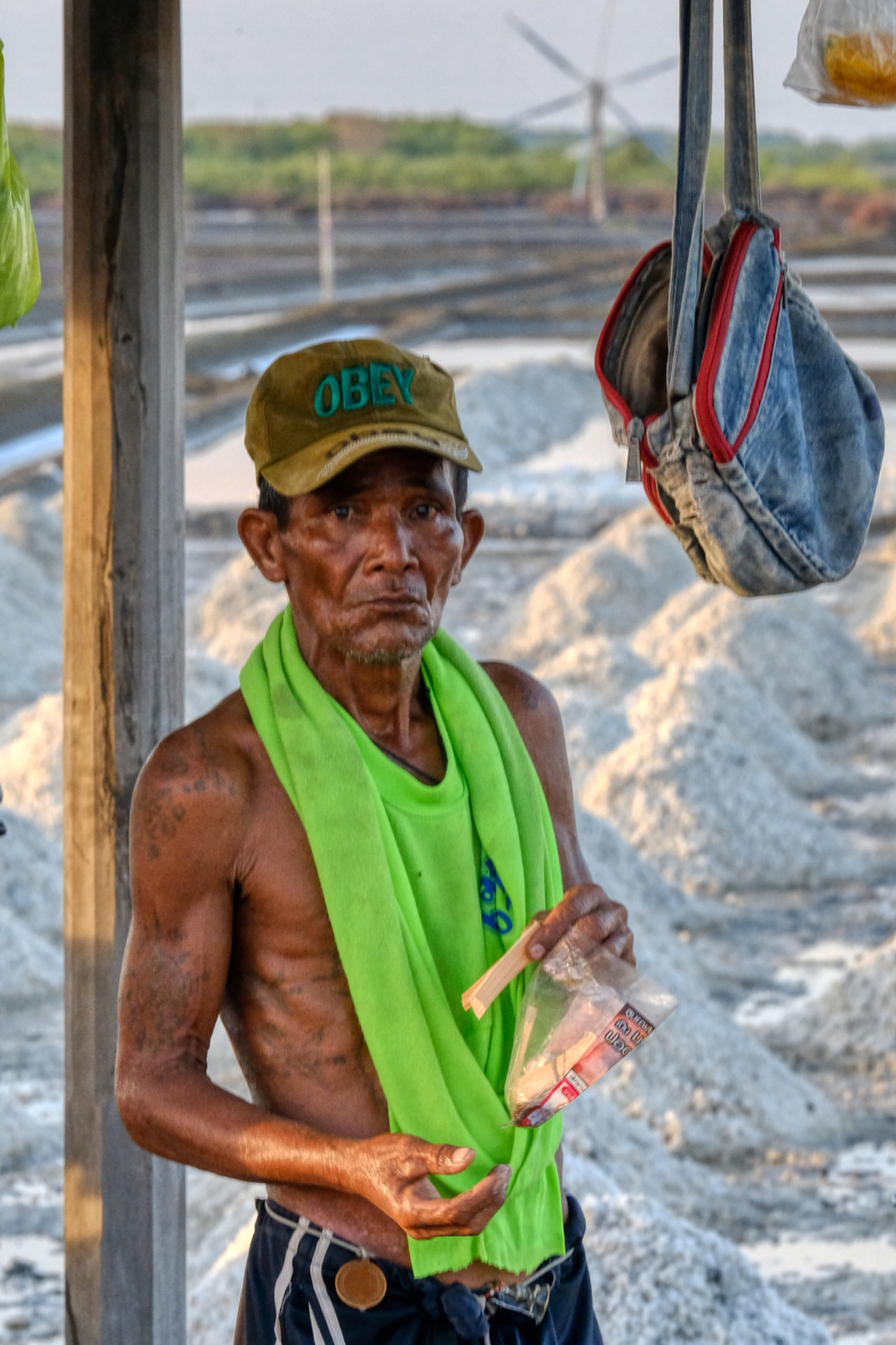 Obey. Indeed.
Obey. Indeed. Meanwhile, in another salt pan down the road . . .
Meanwhile, in another salt pan down the road . . .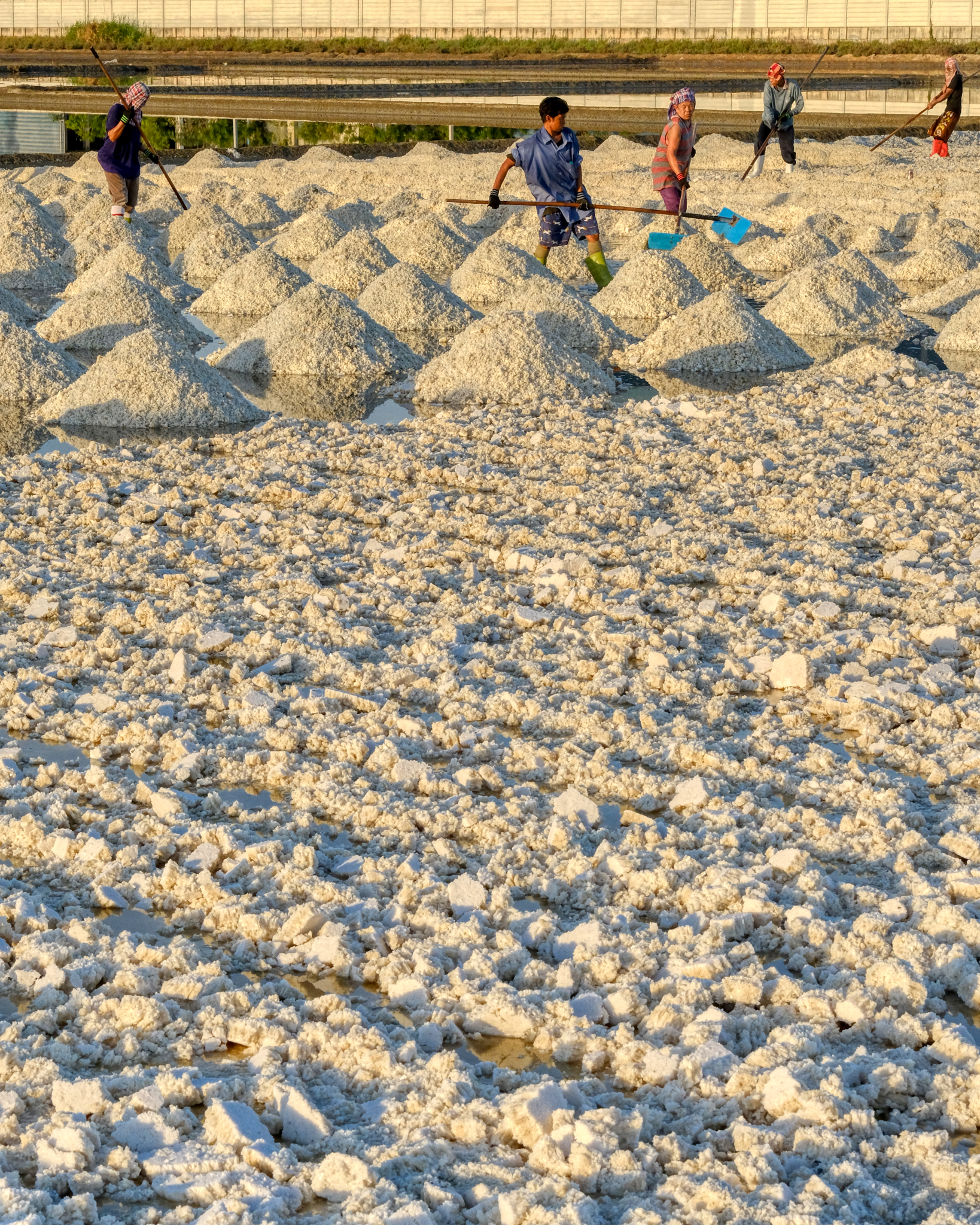 After an hour at the sunrise pans, we drove a kilometer up the road and found a big crew out in a damp pan raking the salt into the cones. Hard work in the morning sun.
After an hour at the sunrise pans, we drove a kilometer up the road and found a big crew out in a damp pan raking the salt into the cones. Hard work in the morning sun. Hard at work while standing in supersaturated salt water.
Hard at work while standing in supersaturated salt water.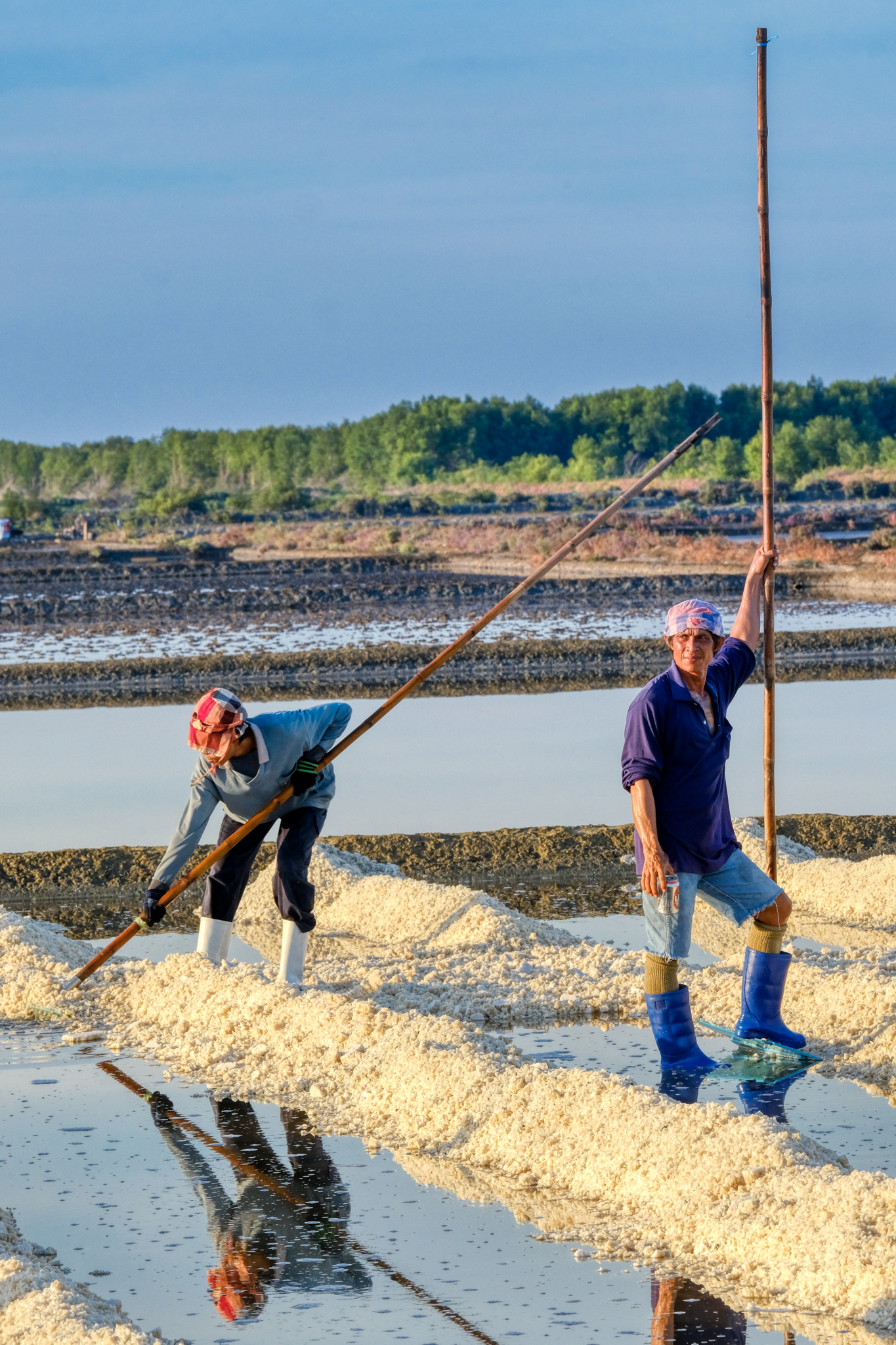 Such a photogenic scene . . . especially when the salt workers pose for you!!!
Such a photogenic scene . . . especially when the salt workers pose for you!!!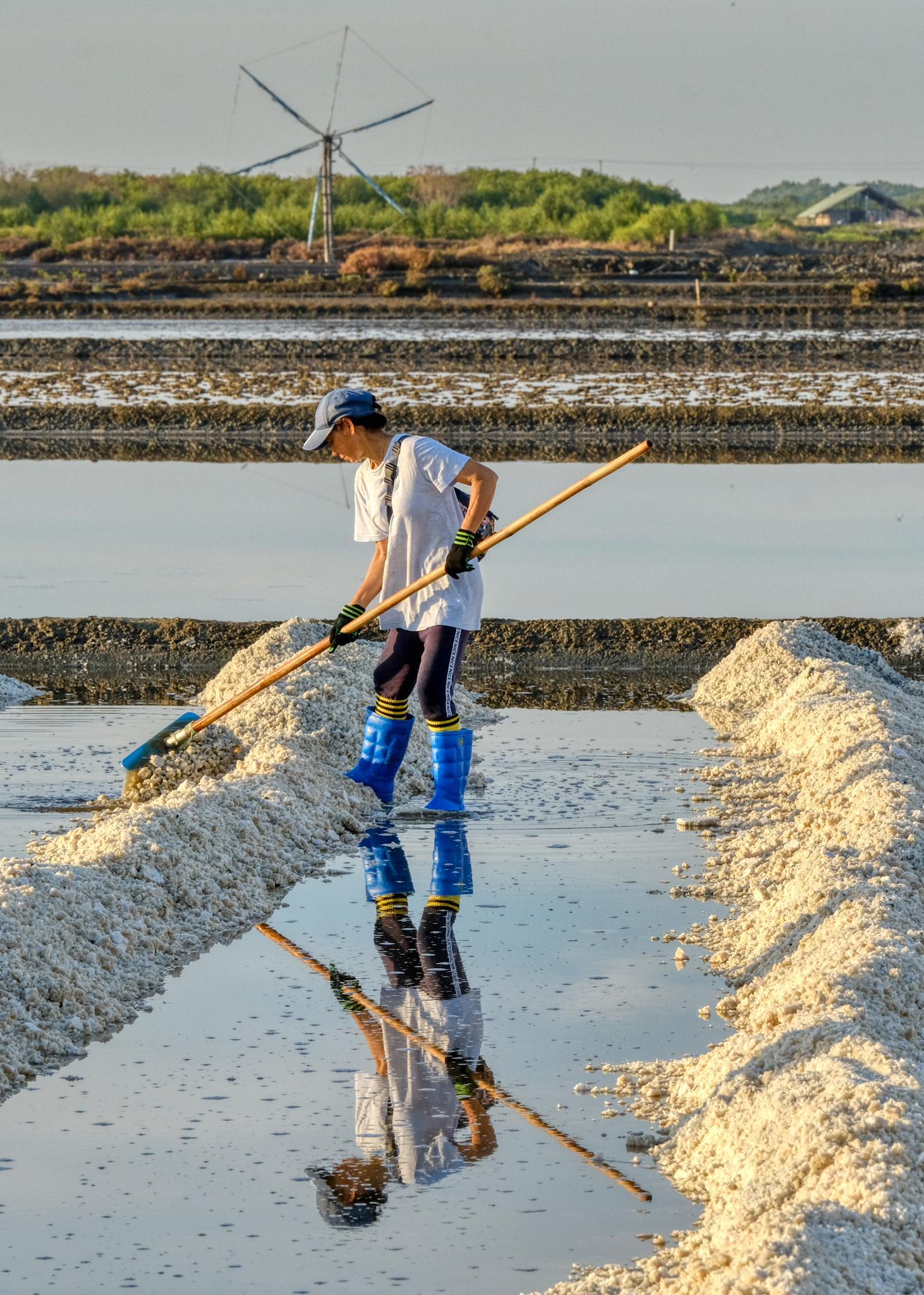 Windmills, salt, humanity, reflections . . .
Windmills, salt, humanity, reflections . . . Having a chat while working . . .
Having a chat while working . . . 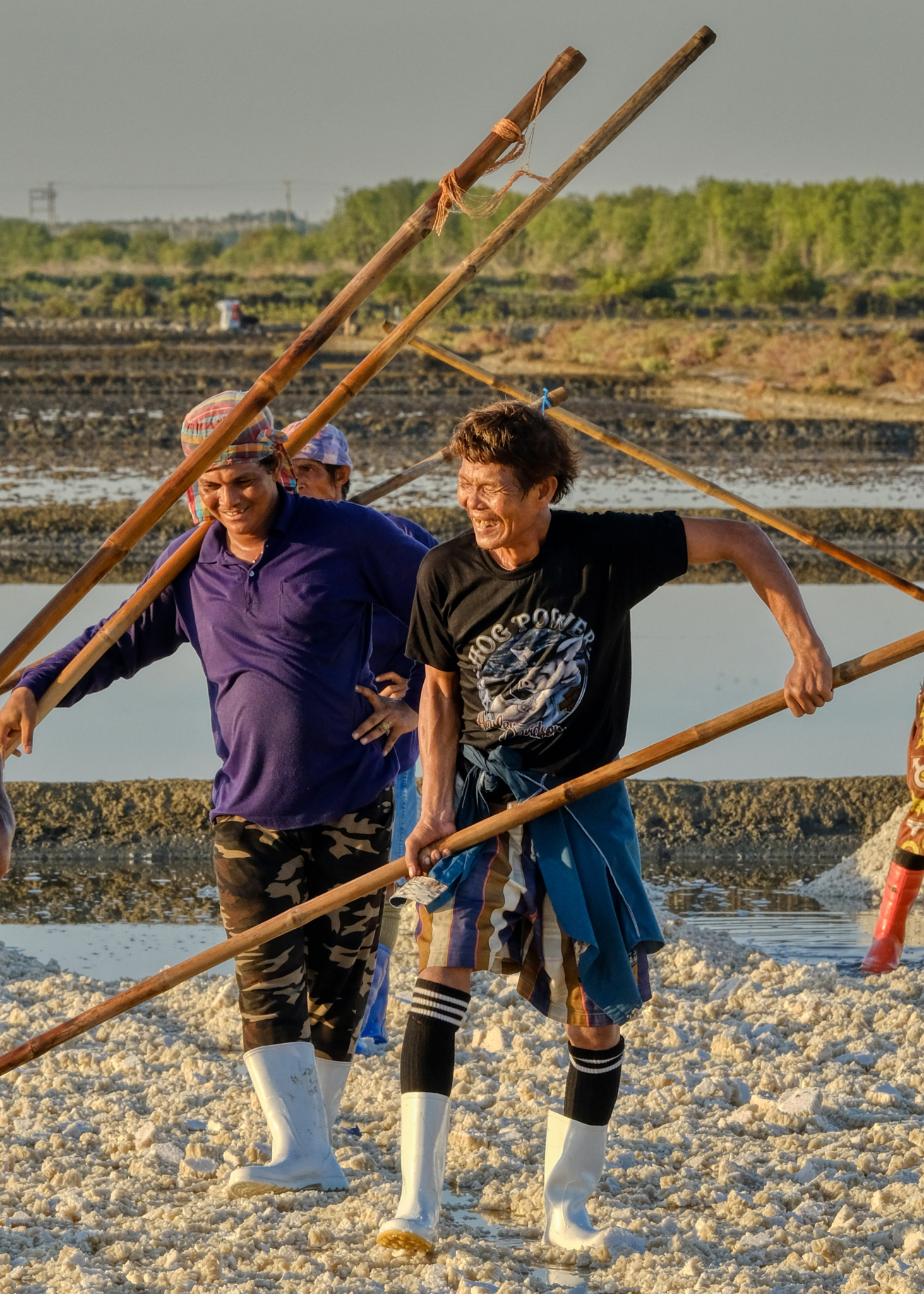 The salt workers seemed to know each other well . . . it's more enjoyable to work while sharing a joke with your friends.
The salt workers seemed to know each other well . . . it's more enjoyable to work while sharing a joke with your friends.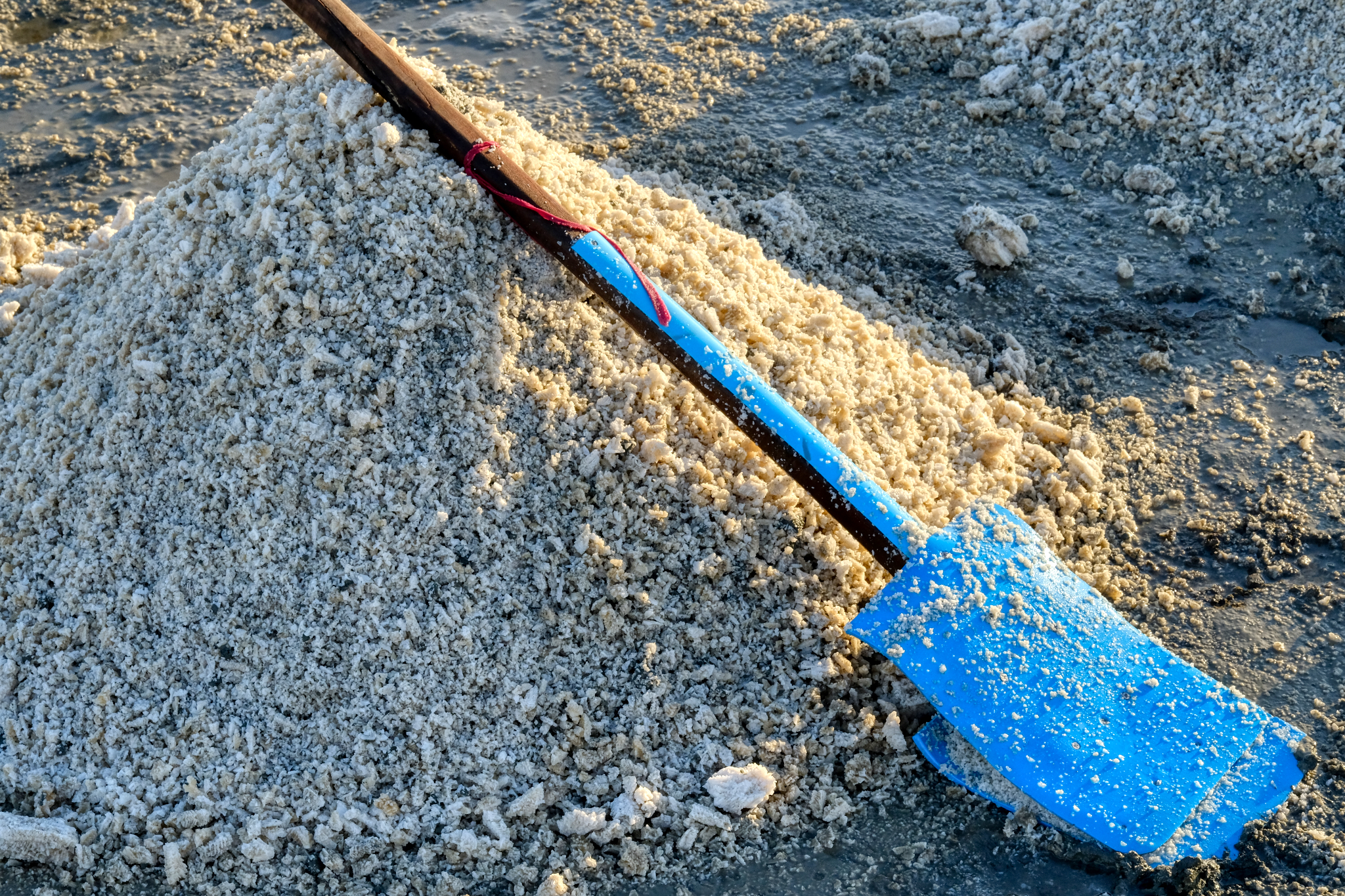 Home made crude scrapers for piling the salt into cones.
Home made crude scrapers for piling the salt into cones.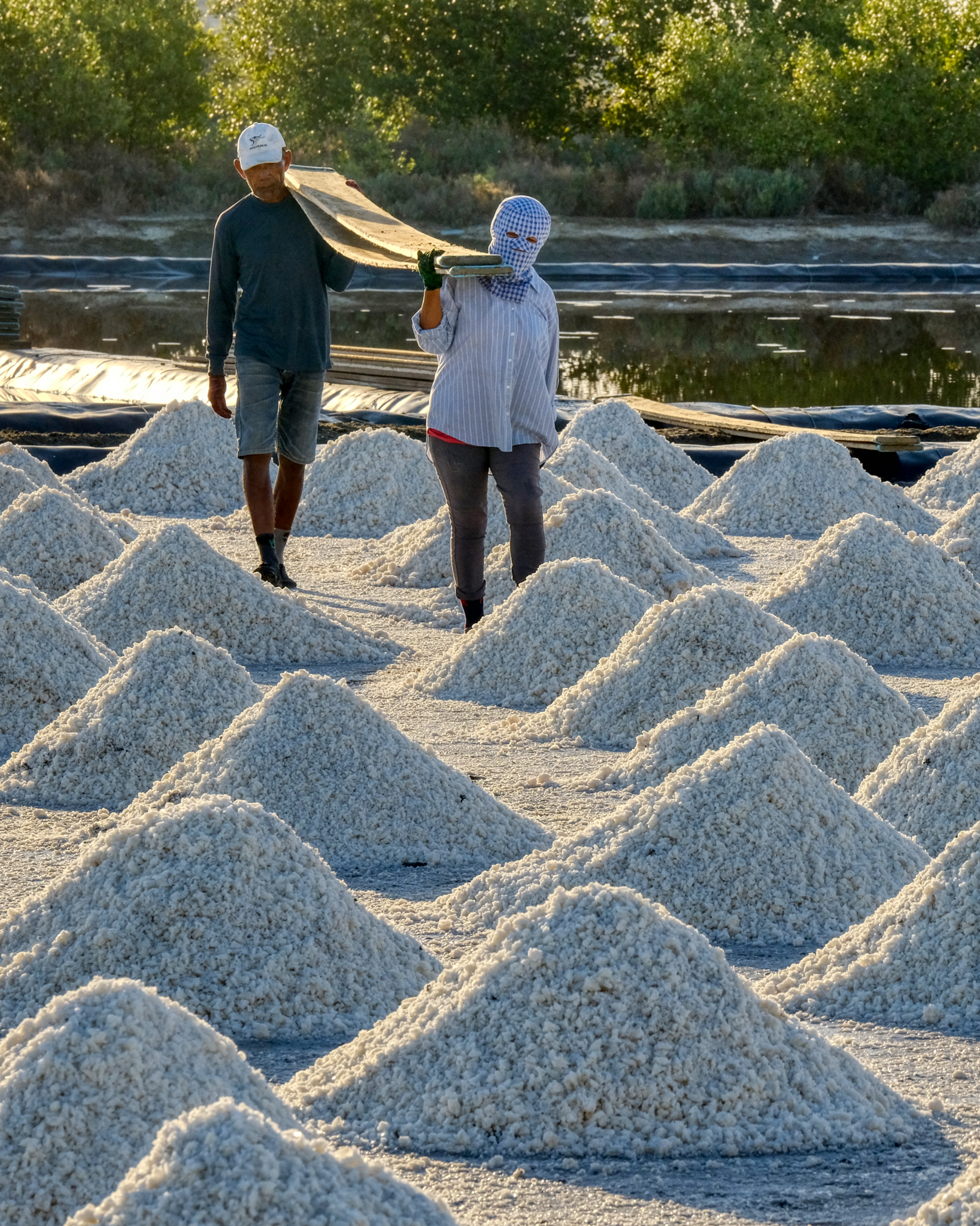 Moving and placing heavy planks for the wheelbarrows that will come to remove the salt from the pans.
Moving and placing heavy planks for the wheelbarrows that will come to remove the salt from the pans.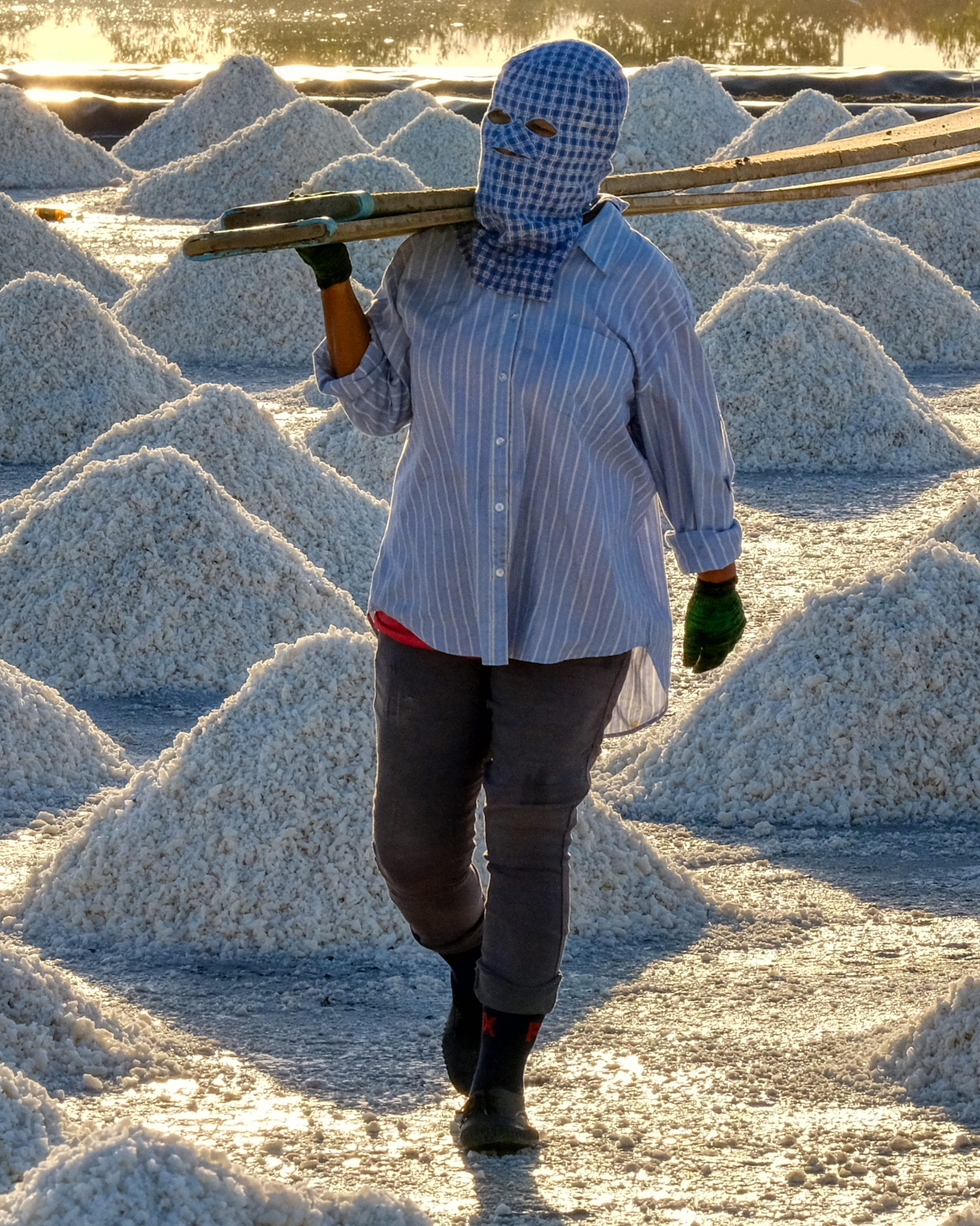 Protection from the sun . . . .
Protection from the sun . . . .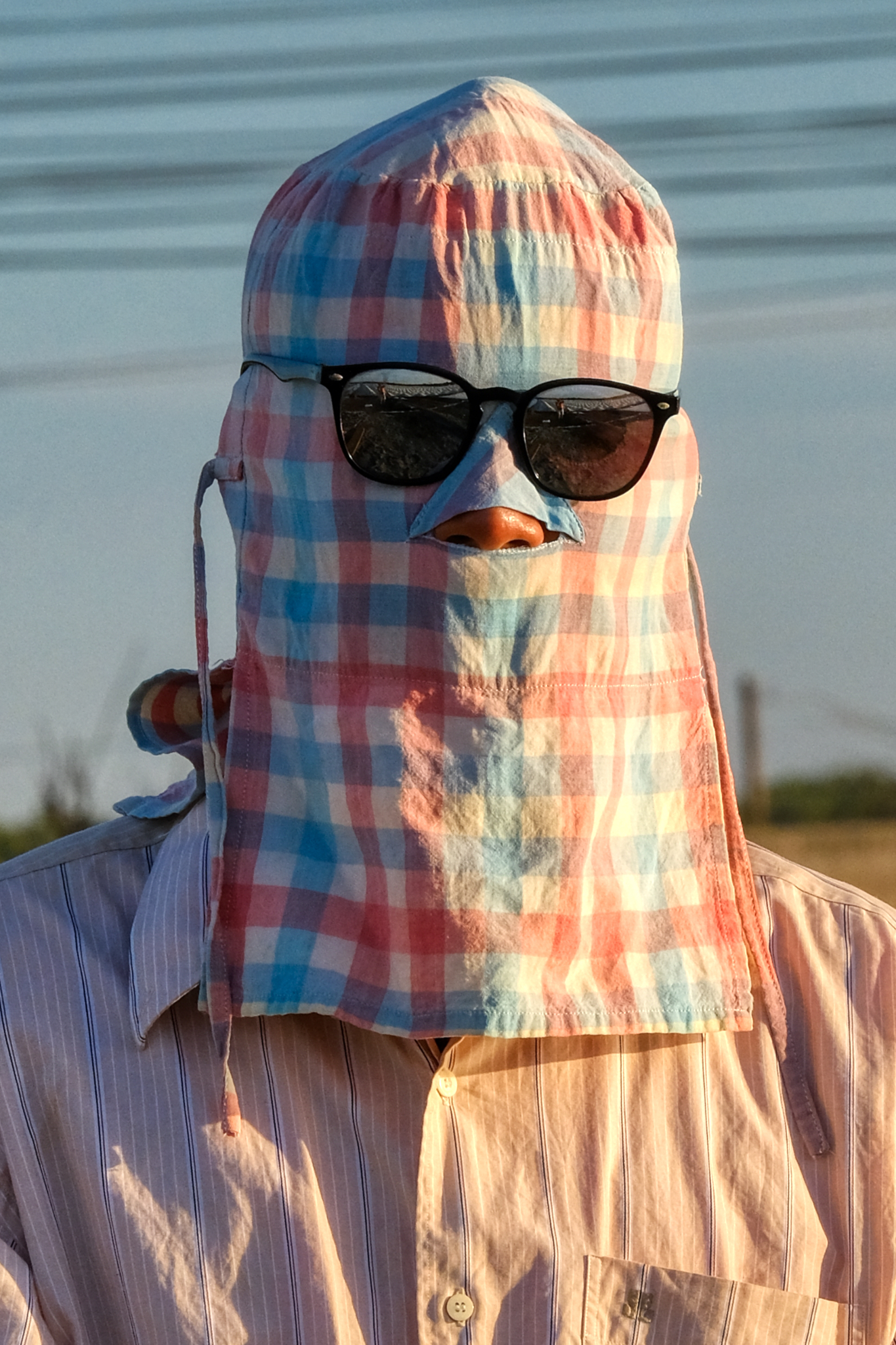 Extreme sun protection . . . it must be very hot under that hood in this oppressive heat and humidity.
Extreme sun protection . . . it must be very hot under that hood in this oppressive heat and humidity.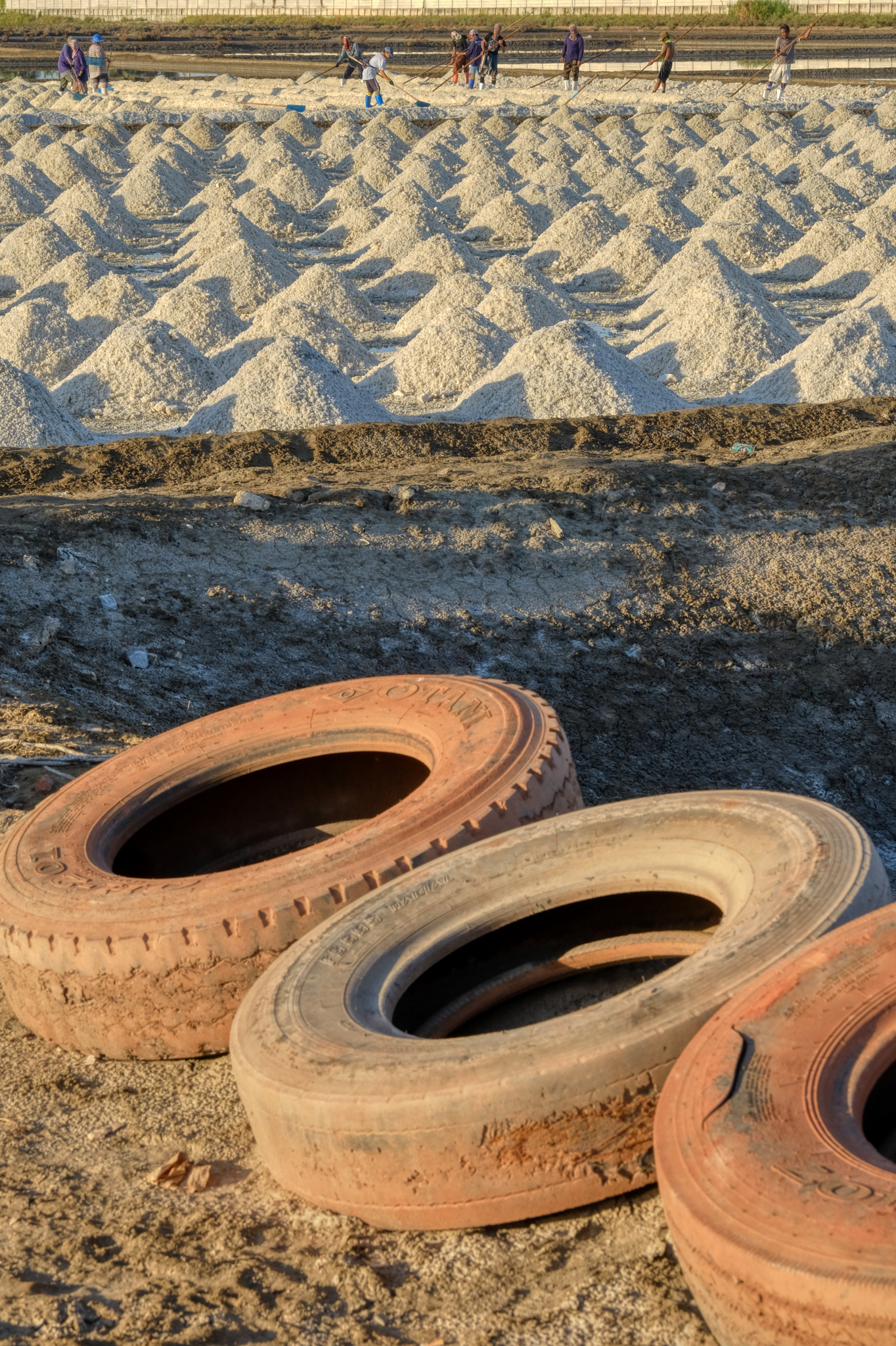 The is much to see in the area, so we moved on . . .
The is much to see in the area, so we moved on . . .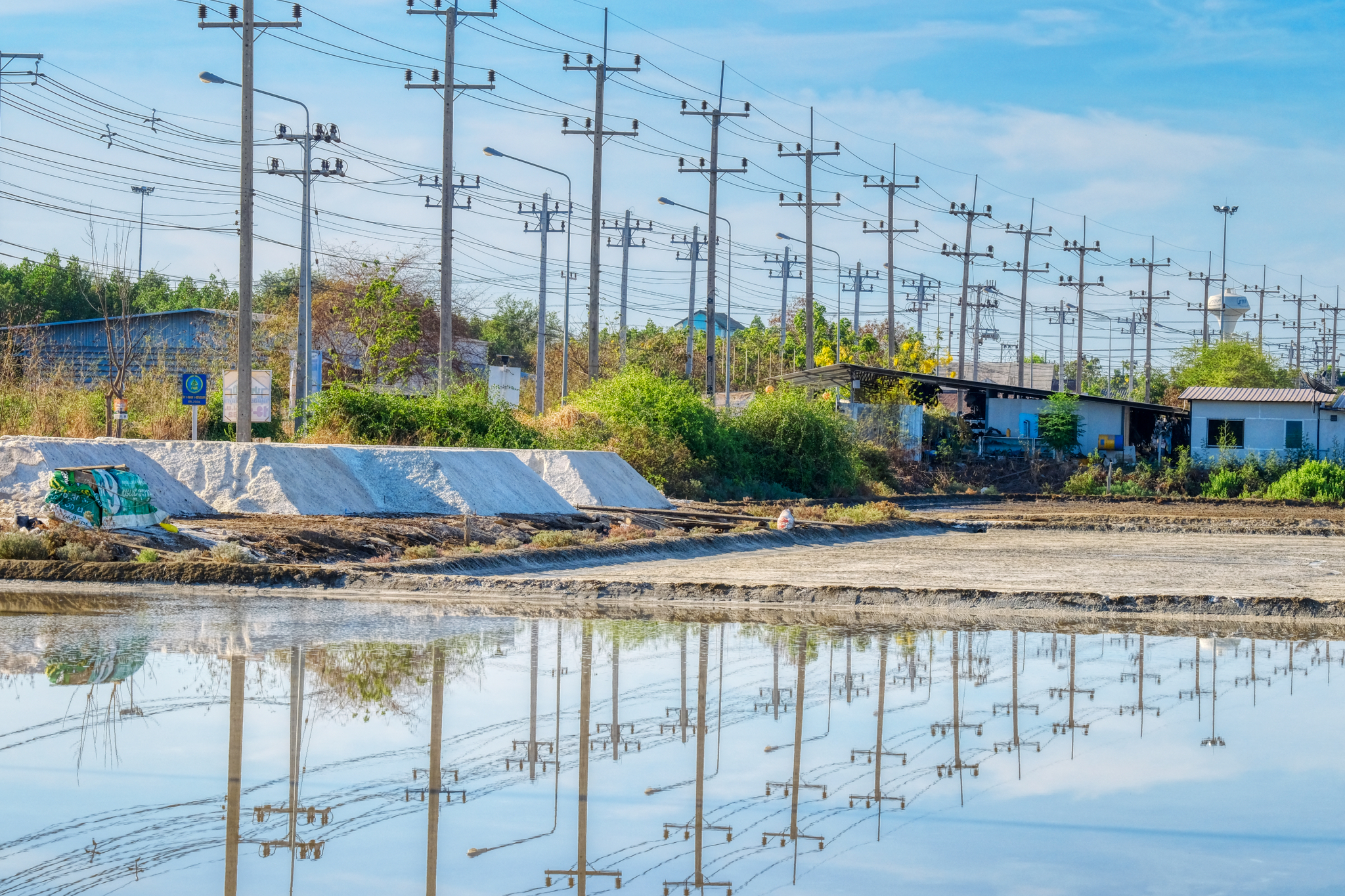 Rural roads are few and far between - valuable land is not used up for roads. As such, the roads that do exist serve for arterials for power, phone, and water. This is Thai local highway 2001.
Rural roads are few and far between - valuable land is not used up for roads. As such, the roads that do exist serve for arterials for power, phone, and water. This is Thai local highway 2001.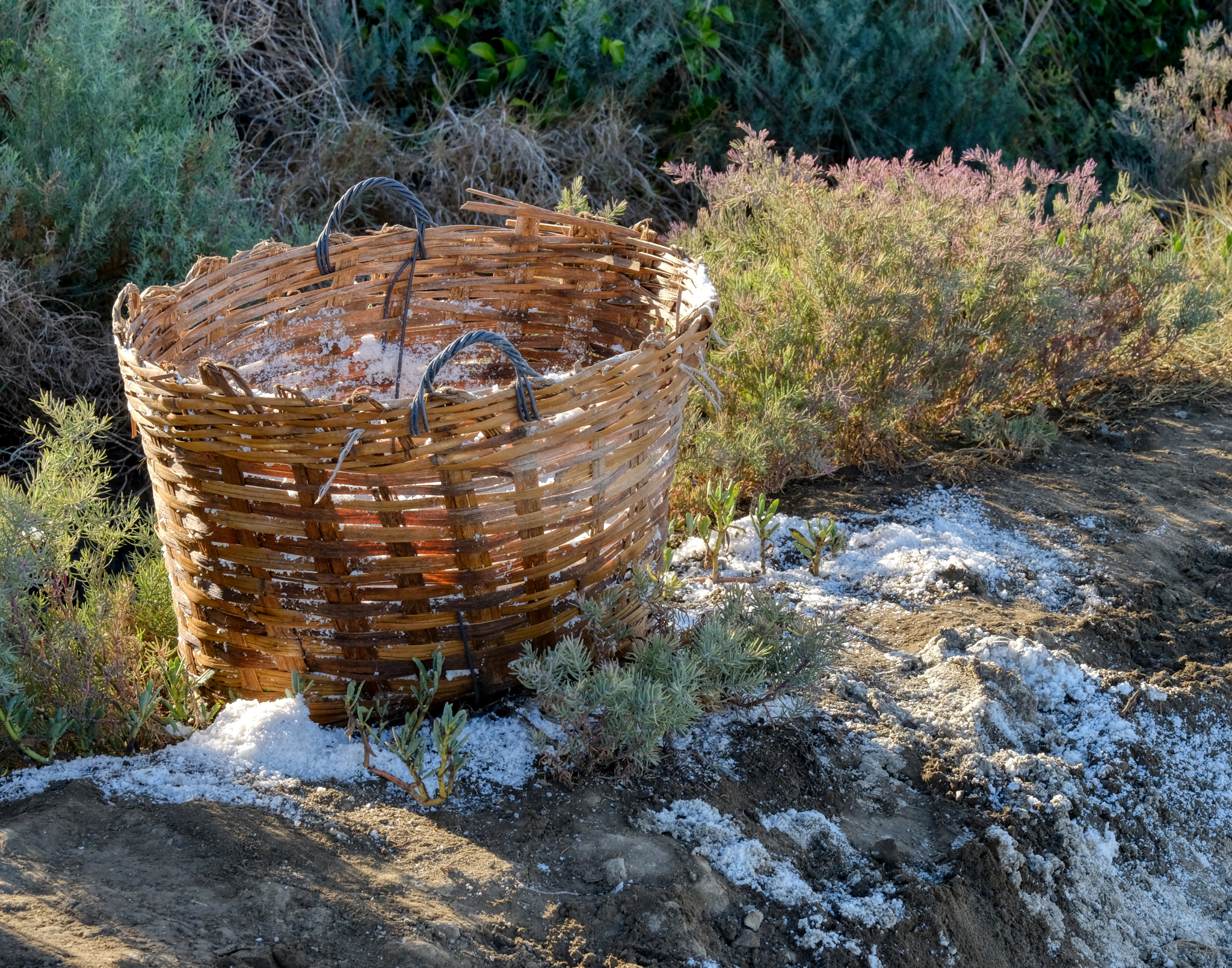 In the next salt pan, baskets were used to collect a special salt from the surface.
In the next salt pan, baskets were used to collect a special salt from the surface.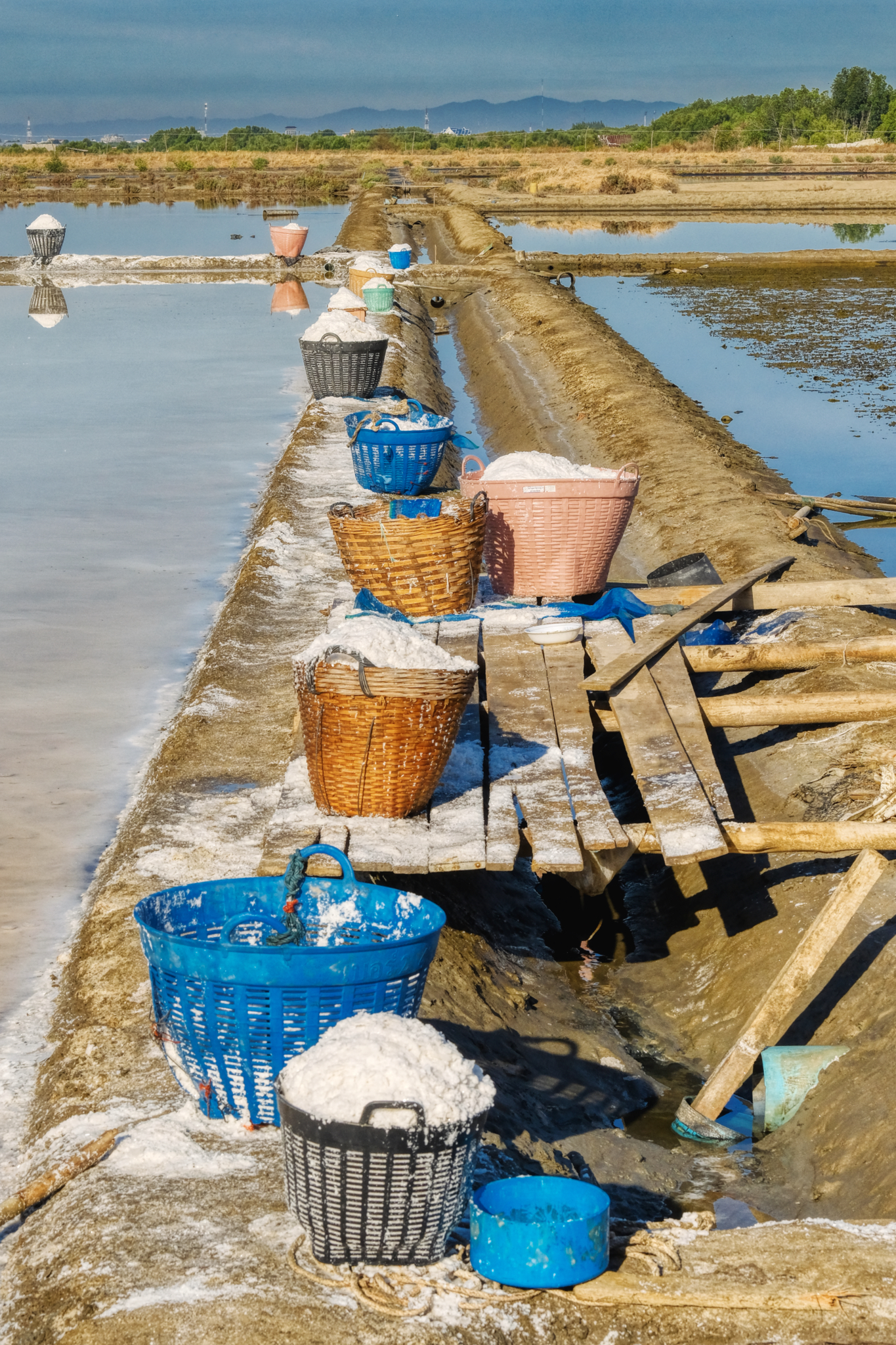 Ongoing salt harvesting.
Ongoing salt harvesting.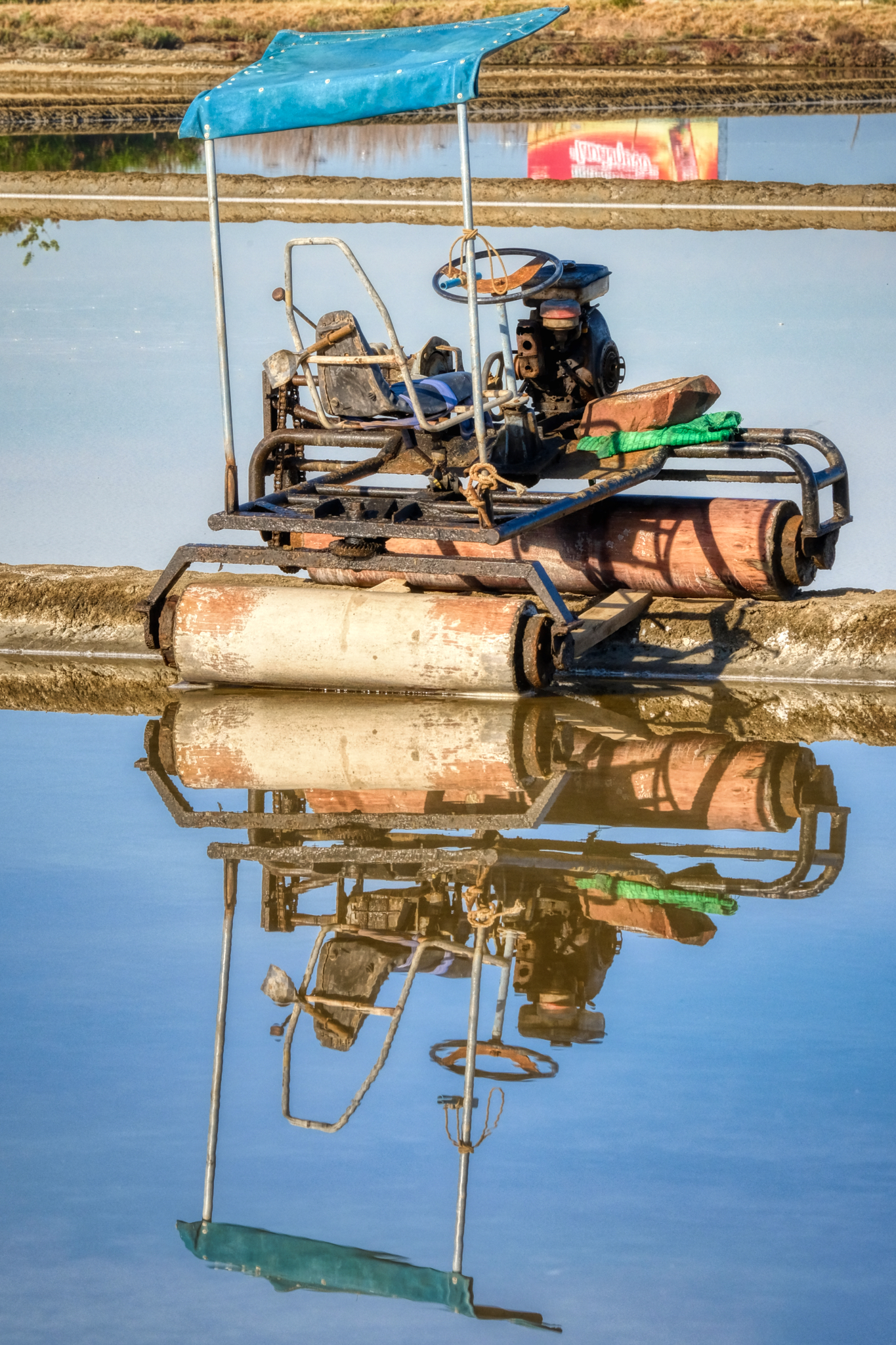 I love these amazing contraptions . . . used to flatten the pans after the salt has been removed.
I love these amazing contraptions . . . used to flatten the pans after the salt has been removed.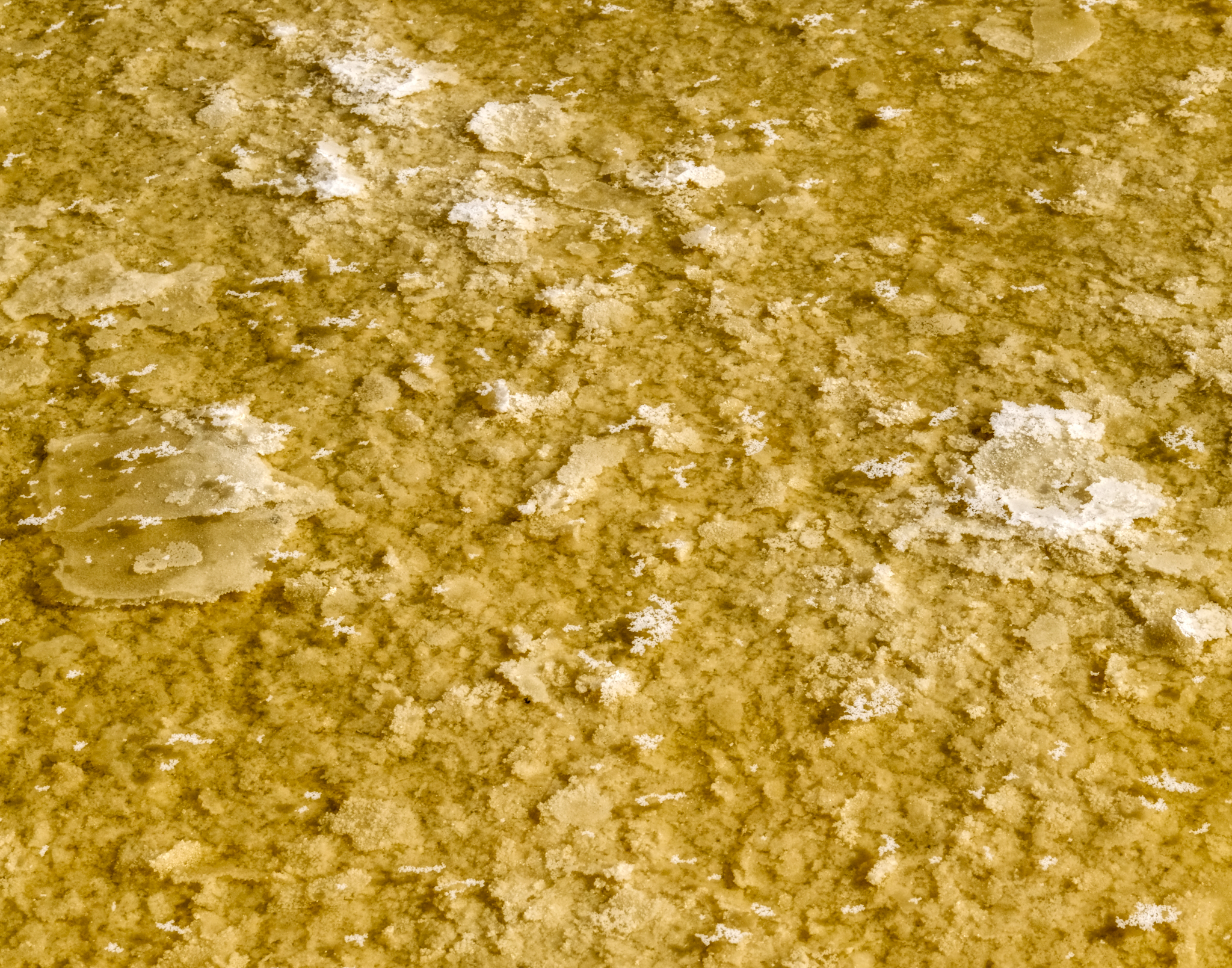 This is a rare (and valuable) form of flake salt favored by chefs . . . it floats on top of the supersaturated pans and is harvested in baskets (above).
This is a rare (and valuable) form of flake salt favored by chefs . . . it floats on top of the supersaturated pans and is harvested in baskets (above).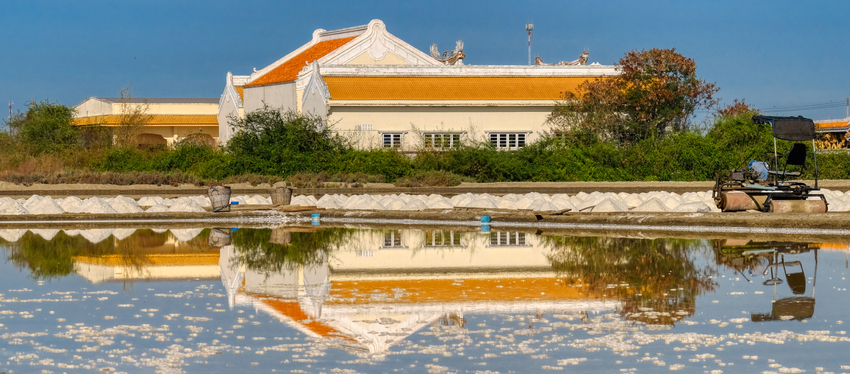 A beautiful Chinese-style Buddhist temple reflected in the salt pans.
A beautiful Chinese-style Buddhist temple reflected in the salt pans.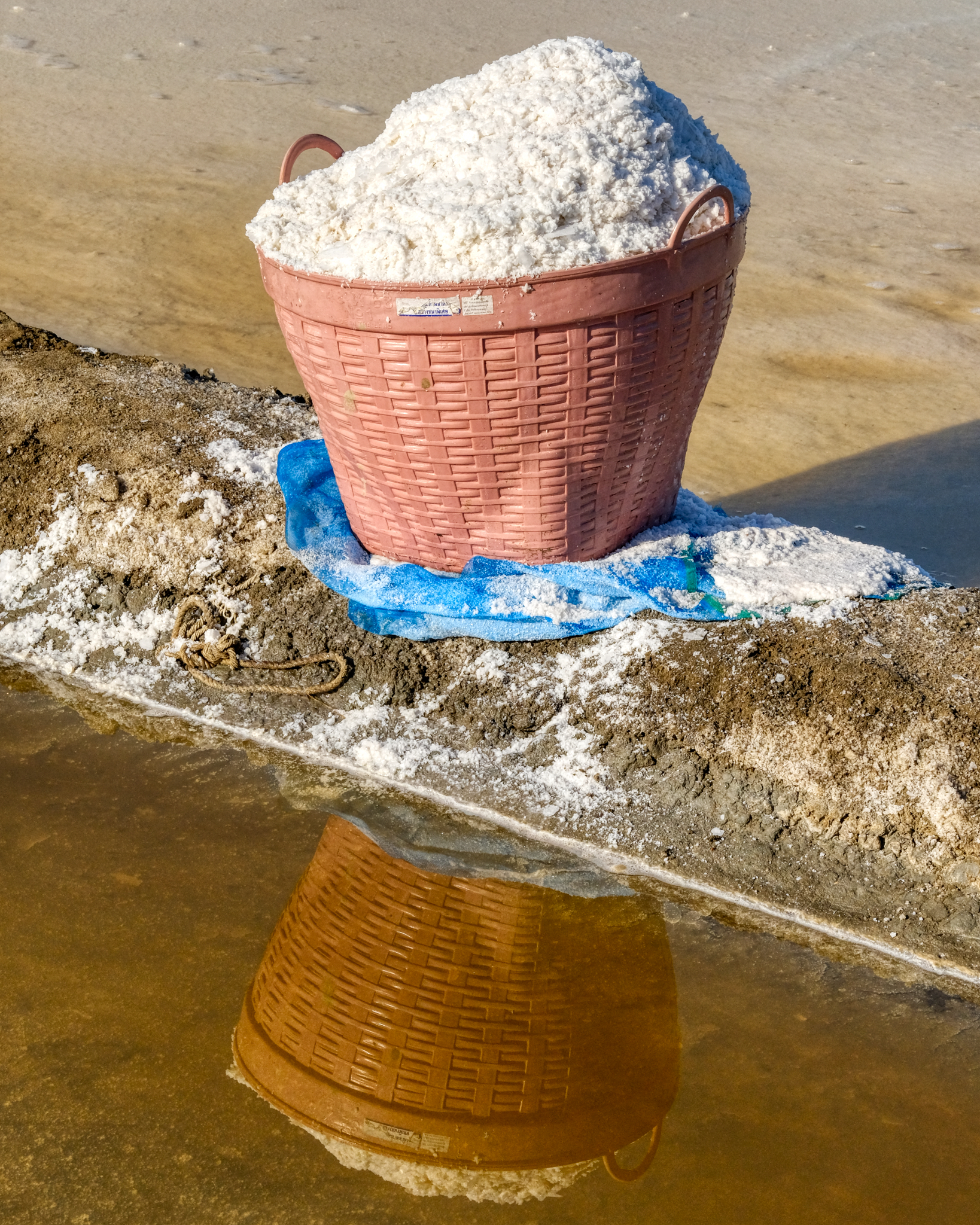 Light and flakey salt -- very valuable and sought after.
Light and flakey salt -- very valuable and sought after. Directly across from the flake salt gathering was the Buddhist Wat I came to see after 5 years . . . . Wat Lat Yai with the Buddha colossus.
Directly across from the flake salt gathering was the Buddhist Wat I came to see after 5 years . . . . Wat Lat Yai with the Buddha colossus. 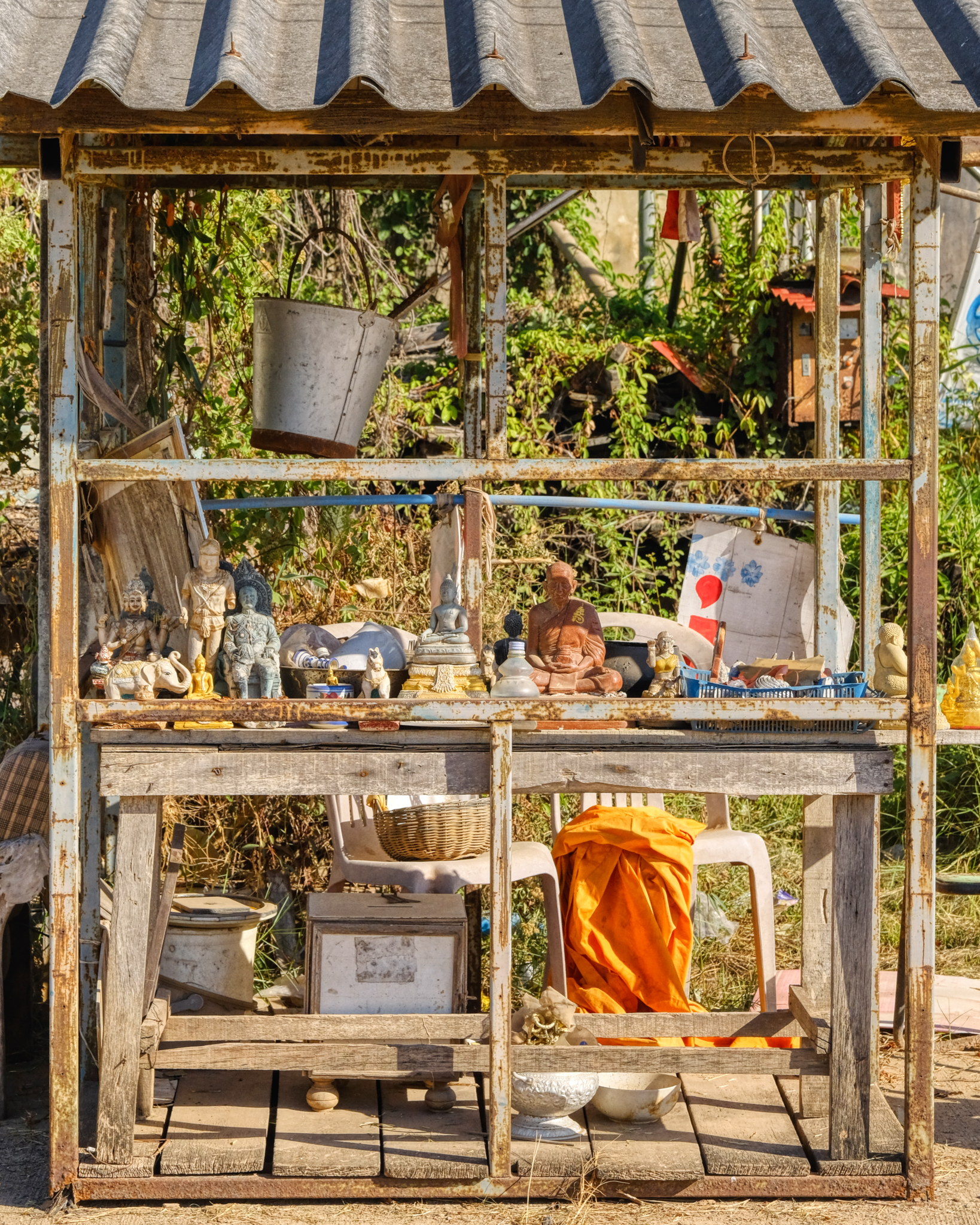 I had such wonderful memories of the spirituality of this Wat when I last visited. There are always interesting and unexpected things to see in a Wat. Some of what you see are what the monks themselves have arranged (like this small altar), but most of what is seen in a Wat are the results of what the big, rich donors want there to be.
I had such wonderful memories of the spirituality of this Wat when I last visited. There are always interesting and unexpected things to see in a Wat. Some of what you see are what the monks themselves have arranged (like this small altar), but most of what is seen in a Wat are the results of what the big, rich donors want there to be.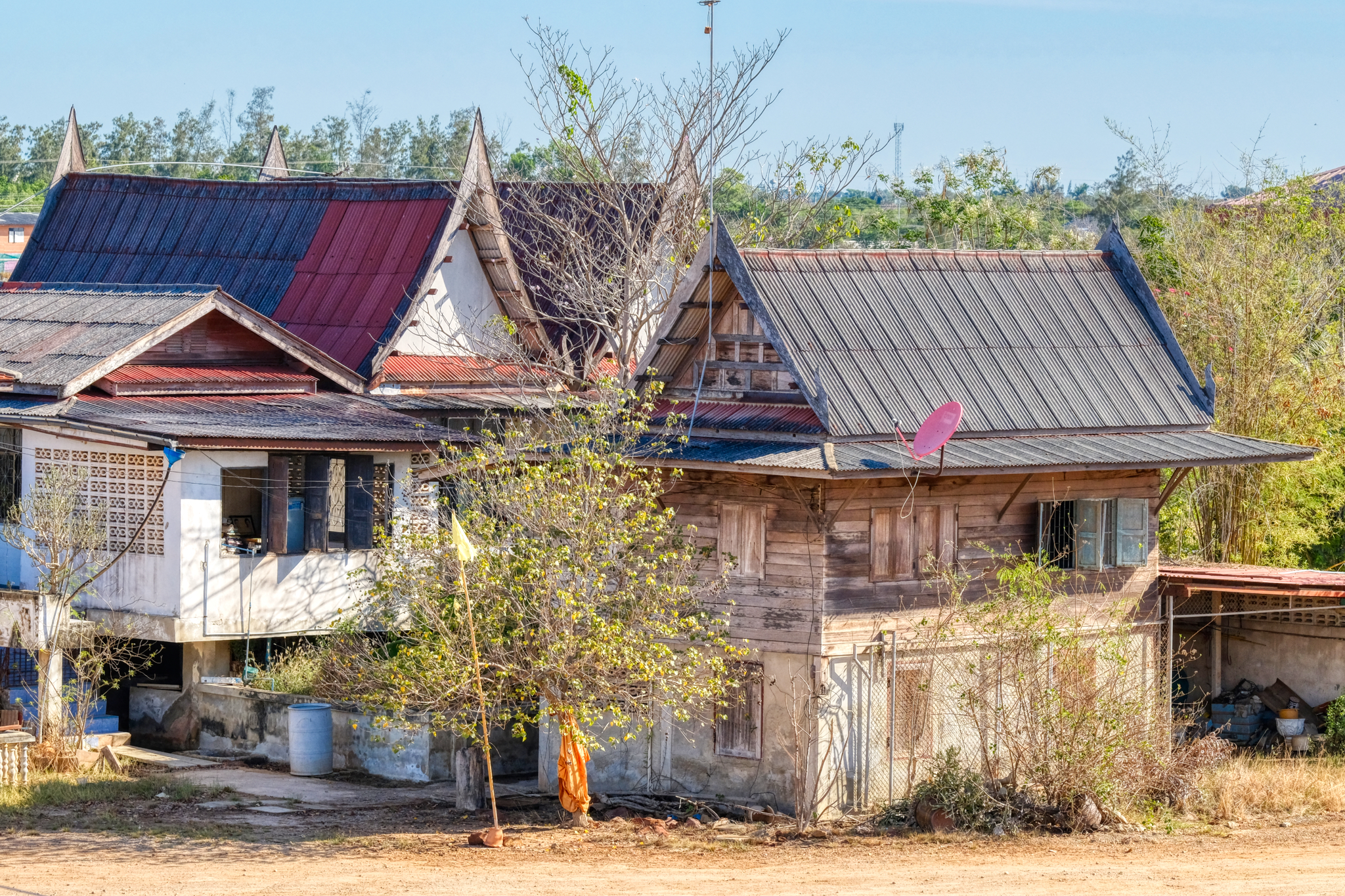 The surviving old monk quarters. I am always amazed to see a satellite dish in a Buddhist temple . . .
The surviving old monk quarters. I am always amazed to see a satellite dish in a Buddhist temple . . .  Always beautiful flowers to be seen in a Wat.
Always beautiful flowers to be seen in a Wat. Wat Lat Yai has some of the strangest 'grottos' I have ever seen. From the outside they are just plain weird . . .
Wat Lat Yai has some of the strangest 'grottos' I have ever seen. From the outside they are just plain weird . . .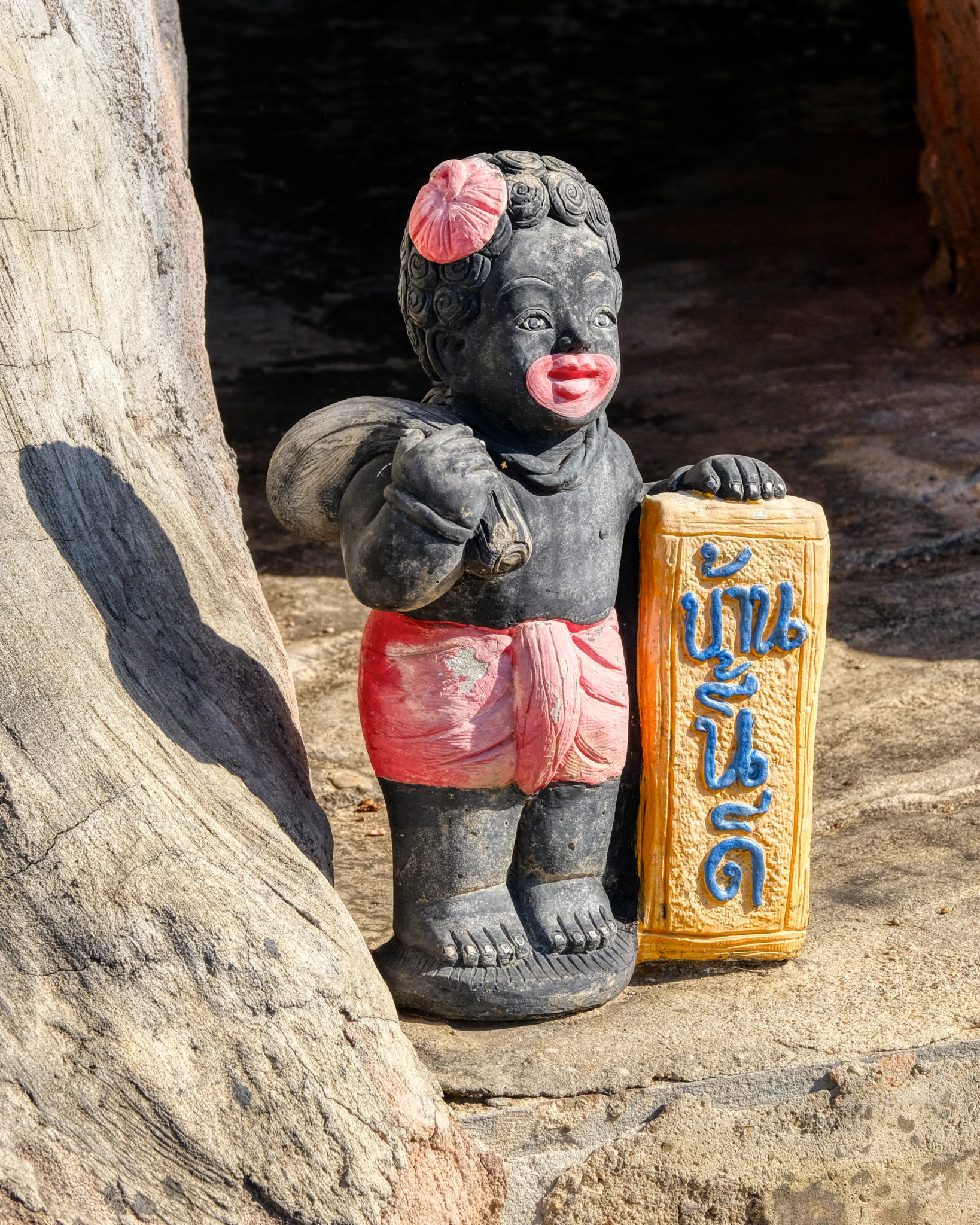 What exactly is going on here? Remember, these things are placed in temples by the doners, not by the monks, who renounce material things. But still . . . .
What exactly is going on here? Remember, these things are placed in temples by the doners, not by the monks, who renounce material things. But still . . . . Although the outside of this man-made grotto was a little strange, the inside was magic.
Although the outside of this man-made grotto was a little strange, the inside was magic.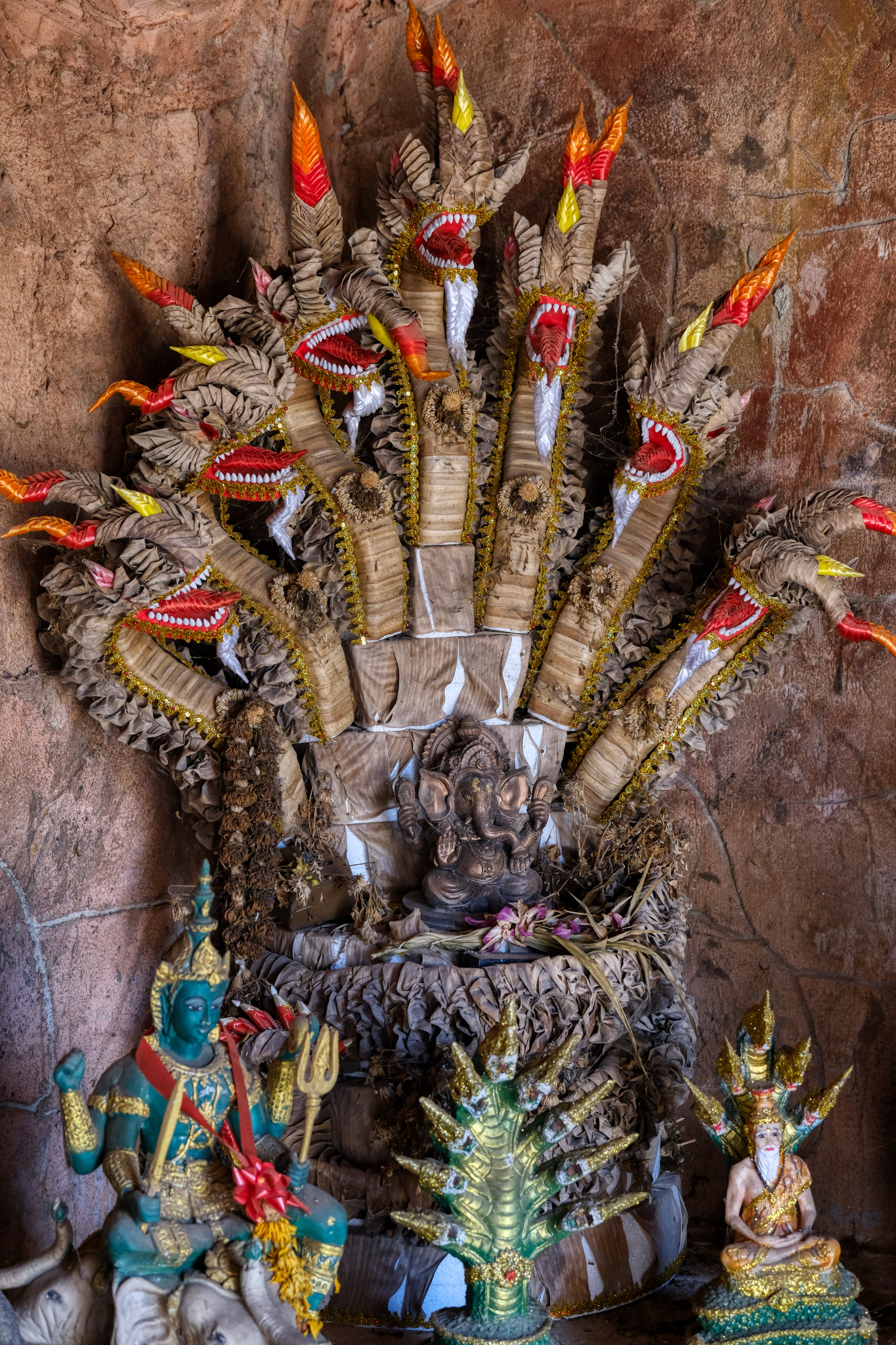 The banana leaf origami on this altar piece was stunningly beautiful. I felt a little like Indiana Jones discovering a lost tomb or ancient temple never seen before. These are Hindu religious items revered in Thailand along side The Buddha.
The banana leaf origami on this altar piece was stunningly beautiful. I felt a little like Indiana Jones discovering a lost tomb or ancient temple never seen before. These are Hindu religious items revered in Thailand along side The Buddha. Remarkable fine detailing.
Remarkable fine detailing.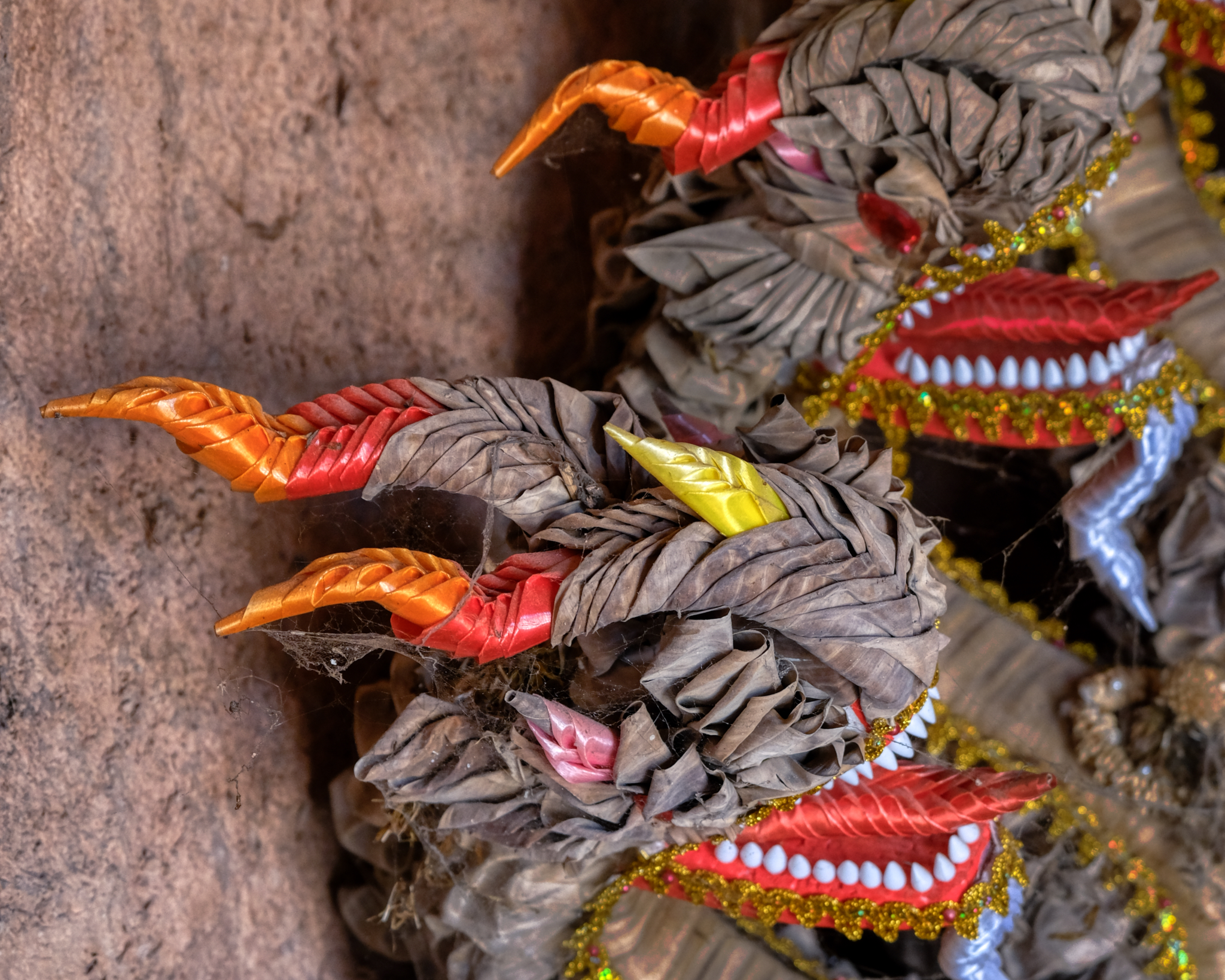 Even the cobwebs seem to belong; adding to the spiritual power of this votive object.
Even the cobwebs seem to belong; adding to the spiritual power of this votive object.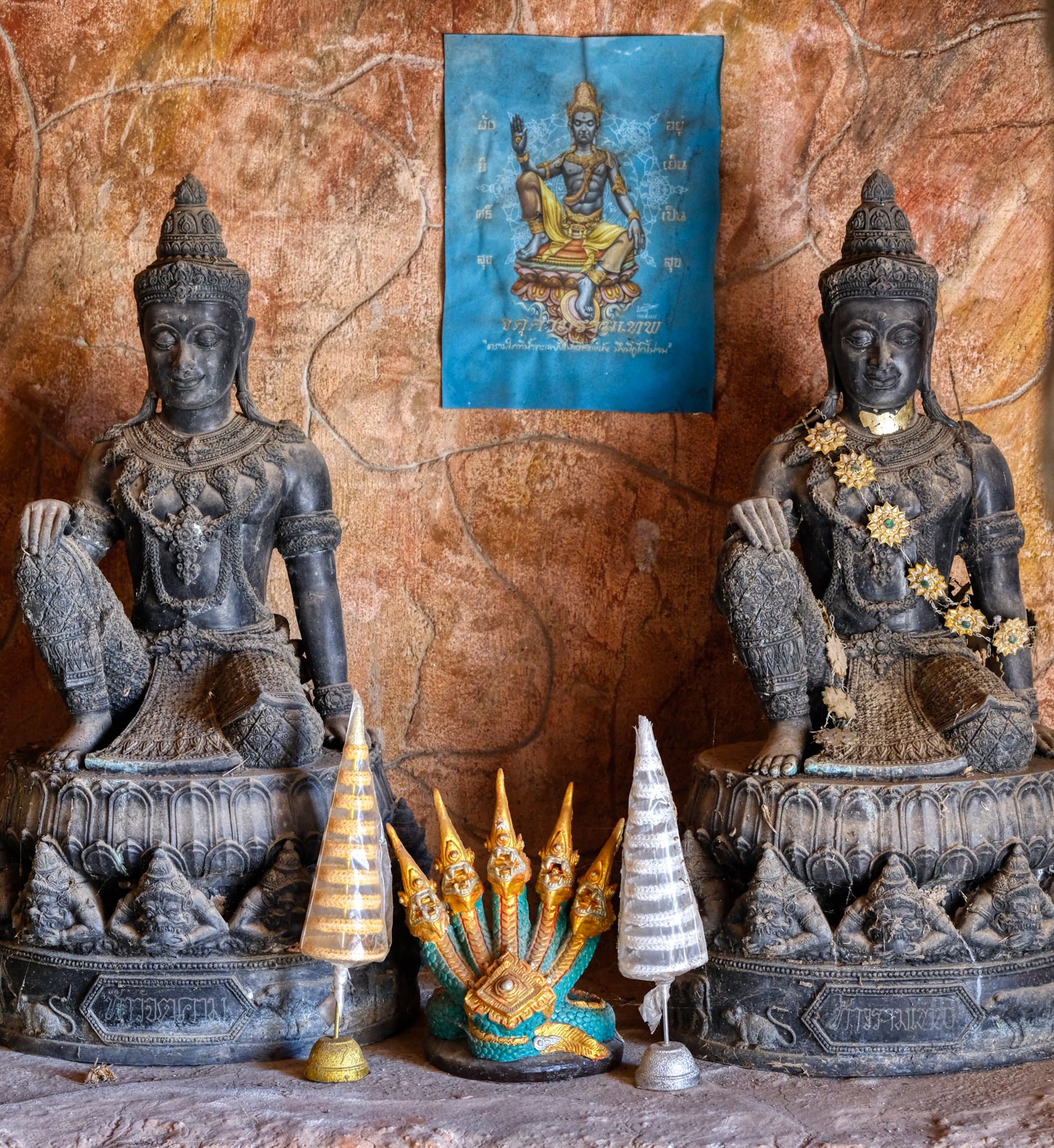 Bikkus, listeners of the Buddha teaching the dharma.
Bikkus, listeners of the Buddha teaching the dharma. Another Hindu reference . . . a four face sadhu.
Another Hindu reference . . . a four face sadhu.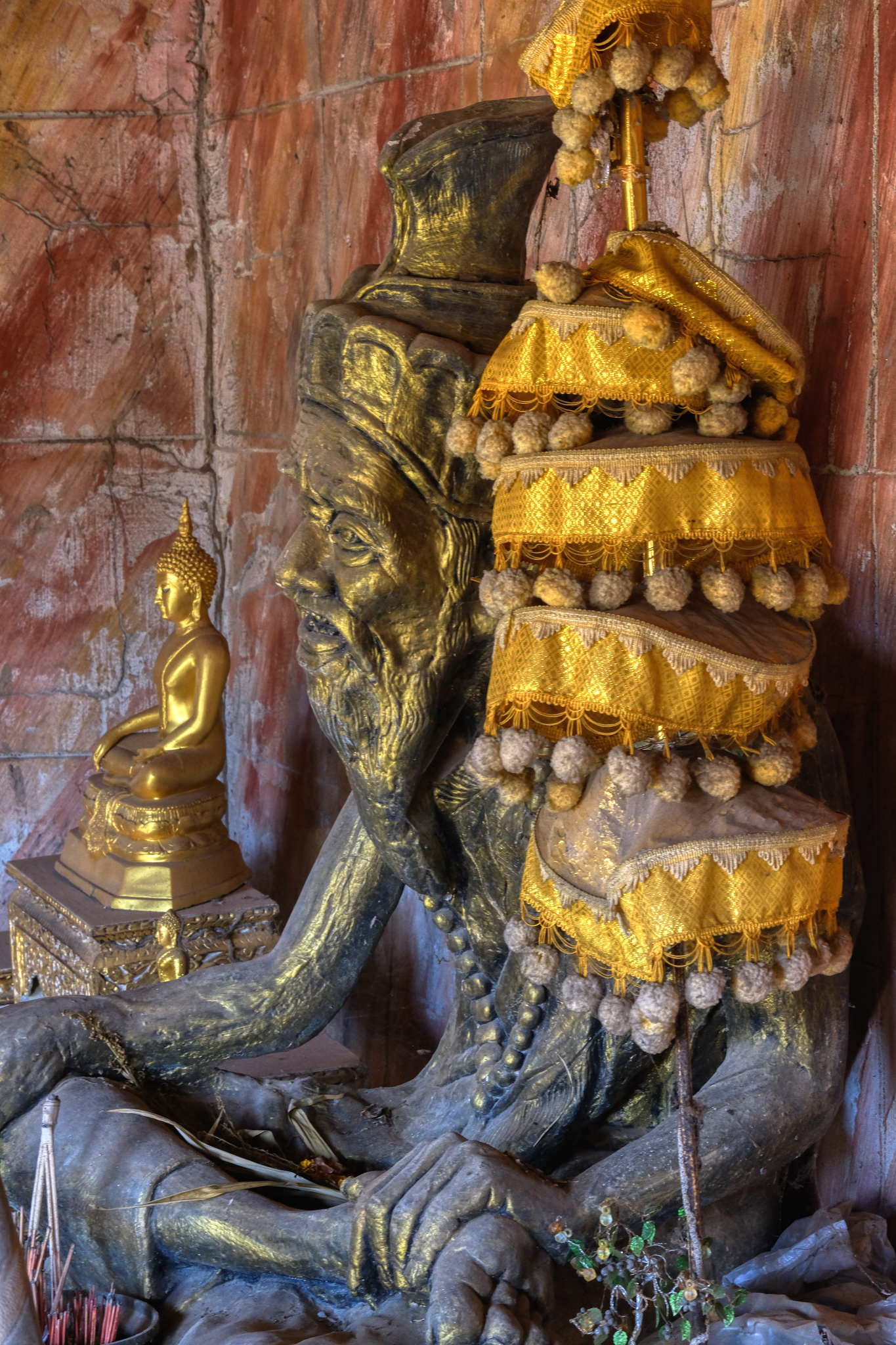 Sadhu and Buddha images in the grotto. I loved being in that space . . .
Sadhu and Buddha images in the grotto. I loved being in that space . . .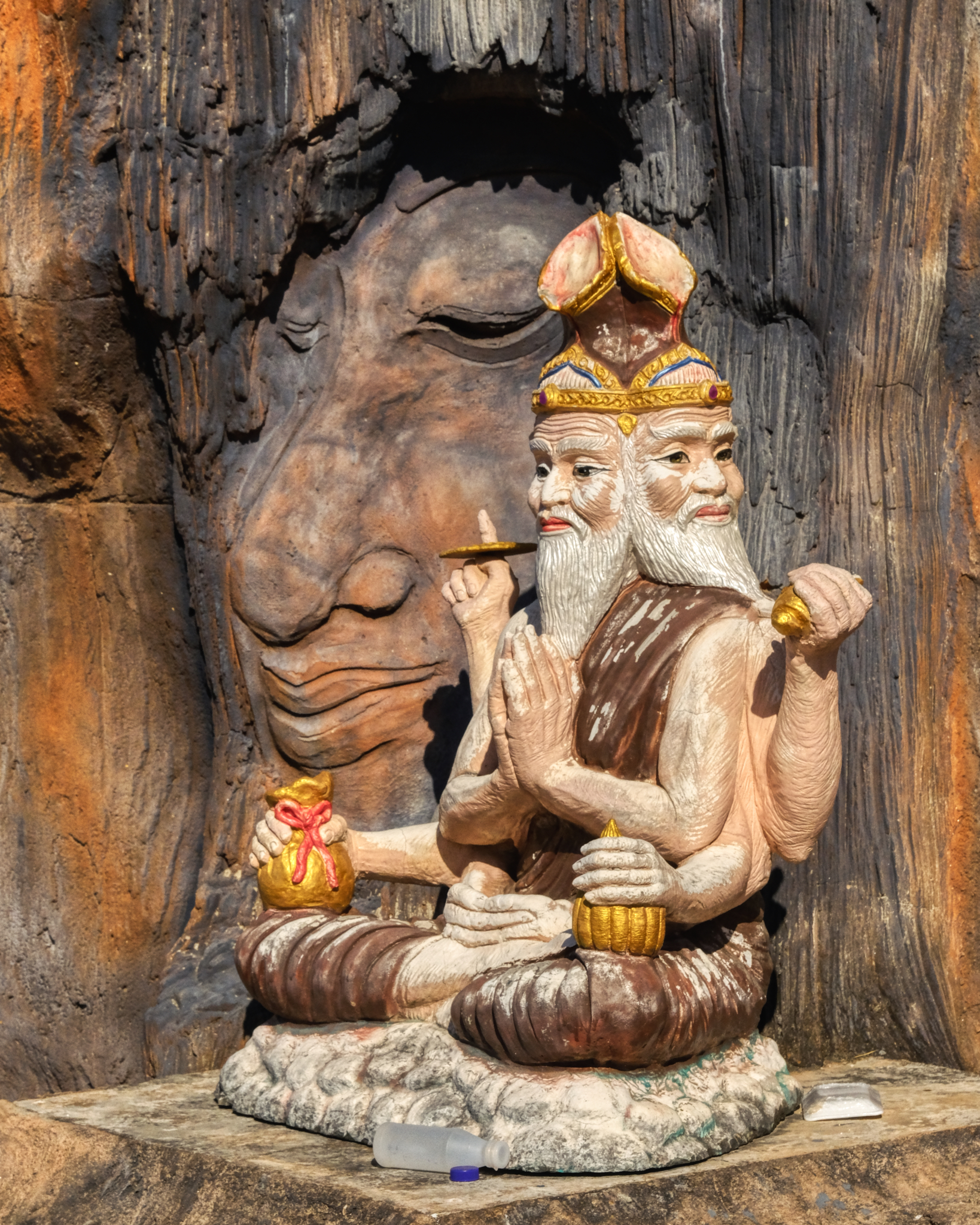 There were also a series of enclave altars around the outside and back of the grotto structure.
There were also a series of enclave altars around the outside and back of the grotto structure.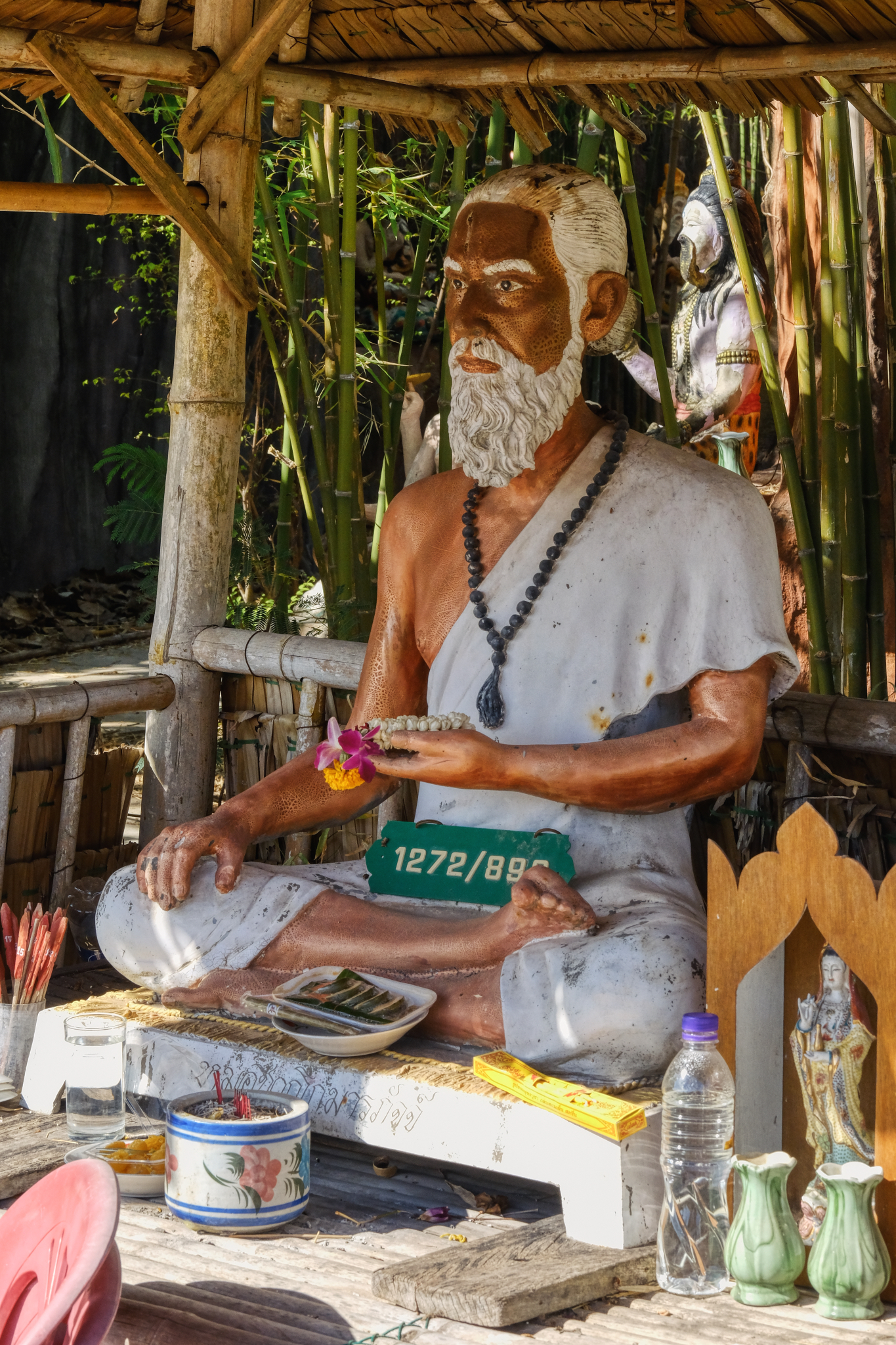 These are living altars. As can be seen, people bring offerings, usually wishing or hoping for good luck. Notice that someone has left the address plate from their house on the altar . . .
These are living altars. As can be seen, people bring offerings, usually wishing or hoping for good luck. Notice that someone has left the address plate from their house on the altar . . .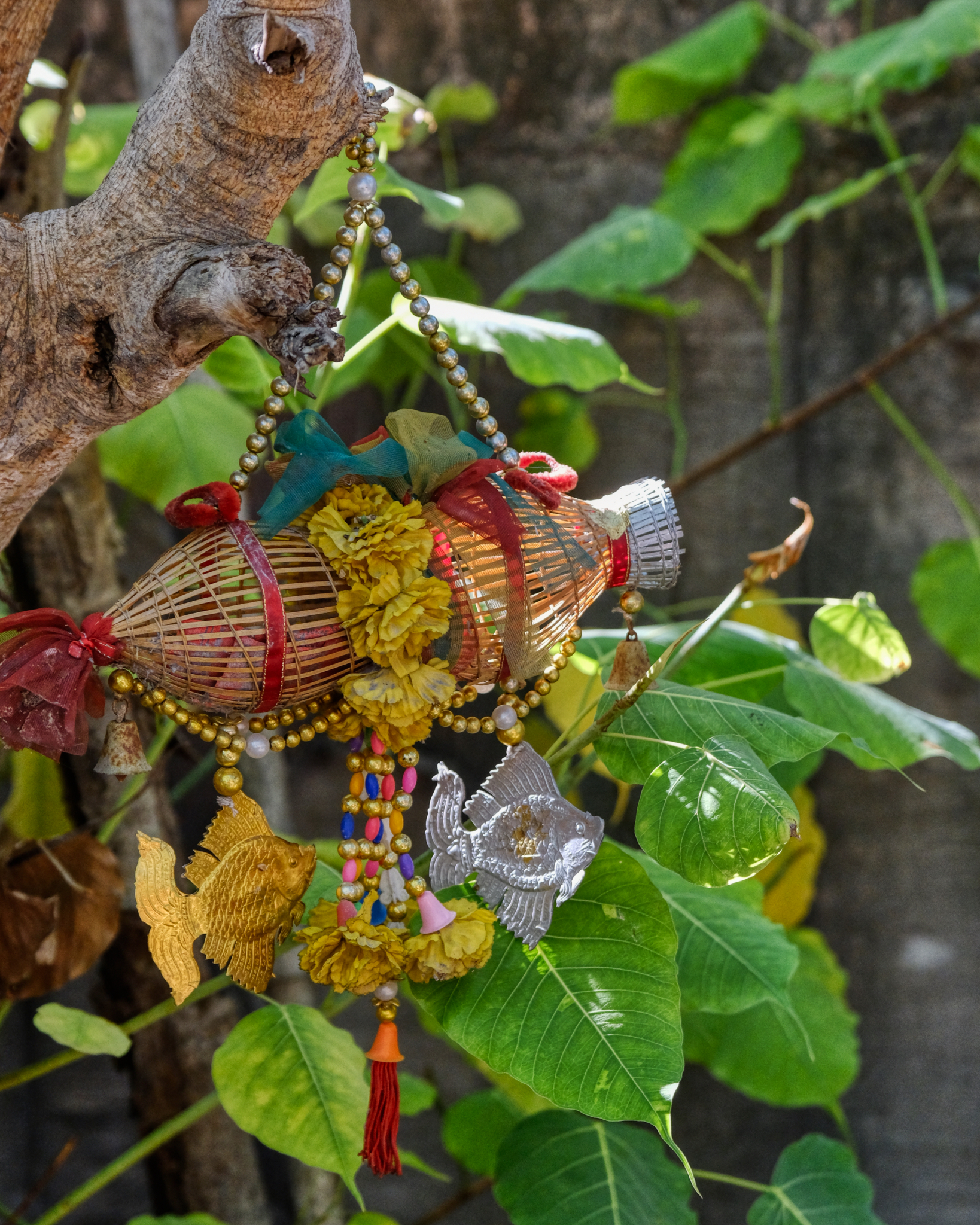 Slung here and there, votive charms festoon the temple trees.
Slung here and there, votive charms festoon the temple trees.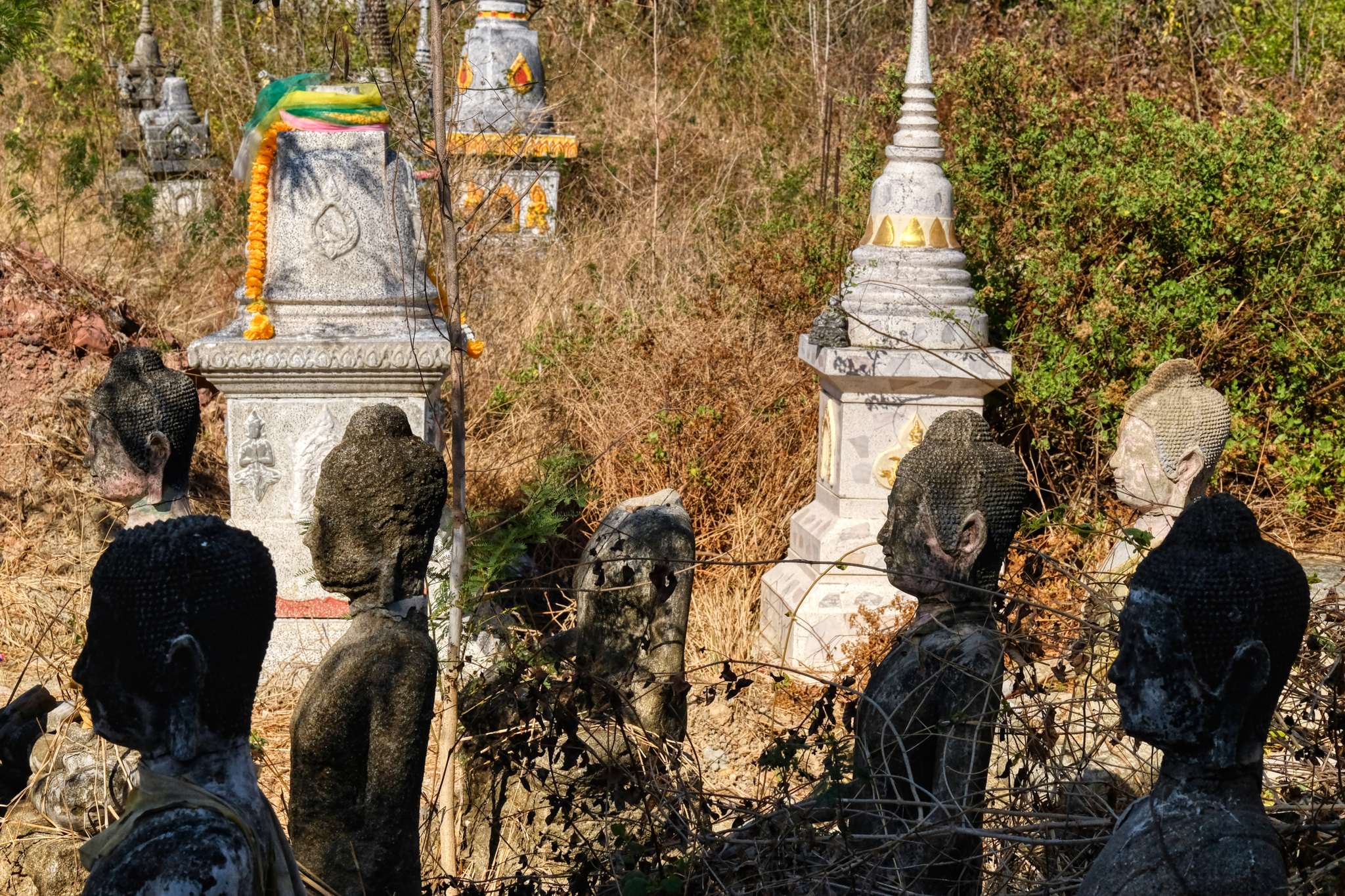 The reason I wanted to return to this Wat and bring friends, was because there used to be a tropical pine grove with old Buddha images in it . . . covered in pine needles. The pine forest is gone: slashed because they did not fit the plan of a doner with a new vision for this temple. The old Buddhas were still there, but looking like they have been 'mothballed' . . .
The reason I wanted to return to this Wat and bring friends, was because there used to be a tropical pine grove with old Buddha images in it . . . covered in pine needles. The pine forest is gone: slashed because they did not fit the plan of a doner with a new vision for this temple. The old Buddhas were still there, but looking like they have been 'mothballed' . . .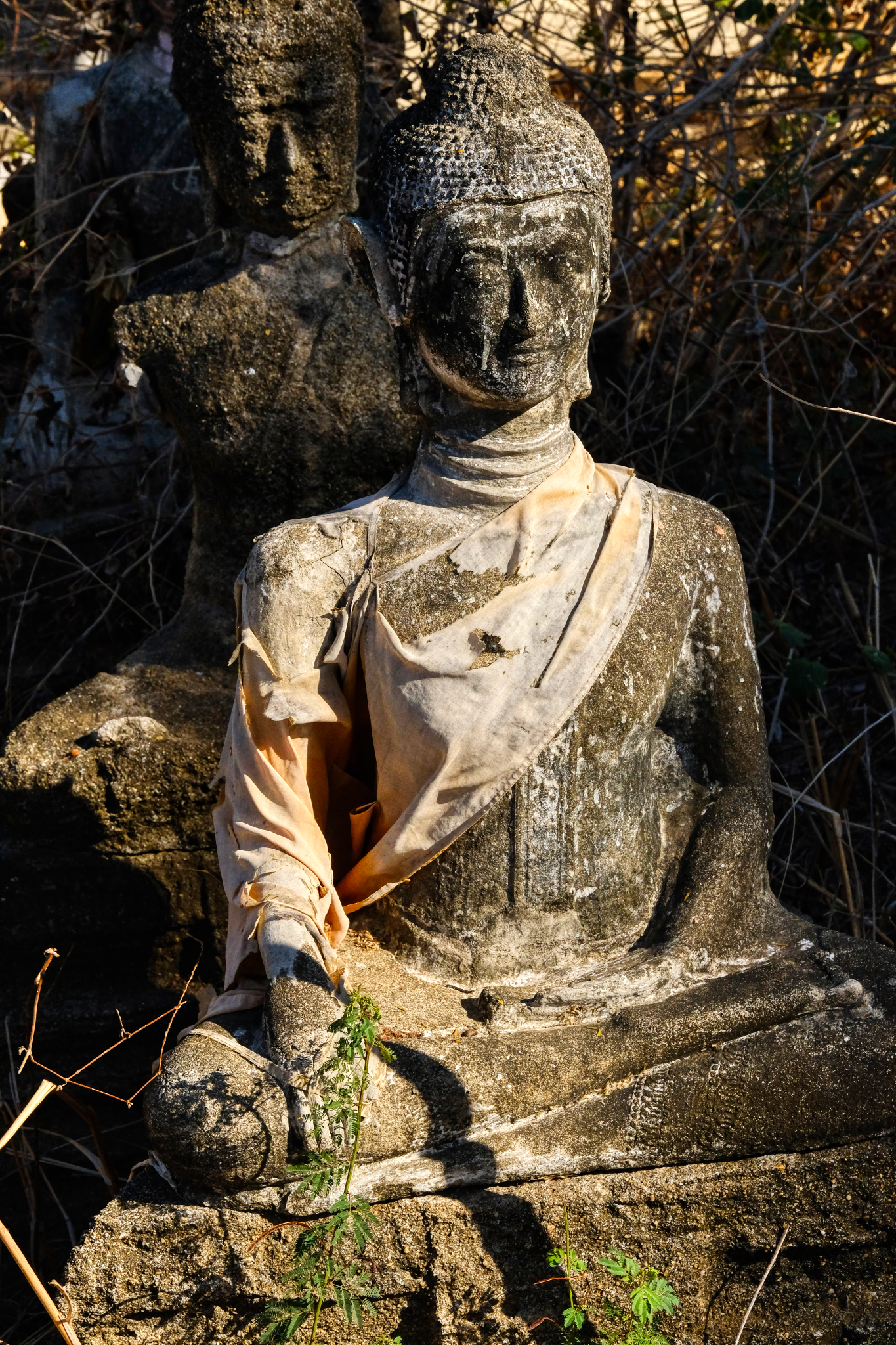 These old, and seemingly discarded, Buddha images seemed to me to be highly spiritual reminders of the project that the Buddha called us to try.
These old, and seemingly discarded, Buddha images seemed to me to be highly spiritual reminders of the project that the Buddha called us to try.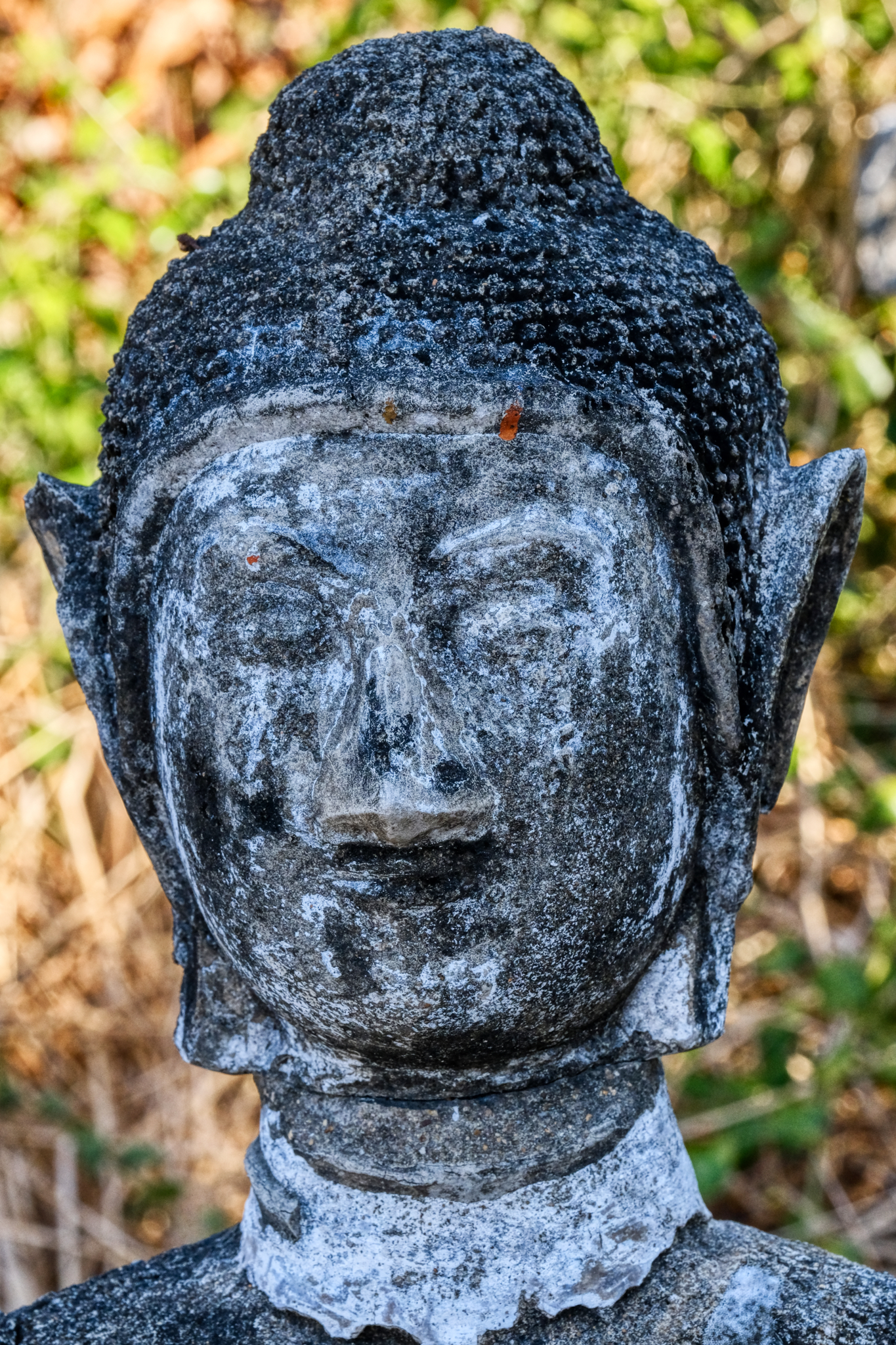 It seems like someone has taken a scraper to clean some of the moss of of this Buddha image.
It seems like someone has taken a scraper to clean some of the moss of of this Buddha image. Still bright and shiny . . . an overgrown mirror chedi.
Still bright and shiny . . . an overgrown mirror chedi.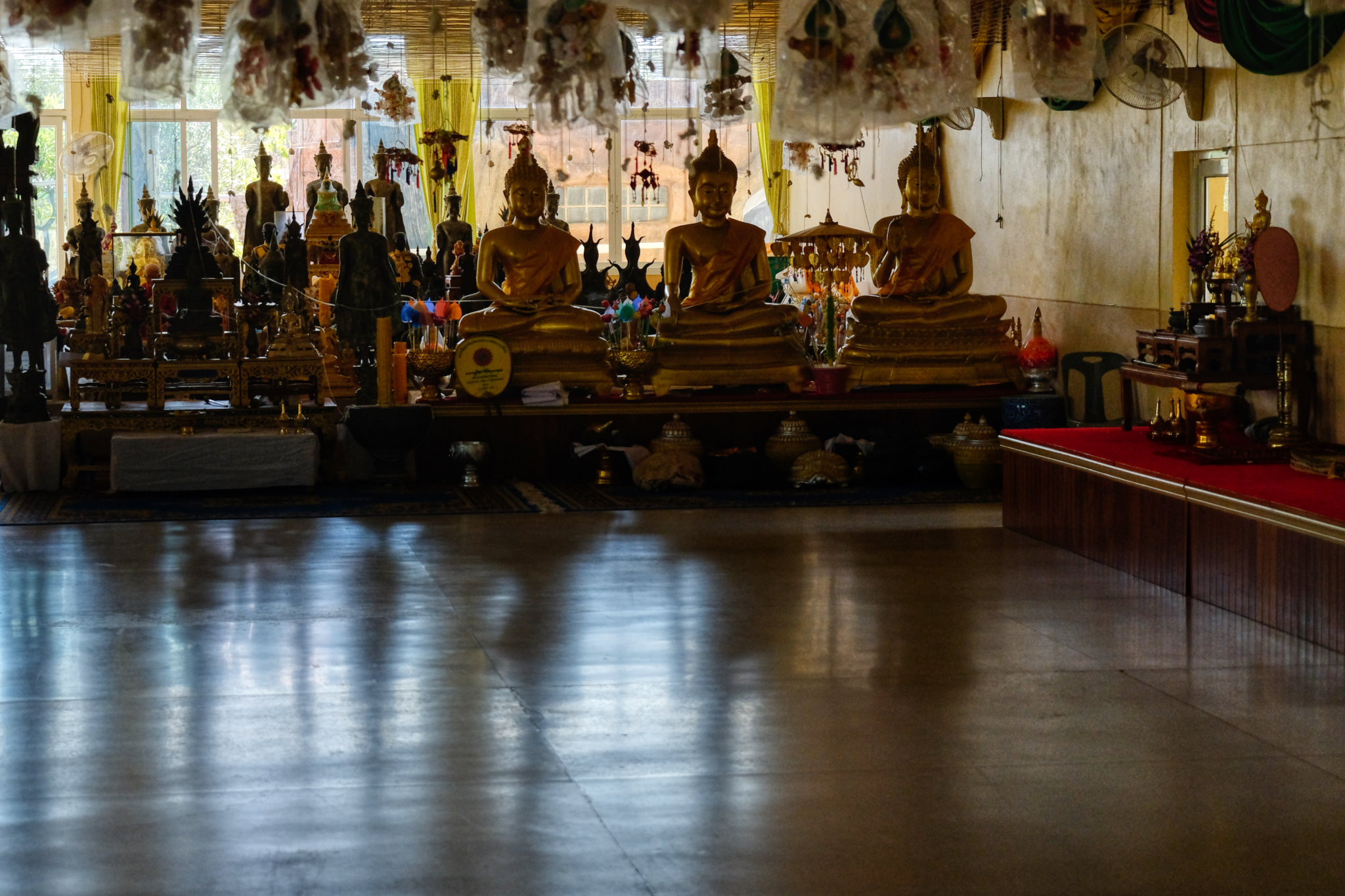 By this time of the morning (9:00am) it was already devilishly hot: well over 40c. We went inside to the shaded hall where two nice old ladies (helpers) brought us bottled water. The hall seemed temporary, perhaps being used until some other structure was being built.
By this time of the morning (9:00am) it was already devilishly hot: well over 40c. We went inside to the shaded hall where two nice old ladies (helpers) brought us bottled water. The hall seemed temporary, perhaps being used until some other structure was being built. The altar was crowded with Buddha images. Fascinating.
The altar was crowded with Buddha images. Fascinating.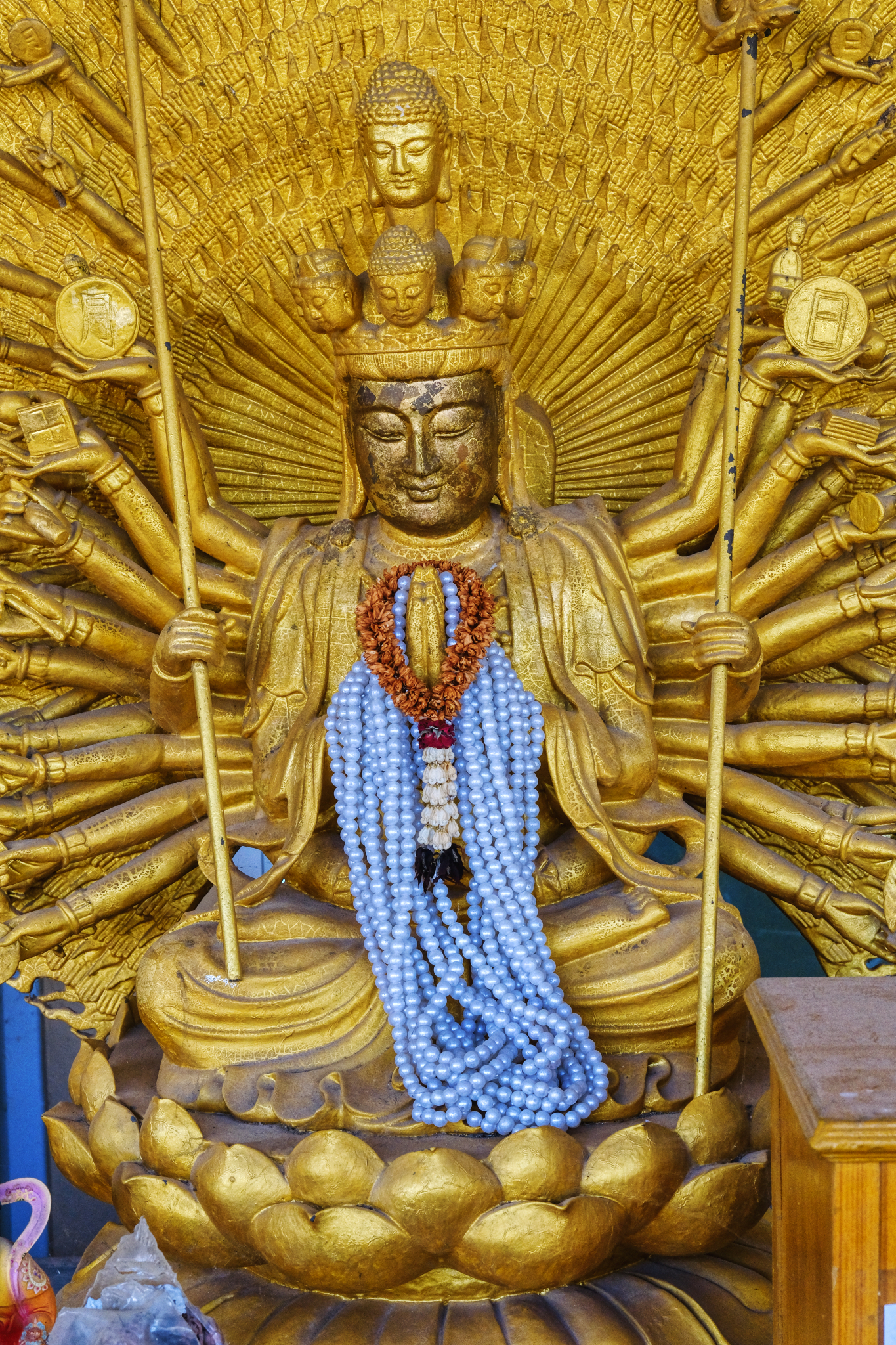 There seemed to be many more Hindu symbols in this Wat than others I have visited. I want a hat like this!
There seemed to be many more Hindu symbols in this Wat than others I have visited. I want a hat like this!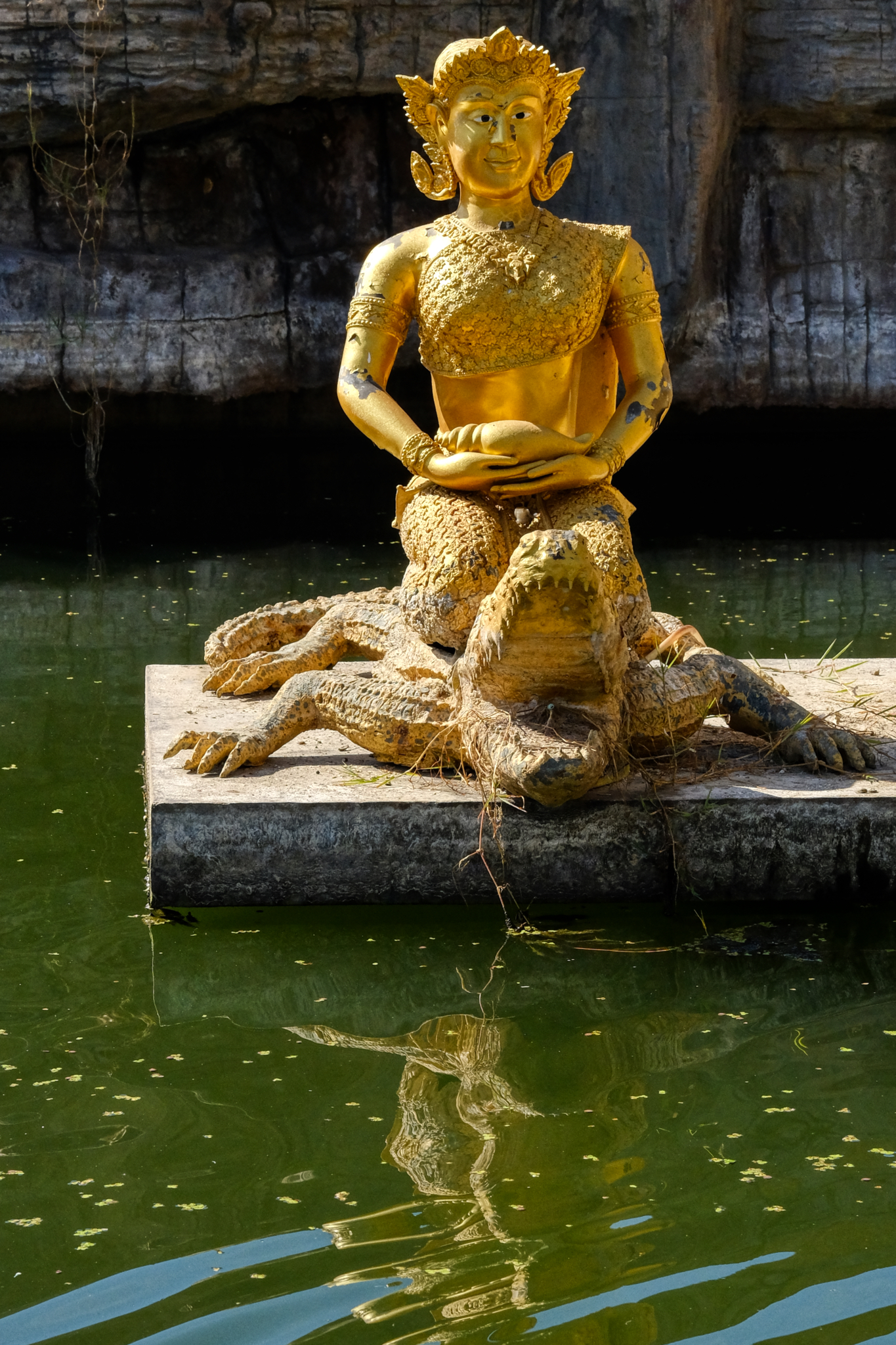 "What, me worry?" Supreme detachment. We left the Wat and headed back to the highway where we saw a sign pointing to small road and the name of another Wat . . .
"What, me worry?" Supreme detachment. We left the Wat and headed back to the highway where we saw a sign pointing to small road and the name of another Wat . . .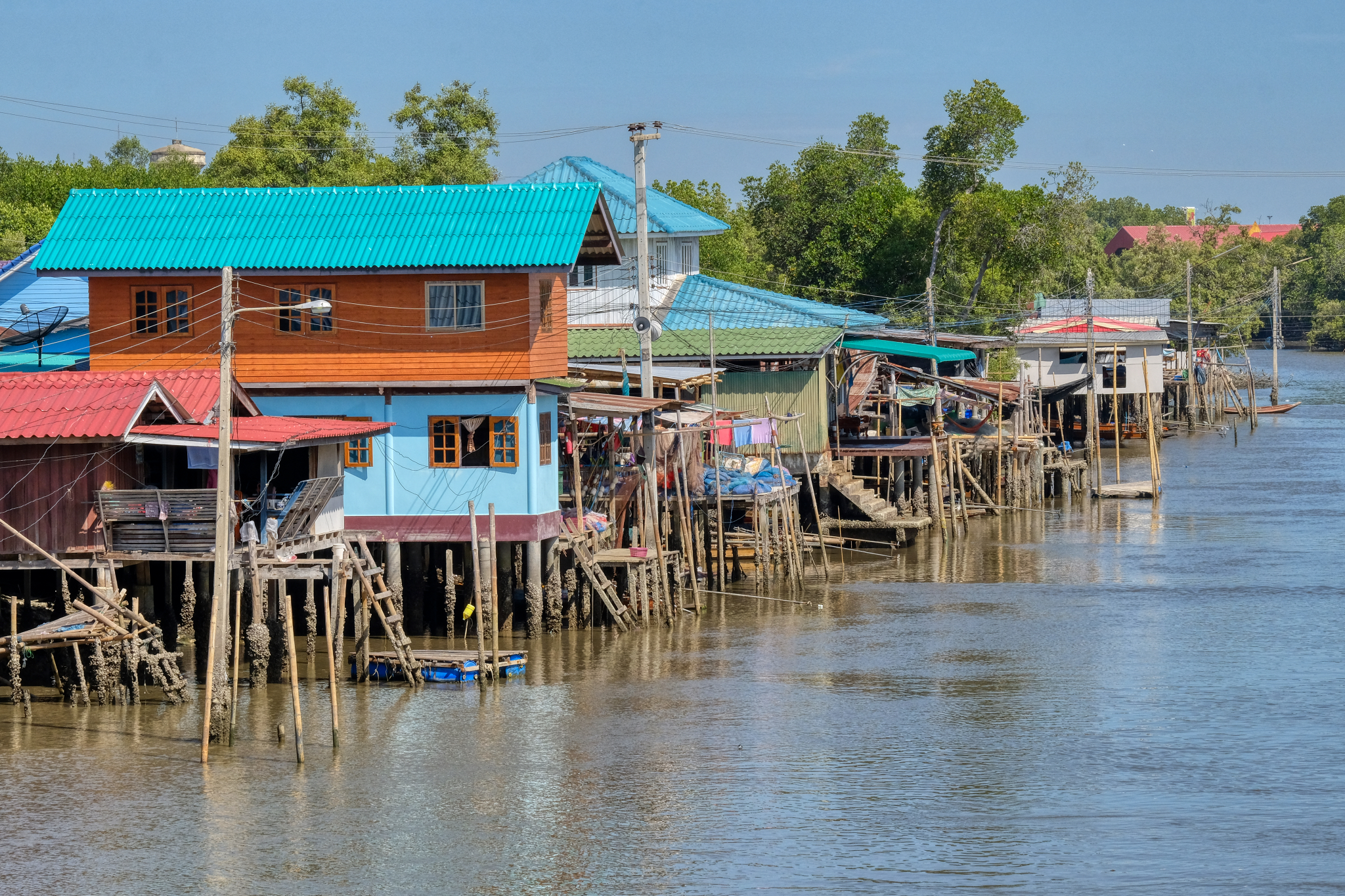 A short drive up a small rural road in search of another Buddhist temple to explore. We didn't find the temple, but we did find this wonderful village built on a canal not far from where it emptied into the Gulf of Thailand.
A short drive up a small rural road in search of another Buddhist temple to explore. We didn't find the temple, but we did find this wonderful village built on a canal not far from where it emptied into the Gulf of Thailand.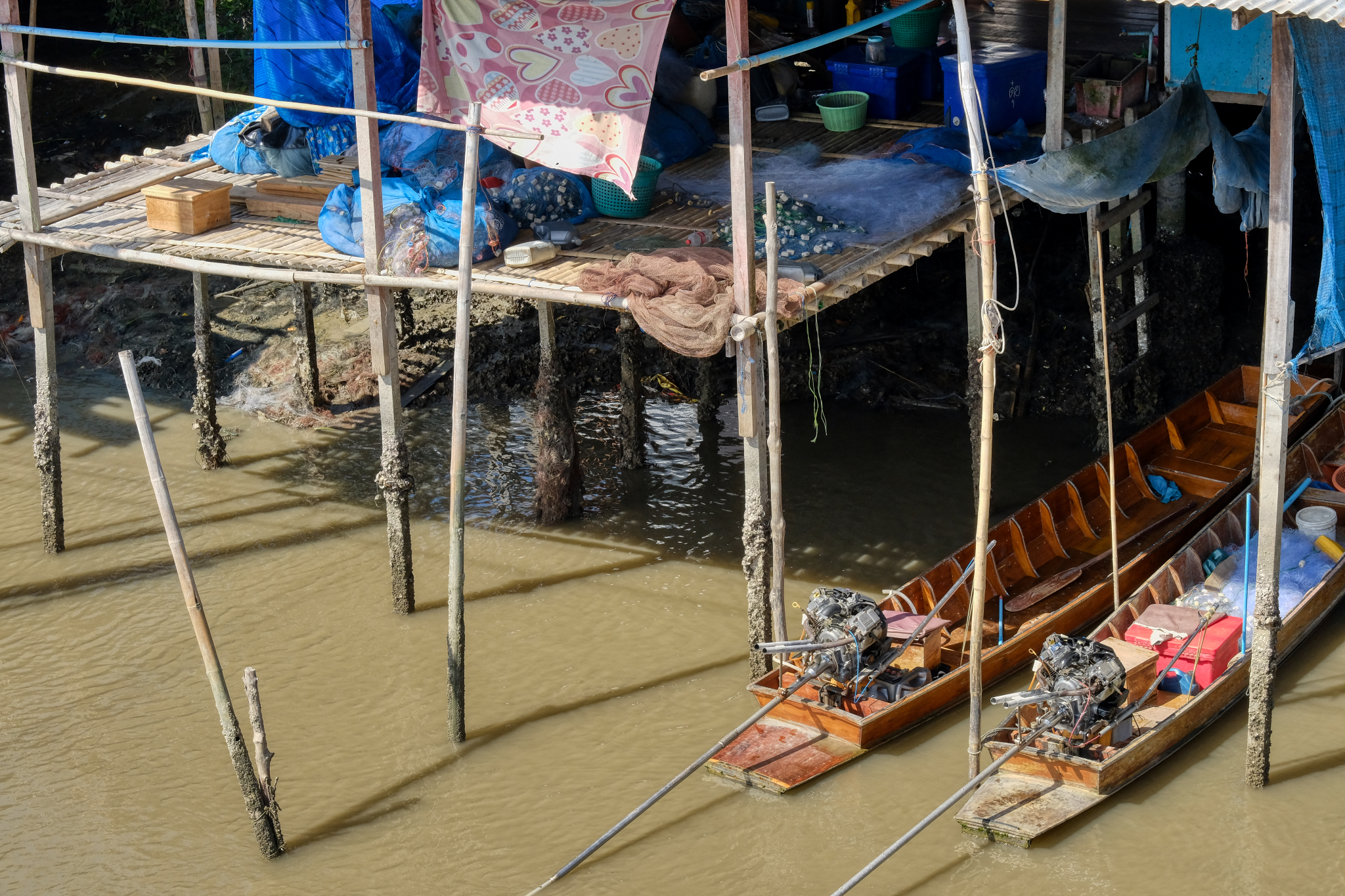 I love these canal side fishing villages . . . they are so picturesque . . . and visually complex.
I love these canal side fishing villages . . . they are so picturesque . . . and visually complex. Too hot to do anything other than to sit around with your friends and family and mend nets . . . unless you are a falang photographer, that is!
Too hot to do anything other than to sit around with your friends and family and mend nets . . . unless you are a falang photographer, that is!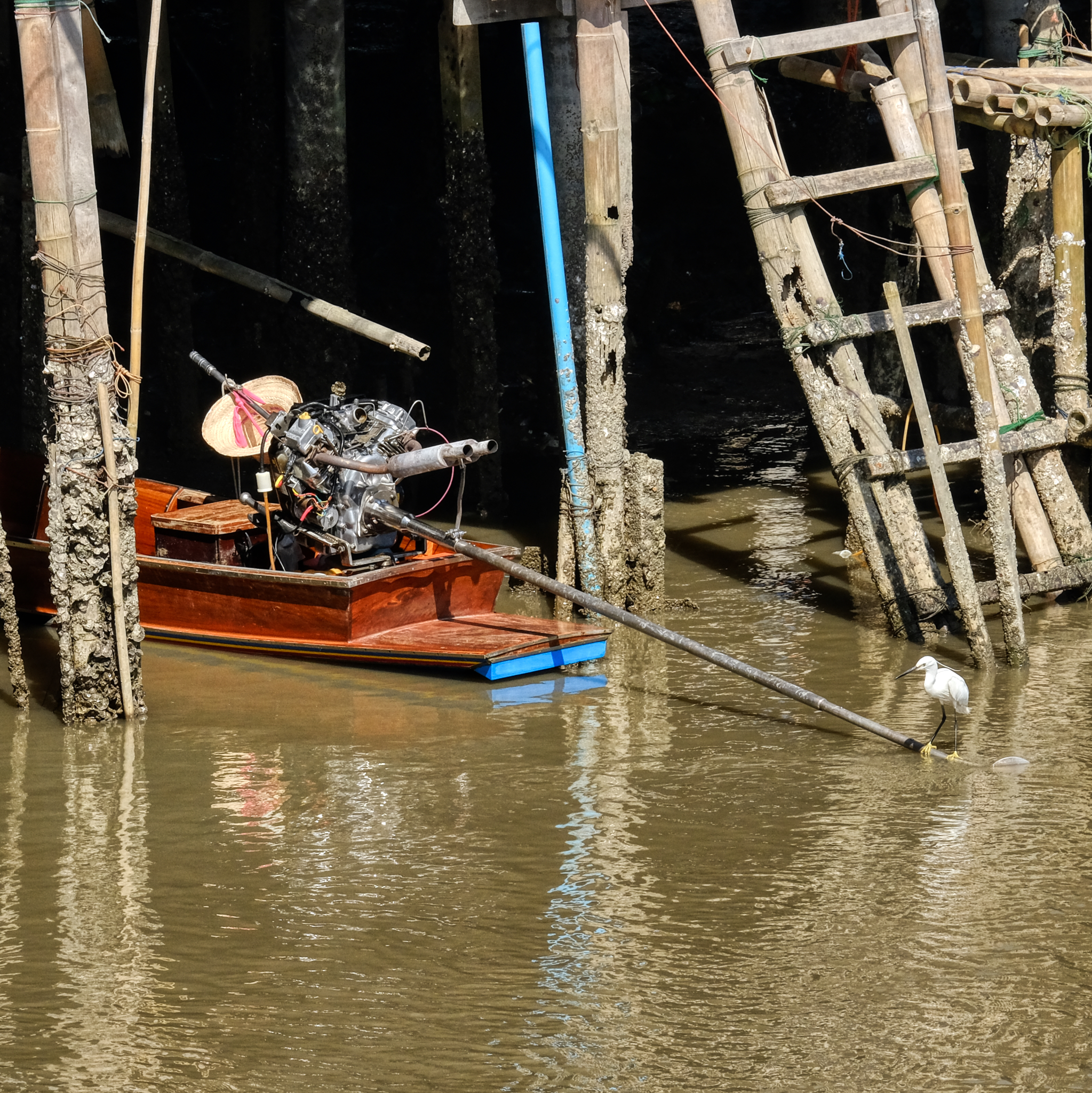 I'm not sure what the make of this V-2 long-tail boat engine is, but it was a beautiful scene.
I'm not sure what the make of this V-2 long-tail boat engine is, but it was a beautiful scene.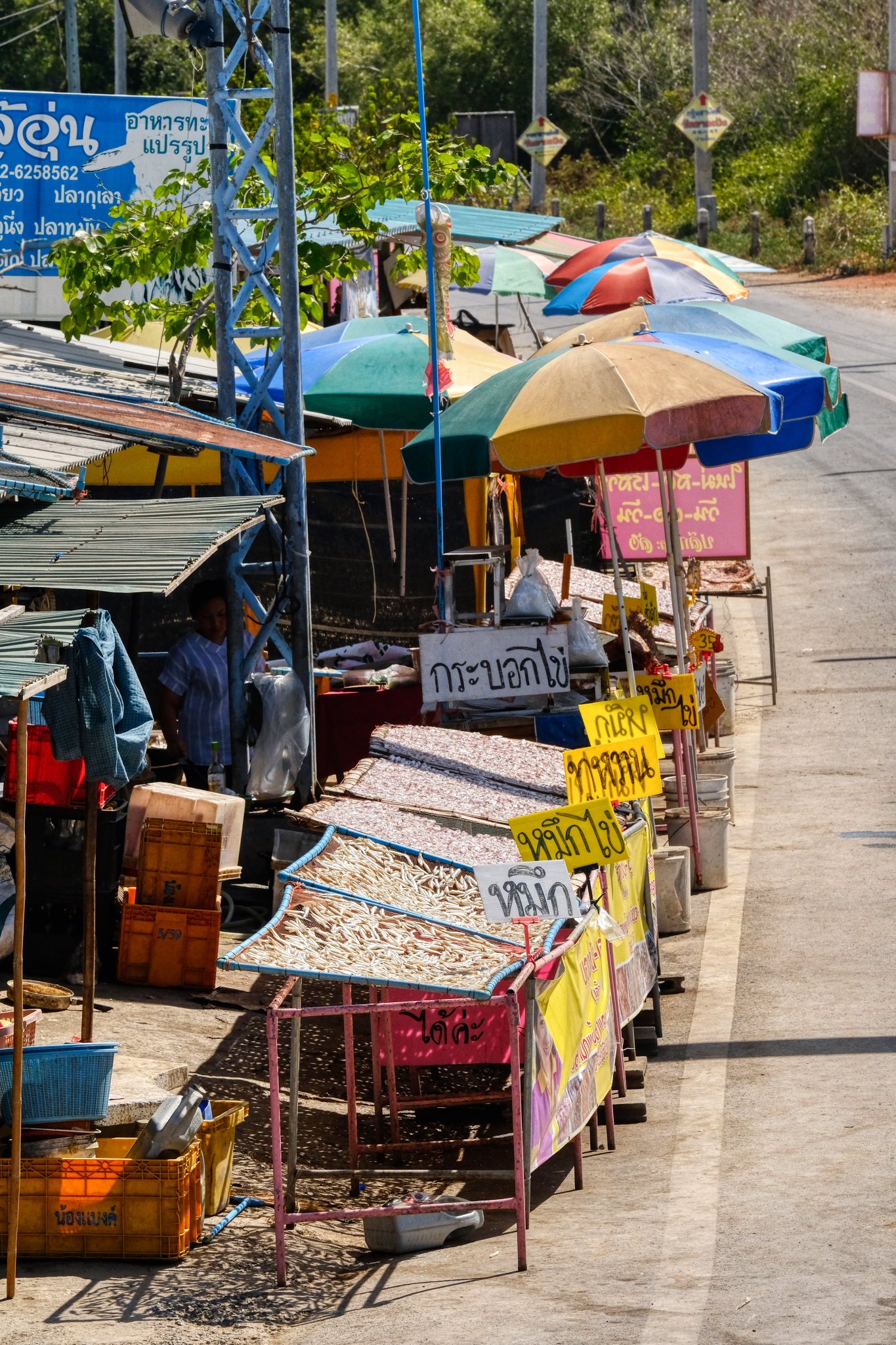 There was a lovely roadside fish market just outside the hamlet.
There was a lovely roadside fish market just outside the hamlet. Many different kinds, sizes, and colors of fish . . . all inviting visual exploration.
Many different kinds, sizes, and colors of fish . . . all inviting visual exploration. These small 'smelt' are very tasty when deep fat fried. One of my favorites.
These small 'smelt' are very tasty when deep fat fried. One of my favorites. Delicious-looking baby squid. My favorite.
Delicious-looking baby squid. My favorite.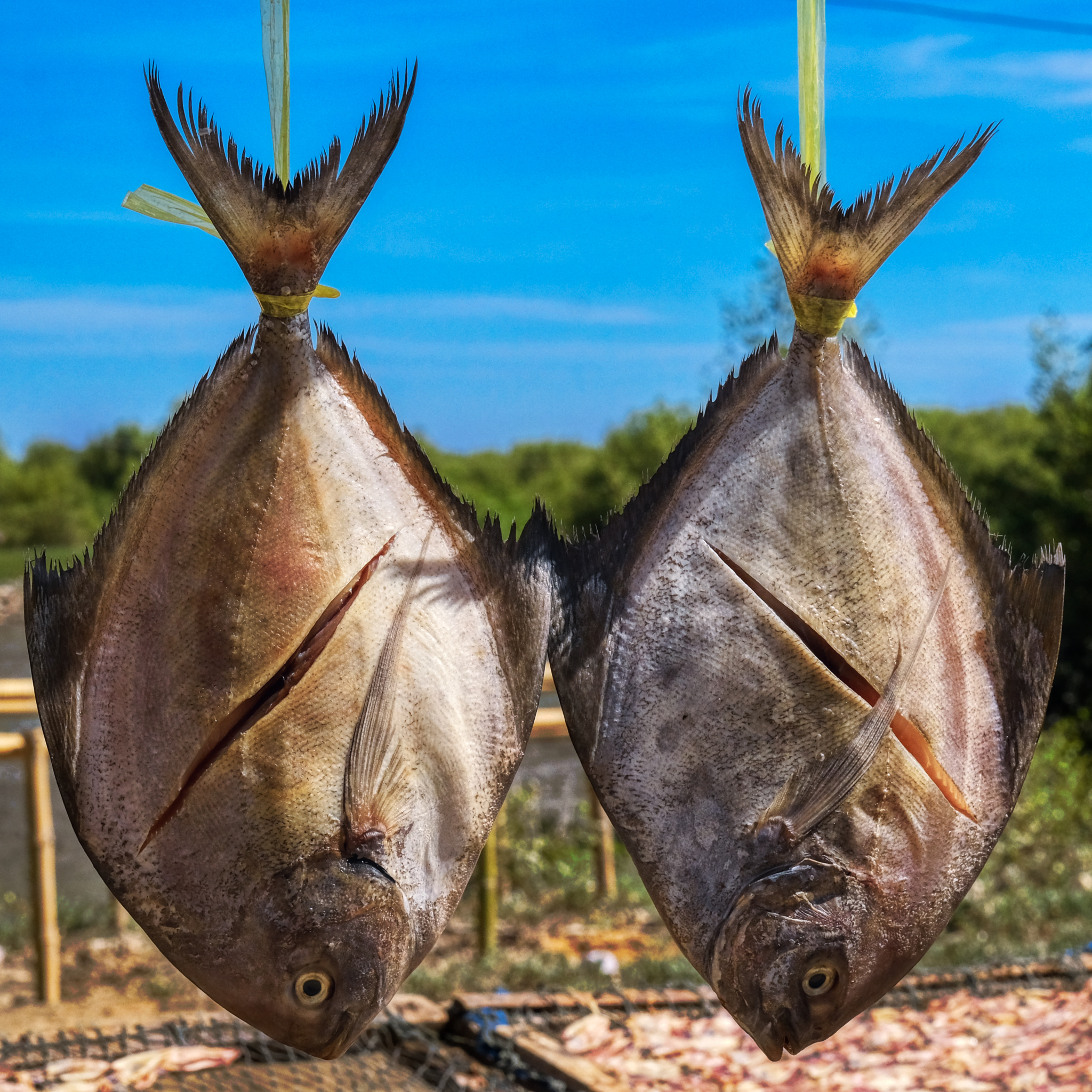 Good looking fish.
Good looking fish.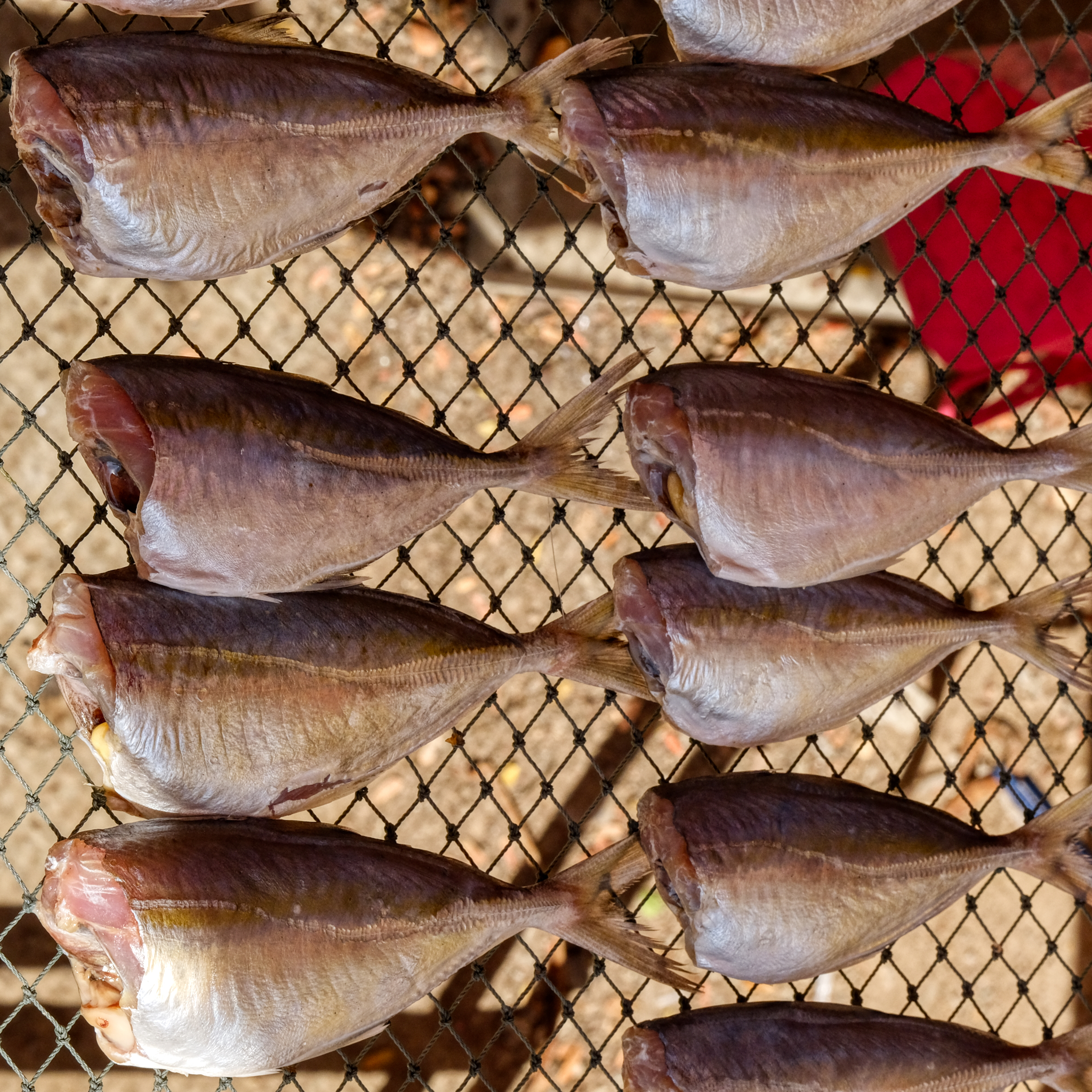 The drying fish are meant to be used in soups and curries.
The drying fish are meant to be used in soups and curries.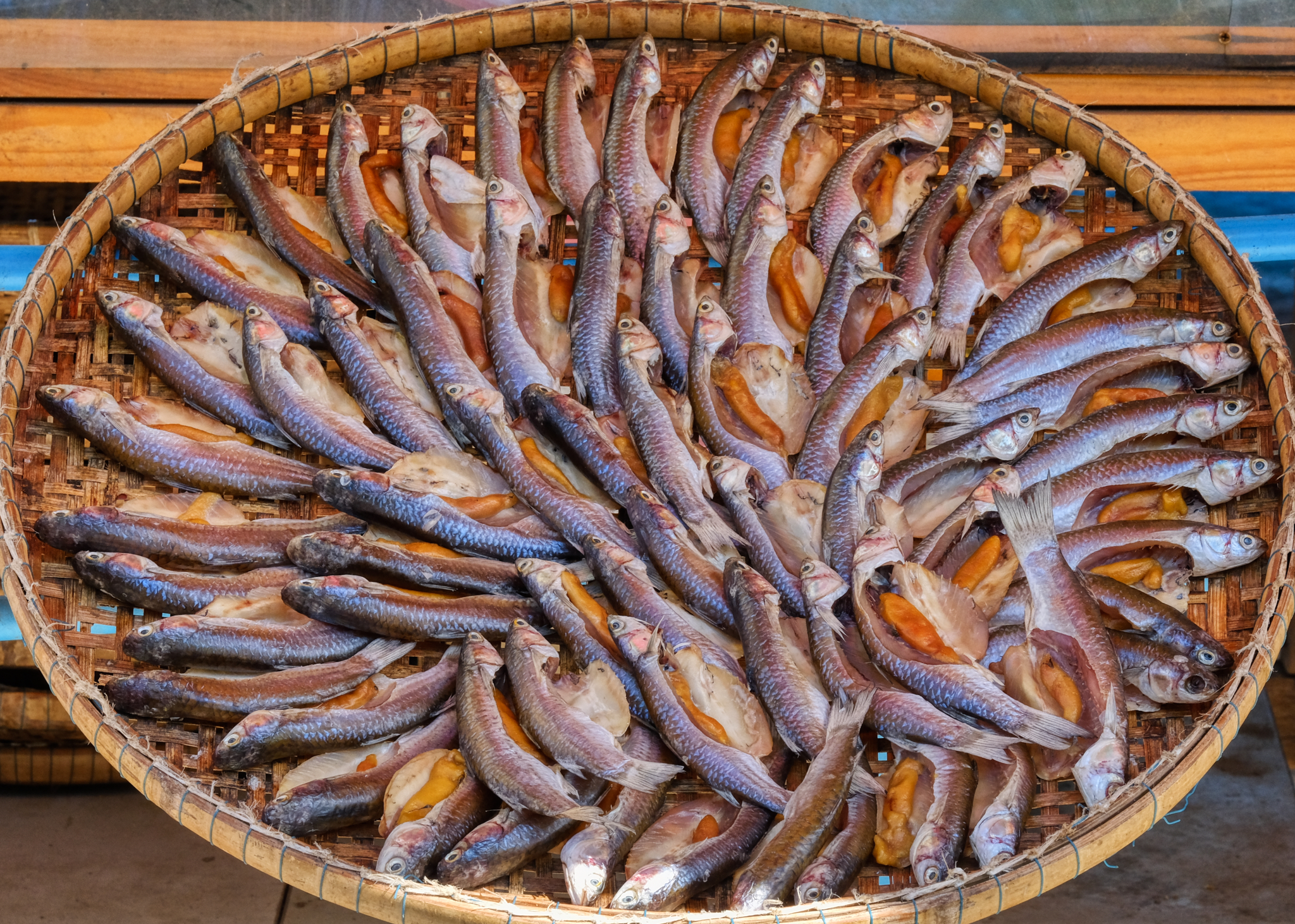 But, of course, the most visually interesting fish were the baskets with their intricately patterned fish on display.
But, of course, the most visually interesting fish were the baskets with their intricately patterned fish on display. While I was photographing these fish baskets, I was thinking that these would print and frame very beautifully as a set.
While I was photographing these fish baskets, I was thinking that these would print and frame very beautifully as a set. Perhaps I should come back here with a big tripod and reflectors for more professional, and better framed, shots . . .
Perhaps I should come back here with a big tripod and reflectors for more professional, and better framed, shots . . .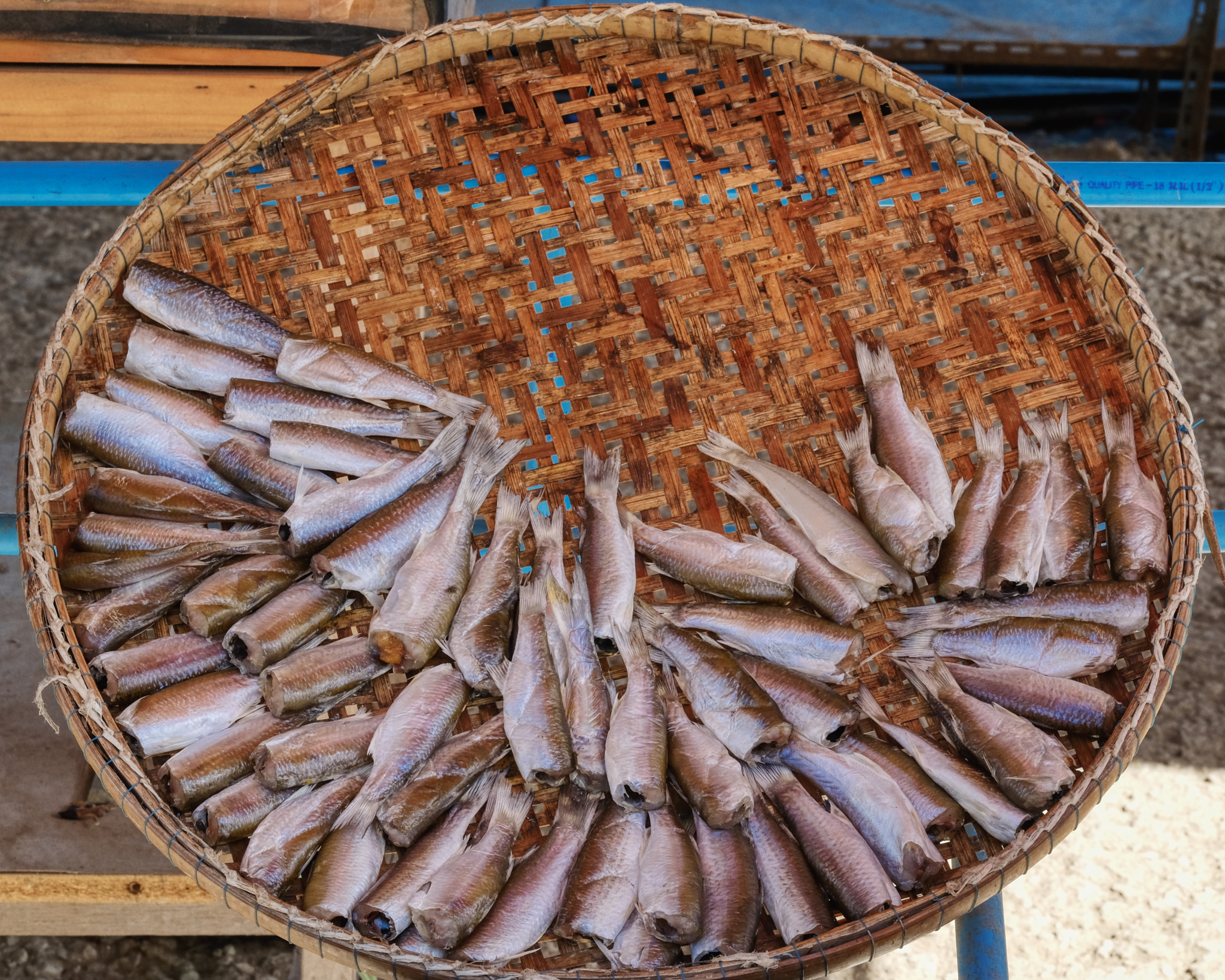 I took many, many photos of these beautiful fish baskets, but only post a few here.
I took many, many photos of these beautiful fish baskets, but only post a few here.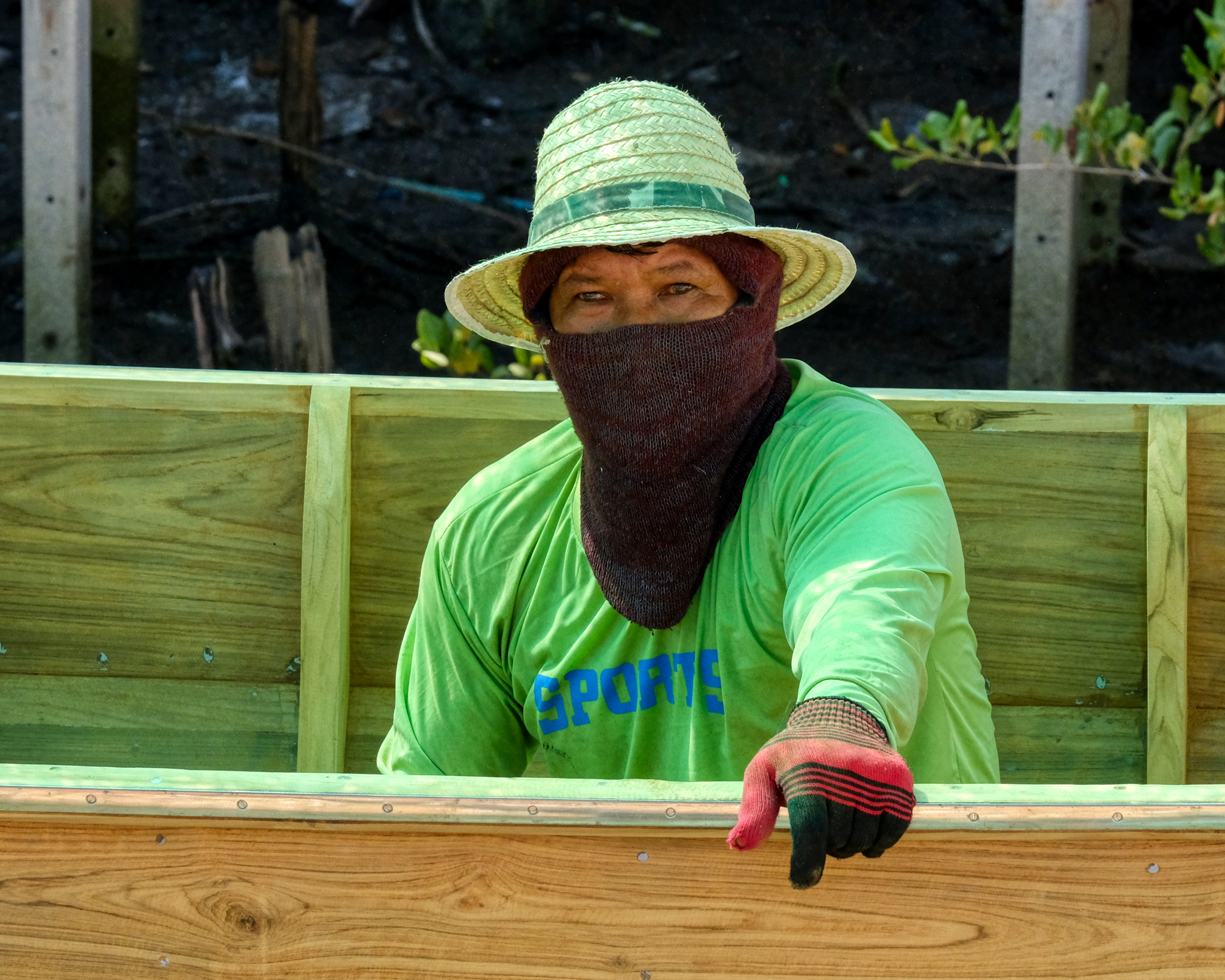 We asked one of the fish hawkers how to get to the seashore and they pointed to a small road. We passed this woman busily building a boat on the roadside in tremendous heat and humidity.
We asked one of the fish hawkers how to get to the seashore and they pointed to a small road. We passed this woman busily building a boat on the roadside in tremendous heat and humidity. The small dirt road dumped us out at the foot of these mud flats . . . crawling with small crabs. These are the mud flats famous for a particular type of small clam that the Thais absolutely love to eat.
The small dirt road dumped us out at the foot of these mud flats . . . crawling with small crabs. These are the mud flats famous for a particular type of small clam that the Thais absolutely love to eat. 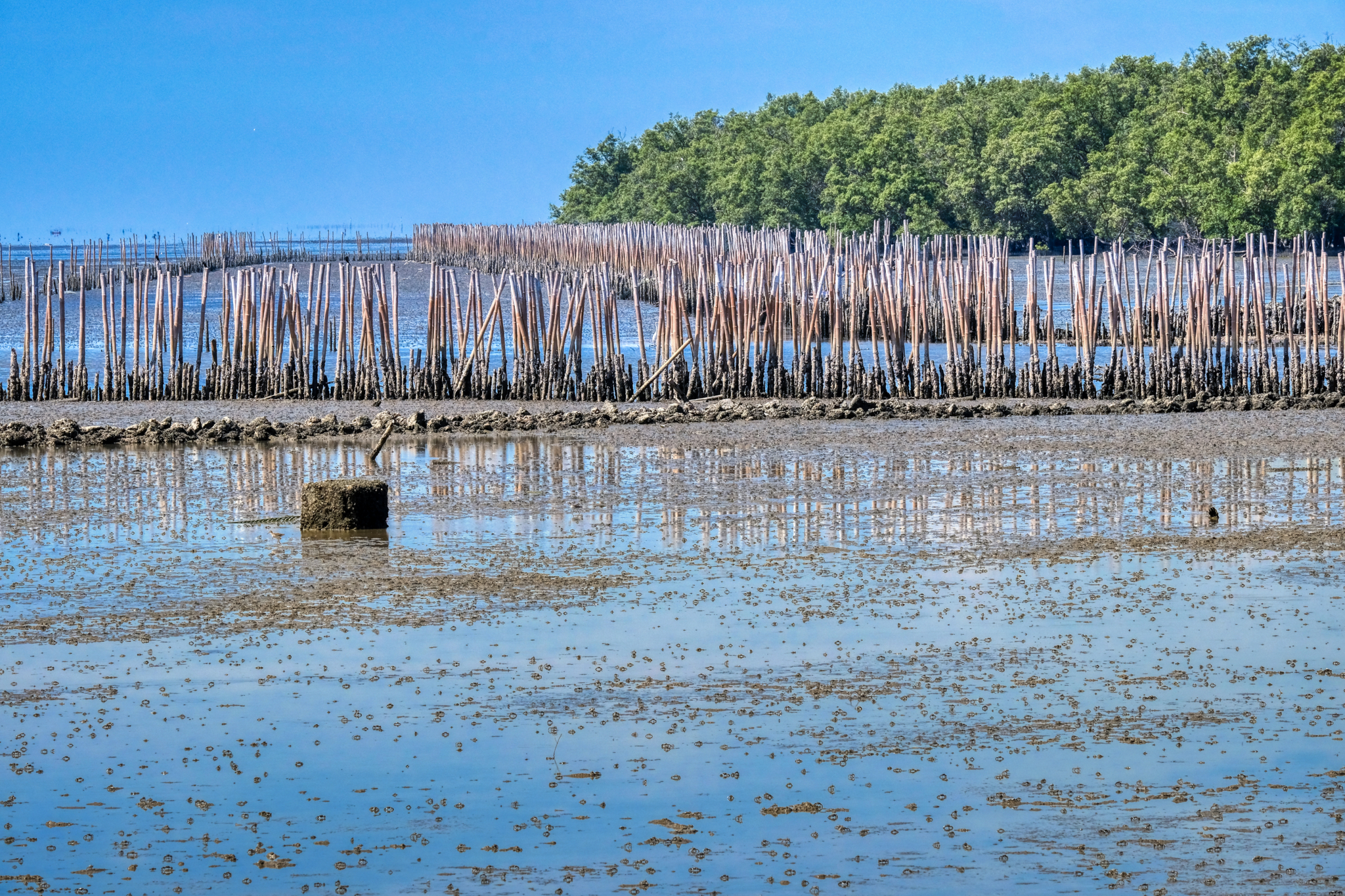 The elaborate bamboo barrier works extended for miles and miles along these mud flats . . . and off into the horizon of the Gulf of Thailand.
The elaborate bamboo barrier works extended for miles and miles along these mud flats . . . and off into the horizon of the Gulf of Thailand.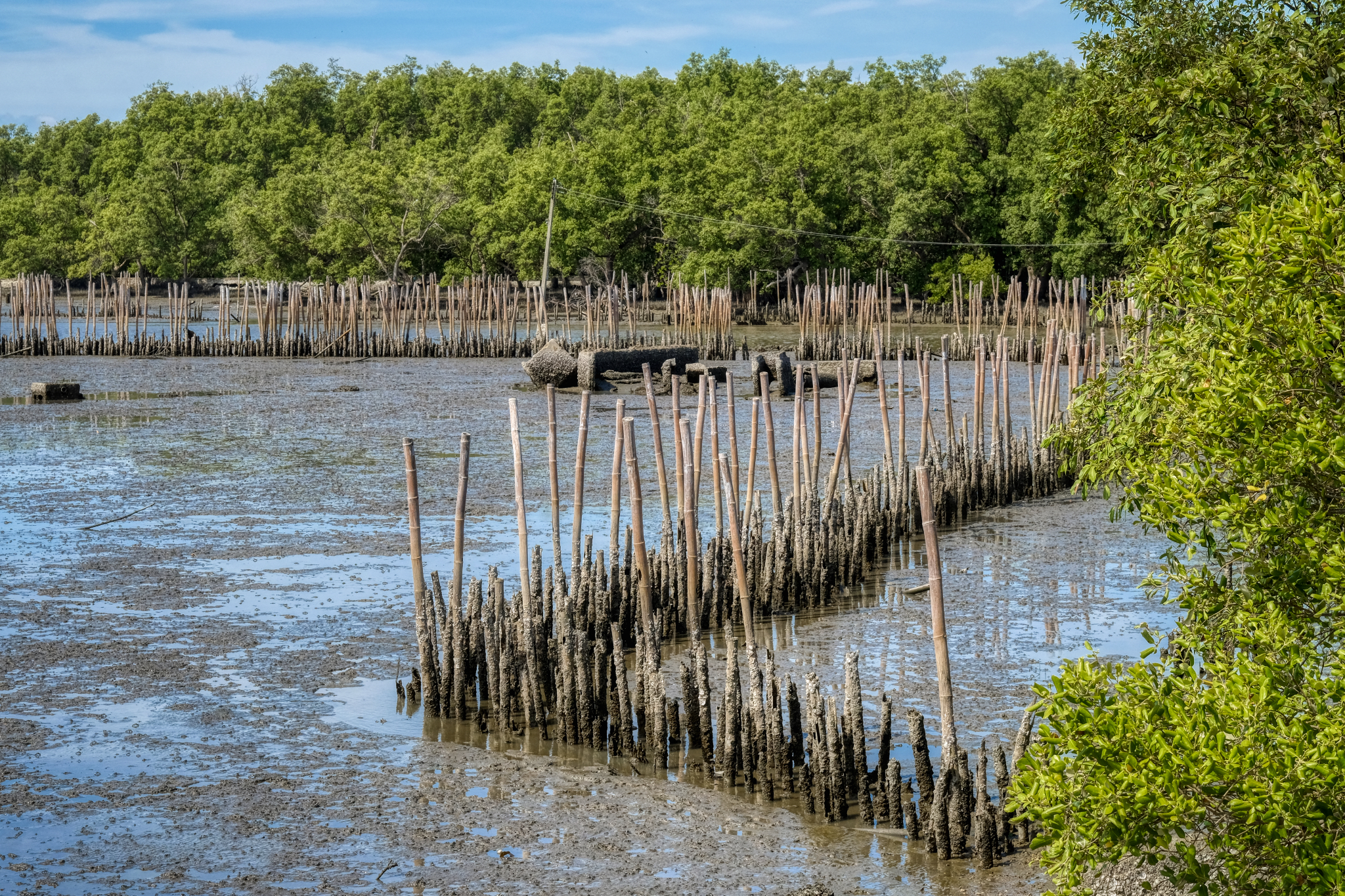 At a point of a small canal entering the mud flats there were many kinds of barrier works.
At a point of a small canal entering the mud flats there were many kinds of barrier works.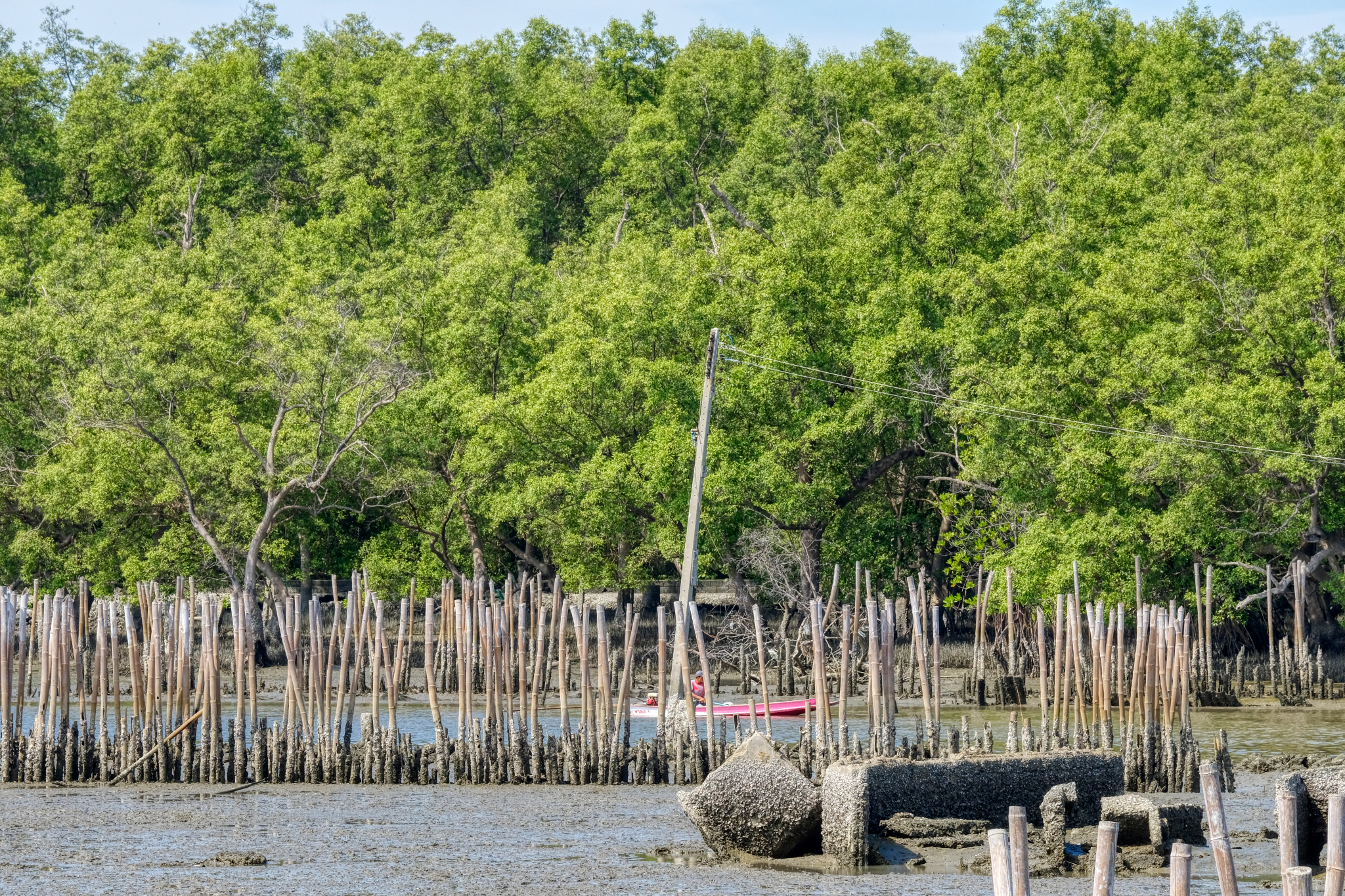 A workman out doing maintenance on the bamboo works.
A workman out doing maintenance on the bamboo works.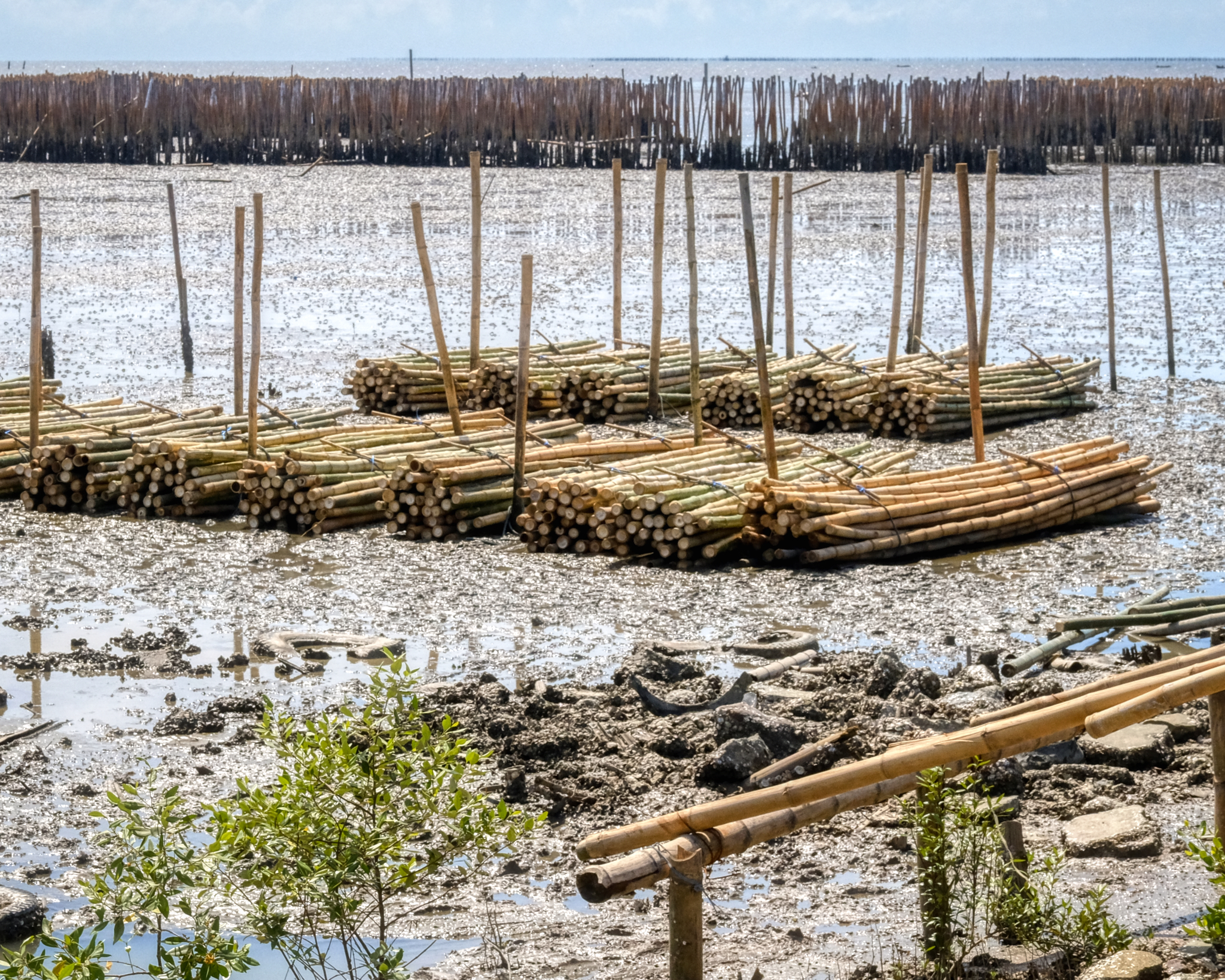 Fresh cut bamboo was being unloaded and made into rafts to bring out into the sea. This was a huge project . . .
Fresh cut bamboo was being unloaded and made into rafts to bring out into the sea. This was a huge project . . .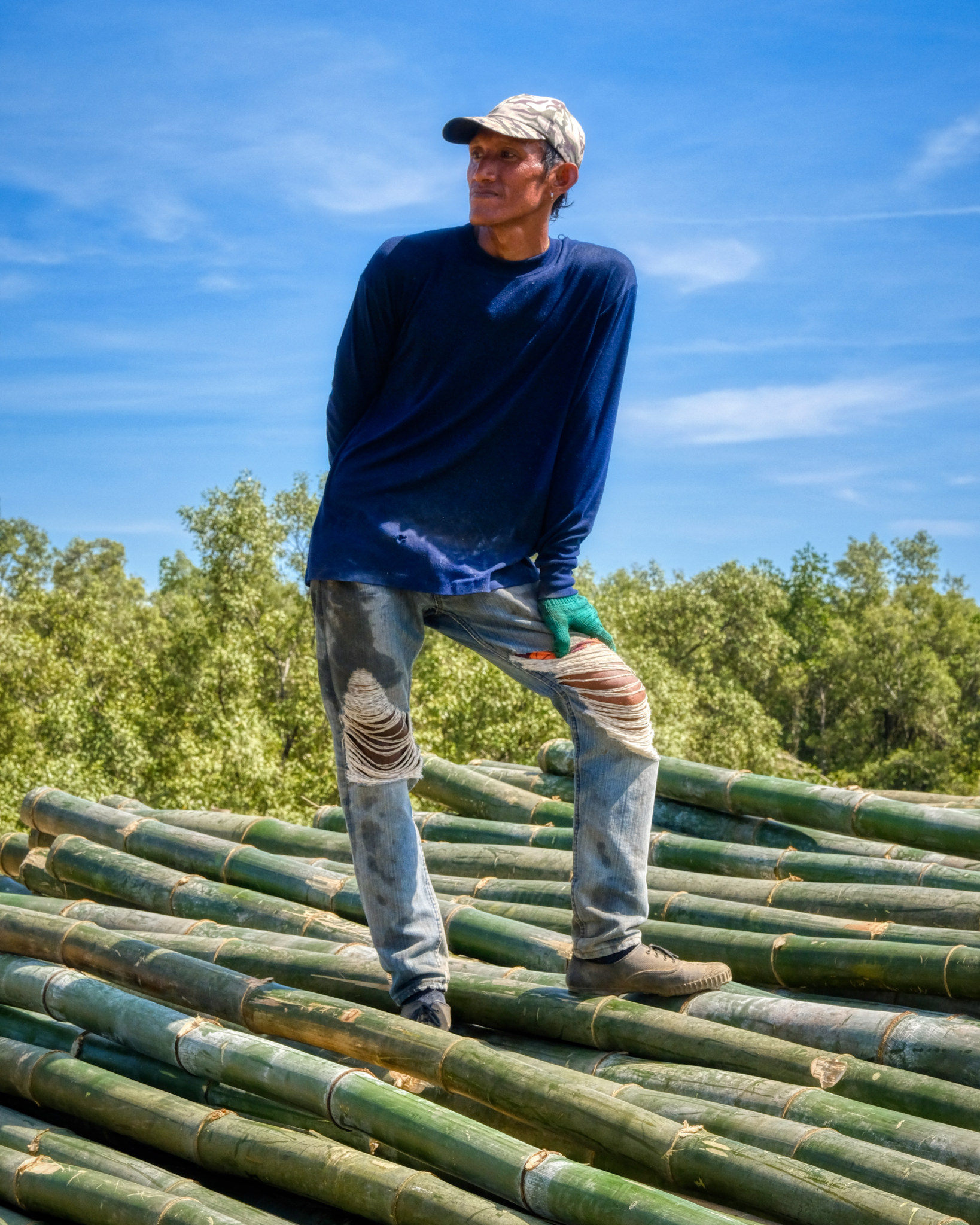 A Samut bamboo wrangler.
A Samut bamboo wrangler.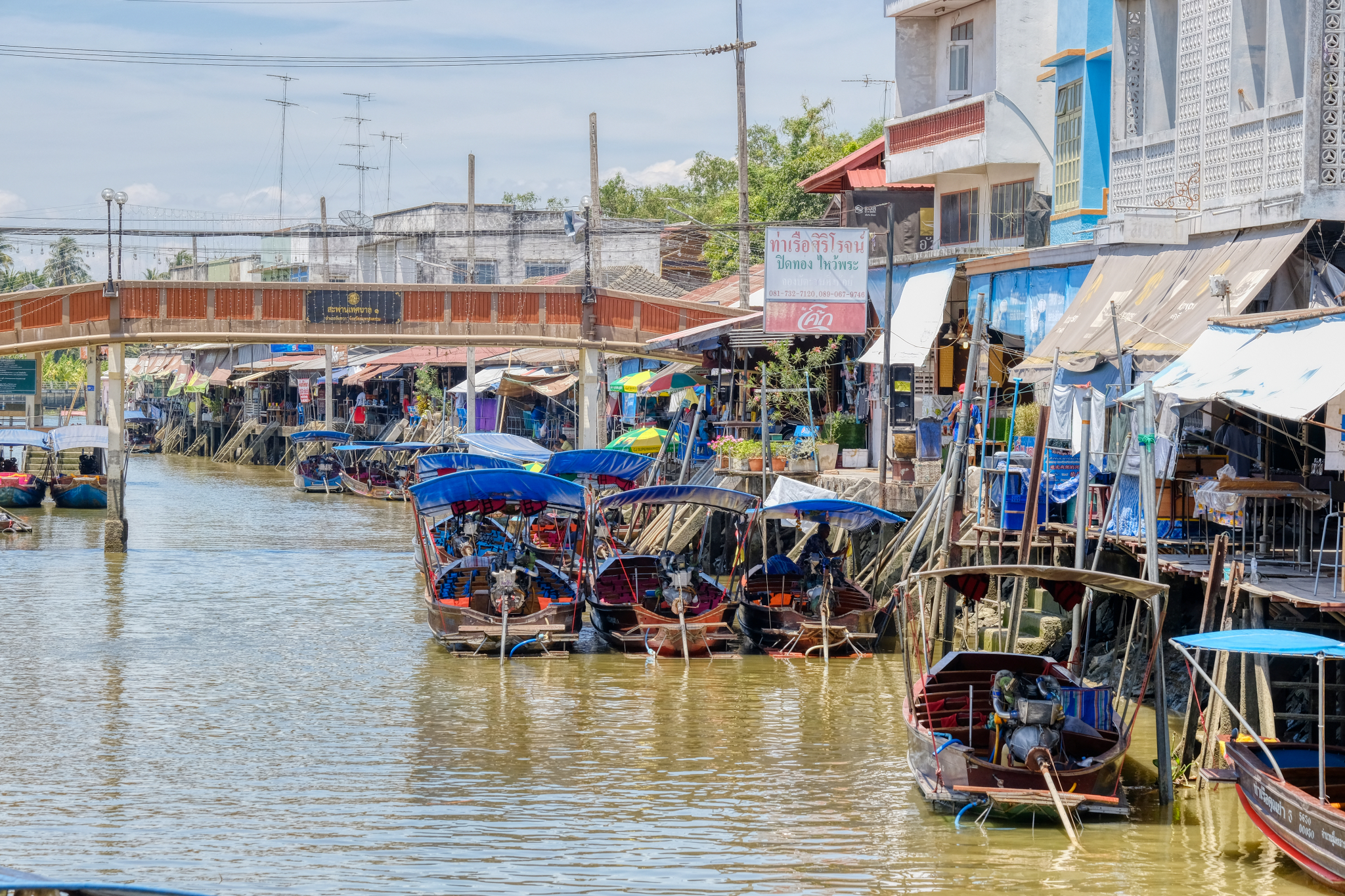 Our next stop was at the village of Amphawa, a floating market. Too much tourism has changed the feeling of this place since I last visited it nearly 20 years ago. It is still very charming . . . and visually interesting.
Our next stop was at the village of Amphawa, a floating market. Too much tourism has changed the feeling of this place since I last visited it nearly 20 years ago. It is still very charming . . . and visually interesting.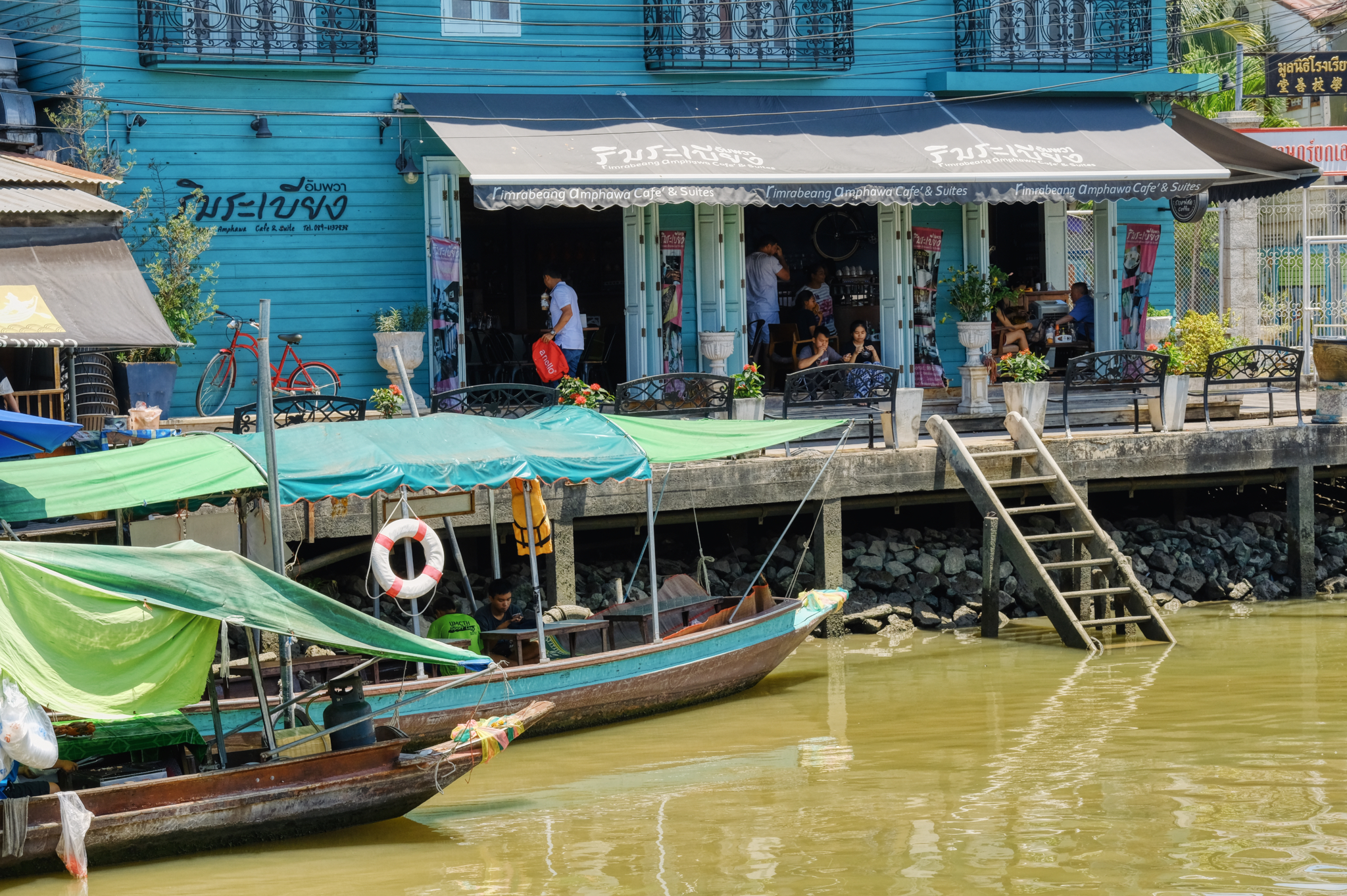 There are many very nice, upscale coffee shops and nice restaurants . . . a big change from an authentic fishing and market village.
There are many very nice, upscale coffee shops and nice restaurants . . . a big change from an authentic fishing and market village. 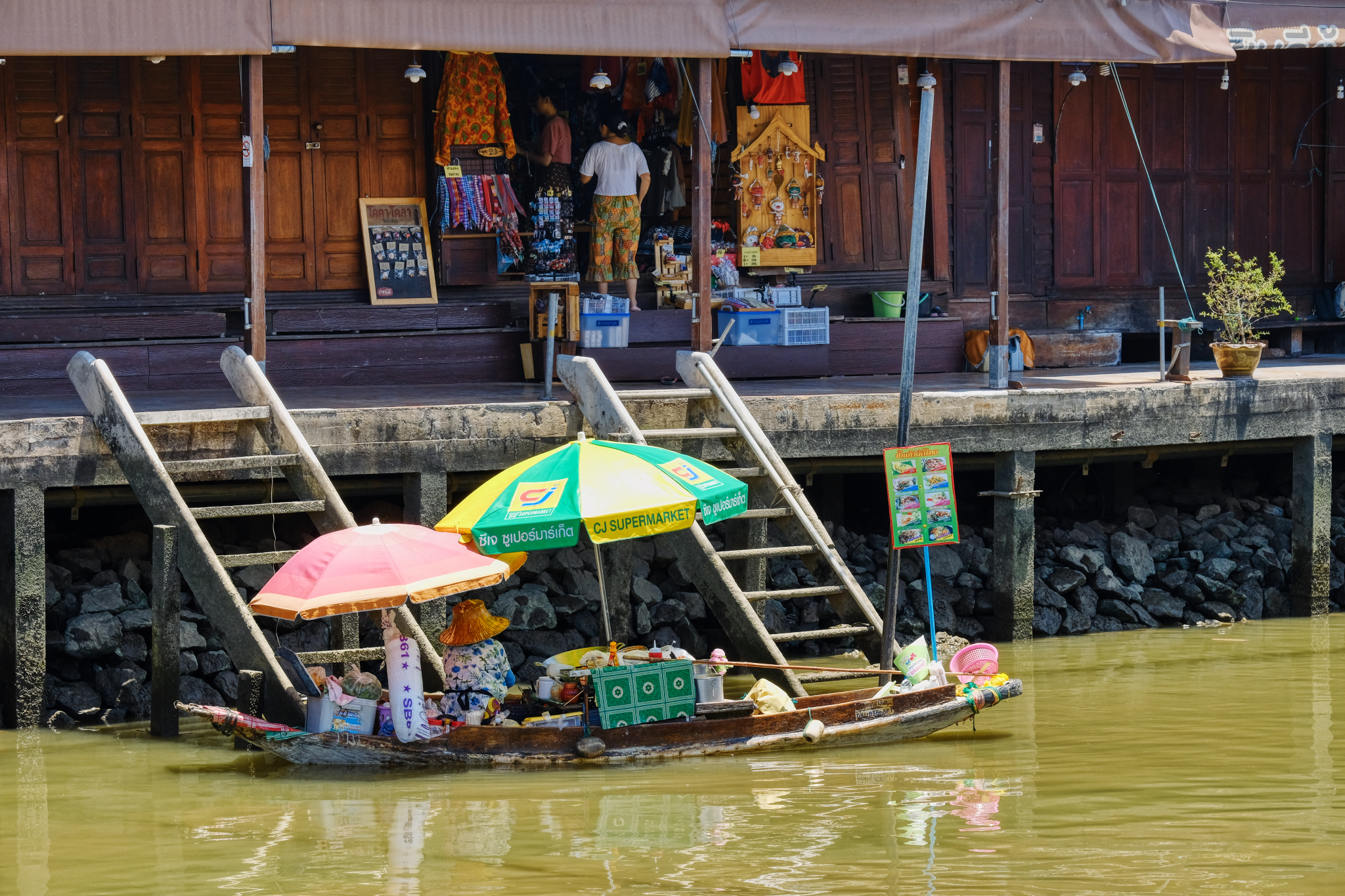 With the ambient temperature above 105(f) with high humidity, it was little wonder there were few people out and about.
With the ambient temperature above 105(f) with high humidity, it was little wonder there were few people out and about.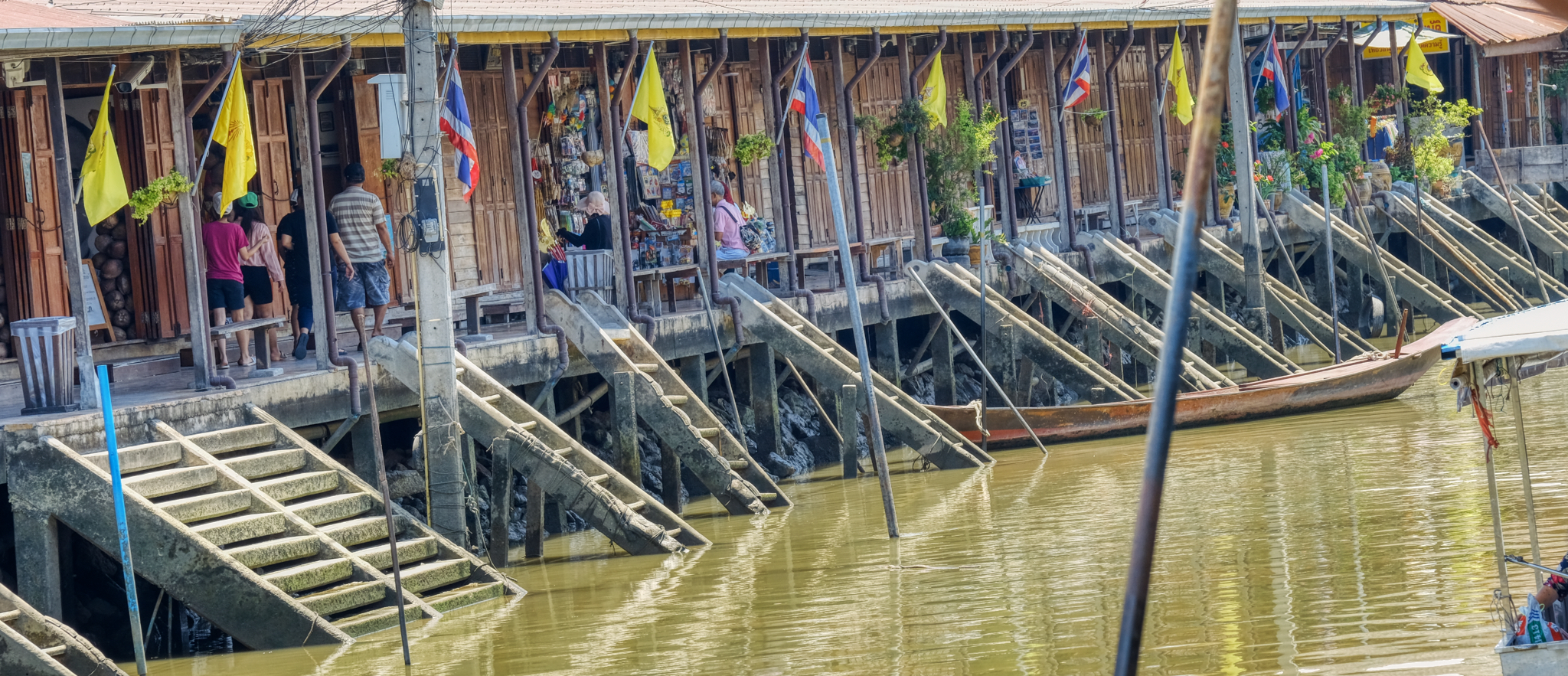 The repeating patterns of the klong access steps made for a fascinating study.
The repeating patterns of the klong access steps made for a fascinating study.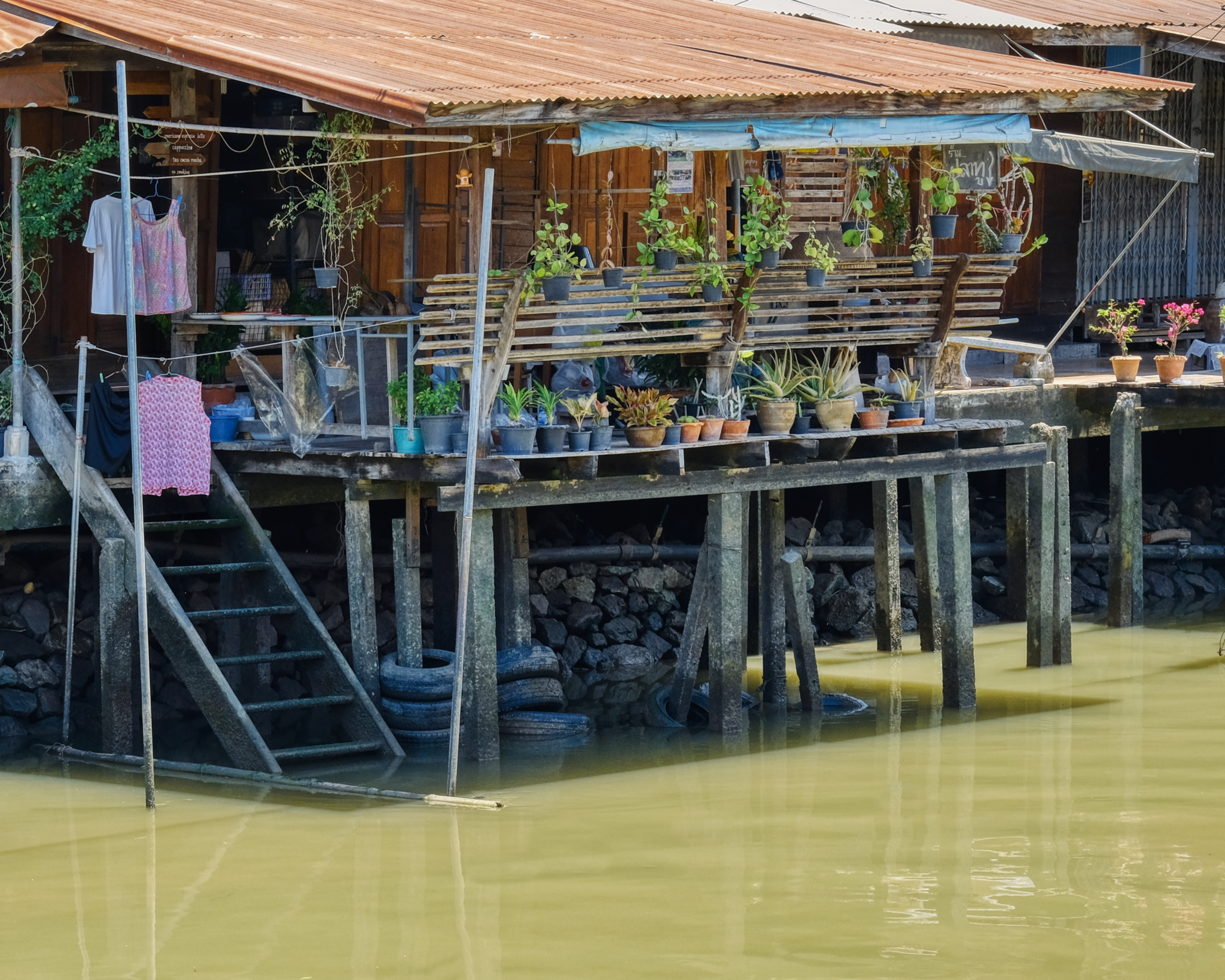 Life along the canal (klong) . . .
Life along the canal (klong) . . . Swimming to beat the heat? No . . . fishing for bottom feeders with a long-handled net.
Swimming to beat the heat? No . . . fishing for bottom feeders with a long-handled net. With few tourists around, and crushing heat, the boat vendors sat in quiet repose . . . waiting for a sale.
With few tourists around, and crushing heat, the boat vendors sat in quiet repose . . . waiting for a sale.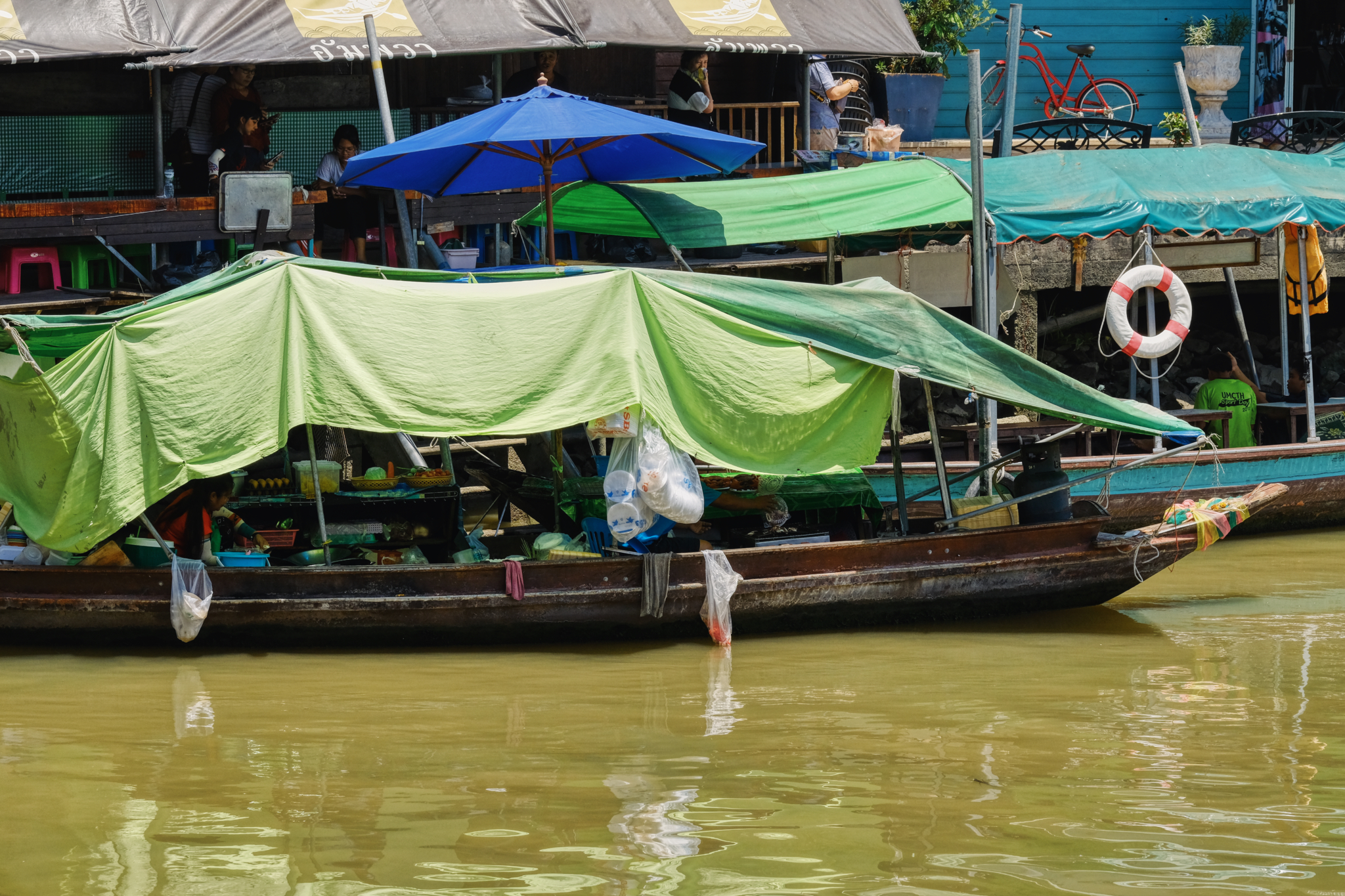 When the canal is full of tourists in their small boats, these floating restaurants serve the water traffic.
When the canal is full of tourists in their small boats, these floating restaurants serve the water traffic.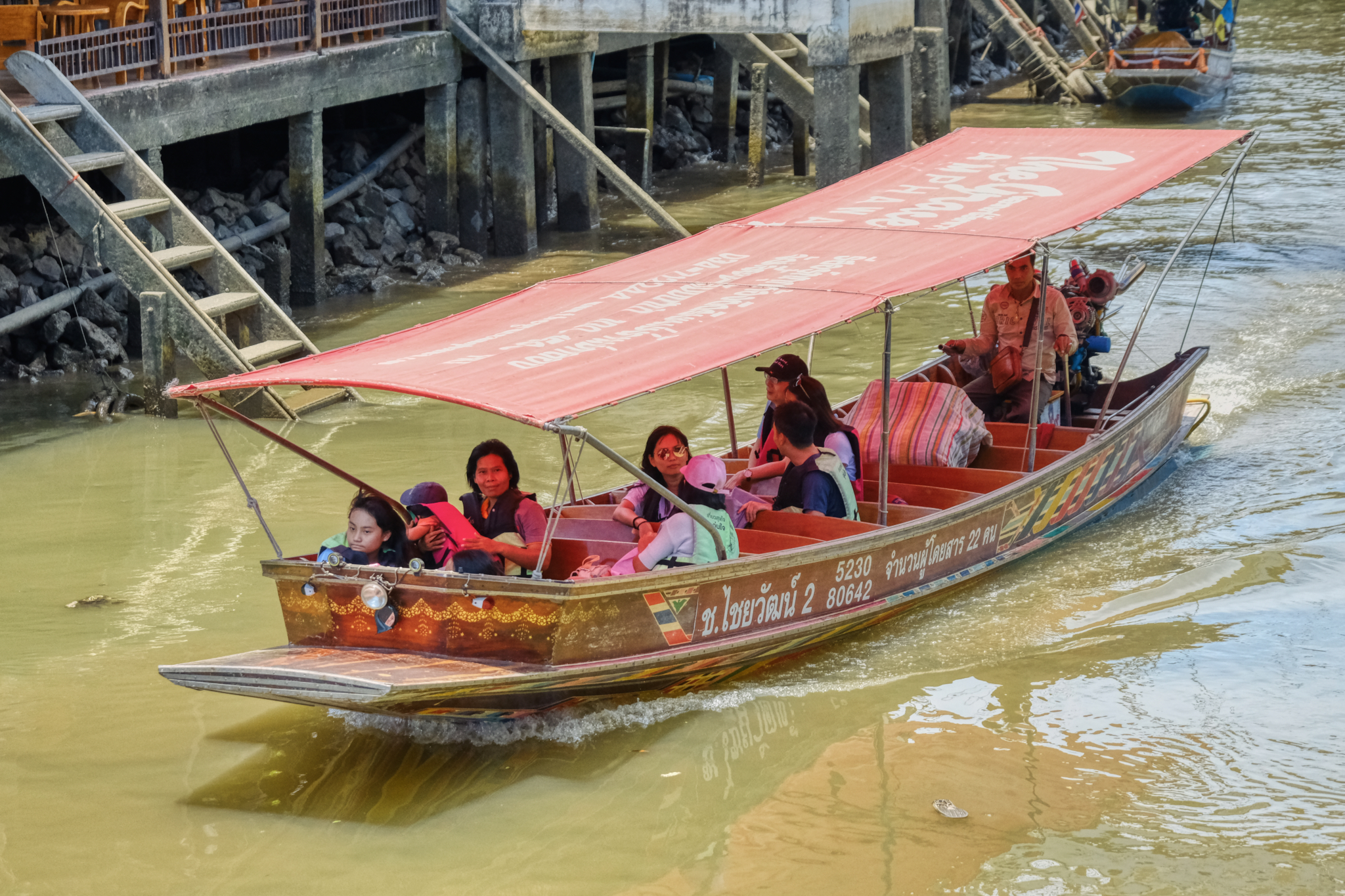 This was the only tourist boat we say all afternoon . . . and they looked HOT!
This was the only tourist boat we say all afternoon . . . and they looked HOT!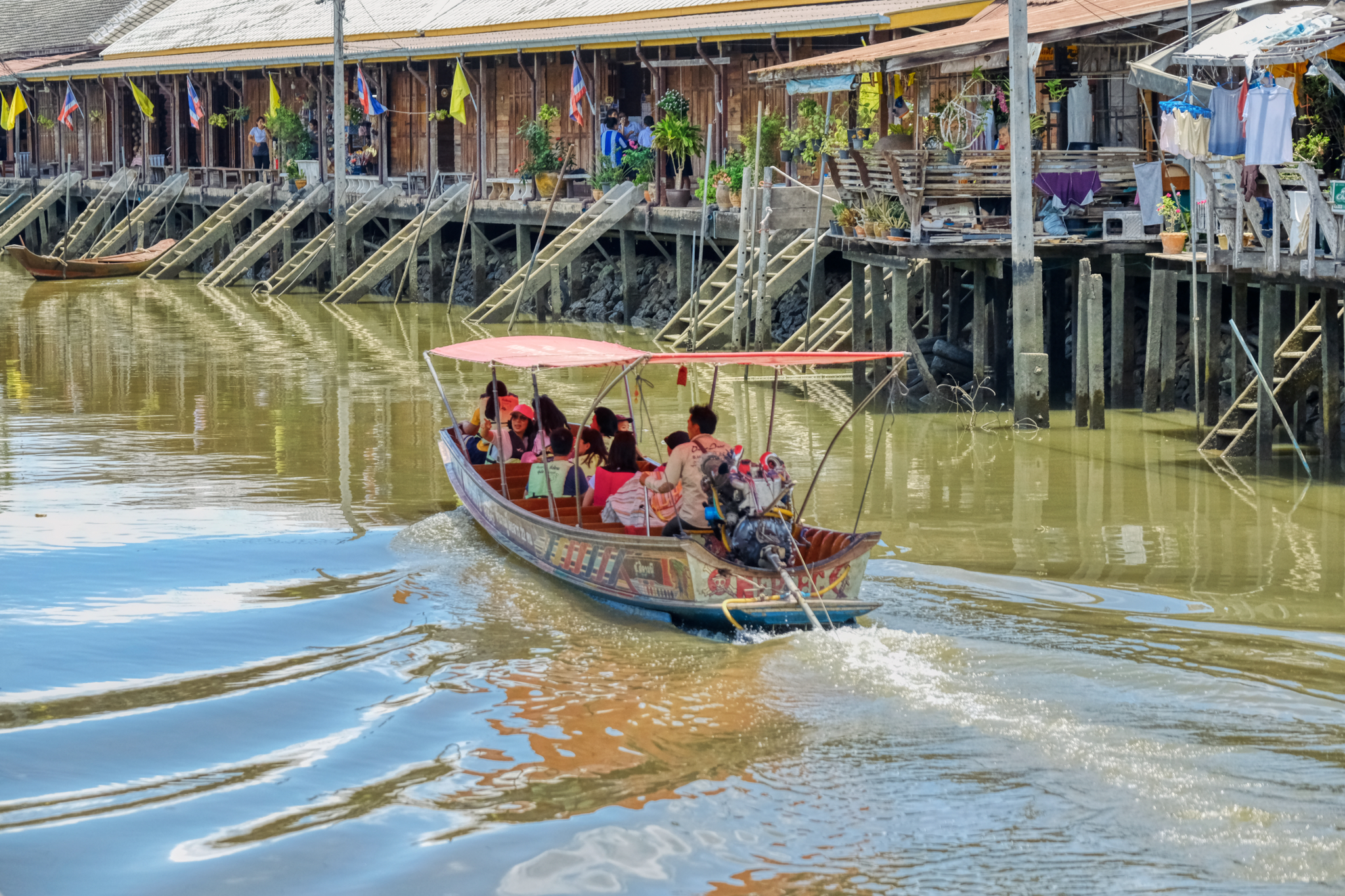 In some respects, this might be the best time of year to visit Amphawa . . . the rest of the year it is overcrowded with tourists. They had the place to themselves.
In some respects, this might be the best time of year to visit Amphawa . . . the rest of the year it is overcrowded with tourists. They had the place to themselves.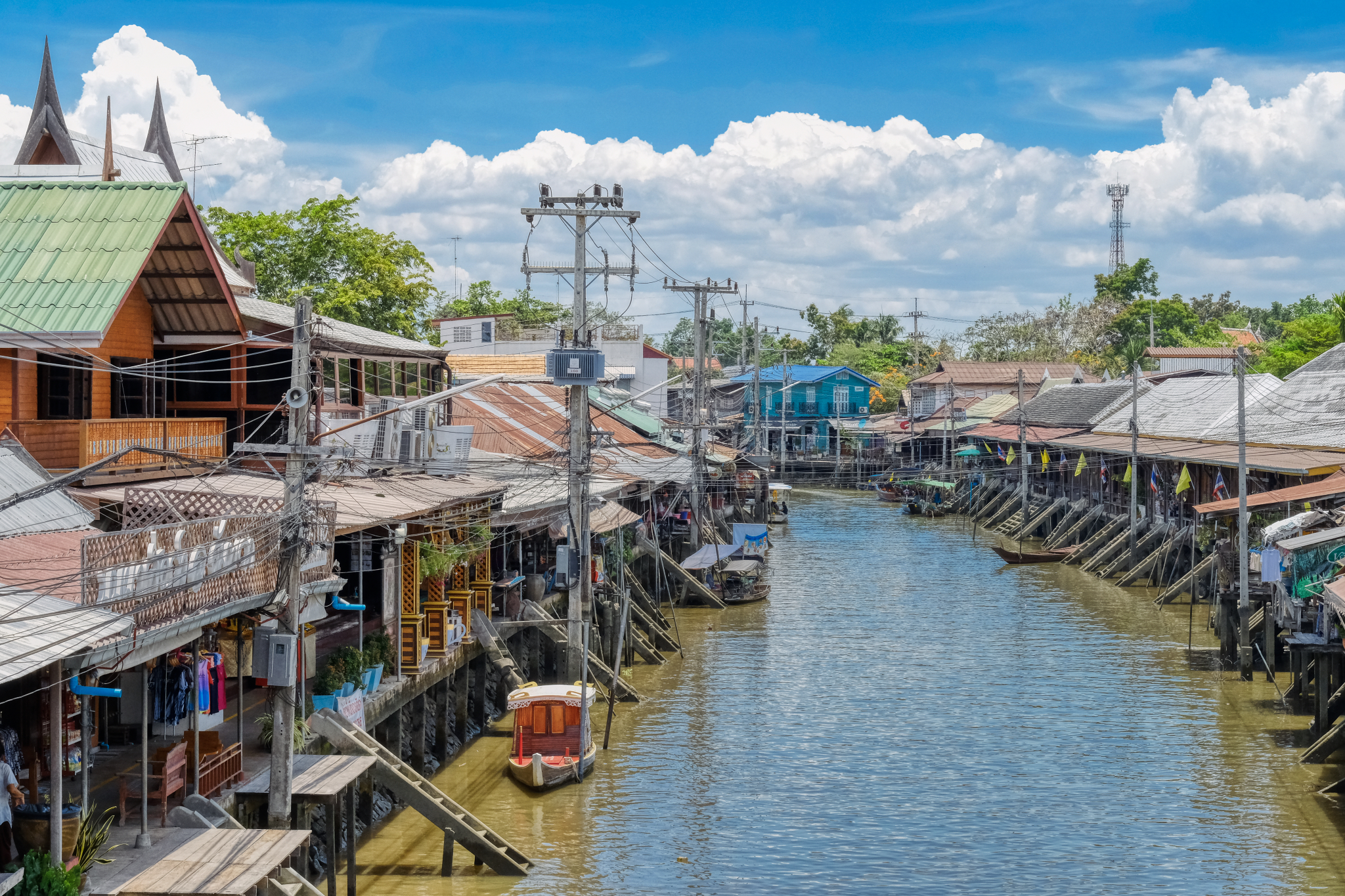 Standing on a bridge over the canal . . and a view one way . . . and . . .
Standing on a bridge over the canal . . and a view one way . . . and . . .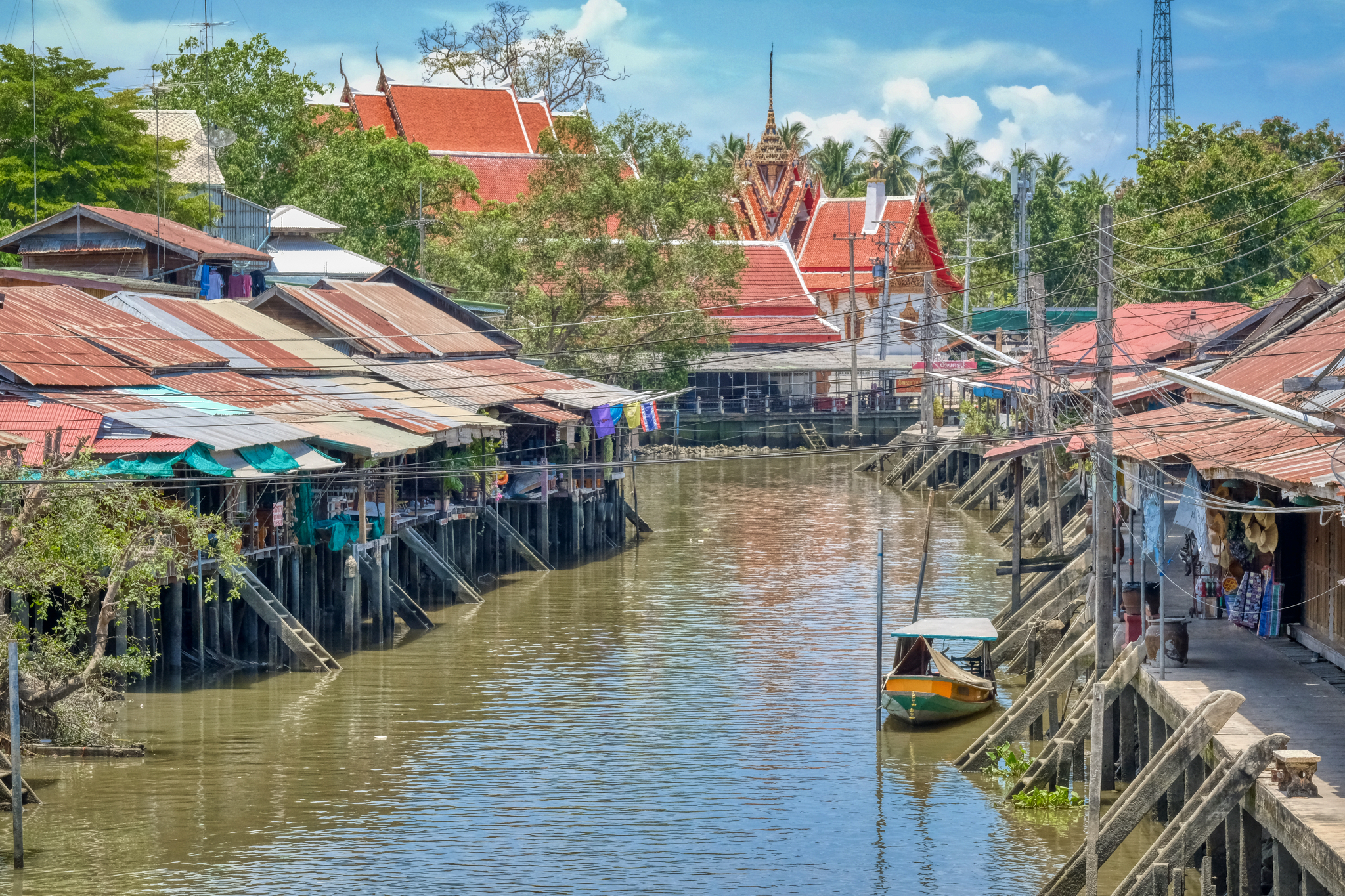 . . . the view in the other direction toward a Buddhist temple (wat).
. . . the view in the other direction toward a Buddhist temple (wat).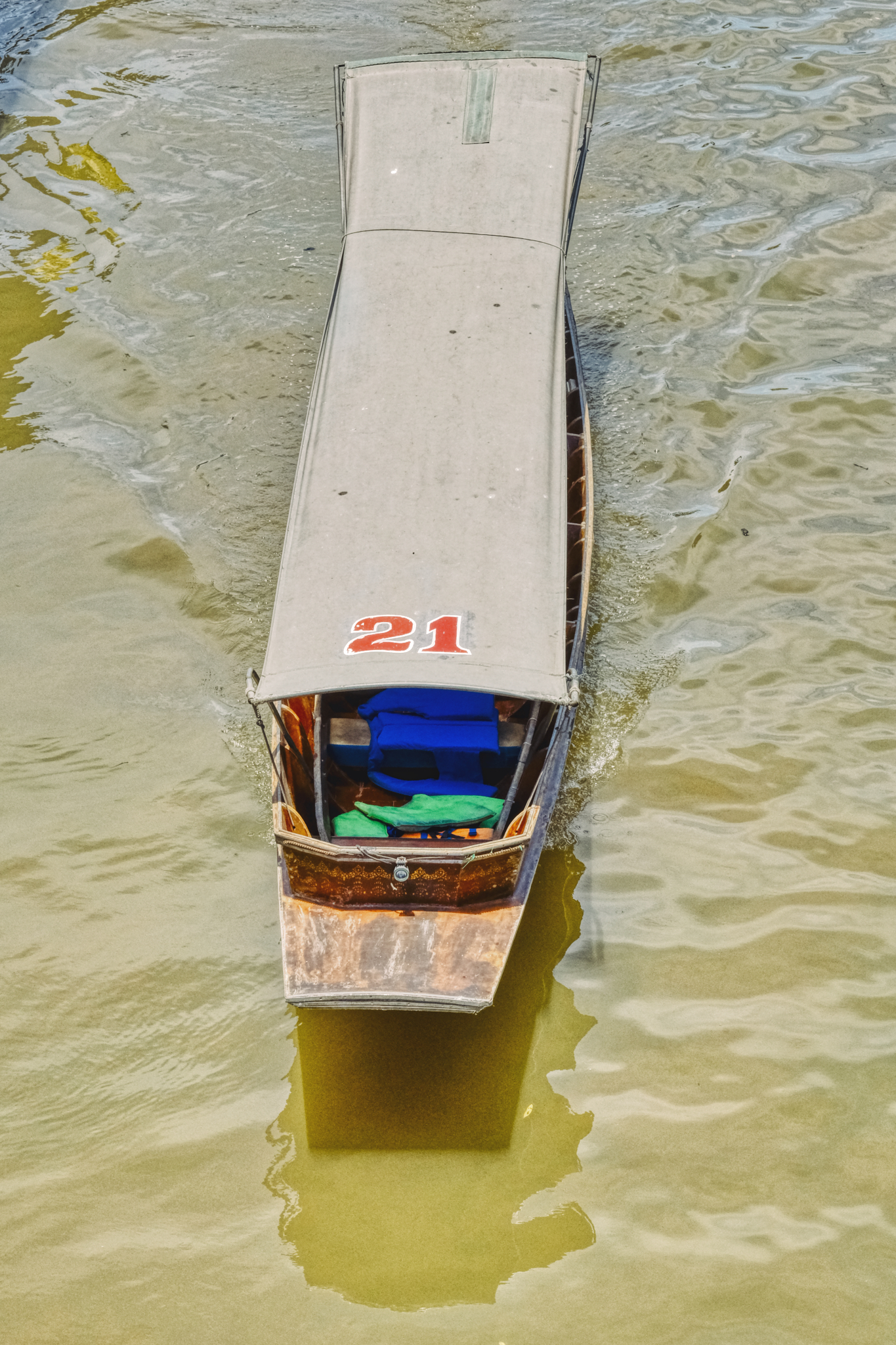 A tourist boat cruising for a fare . . . unsuccessfully.
A tourist boat cruising for a fare . . . unsuccessfully.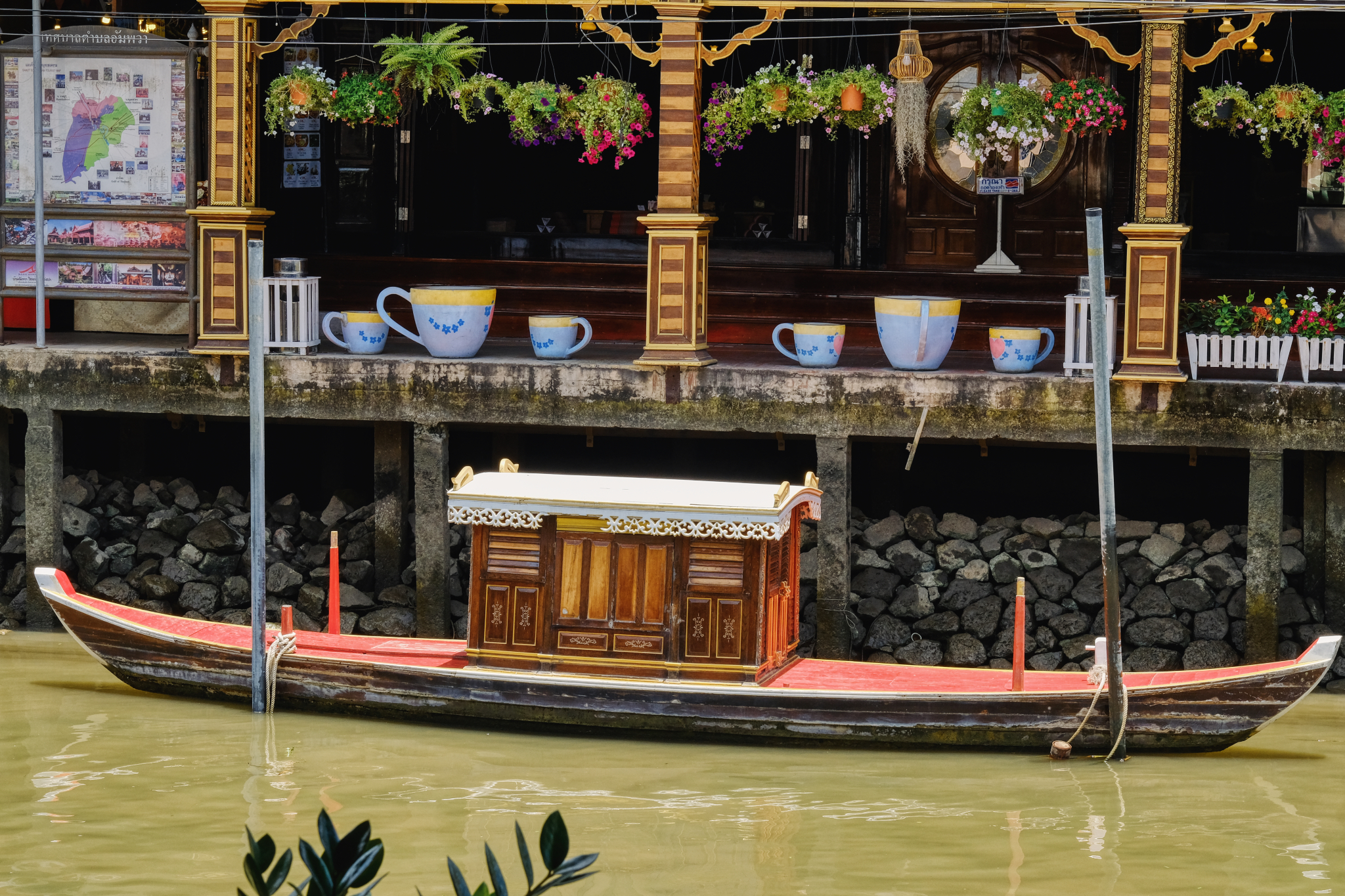 That looks inviting. We went over to this marvelous Old Thai style coffee house for some ice coffee and cold water.
That looks inviting. We went over to this marvelous Old Thai style coffee house for some ice coffee and cold water.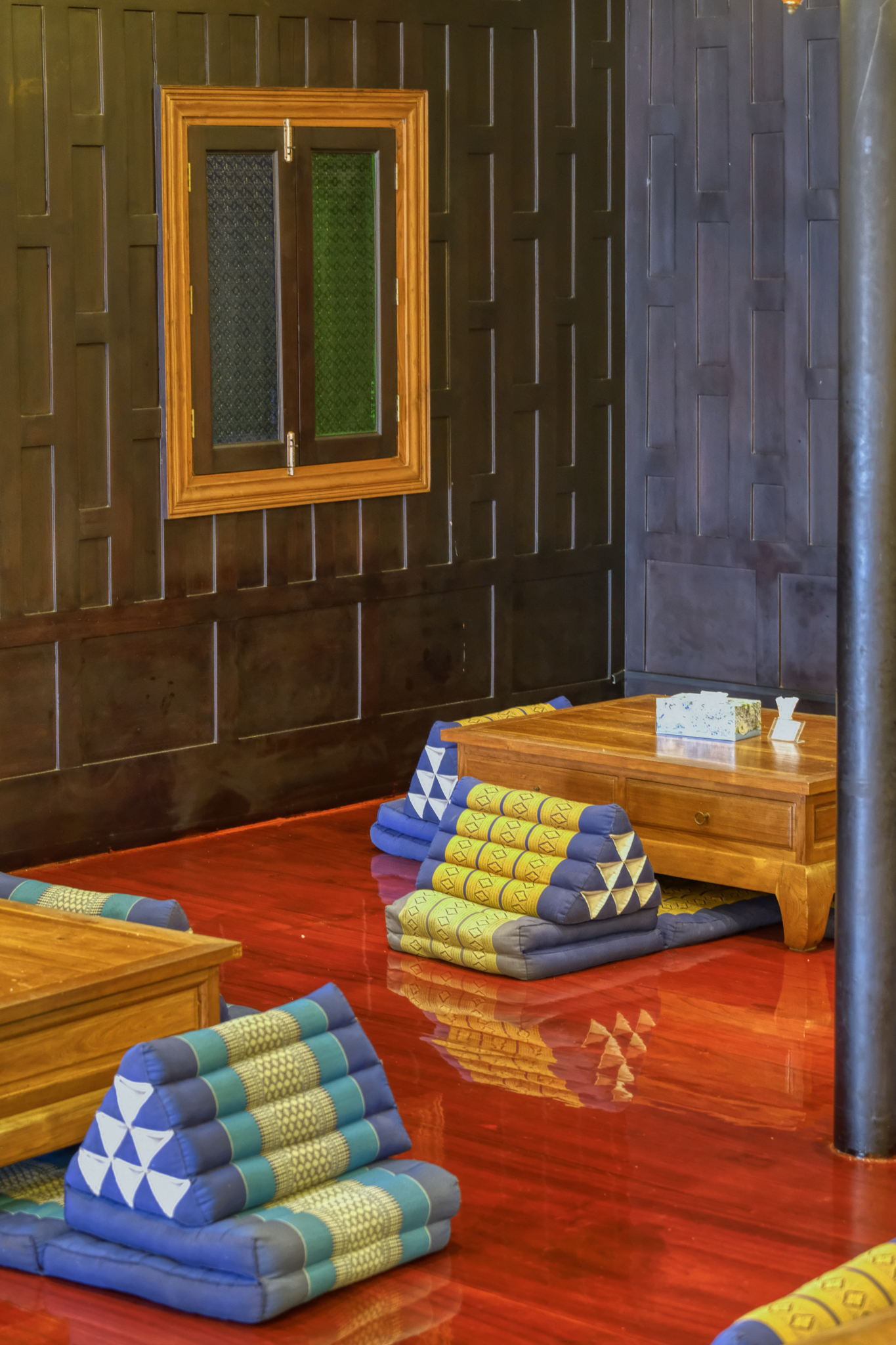 Such a beautiful place to rest, replenish, hydrate, and sit in front of some fans.
Such a beautiful place to rest, replenish, hydrate, and sit in front of some fans. Old Thai style wood panels are so beautiful.
Old Thai style wood panels are so beautiful.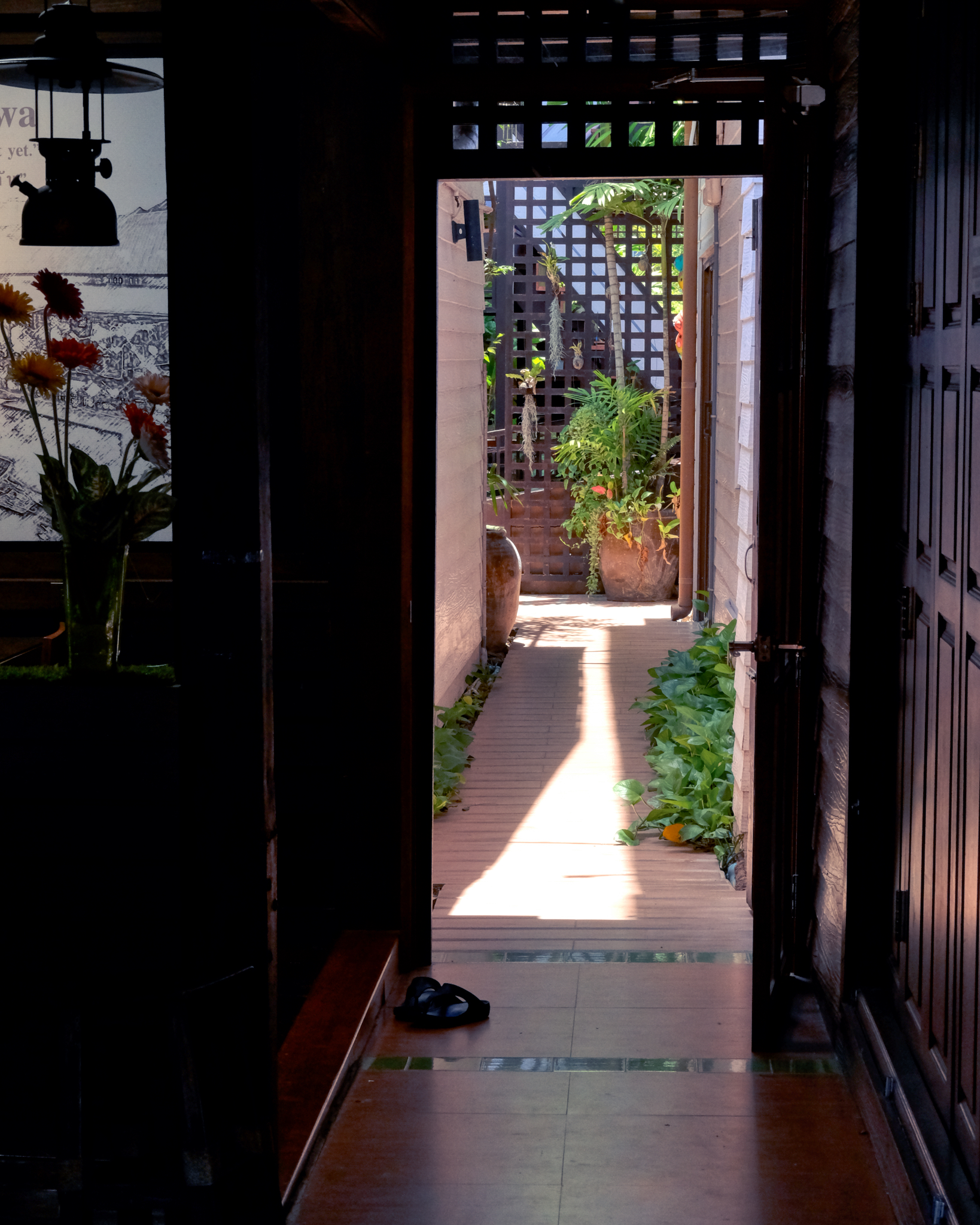 After a break we walked along he wooden boardwalks and secretly peaked into the houses. Such serene stillness in the oppressive heat and humidity.
After a break we walked along he wooden boardwalks and secretly peaked into the houses. Such serene stillness in the oppressive heat and humidity.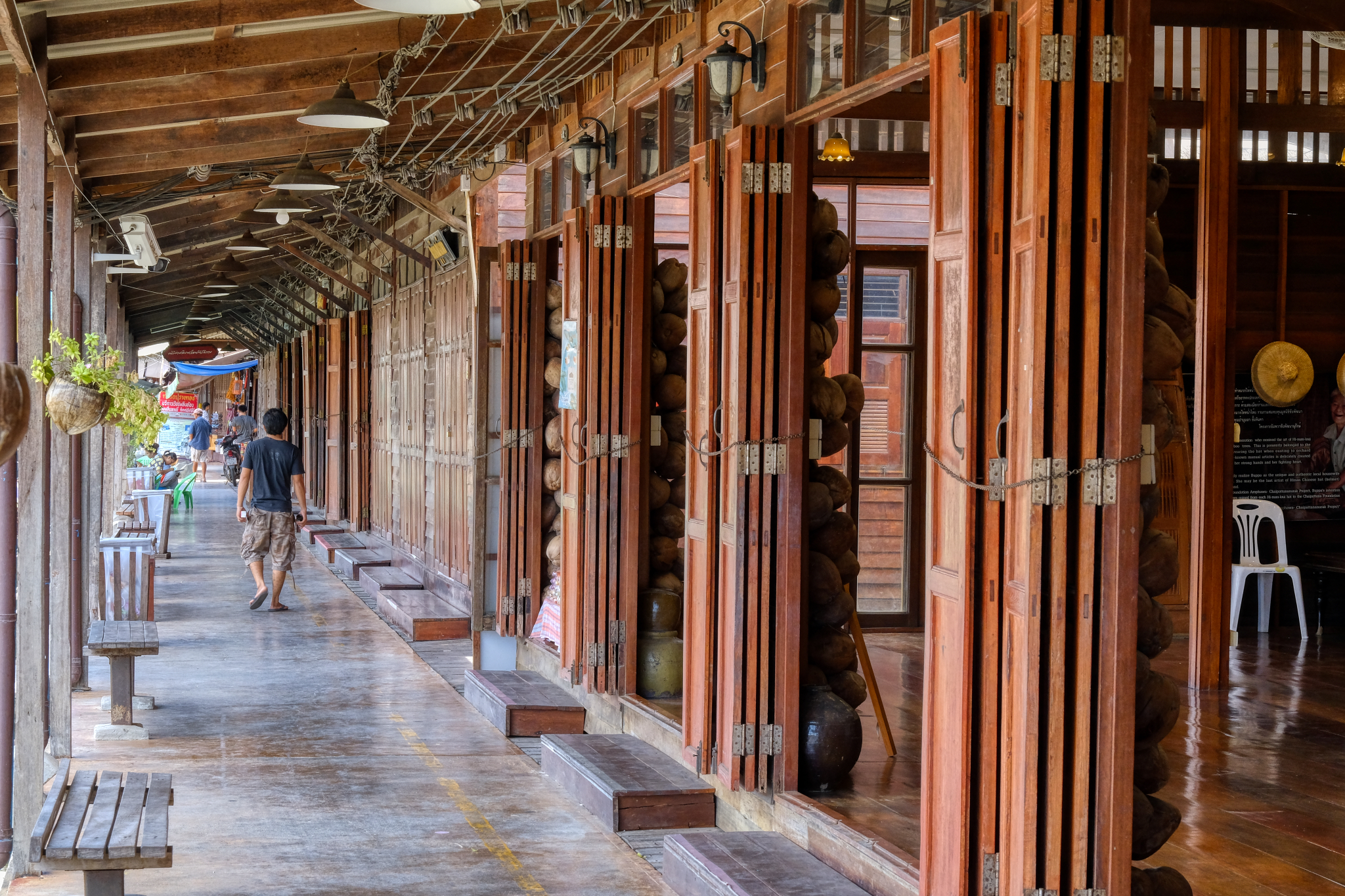 We took our time meandering along the shops . . . and this nice museum of the history of canal life.
We took our time meandering along the shops . . . and this nice museum of the history of canal life.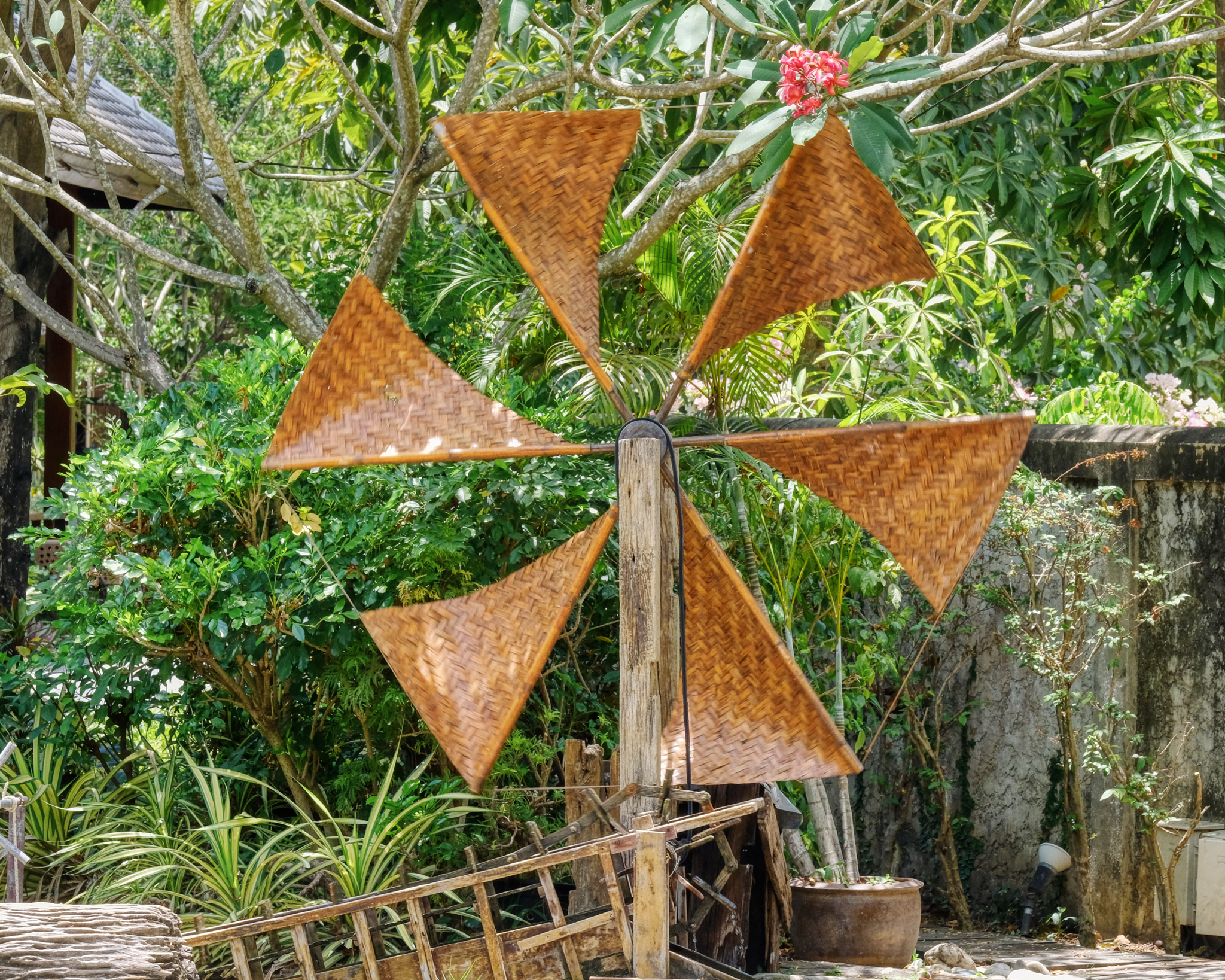 A spinning windmill behind the museum.
A spinning windmill behind the museum.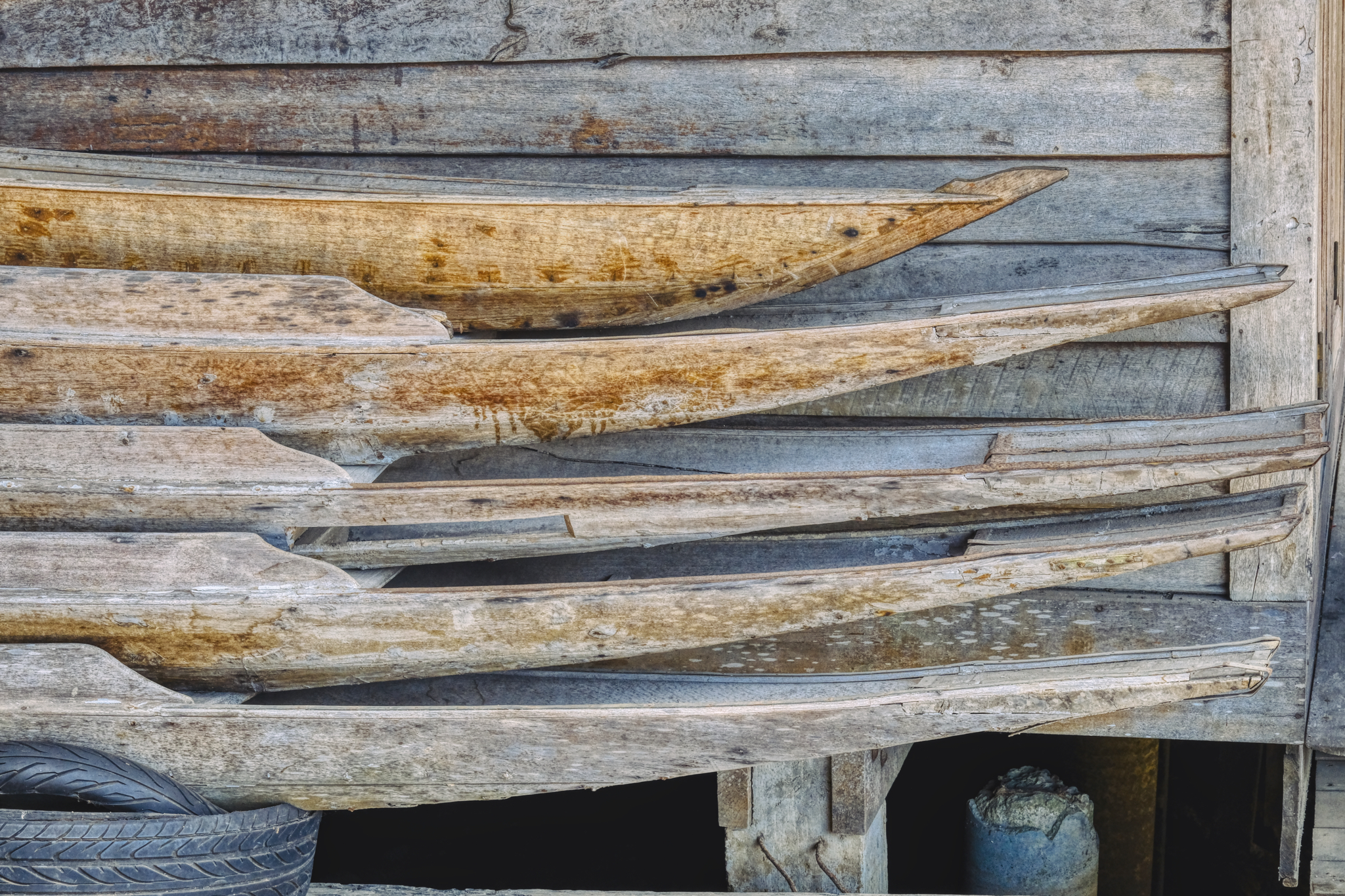 Antique canoes stacked along side the museum.
Antique canoes stacked along side the museum.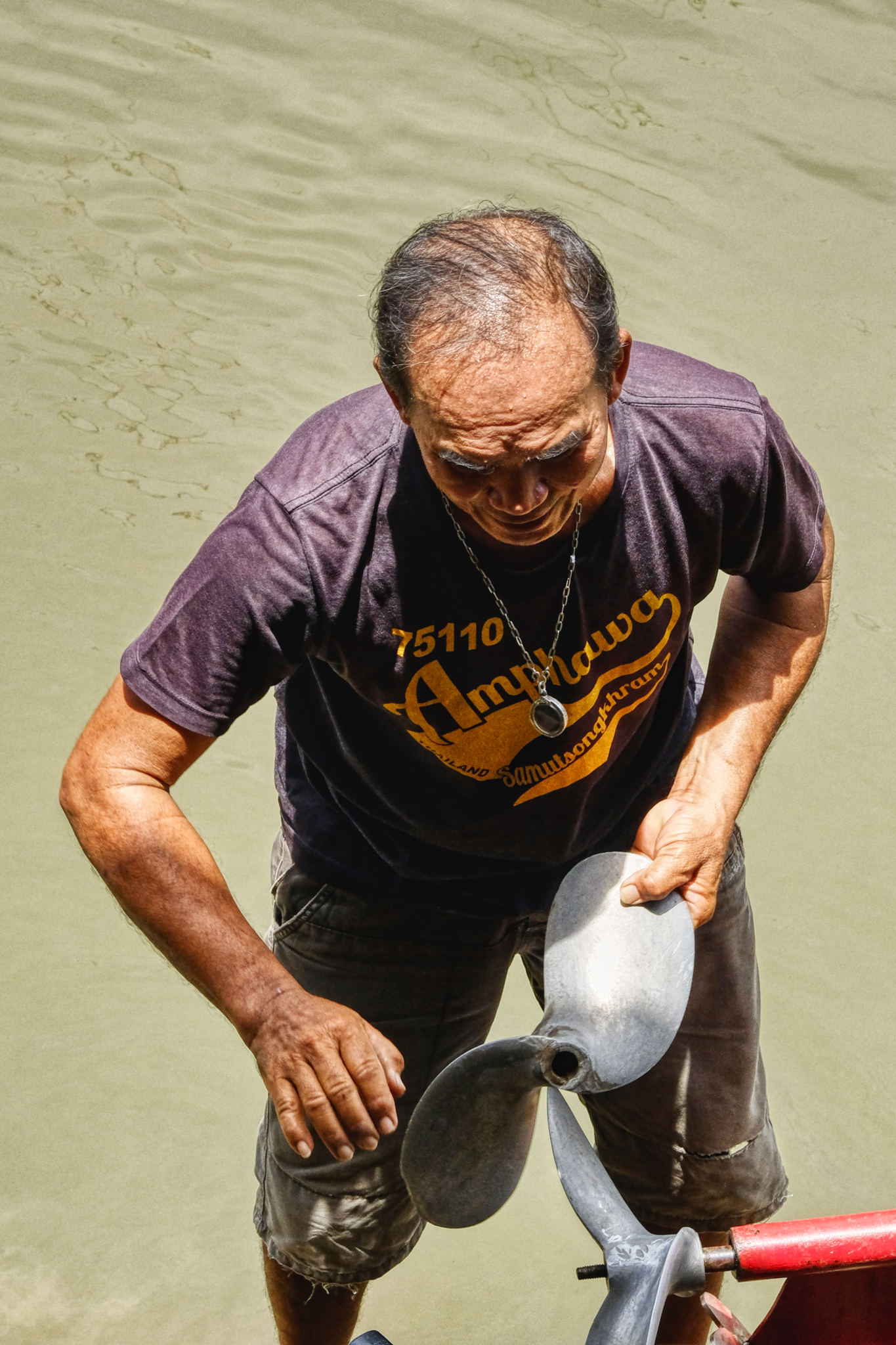 Even as hot as it was, the propeller still needed repairing.
Even as hot as it was, the propeller still needed repairing.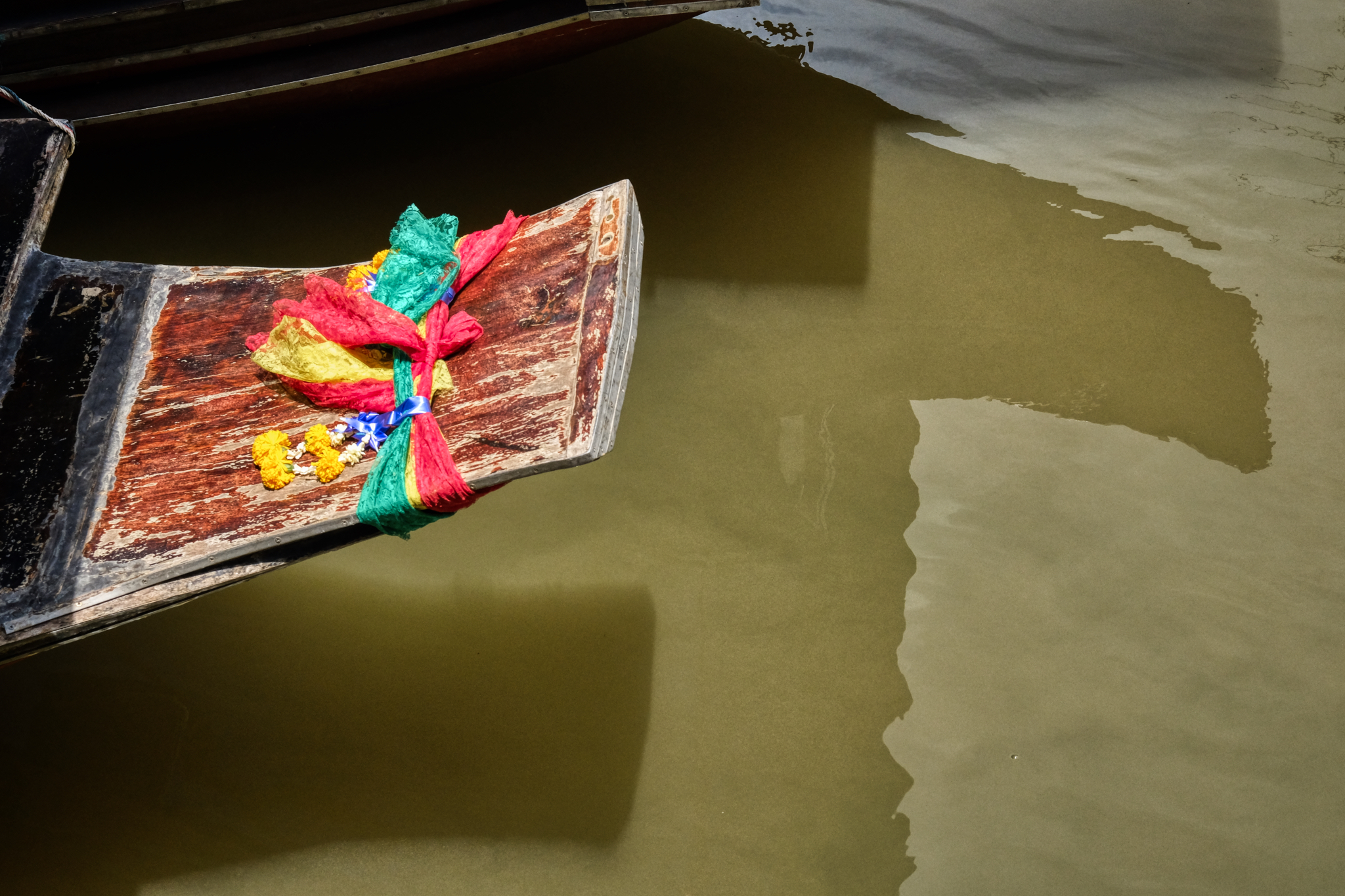 The tourist boas were beautifully decorated . . . in hopes of attracting business . . . which never came on this scorching day.
The tourist boas were beautifully decorated . . . in hopes of attracting business . . . which never came on this scorching day. The ladies in their food stall boats congregated to swat flies and swap lies, as they say. Not much else to do.
The ladies in their food stall boats congregated to swat flies and swap lies, as they say. Not much else to do.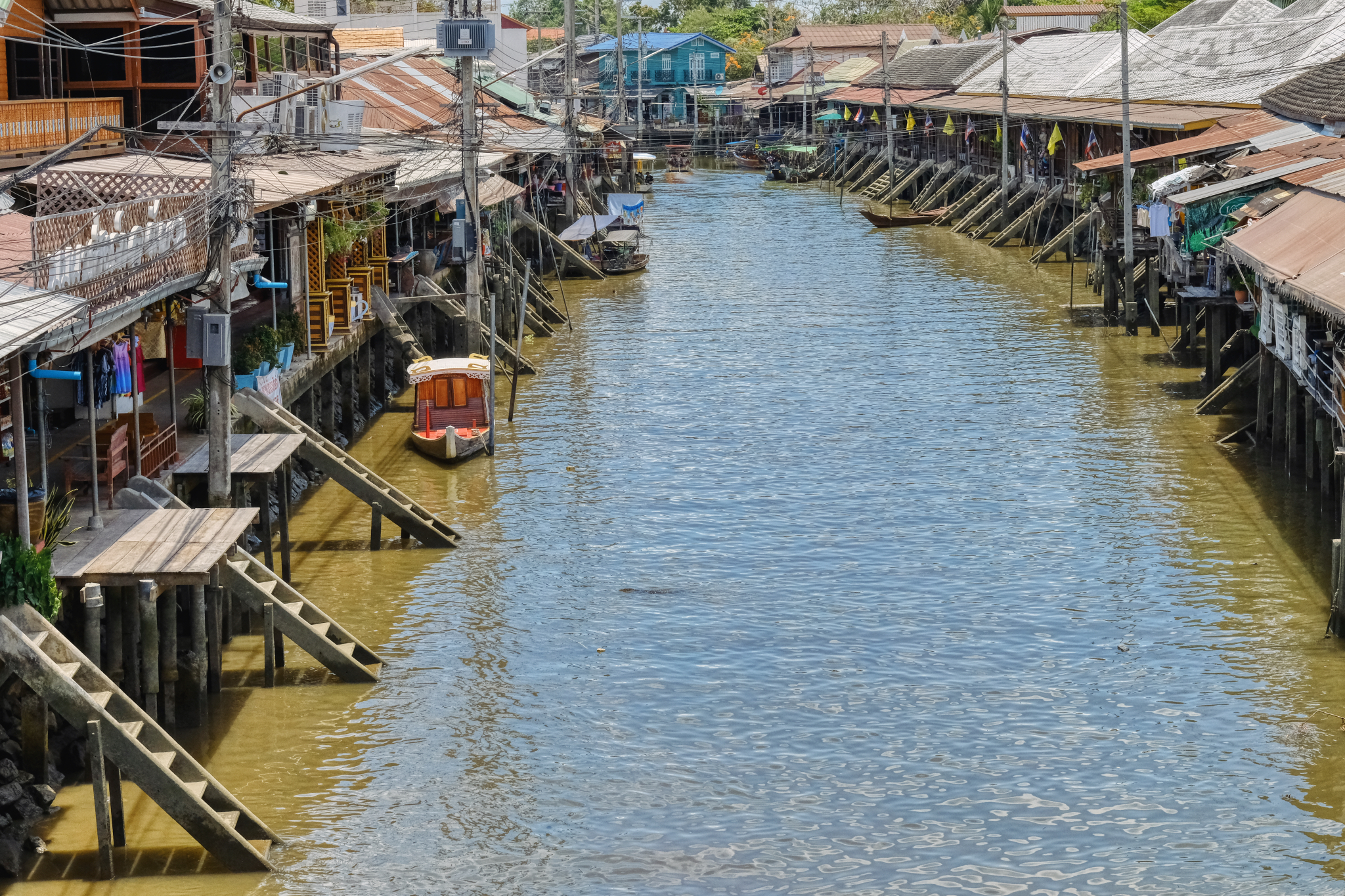 Back over the bridge toward the car. The hot day nearly over . . . the car air-conditioner is calling.
Back over the bridge toward the car. The hot day nearly over . . . the car air-conditioner is calling.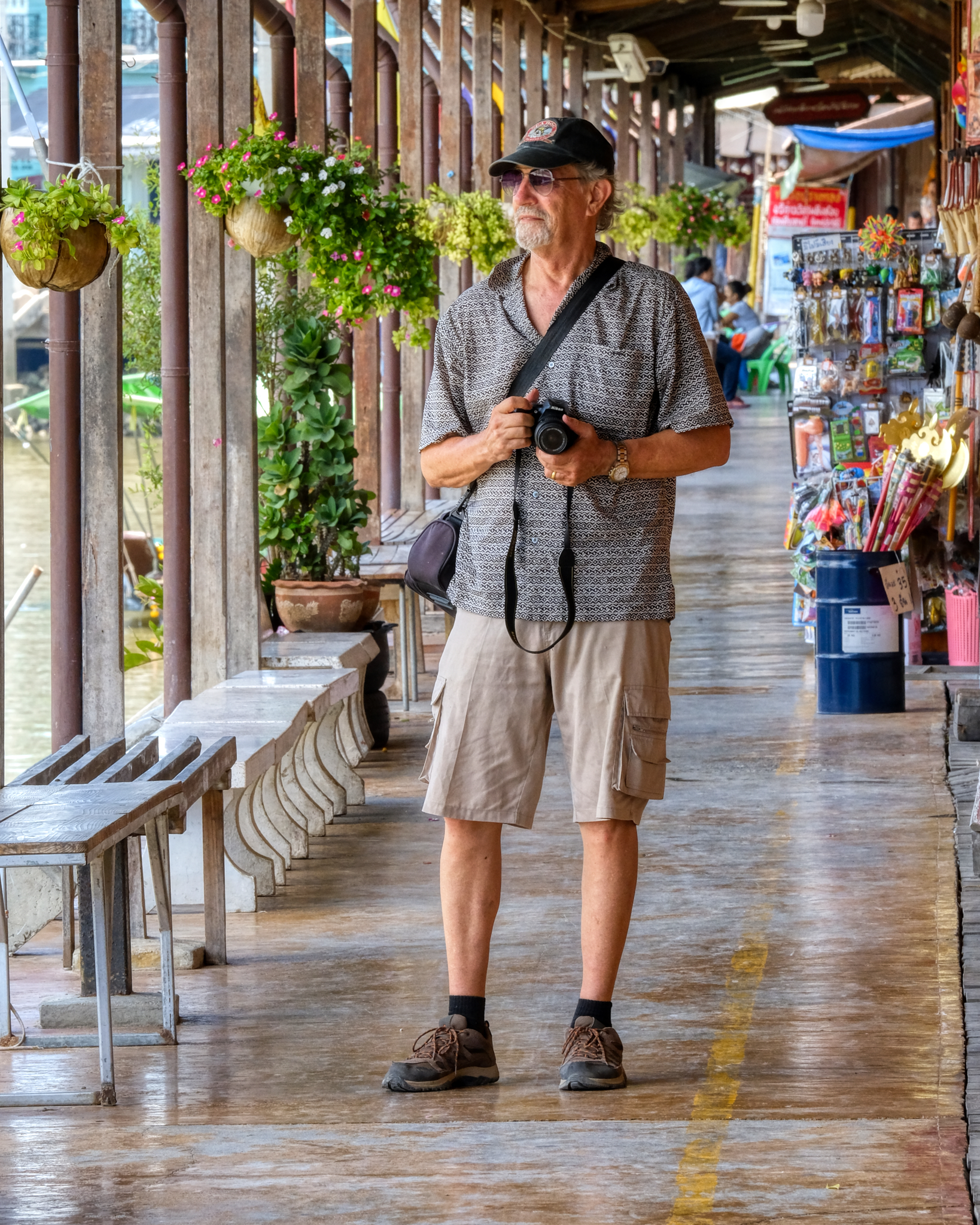 My friend John always on the look out for an amazing image.
My friend John always on the look out for an amazing image. We descended down into the sea of sun parasols and the tourist curios.
We descended down into the sea of sun parasols and the tourist curios.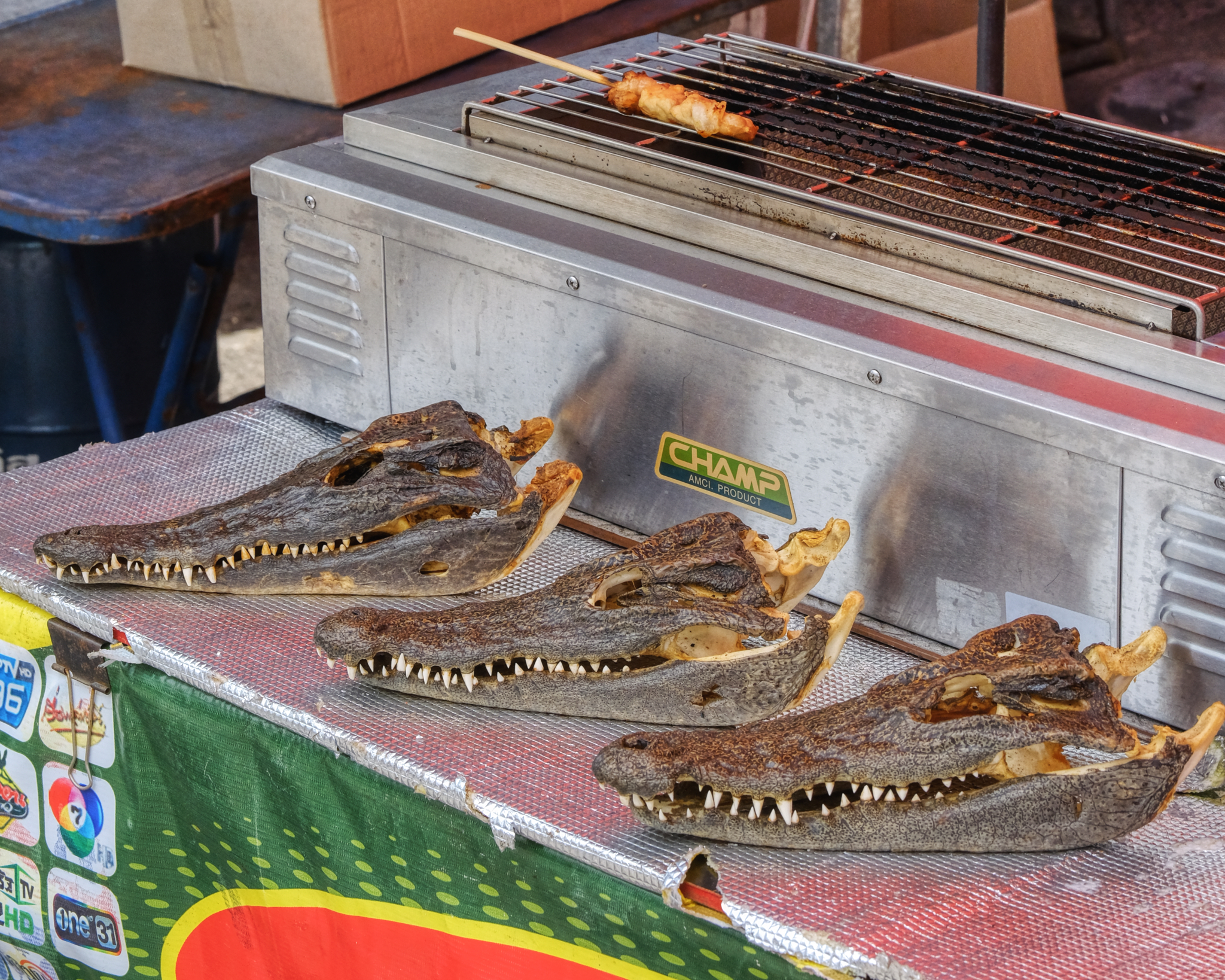 Our last act was to buy a 'croc-on-a-stick' brochet . . . Yes, it did taste like chicken, which makes a kind of sense since crocodiles are actually surviving dinosaurs . . . and birds are dinosaur descendants. We worried all the way back home that we could have eaten 'bad crocodile' . . . . but we were fine . . . no intestinal turmoil after all.
Our last act was to buy a 'croc-on-a-stick' brochet . . . Yes, it did taste like chicken, which makes a kind of sense since crocodiles are actually surviving dinosaurs . . . and birds are dinosaur descendants. We worried all the way back home that we could have eaten 'bad crocodile' . . . . but we were fine . . . no intestinal turmoil after all.